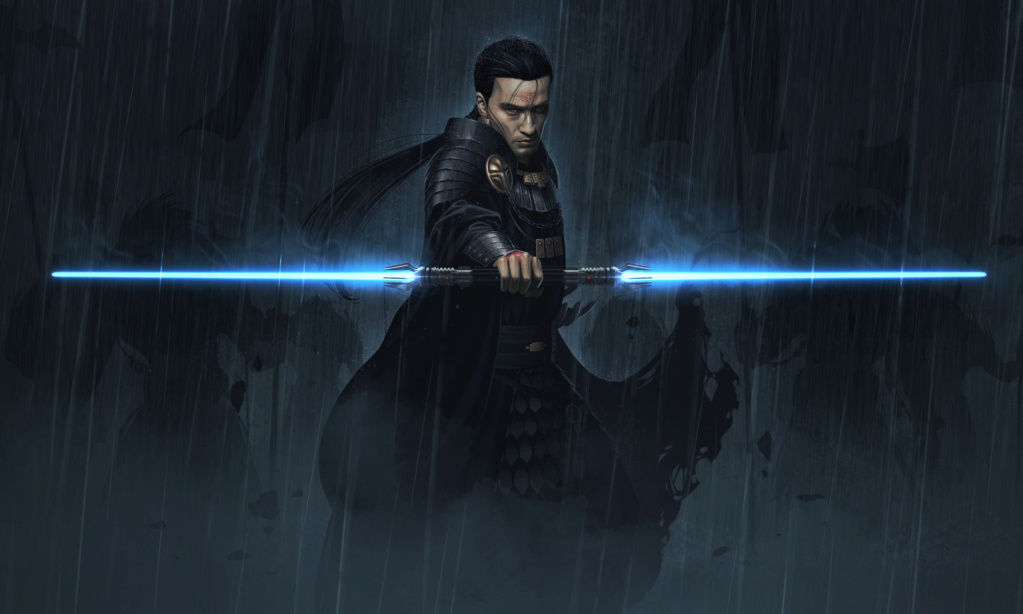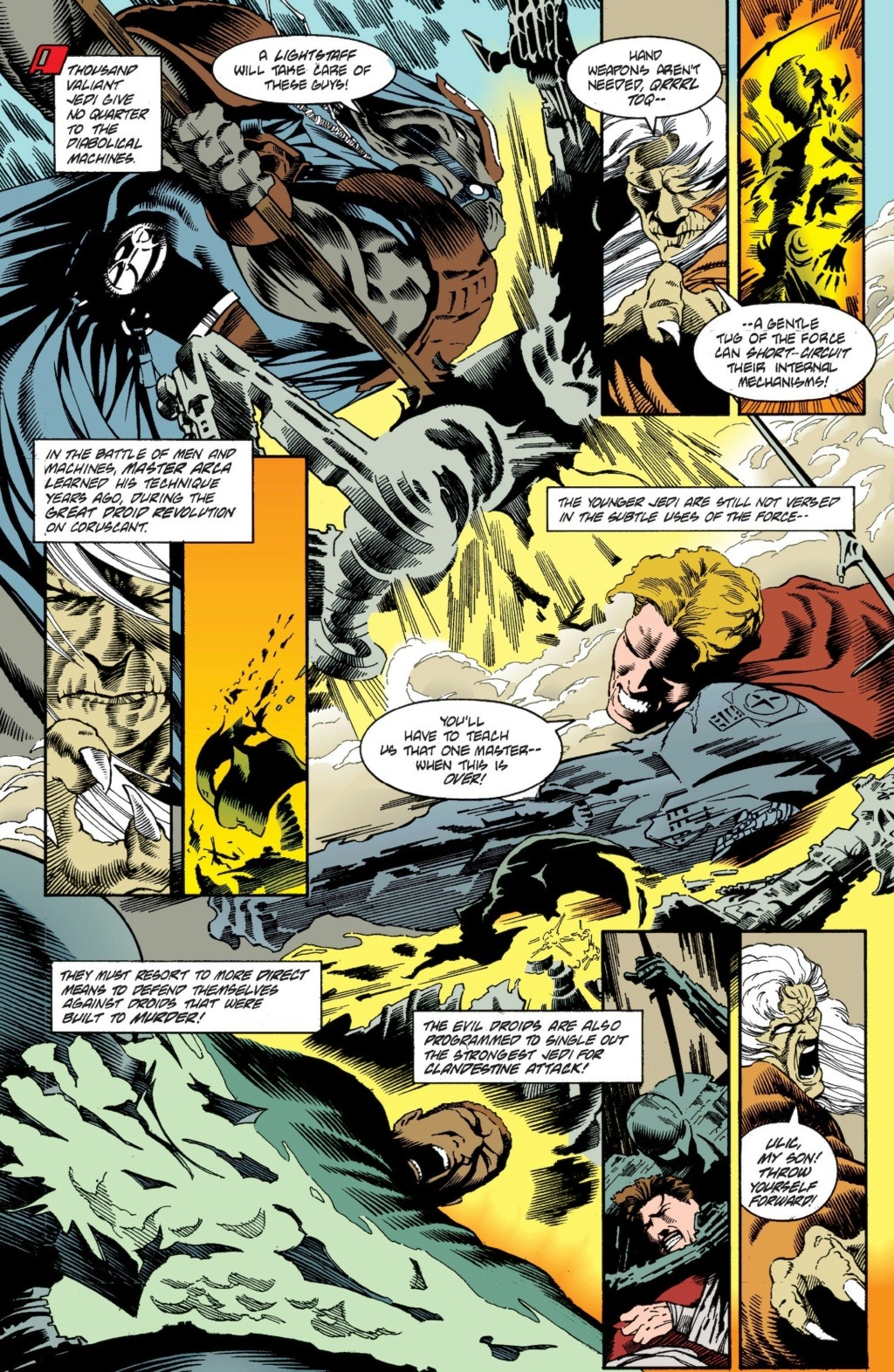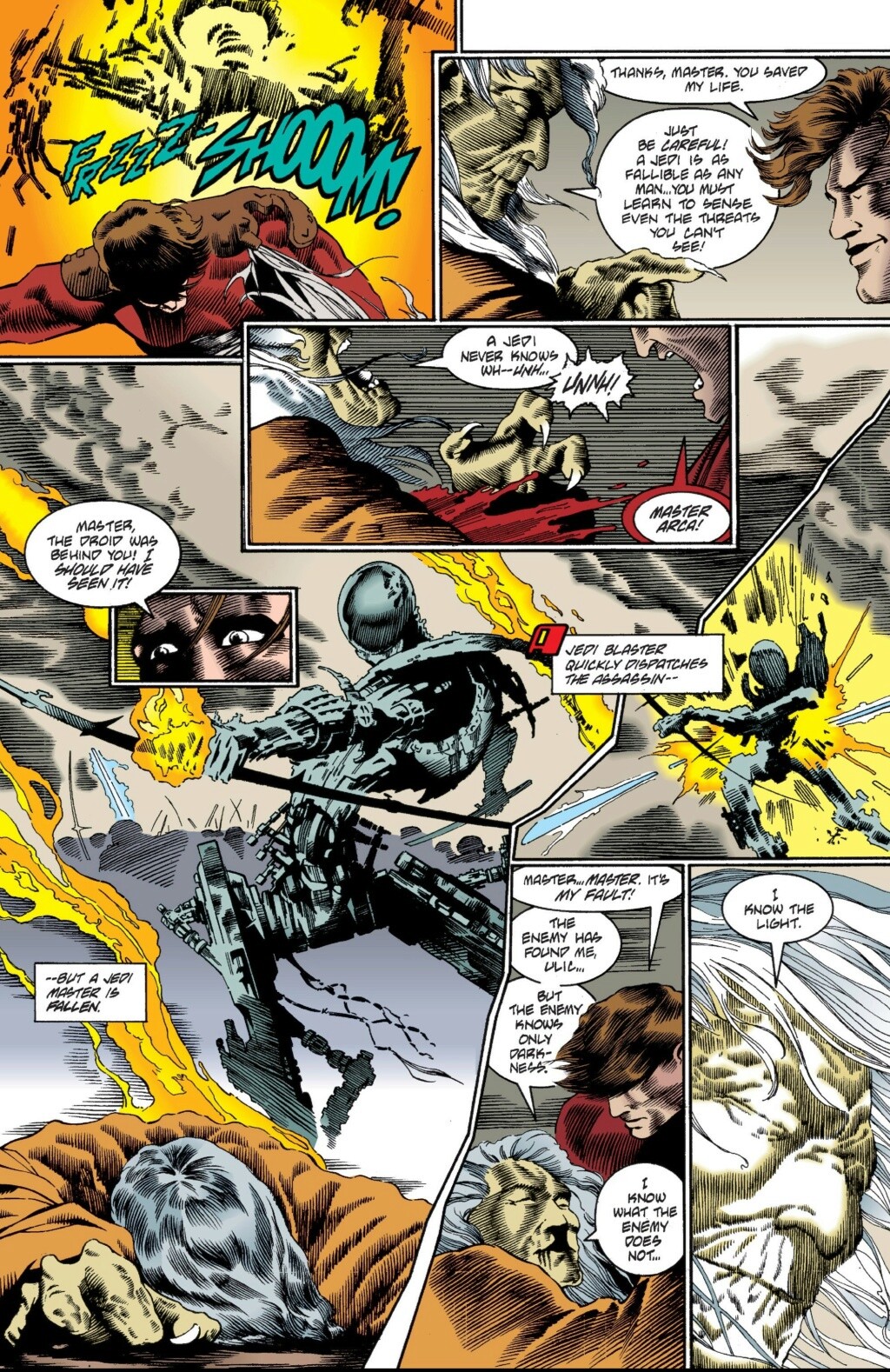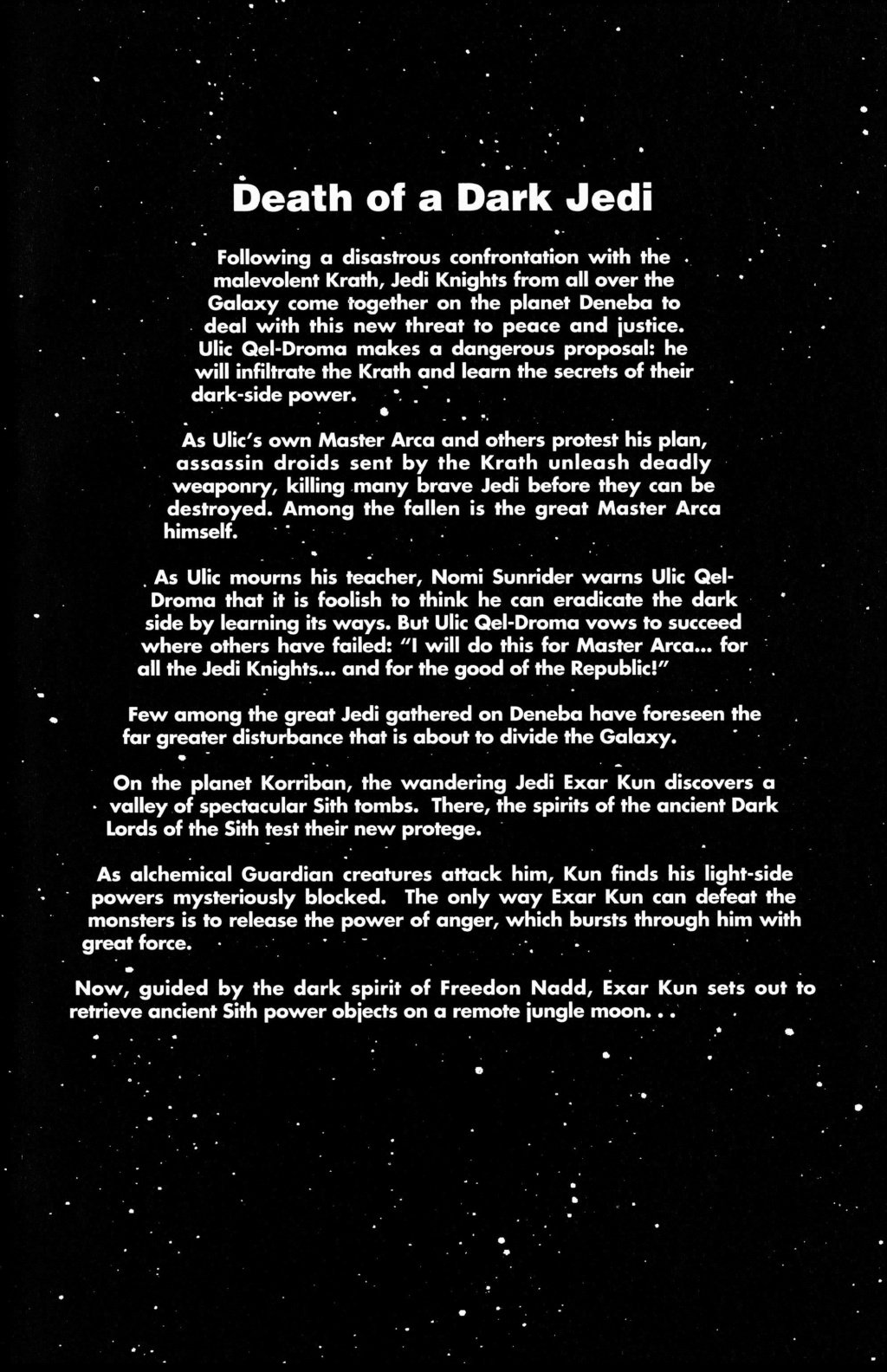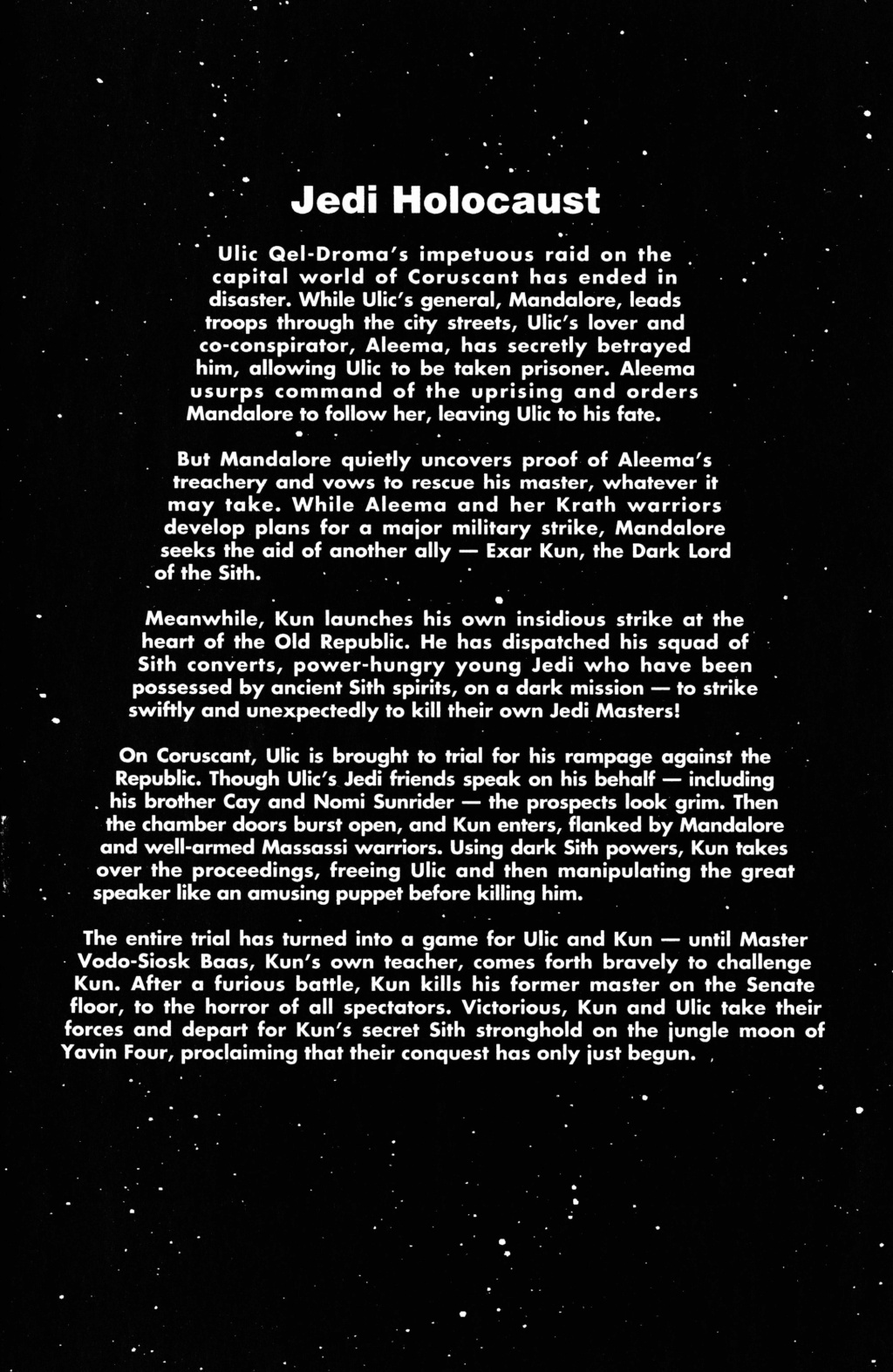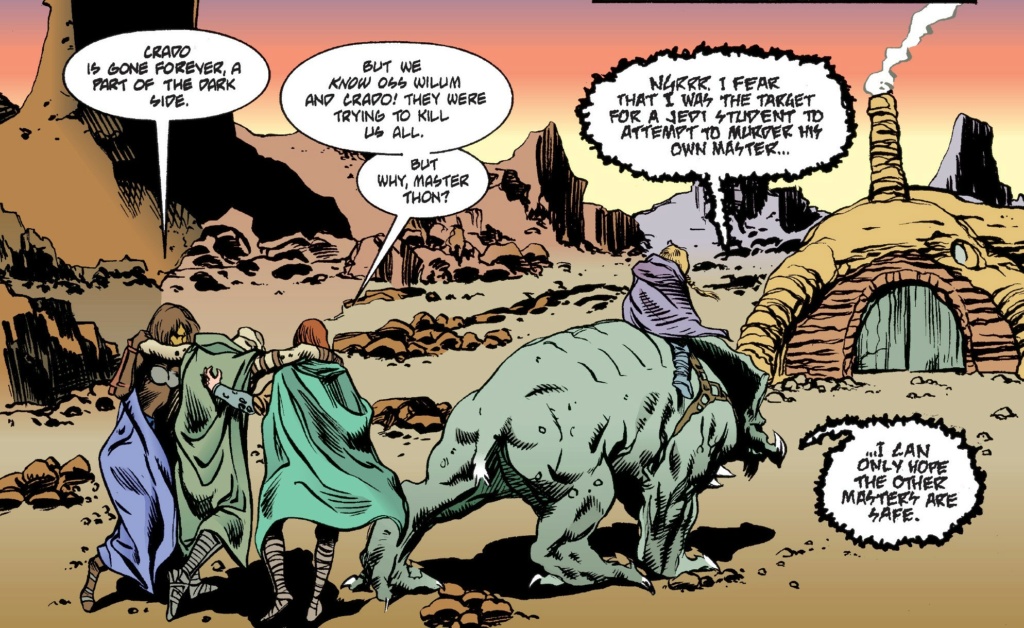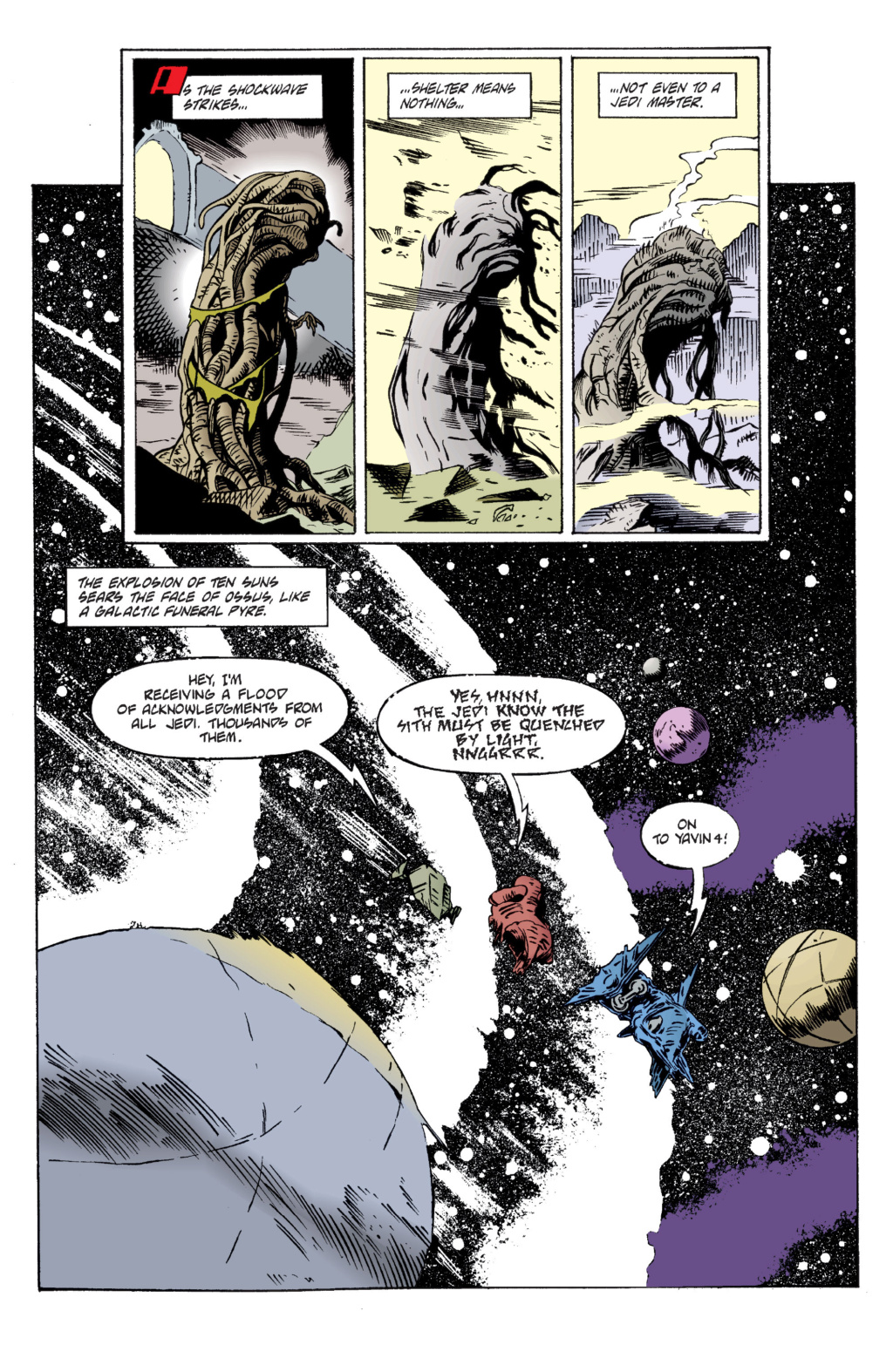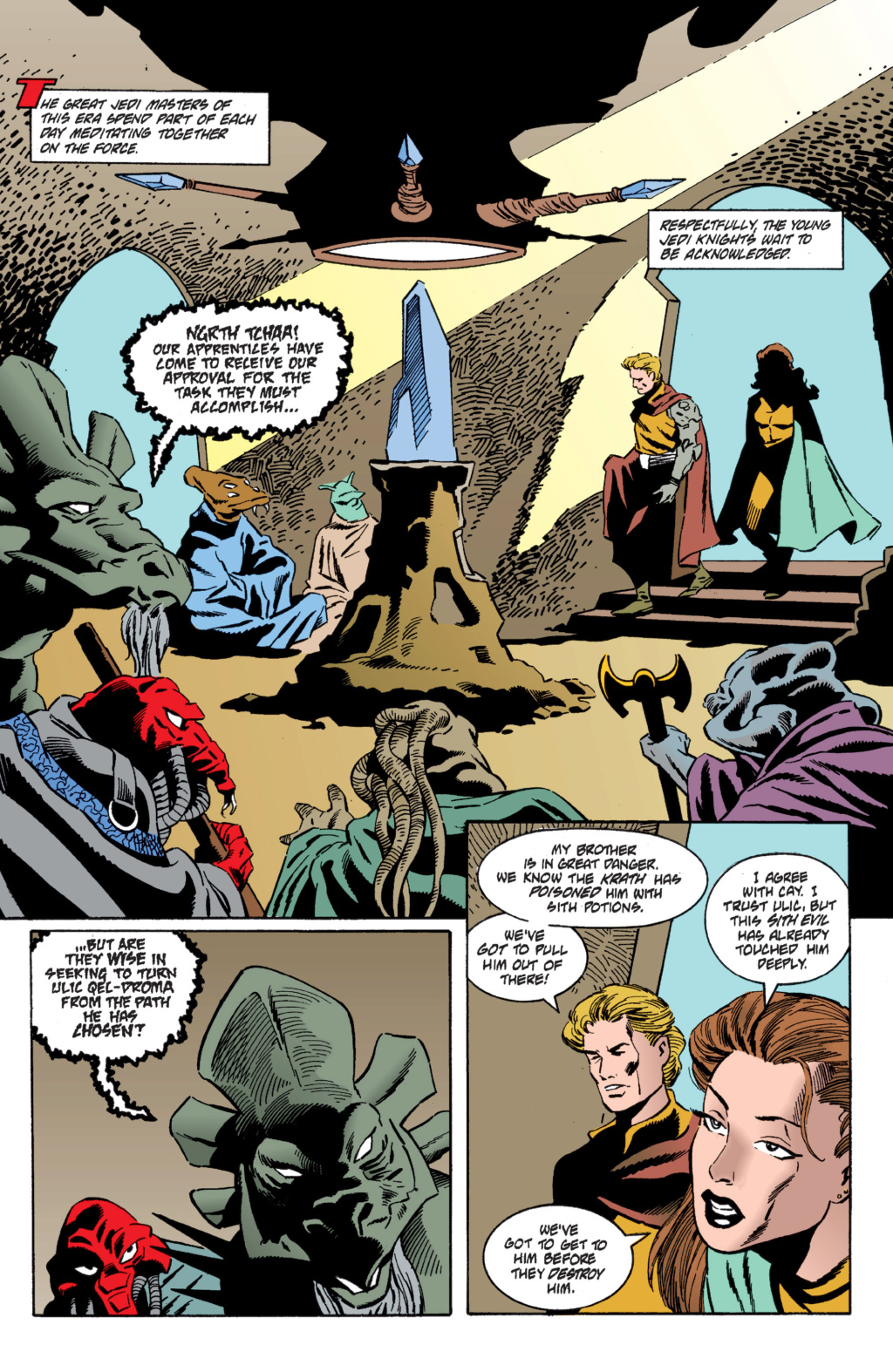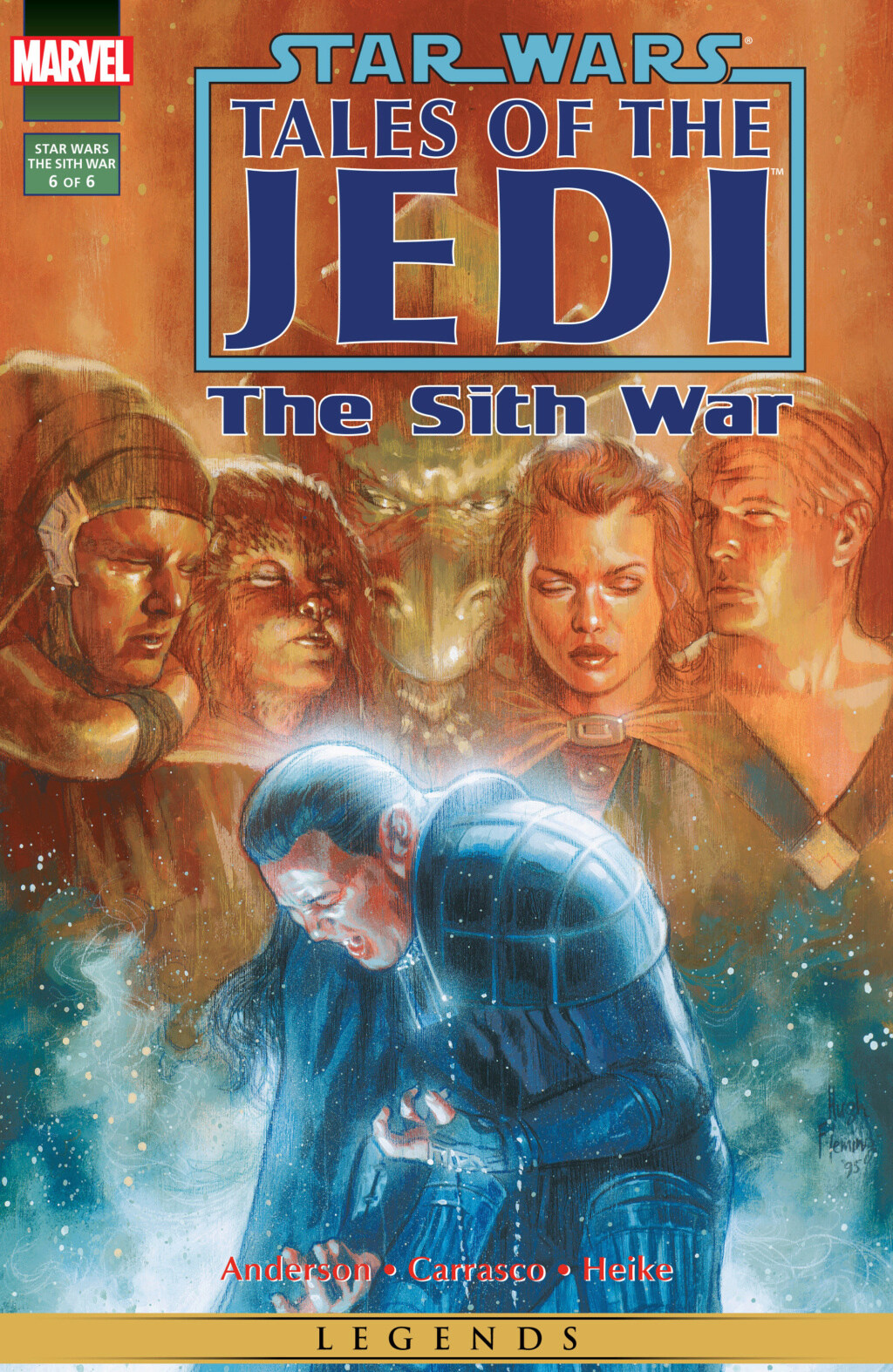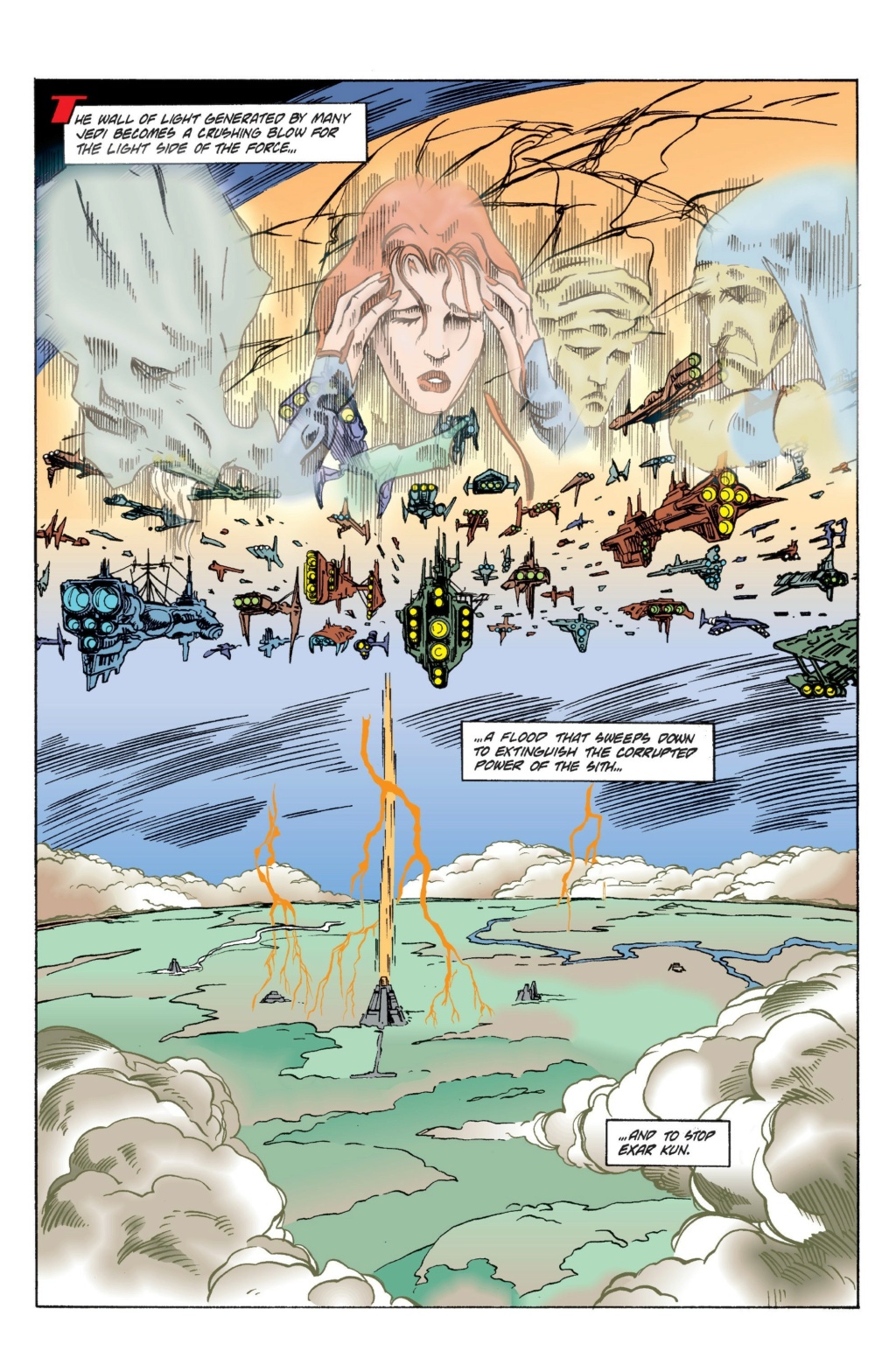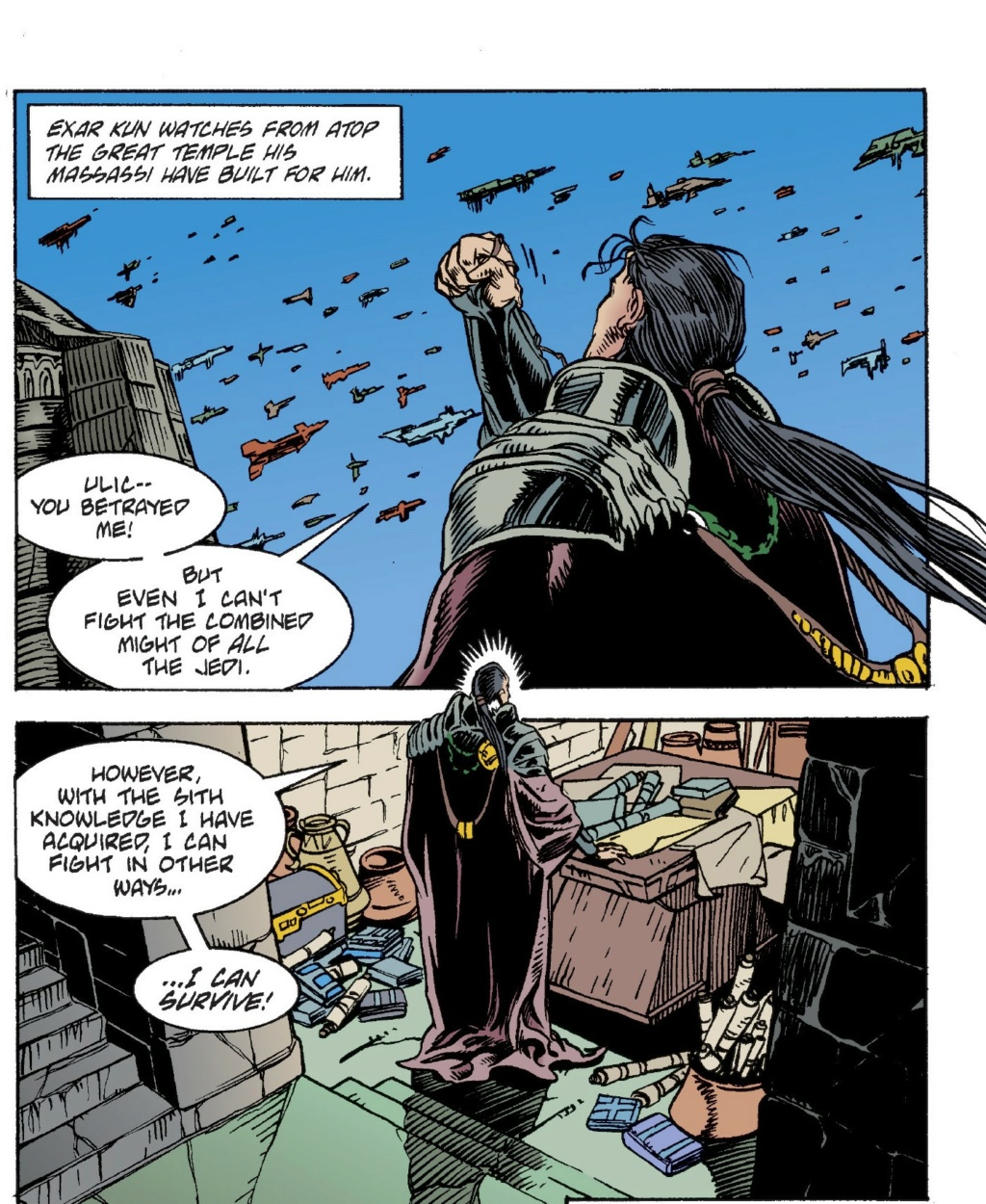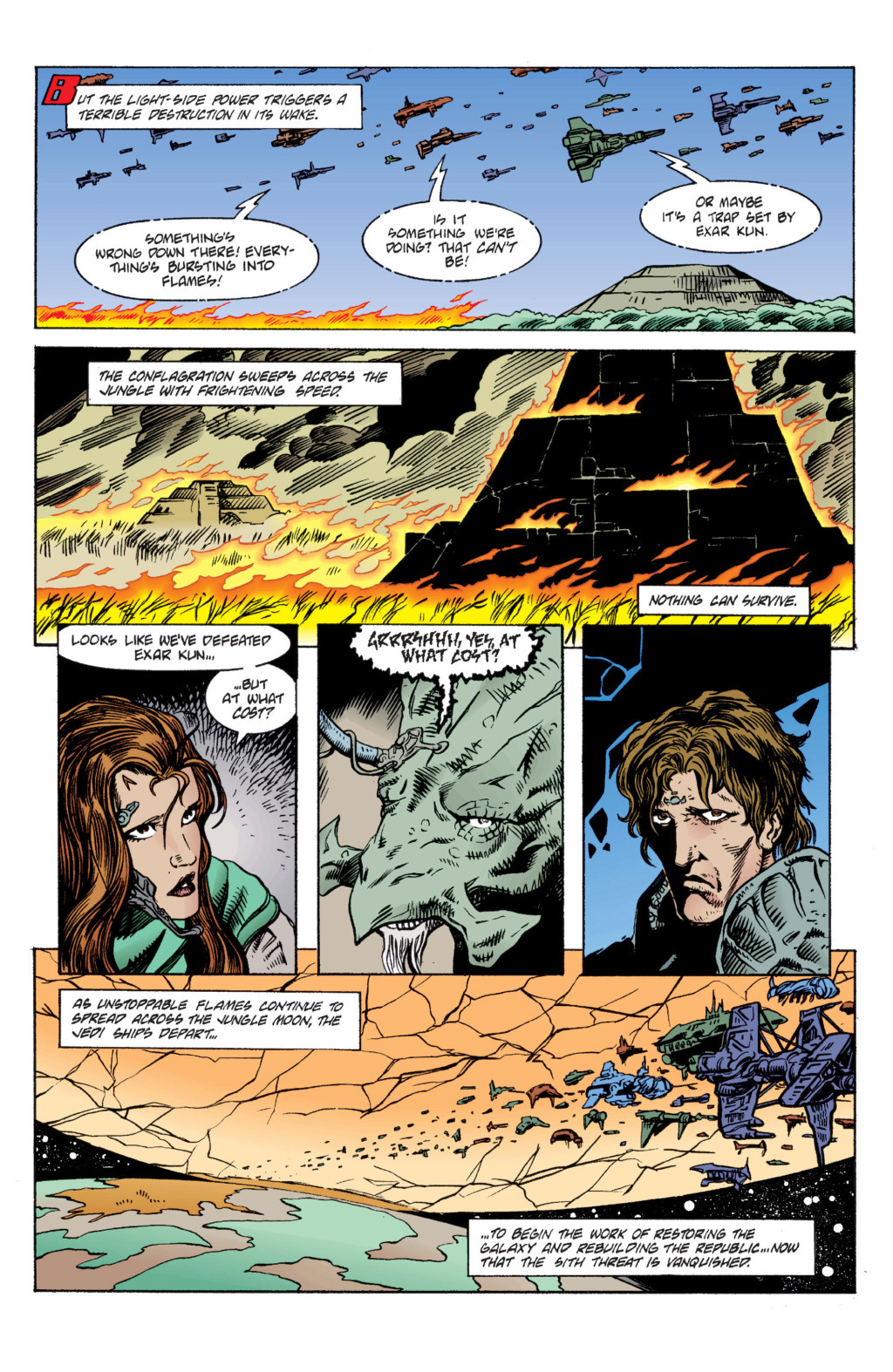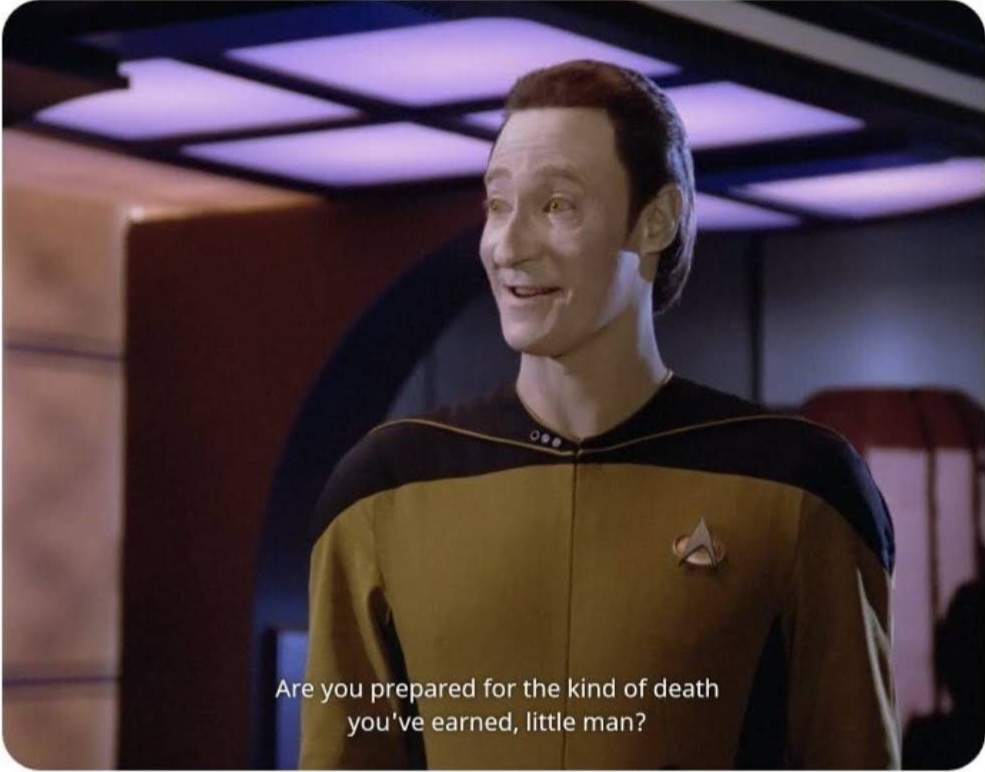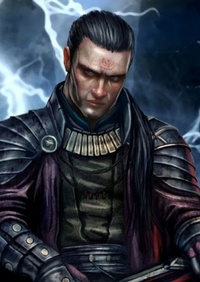 AncientPowerSuspect Hero | Level Four
AncientPowerSuspect Hero | Level Four
 SS - EXAR KUN (AncientPower) VS. DARTH SIDIOUS (Durin)
SS - EXAR KUN (AncientPower) VS. DARTH SIDIOUS (Durin)
April 1st 2023, 5:04 am
- Exar Kun as of the Battle of Yavin IV
- Darth Sidious as of the Senate duel
Rules:
- No character limit
- Two months to respond between posts
Mutually agreed upon rule:
- The case 'Exar Kun's Mightiest Incarnation' in the SI Discord server is taken as insurmountable and the validity of the incarnation purported cannot be called into question.
 AncientPowerSuspect Hero | Level Four
AncientPowerSuspect Hero | Level Four
 Re: SS - EXAR KUN (AncientPower) VS. DARTH SIDIOUS (Durin)
Re: SS - EXAR KUN (AncientPower) VS. DARTH SIDIOUS (Durin)
April 2nd 2023, 6:07 am
Exar Kun's prominence has been, almost quite literally, ever-present in the Expanded Universe. Exar Kun was the first officially named Dark Lord of the Sith outside of the characters in the movies, all the way back in 1994. Exar Kun was first in a trend of villains to be compared to the Emperor of the original trilogy. Whilst all of those villains eventually became the characters of yesteryear with sparse references in guide books and for use as prop villains in RPG campaigns, this was never true for Exar Kun. Exar Kun has been a constantly evolving character with more and more of his story revealed over the decades, as his character evolved, so did his power. Thus he has maintained his relevance in the top tier for twenty-nine years, something no other character who is purely Expanded Universe has done. To truly understand how much Exar Kun has changed across generations and eras, we have to focus on the new, not the old.
Part One: Gethzerion
Gethzerion is the leader of the Nightsisters, and through her immense power, the entire world of Dathomir was blockaded on the orders of Emperor Palpatine. But before we get into that, Gethzerion was far from the only Nightsister to require being dealt with.
Asajj Ventress was, alongside Dooku, a legitimate threat to Darth Sidious himself, and her potential was great enough that she may have surpassed him:

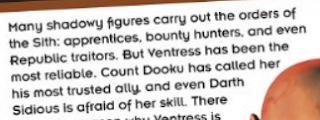
Starwars.com - Count Dooku Encyclopedia Entry wrote:However, when Darth Sidious grew wary of Asajj's abilities and feared that Dooku might be plotting a move against him, Sidious ordered Asajj eliminated.
Starwars.com - Asajj Ventress Encyclopedia Entry wrote:However, when Darth Sidious grew wary of Asajj's abilities and feared that Dooku might be plotting a move against him, Sidious ordered Asajj eliminated.
Starwars.com - Nightsisters Episode Gallery wrote:In his palace on Serenno, Count Dooku receives a holographic transmission from Darth Sidious. Sidious warns that Dooku’s assassin, Asajj Ventress, has become too powerful, and cautions Dooku to think twice before training an apprentice to kill him.
Star Wars Insider Magazine #122 wrote:Cunning, devious, and more powerful with the force than her Sith Masters could have foreseen, Asajj Ventress’ time has come with an epic storyline in Star Wars: The Clone Wars.
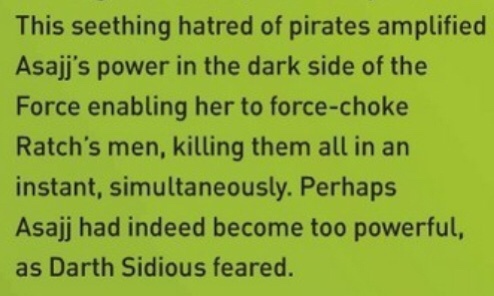

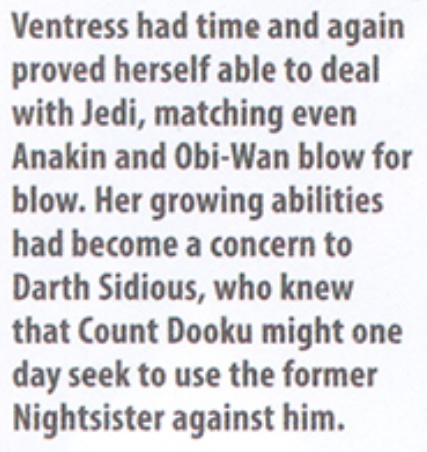
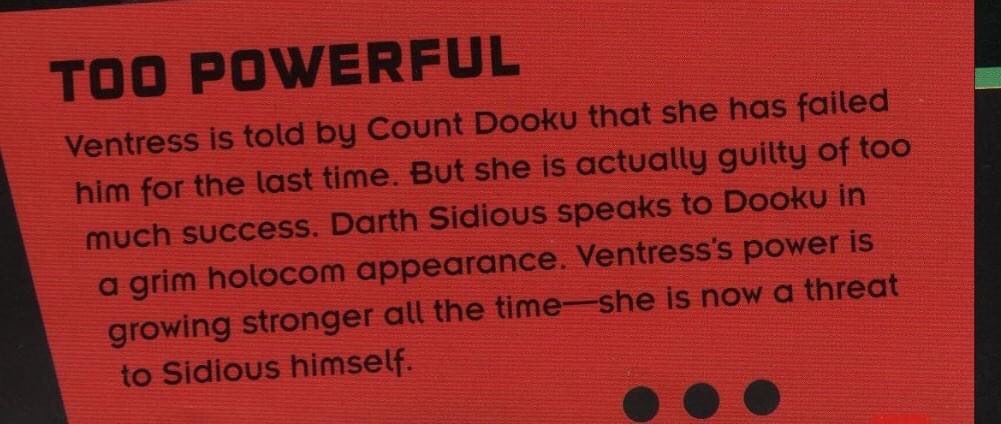
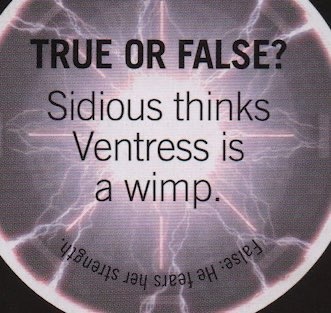


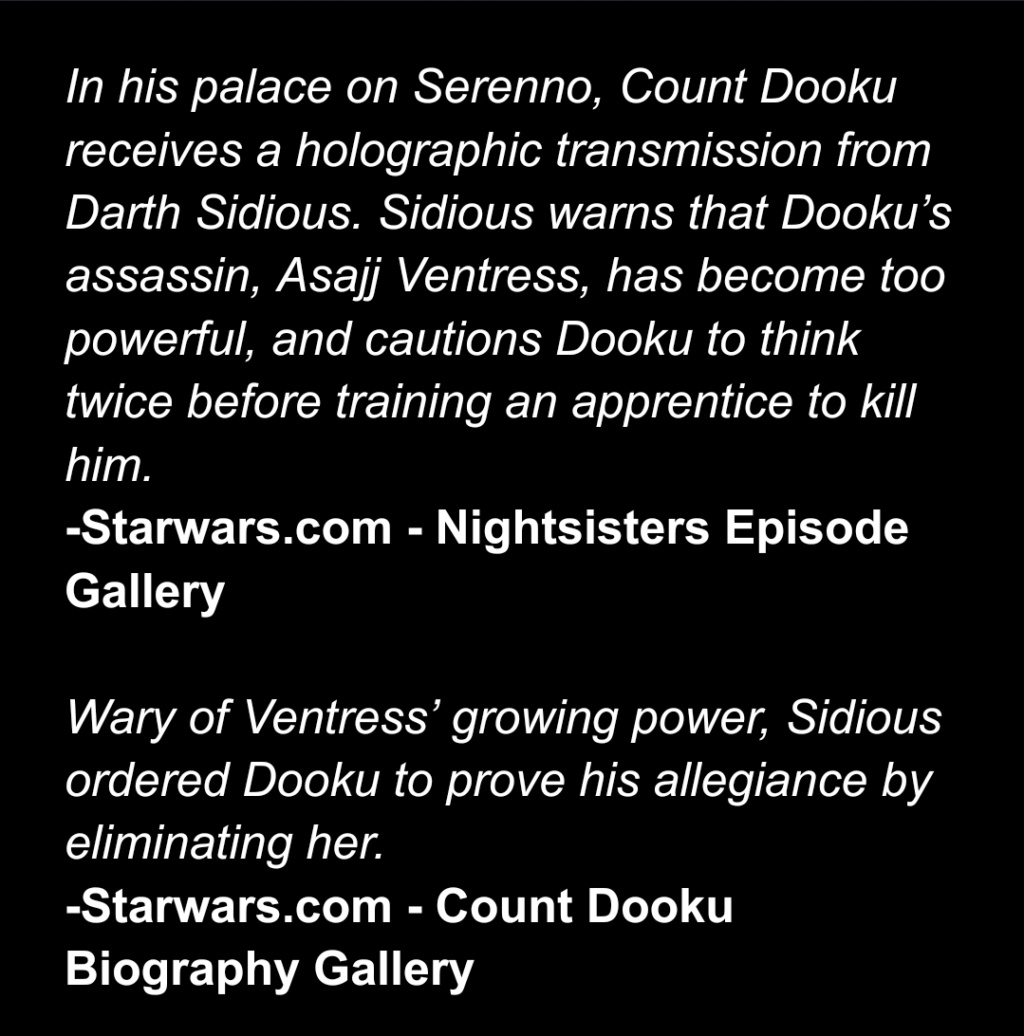
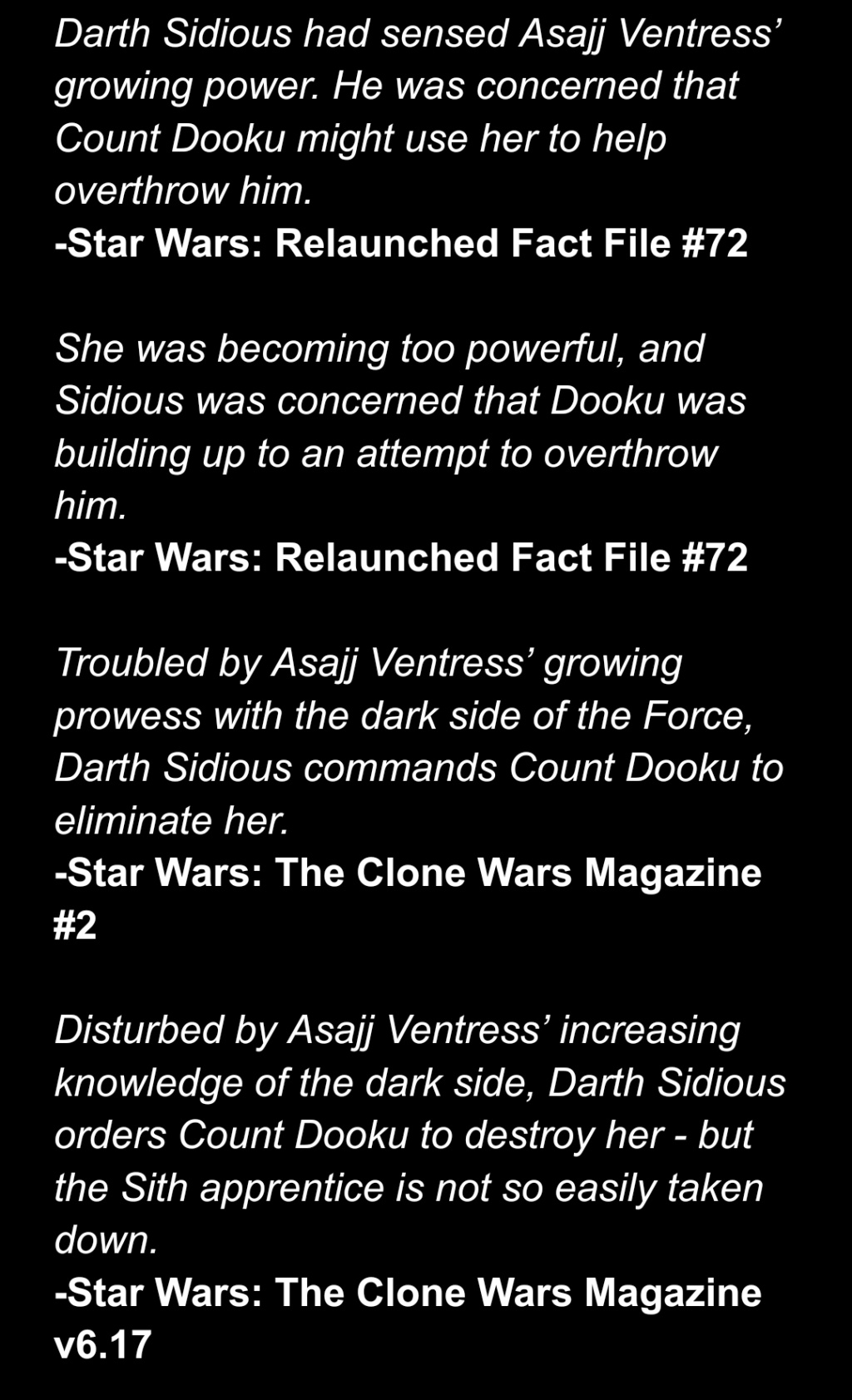
(Credit to Ethan for the above)
However Asajj Ventress is merely secondary to Mother Talzin, who is strong enough to equate the Force lightning of Darth Sidious:
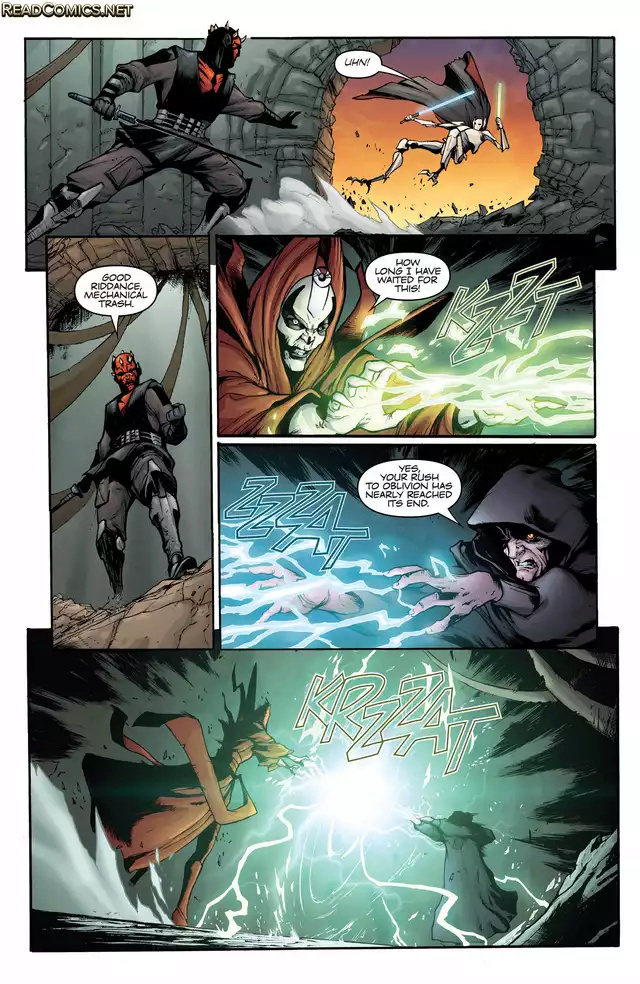
She's explicitly capable of going 'toe-to-toe' with the Dark Lord:
Star Wars Insider 149 wrote:She’s a powerhouse that could go toe-to-toe with Darth Sidious.
Yet Gethzerion is evidently superior to Mother Talzin:
Firstly, she's able to cast her spells without chants or rituals, something Talzin had to do:
Cracken's Threat Dossier wrote:She discovered that she was able to cast spells without the aid of chanting and other more primitive rituals.
The Essential Guide to Characters wrote:The Nightsisters were Force wielders whose genes had been developed via selective breeding to assure power. The majority of them believed they had to chant, sing, or perform rituals and spells to use their magic.
Only Gethzerion realized they could use their Force talents without rituals; she used her "powerful" solo magic to intimidate and force her will on others.
Being able to do this, is explicitly grounded in how powerful she was:
Cracken's Threat Dossier wrote:Of the three sisters, Gethzerion was by far the most powerful of the siblings; she could even cast some spells silently.
Secondly, and rather simply, Talzin is very reliant on Dathomir for her power, where Gethzerion as you'll see by her goal in the next point, is not:
Restraint wrote:“Our magicks don’t work in this sterile place,” Talzin said with abhorrence. “That’s why I could not sustain the illusion.”
Blaster bolts were ricocheting from the container. The two Nightsisters were returning fire.
“The illusion that nearly got all of us killed,” Maul said.
Talzin took her hand from the deep black-edged groove in her outer thigh and winced. Maul regarded the wound in stony silence. Black against red, like the zigzag markings on his face and head.
“On Dathomir I would be able to heal myself.”
Thirdly, unlike with Talzin, who Darth Sidious dealt with personally, the moment he senses Gethzerion's power, he blockaded Dathomir entirely to prevent Gethzerion from leaving at all:
The Complete Star Wars Encyclopedia wrote:Her powers grew through devotion to the dark side, and she was determined that her clan would rule, and eventually, escape the planet on which she had been stranded by Emperor Palpatine, who had been disturbed by Gethzerion's growing power.
The Essential Reader's Companion wrote:The newcomers to Dathomir promptly encounter the Witches of the planet. The warriors of the Singing Mountain Clan are noble and fearless females who enslave males as breeding stock and ride atop trained rancor beasts. The Witch named Teneniel Djo at first wants to enslave Luke and Isolder, but she later comes to respect them. Such is not the case with the wicked Nightsister clan ruled by Gethzerion. They are cruel and evil magic wielders who long to escape the blockaded world. Years earlier, Palpatine was alarmed by their growing power and purposely stranded them on Dathomir.
The Essential Guide To Planets And Moons wrote:When the Nightsisters made contact, the Emperor was stunned by the depth of their leader Gethzerion's power. Wanting to keep her abilities safely bottled up, Palpatine ordered the prison's ships destroyed from orbit; the stranded guards were enslaved by Gethzerion and her twisted followers.
The Dark Side Sourcebook wrote:But the Emperor, who sensed Gethzerion's power through the Force, realized that once Gethzerion mastered the controls of a shuttle, she could reach the orbiting docking facility, and from there spread her influence to the rest of the galaxy, one day perhaps even challenging him.
The Complete Star Wars Encyclopedia wrote:But after Emperor Palpatine learned the power of the Nightsister's leader, Gethzerion, he ordered all prison's ships destroyed to prevent her from leaving the planet.
Star Wars Encyclopedia wrote:Imperial forces constructed orbital shipyards and a penal colony on Dathomir's surface. But after Emperor Palpatine learned the power of the Nightsisters' leader, Gethzerion, he ordered all the prison's ships destroyed to prevent her from leaving the planet.
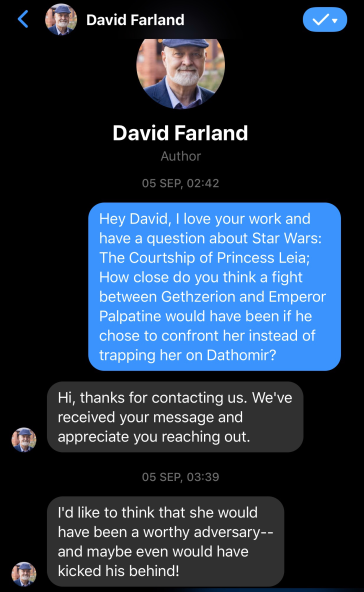
Leia Organa, The Courtship of Princess Leia wrote:"I believe the Emperor himself was afraid of the Nightsisters. That's why he interdicted this planet. Years ago, he started a nice little penal colony here, not knowing about the Nightsisters. When he learned about them, he blew the planet's airfield from orbit and stranded hundreds of his own people here, along with the prisoners, rather than risk letting Gethzerion escape. That's how frightened he was of Gethzerion."
Jedi Academy Training Manual wrote:A recently established prison colony on Dathomir brings the Nightsisters to the attention of Emperor Palpatine, who gauges the possibility of them being a threat to his reign.
The Essential Guide to Characters wrote:When he was alive, Emperor Palpatine had known of Gethzerion. He allowed her twisted usage of the dark side of the Force as long as she was trapped on Dathomir, where an Imperial penal colony housed political prisoners.
Knowing the extent of her powers, though, he decided it would be dangerous to let her get off planet, so Palpatine ordered the orbiting airfield destroyed, in the process stranding many of his own people.
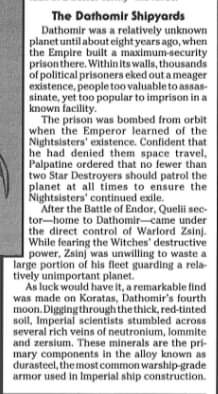
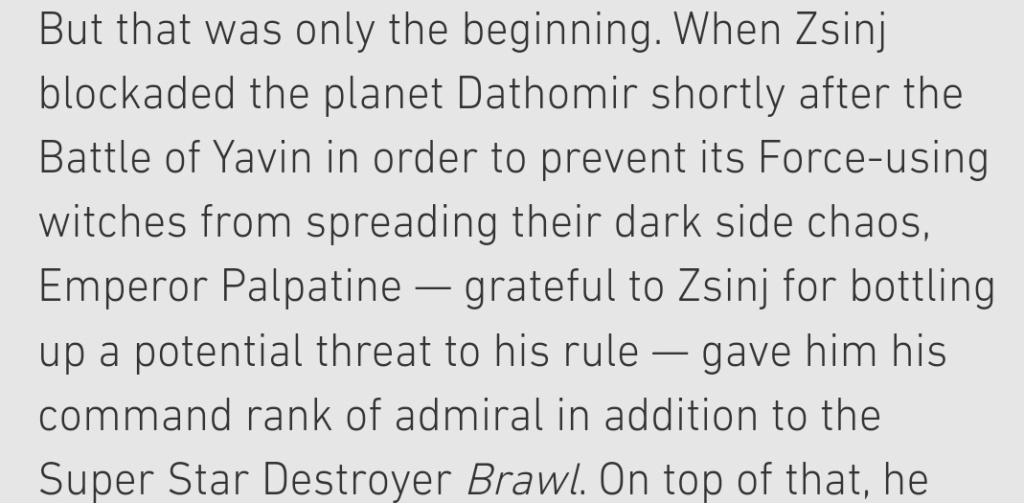
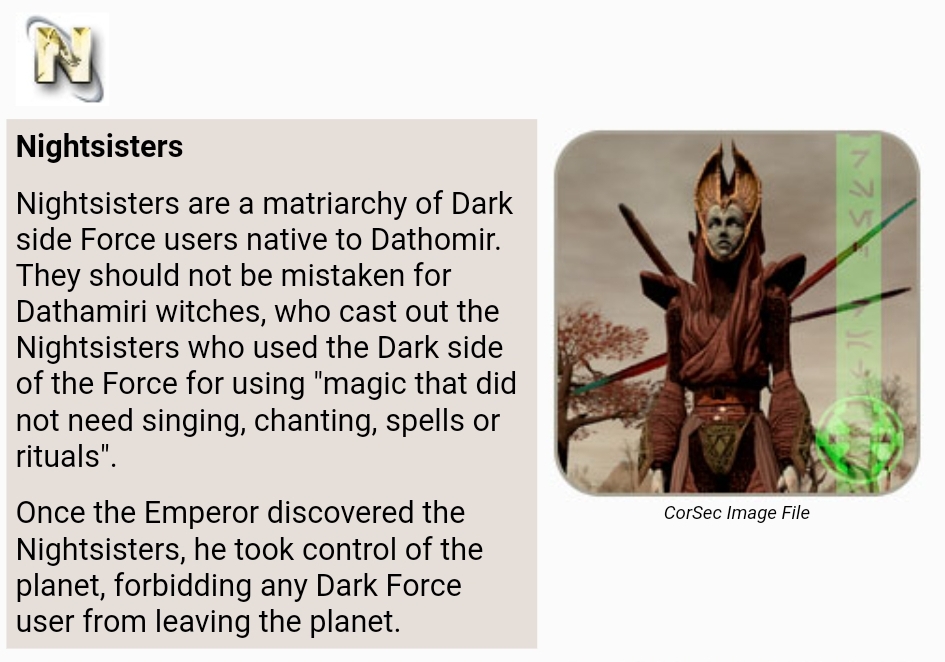
Cracken Threat Dossier wrote:`Gethzerion used her newfound knowledge to gather the other outcasts. While the clan looked on, Gethzerion used her "Shadow Magic" to form the Nightsisters. They found their power grew quickly.
The growing "Dark Energy" emerging from Dathomir did not go unnoticed. Emperor Palpatine felt the Nightsister's presence and realized if they were to escape Dathomir, they could become a threat to his power. He closed off all contact to the world, using atmospheric bombardment to destroy any space-going vessels on the planet.`
Emperor Palpatine in the first year of the Galactic Civil War is 'stunned by', 'afraid', 'wary', 'frightened', and 'alarmed' by Gethzerion's power.
In the same year, the Nightsister Kyrisa challenges Gethzerion for the position of Clan Mother:
Star Wars Galaxies: Trading Card Game - The Nightsister's Revenge wrote:Following a fierce battle for leadership, the Nightsister clan of witches on Dathomir has banished one of their own, an extremely powerful Force sensitive named Kyrisa who has developed the ability to control the minds of beasts with the Force. At the orders of Clan Mother Gethzerion, Kyrisa was exiled from Dathomir and crash-landed on the planet Hoth. Enraged at her banishment, Kyrisa vowed revenge against Clan Mother Gethzerion and the Nightsisters. Taking refuge deep within the icy caverns on Hoth, she quickly took control of wampas creating a new pack of minions that she used to wreak havoc on both the Rebel and Imperial military forces on the surface of Hoth, stealing supplies necessary to help her return home to enact her revenge. Her abilities to manipulate the beasts is so complete that both Jedi and Sith want this knowledge, or at the very least to remove the Force-user as a threat to their objectives on the surface.
Kyrisa battled Gethzerion for leadership of the Nightsister Clan, and as is stated above, said battle was 'fierce':
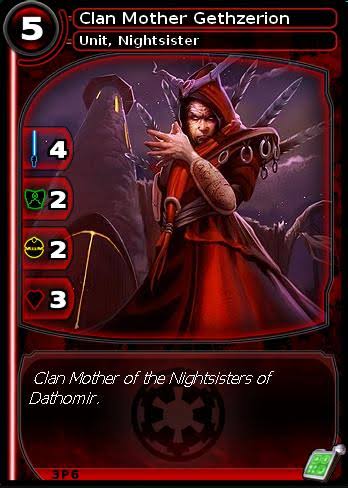
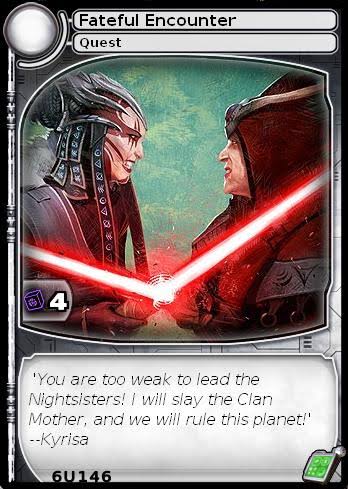
But Kyrisa experienced a rebirth after being exiled to Hoth, fueled by a desire for revenge:
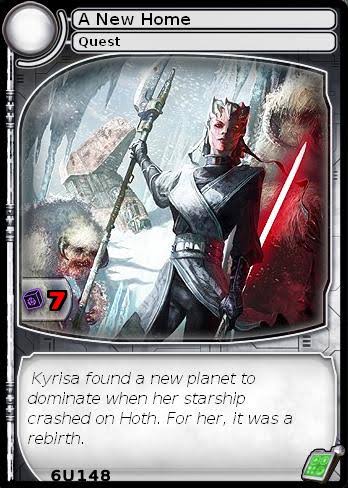
Star Wars Galaxies: Trading Card Game - The Nightsister's Revenge wrote:This latest set tells the tale of Kyrisa, an extremely powerful Force sensitive who can control the minds of beasts with the Force. Exiled by her own clan to the frozen planet of Hoth, Kyrisa's formidable mind and will is bent on revenge. Any who stand in her way will feel her fury in the teeth and claws of her Beast minions.
She's stated to be possibly more dangerous now than Gethzerion by Augywnne:
Star Wars Galaxies: Trading Card Game - The Nightsister's Revenge wrote:'This one is Kyrisa,' says Augwynne. 'She became such a threat to her own clan that they exiled her. She is perhaps the most dangerous of all.'
Kyrisa is defeated by the Hero and flees:
Star Wars Galaxies: Trading Card Game - The Nightsister's Revenge wrote:Players can pit their skills against Kyrisa, an exiled Nightsister witch who has been using her Force sensitivity to control the minds of wampas and wreak havoc on the Imperial and Rebel forces stationed on the icy planet of Hoth.
Star Wars Galaxies: Trading Card Game - The Nightsister's Revenge wrote:'My Maraki is gone,' says a woman's voice from behind you. You turn to look up the hill and see Kyrisa, the exiled Nightsister, standing on top. 'You have slain one of my children,' she says. Her red eyes flash and the tattooed streaks on her face contort with anger.
'I took shelter from the storm,' you say. 'The beasts attacked and I defended myself.'
'Enough of your lies!' she screams. At her side now are two fierce wampas. 'You invaded their home and murdered them!'
It's obvious she's going to attack any second. You ready your weapon as she says, 'You will die like all the humans on this planet! Hoth belongs to Kyrisa!' She throws her arms forward and her deadly menagerie attacks.
Kyrisa's beasts are well trained and fight to the death to defend her. Still, the battle turns against the exiled Nightsister and she jumps on the back of a hog to make her escape.
'Your fate is sealed!' she cries. 'I will find you again to exact my revenge!' Then she rides away into the swirling snow.
It takes four of these Heroes to defeat Exar Kun's spirit:
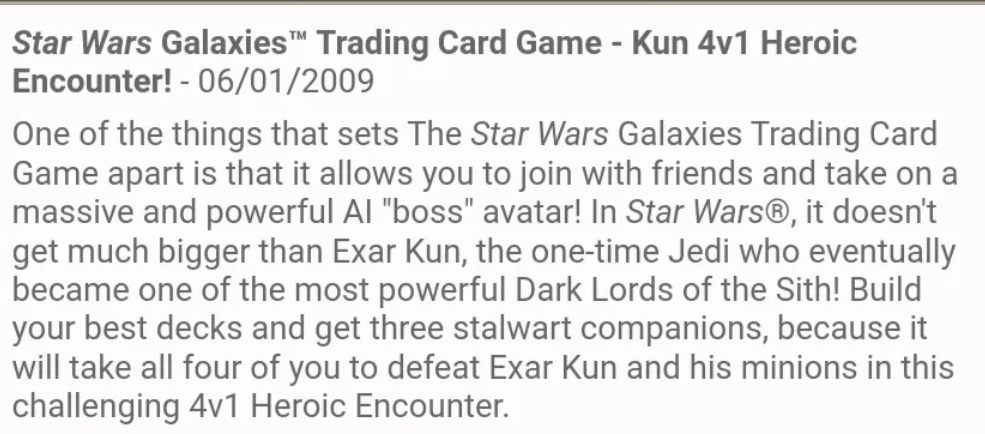
Yet Exar Kun is not yet at full power:
Chapter 9: The Fury of Exar Kun announcement wrote:Hidden below the Temple of Exar Kun on Yavin 4 lays the tomb of this legendary Sith Lord. Exar Kun's spirit is so strong and malevolence so great, that he has withstood death for 4,000 years, waiting for an opportunity to finally obtain the godhood he so desires.
Domain of Evil, Star Wars Galaxies wrote:Exar Kun's essence remains trapped in his temple on Yavin 4. The Dark Lord of the Sith is far from powerless, and he bides his time in his domain, waiting for just the right opportunity to return.
His only hosts are archaeologists with no Force power:
Chapter 9: The Fury of Exar Kun' announcement, Star Wars Galaxies, LucasArts wrote:A group of archeologists excavating nearby have discovered the tomb's crumbled antechamber, and as they explored deeper, have succumbed to Exar Kun's powerful will. Players must eliminate each of the now twisted but powerful archeologists on their way to finally put the spirit of Exar Kun to rest.
In Jedi Academy however, Exar Kun has three Force users to draw strength from, two of whom are great Force prodigies:
Jedi Academy Sourcebook wrote:Over a number of weeks, Kun slowly bends Kyp to his will, and begins to augment his power. He grows very powerful on Kyp's hate, and soon his hold on Kyp is so complete that he can send Kyp beyond the planet to do his will and still retain control over his subject.
Jedi Academy Sourcebook wrote:Exar Kun himself possessed a great many other dark powers that he was unable to harness without the energy he needed to fuel his disembodied will. Some of these powers he was able to channel through Kyp, Gantoris, and Streen to achieve his ends.
Furthermore, Exar Kun is directly stated to be stronger than prime Gethzerion, who is seven years of power growth that Palpatine found 'disturbing' stronger than the one Palpatine was already scared of, as well:
New Rebellion wrote:She wished she had the same certainty. This Kueller had more Force capability than anyone she had encountered in years. Except Exar Kun, and he had been a spirit. Kueller was alive. He was using these deaths to replenish his own well of hatred. The dark side ate people from within, but while it did so, it gave them much too much power. He appeared to have more power than she had. More power than Luke.
When the Jedi students with the spirit of Luke Skywalker joined their power to defeat Exar Kun, they were well aware of both each other's power and their united imagination:
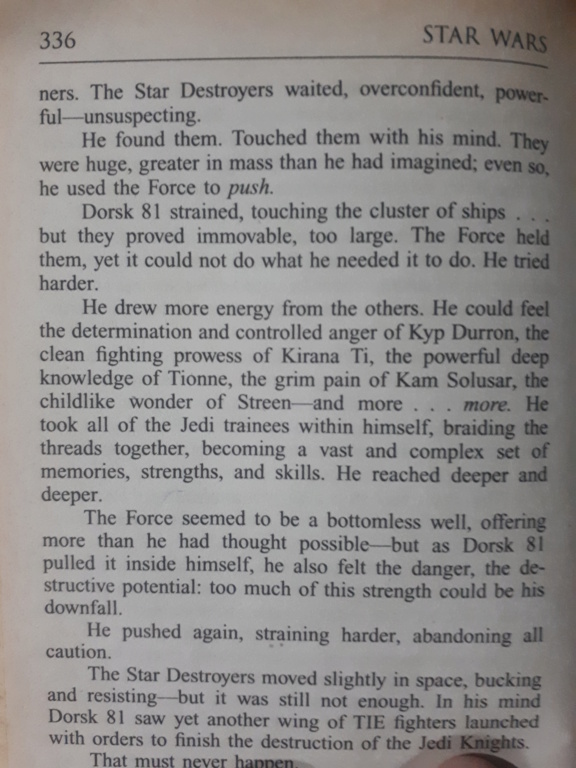

Note specifically:
Darksaber wrote:"We pooled our strengths, we joined as one, as champions of the Force-and, united, we unlocked a greater reservoir of strength than any of us could have imagined."`
Darksaber wrote:He drew more energy from the others. He could feel the determination and controlled anger of Kyp Durron, the clean fighting prowess of Kirani Ti, the powerful deep knowledge of Tionne, the grim pain of Kam Solusar, the childlike wonder of Streen-and more. . . more. He took all of the Jedi trainees within himself, braiding the threads together, becoming a vast and complex set of memories, strengths, and skills.
Luke himself remembers this joining as 'one':
Children of the Jedi wrote:"Yes,” said Luke, remembering the power of the Force flowing into him as he’d battled Exar Kun for the final time,
This would undoubtedly include the 'luminous beings' power that Luke Skywalker unlocked when he cut off Reborn Emperor Palpatine from the Force, who 'cannot stand' against such power:
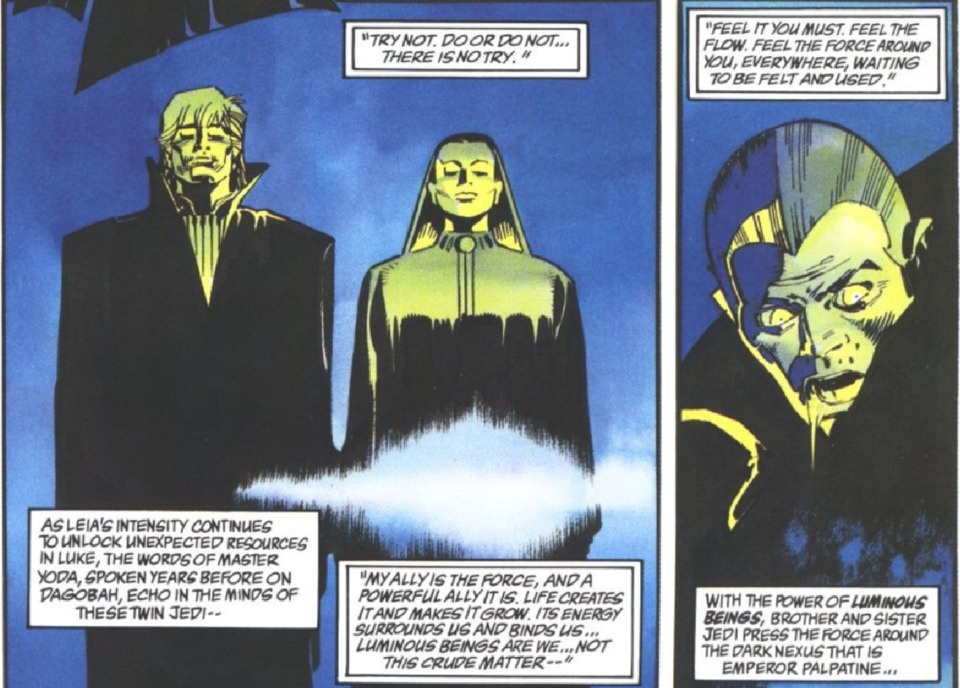
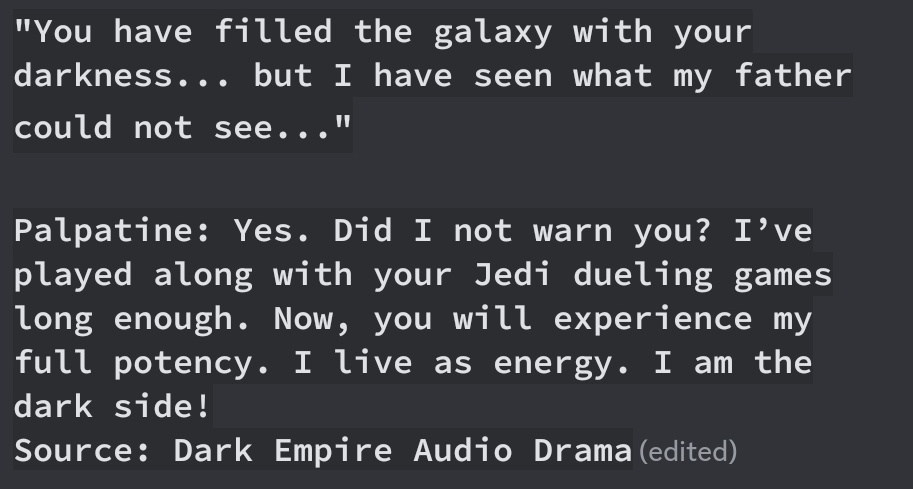
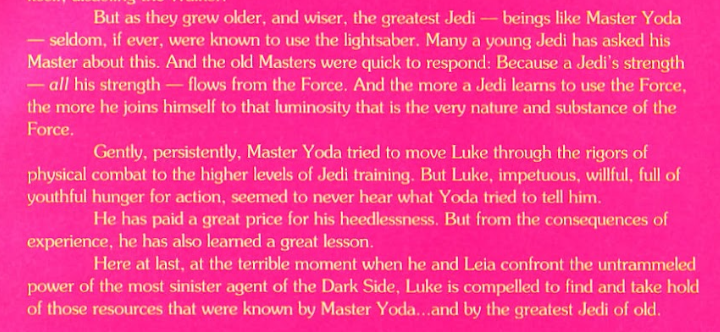
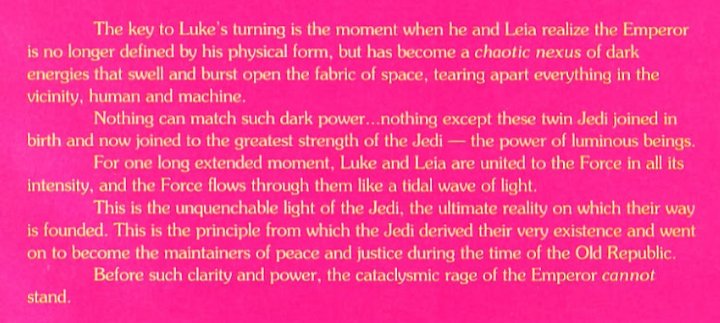
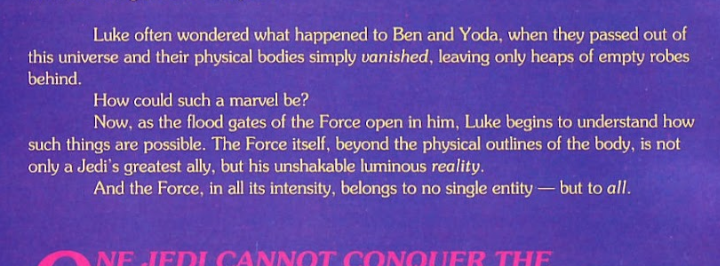
Indeed, there is no reason to believe Luke didn't, as he's stated to have used the power to become a spirit against Kun just as he intended to do against Kueller:
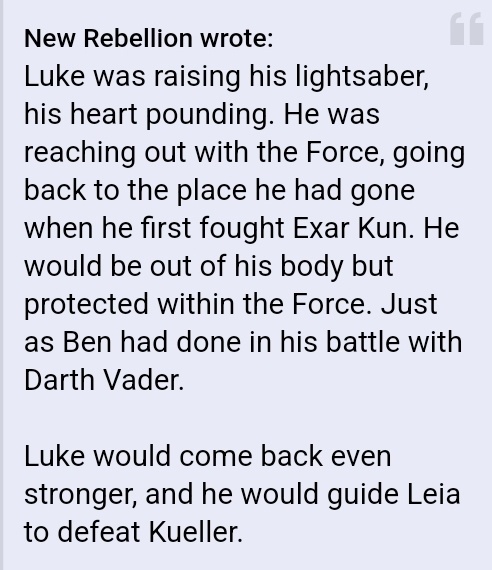
Despite this, the power that they had whilst joined together was nothing compared to the power unleashed when Dorsk 81 channelled even more to throw a fleet of seventeen star destroyers out of a solar system:

Indeed, the feat is quite clearly even more overshadowed by the wall of light that was summoned to destroy Exar Kun, four millennia earlier:
I, Jedi wrote:Twelve half-trained apprentices and two toddlers planning to annihilate someone who had survived an onslaught by the combined might of the Jedi of his age sounded ridiculous on the surface of it.
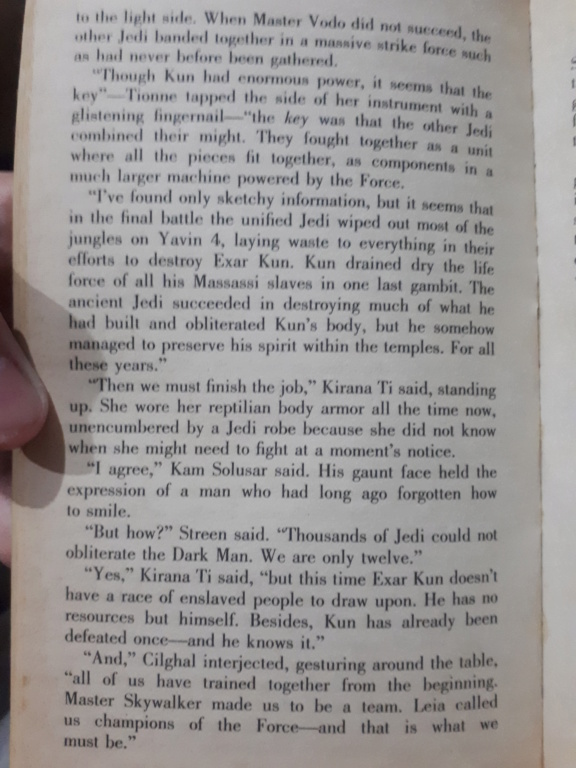
In fact, Exar Kun's performance against the combined Jedi Order was nothing short of excellent, as an 'all-powerful' being:
I, Jedi wrote:I let Streen fill Kun with our resolve to unite and defeat him, but Kun's contempt for us came rolling back along the line like an echo. He had faced fleets of ships and all the known Jedi. He had slain his own master. His power was unrivaled. He had defeated our Master and beyond our resolve to fight, we had no operative plans and nothing with which to challenge him. We were snacks he would devour at his leisure, not morsels that might choke him.
Gnost-Dural, Timeline: The Exar Kun War wrote:The Republic drove Kun back to Yavin 4, where the Dark Lord enacted a ritual, sacrificing his armies to keep his spirit alive. Though unable to defeat him entirely, the Jedi were able to imprison Exar Kun's spirit in the temples on Yavin 4. From what we know, it remains there to this day.
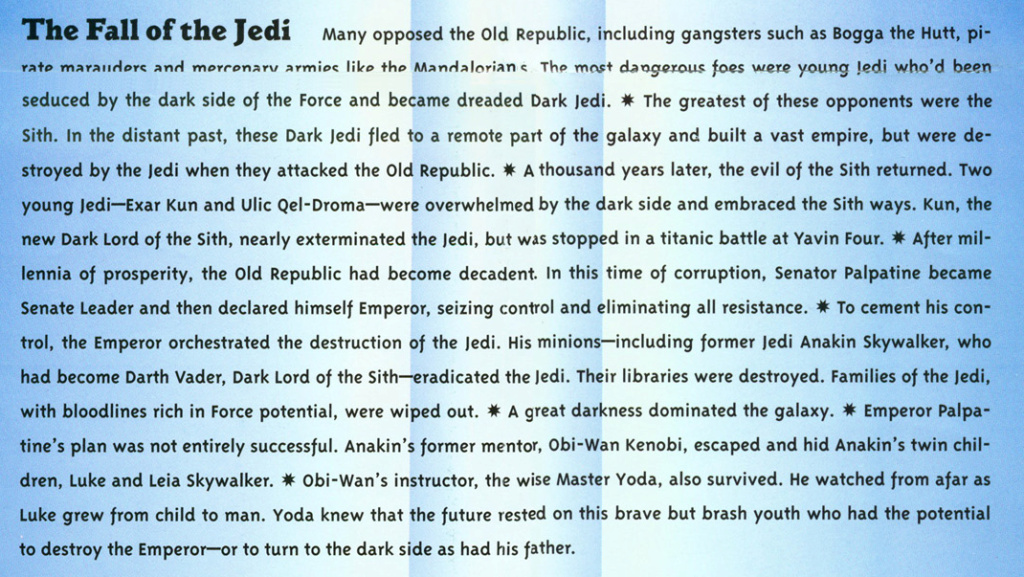
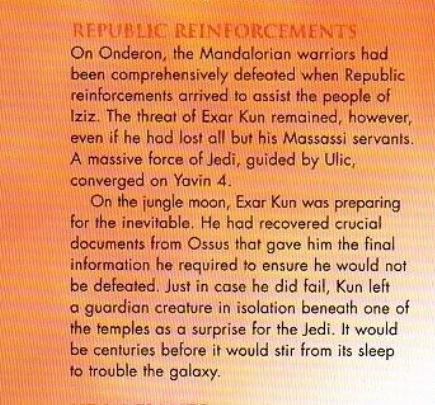
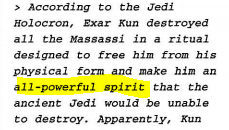
Simply put, Exar Kun's spirit is shown to wield powers far beyond Nightsisters who are all clearly on the scale of power of a great variety of Darth Sidious/Emperor Palpatine, and in his prime state he is shown to be able to almost match power unimaginably greater than power that Reborn Palpatine 'cannot stand' against. Darth Sidious in Episode III, doesn't even remotely stand a chance.
 Darth Durin's Baneling
Darth Durin's Baneling
 Darth Sidious opener - chain debunk
Darth Sidious opener - chain debunk
May 22nd 2023, 1:20 am
Not sure you're around anymore, so just going to post what I have now. Will finish up/go into more detail in the event of your return, may post a more complete overview on the Palpatine stuff as an independent blog if not.
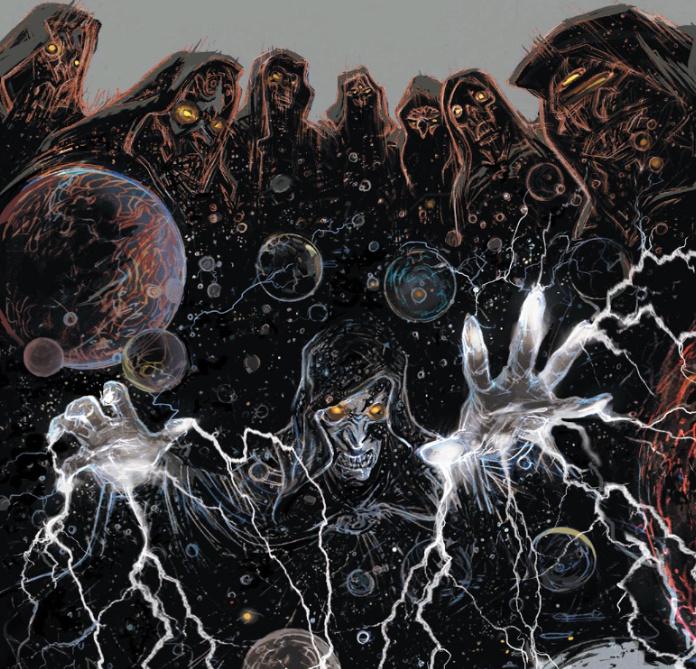
As I’m sure you’re aware, there’s quite the array of Palpatine supremacy statements.
With the sheer number of supremacy quotes for Palpatine, it becomes increasingly less likely that someone like Exar Kun (with only one or two supremacy statements of his own, if that) is more powerful. I know that these quotes alone are not enough to convince you. Instead, I’d like you to pay special attention to the dating of each of these statements.

-Attack of the Clones Visual Dictionary (2002, David West Reynolds)

-Attack of the Clones Data File Facts (2002)
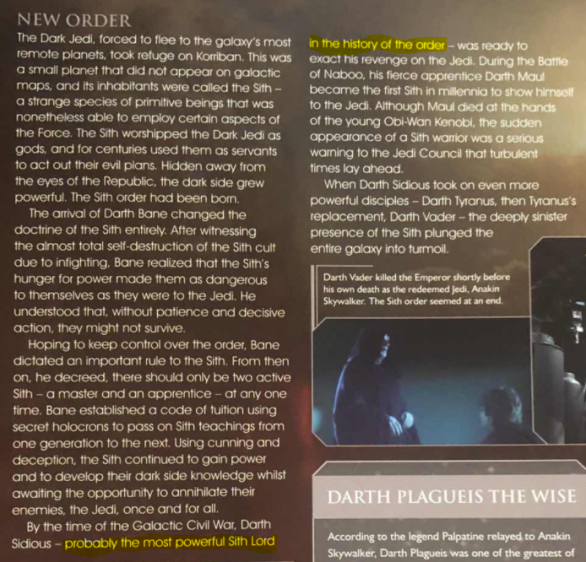
-The Official Figurine Collection #15 (2006, De Agostini)
Quite a few, and you’ll notice that they start in 2002, around the time the Prequels are coming out, and roll on through with no real signs of slowing down, right until the Disney purchase (and at least one after that).
When Palpatine was introduced to us in the Original Trilogy, he was left vague. He was neither “Darth Sidious” nor a Sith Lord at all until the Prequels. He was a Dark Jedi, just like the many to come after him in the 90s, such as Joruus C’baoth, Sedriss, Hethrir, Kueller, and Brakiss. As the most prominent of these characters, in and out of universe, he was afforded some respect, though even that was largely up to author discretion at the time. Palpatine, beyond “evil” and “a lot more powerful than Vader” was left essentially an enigma in the original films. How he was compared to author OCs was essentially up to the individual writers’ discretion. Want to establish your character as a threat? Great, give them favorable comparisons to Vader and Palpatine, the most well-known “powerful” baddies.
Then, when the Prequels released, and the character and his role got explored more by George Lucas, all of a sudden Palpatine being the pinnacle of the Sith Order becomes all but axiomatic truth. As Lucas became more involved with the character, the character rose above past limitations.
To clarify, under the current meta, none of Palpatine’s quotes “bind” Kun per se. That is not my intention of bringing them up. Instead, I bring them up to show when Palpatine supremacy really came into being in the eyes of the writers, and its incredible staying power (notably, not remotely stopping for 2010/2011 when Emperor Vitiate was introduced and Ritual Kun was further explored).
What we have here are around a dozen quotes, all from after Ritual Kun’s introduction in TotJ, with several after his clearer establishment as a physical being by SWTOR and SWG related content, a couple from extremely high profile, G-Canon-peripheral content, and one from a book co-written by Kevin J. Anderson, certainly one of Kun’s greatest contributors and advocates. None has any hangups on declaring Palpatine the unconditional greatest of all time. If any iteration of Kun is meant to be stronger, particularly a physical form of him with a permanent, legitimate boost, the writers have a funny way of showing it.
So, narratively, what exactly is Palpatine such that, starting with Lucas’s further exploration and explanation of him, so many writers seemingly got together and agreed that he was the most powerful Sith Lord in history?
Lucas’s take on Palpatine, has been very consistent on Palpatine’s standing from day one of his conception as a Dark Jedi.
Palpatine, in Lucas’s eyes, is always to be the end boss of Star Wars.
Palpatine, put simply, was brought into being by the Force as the Jedi Order’s reckoning.
Just as Anakin, the Chosen One, was a tool to bring balance to the Force, so, too, was Palpatine, the Sith’ari.
(It should be noted that this chapter of Darth Plagueis is titled Sith’ari, further reinforcing the interpretation that Palpatine’s assessment of himself as Sith’ari is accurate.)
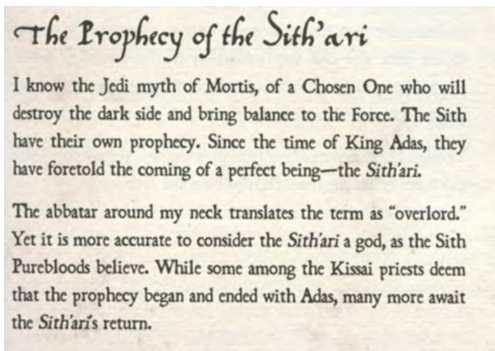

-Book of Sith (2012, Daniel Wallace)
(The Sith’ari is regarded as the Sith equivalent of the Chosen One. Palpatine is associated with “unlimited power” in the films as well as on this page, he leads the Sith as the Dark Lord and destroys them by betraying his apprentices one by one and declaring himself the last Dark Lord, and he is the Dark Lord to return the Sith from hiding and successfully instate their reign over the galaxy.)
Out of all previous Sith Lords and other antagonists to the Jedi Order, Palpatine is the one to bring an end to the Jedi Order and the Republic itself.
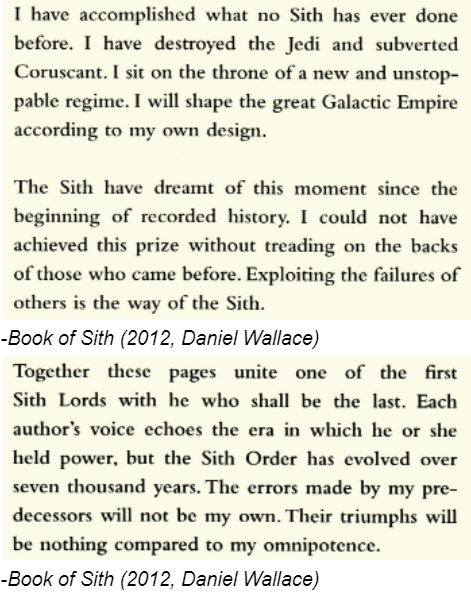
This is directly attributed to his power in the Dark Side.
In order to understand Palpatine’s role in Lucas’s eyes, it’s important to look at how Star Wars has been informed Lucas’s religious and mythological inspirations, notably Hinduism, Christianity, and the writings of Carlos Castaneda, and to compare those ideas with themes and patterns shown in the films and other content.
The Jedi of the Prequels were at the tail end of a millennium of peace brought on by the “good karma” of past ages (active defense of the people of the Republic, and serving the will of the Force). Because of this, they were at their zenith in terms of power, in the Force, in combat, and politically.
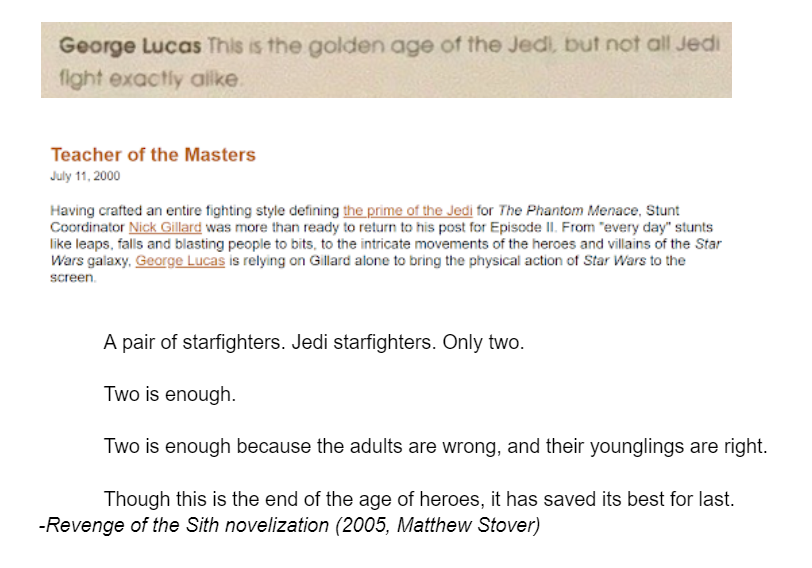
However, unlike those past eras, the Jedi had become complacent and bound by rules. Those Jedi who prioritized following the will of the Force (e.g. Qui-Gon Jinn, Zao) over procedure and tradition were few and far between.
The Jedi followed dogmatic rules on age and marriage. They rejected revelations and signs of change out of hand because they did not follow tradition. They followed an explicitly corrupt Senate, leading to tragedies such as the Battle of Galidraan and the neglect of the Outer Rim. They were hypocrites regarding battle. These failings, though of course not deliberately evil on the Jedi’s part, accumulated “negative karma” for the Order and led directly to the creation of the deliberately evil.
The Clones are also a huge indicator of this – a millions-strong testament to the overconfidence of the Jedi and the moral decline of the Republic.
General Grievous, the greatest Jedi killer of the age, became vulnerable to the Sith’s manipulations in large part due to the corruption in the Republic that led to the despoilment of his homeworld.
This can also be shown through Jedi to turn to the dark side during this time such as Depa Billaba, Asajj Ventress, Dooku, and Anakin Skywalker.
Depa Billaba is driven to the darkness because of the toll that the war, going against everything the Jedi stand for, takes on her spirit. Sora Bulq and Barriss Offee fell for similar reasons, and other Jedi such as K’Kruhk and Jeisel temporarily left the Order.
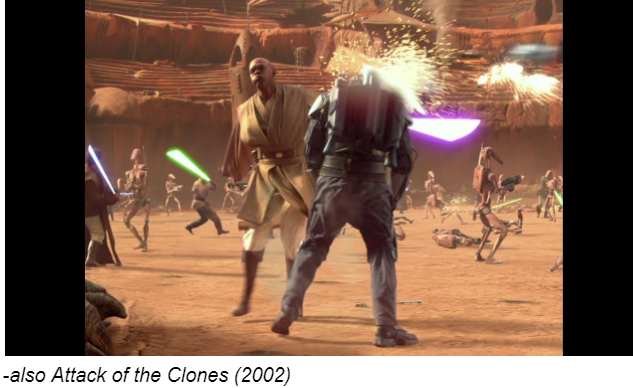
-also Attack of the Clones (2002)
-The Clone Wars Season 5 Episode 20: The Wrong Jedi (2013)
Asajj Ventress was driven to the dark side because of the Jedi’s neglect of the Outer Rim, mostly at the behest of the Inner Rim-biased Senate. This led to her master’s death and her abandonment, leaving her vulnerable to Dooku’s manipulations.

-The Clone Wars Season 3 Episode 12: Nightsisters (2011)
Dooku was driven to the dark out of his disgust for the Jedi’s unquestioning servitude of a corrupt government.
That “one more Jedi”, of course, proves to be Dooku’s own beloved student, Qui-Gon Jinn, who was killed due to the Council’s refusal to accept the Sith’s return.
With Anakin Skywalker, his fall was caused due a combination of all these factors, along with the Jedi manipulating him to their ends, not out of evil, but because they saw no alternative.
Similarly to Dooku, Qui-Gon’s death at the hands of Darth Maul led him further down the path to the Dark Side (the Duel of the Fates is given its name for that reason).
Similarly to Asajj Ventress, the Jedi’s neglect of the Outer Rim led to the continued enslavement and eventual death of a loved one, Shmi Skywalker, driving him to take revenge in a violent and cruel manner, and opening him further to Sith manipulation.
https://www.youtube.com/watch?v=yiLVNGl8rew
-Attack of the Clones (2002)
The Jedi’s largely arbitrary restrictions on age, marriage, and other traditions (notably absent in previous and subsequent eras, during which Jedi prove to be far more capable of reaching the ultimate enlightened state of becoming a Force ghost, e.g. Andur Sunrider, a weak late-joiner with a family who still easily becomes a full Force ghost) prove to be in themselves what draw Anakin closer to the dark side, as they condemn his relationships and deny him progression due to his joining at a later age.
The Jedi feel that manipulating Anakin has become their only option.
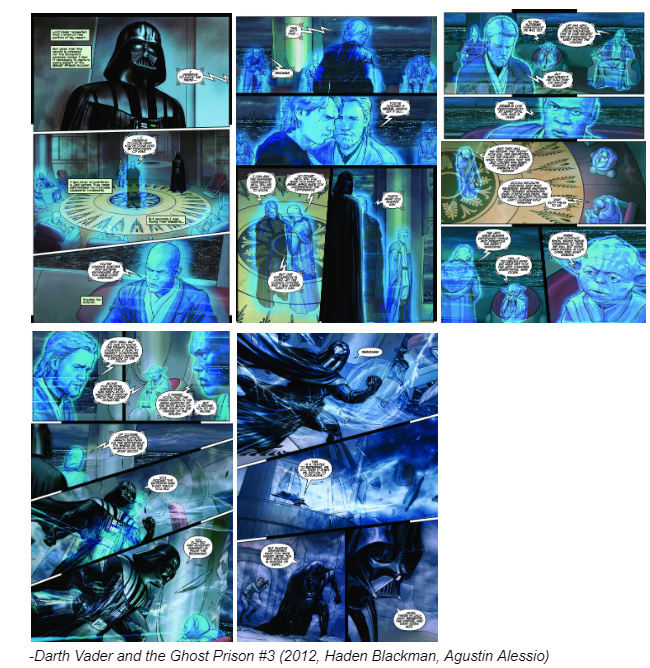
When Palpatine’s accusations of the Jedi prove to have some truth in them, that is what finally drives Anakin over to the dark side.
-Revenge of the Sith (2005)
With all of these characters, the road to hell, theirs and the Jedi who ultimately suffer from their evil actions, was paved with good intentions.
Star Wars has long established a pattern of failing to do the right thing being met with punishment in the form of evil born from those failings, based on the philosophies that we know to have played an immense role informing Lucas’s mythology. Then, Lucas goes well out of his way in the films and the Clone Wars to establish that the Jedi, while starting with good intentions, were not doing the right thing.
That “negative karma” the Jedi would naturally accumulate under that philosophy has to come back to bite them sometime… and it does, in the form of Palpatine.
Palpatine is referred to as the devil on many occasions by Lucas himself, an idea that he passed on to Ian McDiarmid as fundamental in his conception of Palpatine’s existence.
-George Lucas on the Force Interview (2010)
And is used as a stand-in for the dark side and the Sith Order themselves in the Lucas-vetted-and-approved novelization of Revenge of the Sith, often referred to as “the shadow” or “the Dark”.

Palpatine as the ultimate dark being is deeply ingrained in every level of the Star Wars story and its underlying mythology. Palpatine is the end to twenty-five millennia of history, the devil, the Sith’ari, and the archvillain of all time.
I know I spent a lot of time on the tangent (writing it I realized it would be better suited as its own blog), but I really do believe that the importance of Palpatine's role in the Star Wars mythological narrative to how his character is viewed in "versus" debates can't be overstated.
It is important for two reasons.
Firstly, it brings credence to the many supremacy statements Palpatine has.
Secondly, it gives us a reason as to why Palpatine is all but unbeatable.
As the closest there is to a mortal manifestation of the Dark Side, he is able to draw on the dark side's strengths. The act of fighting Palpatine is to lose. Yoda never stood a chance of beating Palpatine, not because he was so much less powerful. Palpatine is fueled by combat itself. Fighting him that way doesn't work. That's why Exar Kun can't win.
As previously established, Palpatine has every reason to be above every previous Sith Lord, including the Emperor Vitiate. If, for whatever reason, you take issue with Palpatine’s categorical supremacy being not-quite-categorical in regards to Ritual Kun, it certainly would apply to the Sith Emperor Vitiate, a well-known figure who is, unfortunately for him, caught wide net of Palpatine’s supremacy statements.
Exar Kun drains thousands of Massassi. Vitiate drains an entire planet, along with thousands of Sith Lords. The scale of Vitiate’s ritual is far greater, so it would stand to reason that Vitiate’s own amplification would be greater than Exar’s. Exar has no reason to be above the other Sith that Palpatine represents the ultimate version of.

Even in his ritual form, Kun knows that he cannot fight the entire Jedi Order. It’s not on the table. His objective of becoming a spirit is to survive, and to survive alone.
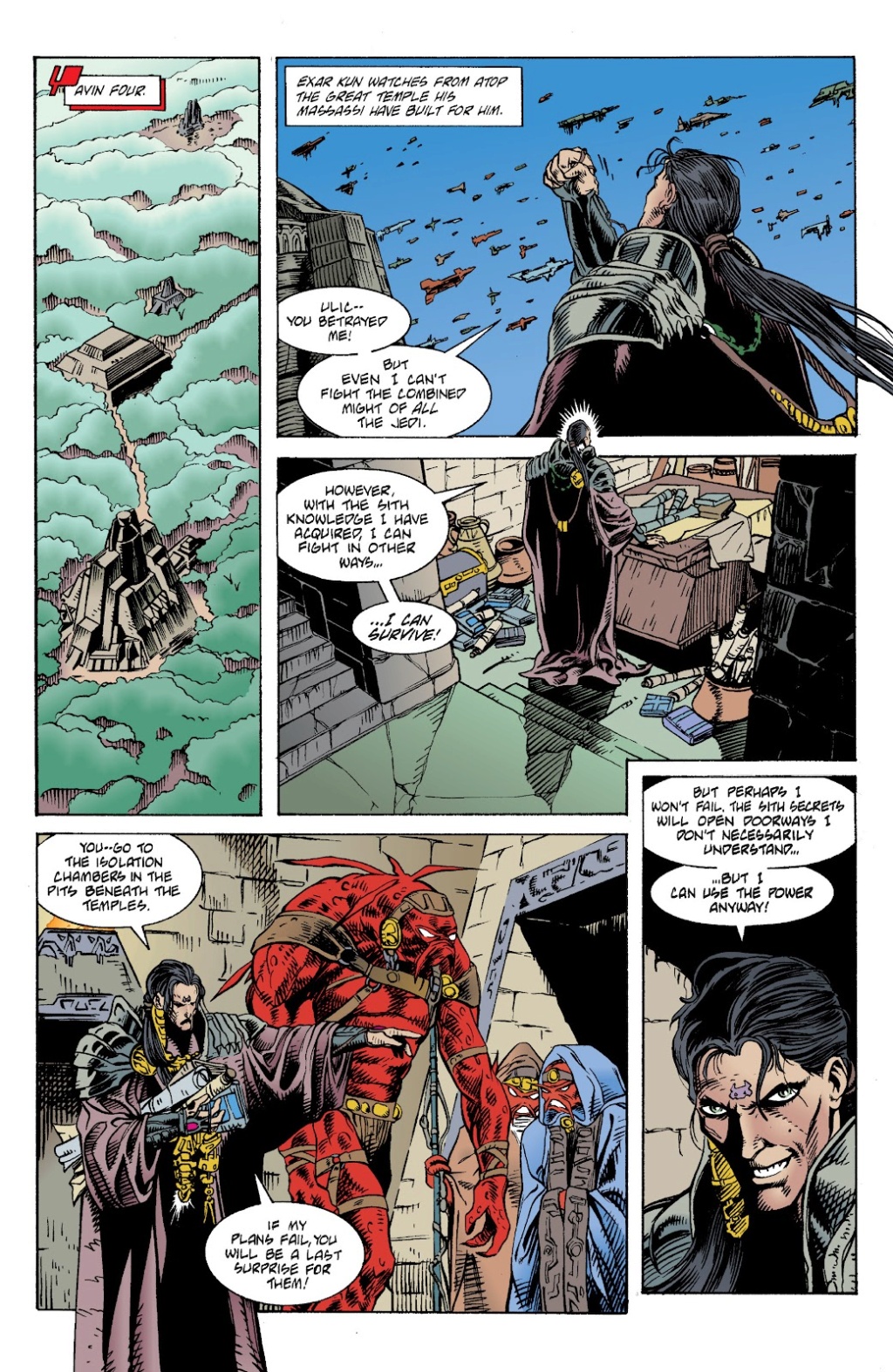
-Tales of the Jedi: The Sith War #6 (Kevin J. Anderson, Dario Carrasco Jr.)
In the images that you asserted to be of Ritual Kun in your unassailable blog fleshing out the concept of Ritual Kun as a usable character, Kun is being driven back into his temple by a handful of Republic troops, and he is backed into the asylum of his inner chambers by a couple unnamed, featless Jedi that, shockingly, miraculously, have been able to survive long enough against the Ritual Kun who was active in that battle to back him up that far and live.
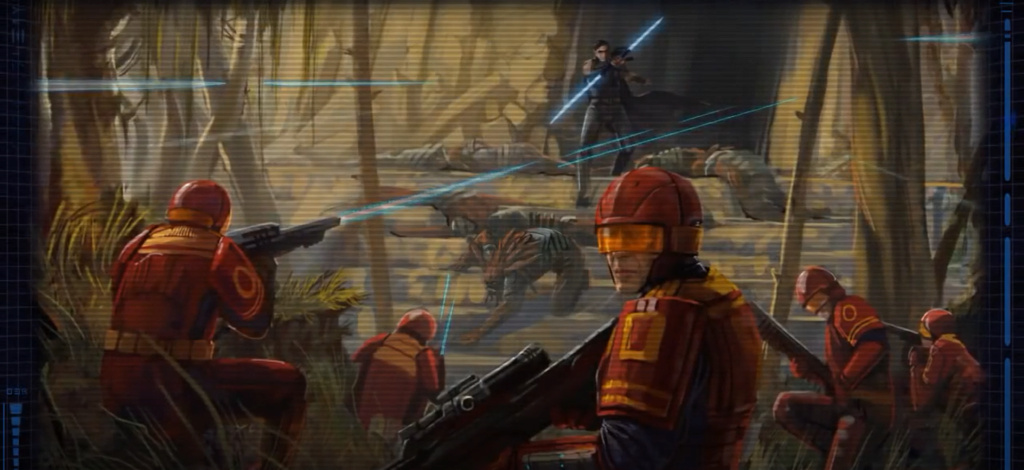
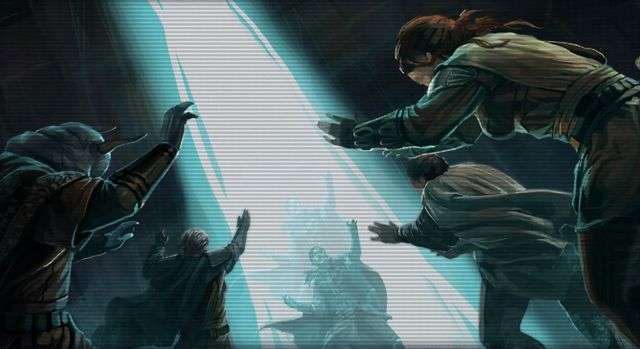
Really, what Kun does is not in keeping with anywhere close to a literal interpretation of "omnipotence." The term is applied here in the same way it is thrown to Darth Bane in other text.
Palpatine, in all those quotes, is frightened of her potential, not the level Asajj actually reaches. Asajj, throughout the Clone Wars, is able to semi-match the growth rates of Anakin and Obi-Wan, which would be a pretty terrifying trajectory if you know that your apprentice, Dooku, is likely trying to train her up to help him betray you. The quotes don't betray parity with Sidious in any way.
You seem to be trying to have your cake and eat it too here. Talzin is only capable of challenging Sidious when she’s on Dathomir. Otherwise, her powers are severely weakened. With Gethzerion, we are, as you pointed out, given no indication that her powers are dulled offworld. So while both are offworld, Gethzerion is certainly more powerful than Talzin, but nothing puts Gethzerion above the circumstantially powerful Talzin that is able to challenge Sidious. Dathomir simply impacts their powers differently (everything about the nightsisters is very different from TCW and surrounding material, as previously established.
We see Talzin do magick without incantations though, on several occasions, including the panels you posted of her and Palpatine doing battle.
T-Canon occasions of her doing this:
-The Clone Wars Season 3 Episode 11: Monster (2011)
-The Clone Wars Season 6 Episode 9: The Disappeared, Part II (2014)
While Talzin does do some incantations for complex rituals, it’s noted in one of the statements you provided that Gethzerion can only cast some spells silently. I fail to see the distinction you’re trying to make here.
Convenient for me, then, that you’ve proven that Gethzerion’s power isn’t tied to Dathomir in the same way that Talzin’s is, giving Palpatine a reason to fear Gethzerion leaving but not Talzin even if Talzin may be the stronger of the two on Dathomir.
Very nice for Gethzerion, yes. Palpatine is a coward though. If he doesn’t have to take a fight against someone who poses any kind of threat to him, he won’t.
-Revenge of the Sith (2005)
He wins that battle, and was the more powerful of the two. “Why leave”, indeed.
Beyond that, Palpatine was also scared enough of Ventress that he ordered her killed, a fact that you’ve shown quite clearly. Ventress, however, is still quite a ways away from being in Palpatine’s league as a combatant.
The Clone Wars Season 1 Episode 1: Ambush (2008)
Palpatine, physical manifestation of the dark that he is, must also be hateful, angry–and fearful.
-The Return of the Jedi (1983)
-The Phantom Menace (1999)
Palpatine being afraid of someone far less powerful than he is not only has established precedent, but is fully in keeping with the foundation of his character.
Atop this, not only Palpatine, but Vader as well, is stated quite explicitly many times over to be Gethzerion’s superior.
This includes a SWG peripheral source that brings up Gethzerion herself in the same article.
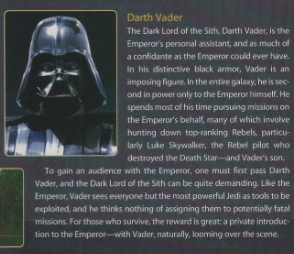
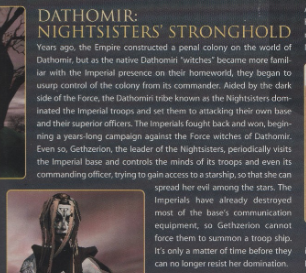
-Insider #65: Who’s Who in Star Wars Galaxies (2003, J.D. Wiker)
Taking all this into account, we know that Palpatine and Vader are stronger than Gethzerion through the original trilogy, and we have explanations built into both characters explaining why this is permitted to be the case.
Leia met Exar Kun after Gethzerion though, so there’s easily room for Gethzerion to be outside the span of “in years”, especially if “in years” is only going back to the last person she met with that kind of power, which would be Kun.
It is established several times at the G-Canon level, and even in the films themselves, that Luke Skywalker is the only person in the galaxy who can bring down Palpatine, or even Darth Vader.
-The Empire Strikes Back (1980)
So if we have four or more videogame PC characters running around during the course of the original trilogy that are not only heroic in nature, but individually have grown to become opponents on Palpatine’s level, then that flies in the face of the Original Trilogy’s narrative.
At the end of the day, the scaling you’ve argued for hits a hard G-Canon wall at its conclusion, preventing it from hitting, or even coming near, its intended target.
Additionally, several links of the chain you’ve outlined are tenuous to begin with, as I’ve addressed, leaving more than enough room for the creator viewpoints you’ve referenced to remain compatible with the films. By necessity, the chain does not hold.
Palpatine is repeatedly and categorically regarded as the GOAT Sith Lord of the Star Wars universe. Far from this being inane or arbitrary, the out-of-universe timeline for these statements allows one to see that this has roots with George’s canon and the underlying ideas of the Star Wars universe.
Exar Kun has no way of defeating Palpatine blow for blow, he would only be adding fuel to Palpatine’s cleansing fire.
Ritual Kun has neither the reason nor the showings to break out from under Palpatine.
The proposed Gethzerion scaling falls flat on several points and is necessarily untrue.
Exar Kun is made into another of Palpatine’s victims.
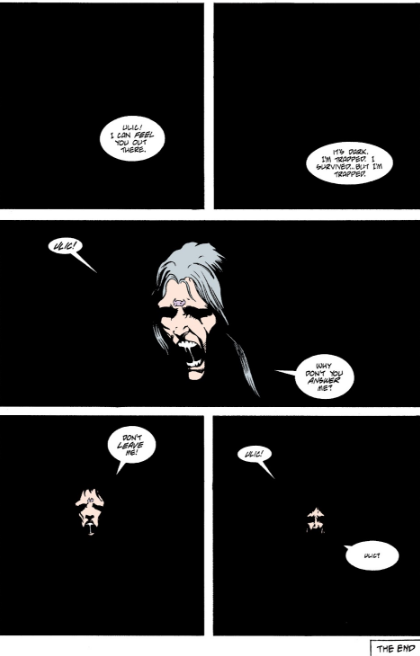


Evolving Intent
Supremacy Quotes
As I’m sure you’re aware, there’s quite the array of Palpatine supremacy statements.

With the sheer number of supremacy quotes for Palpatine, it becomes increasingly less likely that someone like Exar Kun (with only one or two supremacy statements of his own, if that) is more powerful. I know that these quotes alone are not enough to convince you. Instead, I’d like you to pay special attention to the dating of each of these statements.

-Attack of the Clones Visual Dictionary (2002, David West Reynolds)

-Attack of the Clones Data File Facts (2002)
Revenge of the Sith novelization (2005, Matthew Stover) wrote:And his apprentice kills him in his sleep," Palpatine said with a careless shrug. "Plagueis never sees it coming. That's the tragic irony, you see: he can save anyone in the galaxy from death - except himself."
"What about the apprentice? What happens to him?"
"Oh, him. He goes on to become the greatest Dark Lord the Sith have ever known…”
The New Essential Chronology (2005, Daniel Wallace, Kevin J. Anderson) wrote:Yoda went after Palpatine in the empty Senate chamber, but could not defeat the most powerful Sith Lord in history.
Vader: The Ultimate Guide (2005, Daniel Wallace, Abel G. Pena) wrote:Vader imagined the power that could be his if he crushed Palpatine and established his own rule over the Empire. But first, he would need his own apprentice. By himself, he could not hope to defeat the most powerful Sith Lord the galaxy had ever known.
Insider #86: Yoda’s Right Arm (2006, Daniel Wallace) wrote:When Yoda crosses sabers with the movie's arch-villain, he doesn't launch into a pinwheeling display of acrobatics, as he did against Count Dooku in Episode II. Instead, Yoda faces the dark side's fury, channeled by the most powerful Sith Lord in history

-The Official Figurine Collection #15 (2006, De Agostini)
The Clone Wars - Wild Space (2008, Karen Miller) wrote:"Master Yoda..." He steepled his fingers. "Are you quite certain young Anakin is ready for such a task?"
"Yes," said Yoda flatly.
And that was a lie. Yoda was a master at masking his emotions, but not even he could hide them from the greatest Sith Lord ever known. He was worried...and backed into a corner.
Clone Wars Gambit - Siege (2010, Karen Miller) wrote:Only his brutally rigorous self-discipline, the discipline of the greatest Sith Lord ever to live, saved Sidious from revealing the depth of his fury as Yoda explained the mission to Lanteeb.
Darth Plagueis (2012, James Luceno) wrote:Sidious paused, then, in derision, added, "Plagueis the Wise, who in his time truly was, except at the end, trusting that the Rule of Two had been superseded, and failed to realize that he would not be excused from it. Plagueis the Wise, who forged the most powerful Sith Lord the galaxy has ever known, and yet who forgot to leave a place for himself; whose pride never allowed him to question that he would no longer be needed."
Legends Epic Collection: The Empire Volume 1 (2017) wrote:With the galaxy now ripe for conquest, the Emperor has become the most powerful Sith Lord of all and a master of the Dark Side of the Force, ordering the extermination of the Jedi Order with the aid of his apprentice, the deadly Darth Vader.
Quite a few, and you’ll notice that they start in 2002, around the time the Prequels are coming out, and roll on through with no real signs of slowing down, right until the Disney purchase (and at least one after that).
When Palpatine was introduced to us in the Original Trilogy, he was left vague. He was neither “Darth Sidious” nor a Sith Lord at all until the Prequels. He was a Dark Jedi, just like the many to come after him in the 90s, such as Joruus C’baoth, Sedriss, Hethrir, Kueller, and Brakiss. As the most prominent of these characters, in and out of universe, he was afforded some respect, though even that was largely up to author discretion at the time. Palpatine, beyond “evil” and “a lot more powerful than Vader” was left essentially an enigma in the original films. How he was compared to author OCs was essentially up to the individual writers’ discretion. Want to establish your character as a threat? Great, give them favorable comparisons to Vader and Palpatine, the most well-known “powerful” baddies.
Then, when the Prequels released, and the character and his role got explored more by George Lucas, all of a sudden Palpatine being the pinnacle of the Sith Order becomes all but axiomatic truth. As Lucas became more involved with the character, the character rose above past limitations.
To clarify, under the current meta, none of Palpatine’s quotes “bind” Kun per se. That is not my intention of bringing them up. Instead, I bring them up to show when Palpatine supremacy really came into being in the eyes of the writers, and its incredible staying power (notably, not remotely stopping for 2010/2011 when Emperor Vitiate was introduced and Ritual Kun was further explored).
What we have here are around a dozen quotes, all from after Ritual Kun’s introduction in TotJ, with several after his clearer establishment as a physical being by SWTOR and SWG related content, a couple from extremely high profile, G-Canon-peripheral content, and one from a book co-written by Kevin J. Anderson, certainly one of Kun’s greatest contributors and advocates. None has any hangups on declaring Palpatine the unconditional greatest of all time. If any iteration of Kun is meant to be stronger, particularly a physical form of him with a permanent, legitimate boost, the writers have a funny way of showing it.
What is Palpatine?
So, narratively, what exactly is Palpatine such that, starting with Lucas’s further exploration and explanation of him, so many writers seemingly got together and agreed that he was the most powerful Sith Lord in history?
Lucas’s take on Palpatine, has been very consistent on Palpatine’s standing from day one of his conception as a Dark Jedi.
George Lucas / Story Conference / November 28 - December 2, 1977 (Star Wars Archives 1977-1983) wrote:Maybe something in the Force tells him to go (to Gas Planet) to save his friends, but the creature asks how he knows it's the good side of the Force that's telling him to go there? He's getting the feeling about where to go from the Force, but you don't know whether it's his desire to find his friends or whether it's Vader feeding him information. If we set up something earlier, after the first act with the Emperor, one dialogue scene, where he says, "You get Luke." It's better to have somebody worse than Vader. The dark side of the Force has to be personified and the best way is to personify the Emperor, making him the ultimate bad guy.
[...]
The Emperor is even more powerful than Vader. He is also an agent of the Force and he's the classic devil character. Hooded, dark figure - you don't even see who he is. Vader walks down the hall of the Imperial planet. There are these huge, narrow, steel corridors, very gray. Have Vader walking down this gray corridor and then he goes into a gray room. It's all steel and there at the end of the room on a throne is a gray, macabre, cold steel box and it's the Emperor. Really sterile and gray, cold interior. The Emperor tells Vader to stop Luke - to get Luke - he is the last of the Jedi and must be stopped. Vader is saying he's not a Jedi yet. Question is how quickly do we dole out things about the Emperor. The Emperor is even more powerful than Vader. The Emperor has to go for another three more episodes after Vader - he's got to last a lot longer. If you get rid of Vader you've got a worse Vader behind him. Not as dramatic as Vader, but at the same time more sinister. Vader is just one of his lap dogs. Do we show the Emperor this time or wait until the next one where we finally confront the Emperor. Once you've seen the Emperor, you're locked in on him. Decision now is not to see him - just hear about him - we don't see his face. Just a hooded figure - it's reminiscent of Ben. In the end, the Emperor does exactly what Ben did - he can also transform himself. As Ben becomes the personification of the good side of the Force, the Emperor is the bad. Another way to treat the Emperor would be as a bureaucrat, Nixonian in his outlook, sort of a Wizard of Oz type person. Maybe good this time to talk about the Emperor as this terrible force and that Vader is really afraid of the Emperor. That's the only thing Vader is afraid of. Best way to set up a super-villain is to take the biggest villain you've got and make him afraid of the super-villain. We'll set up something where Vader is afraid of the Emperor.
[...]
The Emperor may be the one who is saved for the end. When you get rid of the Emperor, the whole thing is over with. The final episode is the restoration of the Republic.
Star Wars Episode III: Becoming Sidious Webisode (2005) wrote:[George Lucas:] “Now you've created the archvillain of all time, but I guess it's all in a day's work.”
Palpatine, in Lucas’s eyes, is always to be the end boss of Star Wars.
Palpatine, put simply, was brought into being by the Force as the Jedi Order’s reckoning.
Just as Anakin, the Chosen One, was a tool to bring balance to the Force, so, too, was Palpatine, the Sith’ari.
Darth Plagueis (2012, James Luceno) wrote:"The truth is that I haven't changed. As we have clouded the minds of the Jedi, I clouded yours. Never once did I have any intention of sharing power with you. I needed to learn from you; no more, no less. To learn all of your secrets, which I trusted you would eventually reveal. But what made you think that I would need you after that? Vanity, perhaps; your sense of self-importance. You've been nothing more than a pawn in a game played by a genuine Master.
"The Sith'ari."
(It should be noted that this chapter of Darth Plagueis is titled Sith’ari, further reinforcing the interpretation that Palpatine’s assessment of himself as Sith’ari is accurate.)


-Book of Sith (2012, Daniel Wallace)
(The Sith’ari is regarded as the Sith equivalent of the Chosen One. Palpatine is associated with “unlimited power” in the films as well as on this page, he leads the Sith as the Dark Lord and destroys them by betraying his apprentices one by one and declaring himself the last Dark Lord, and he is the Dark Lord to return the Sith from hiding and successfully instate their reign over the galaxy.)
Out of all previous Sith Lords and other antagonists to the Jedi Order, Palpatine is the one to bring an end to the Jedi Order and the Republic itself.
Revenge of the Sith novelization (2005, Matthew Stover) wrote:This is how twenty-five millennia come to a close. Corruption and treachery have crushed a thousand years of peace. This is not just the end of a republic; night is falling on civilization itself.
This is the twilight of the Jedi.
The end starts now.

This is directly attributed to his power in the Dark Side.
The Force Unleashed novelization (2008, Sean Williams) wrote:Then, putting her out of his mind-as much as he was able- he chose between east and west at random and began looking for a way into the station. He could feel Master Kota and the others somewhere in the massive superstructure, but their Force-signatures were obscured by the presence of so much suffering. If the Emperor was there, too, that would further cloud the issue. The apprentice had never met his Master's Master in person, but the Sith Lord who had single-handedly wiped out nearly every Jedi in the galaxy would cast a shadow deep enough to hide anything.
In order to understand Palpatine’s role in Lucas’s eyes, it’s important to look at how Star Wars has been informed Lucas’s religious and mythological inspirations, notably Hinduism, Christianity, and the writings of Carlos Castaneda, and to compare those ideas with themes and patterns shown in the films and other content.
The Jedi of the Prequels were at the tail end of a millennium of peace brought on by the “good karma” of past ages (active defense of the people of the Republic, and serving the will of the Force). Because of this, they were at their zenith in terms of power, in the Force, in combat, and politically.

However, unlike those past eras, the Jedi had become complacent and bound by rules. Those Jedi who prioritized following the will of the Force (e.g. Qui-Gon Jinn, Zao) over procedure and tradition were few and far between.
The Jedi followed dogmatic rules on age and marriage. They rejected revelations and signs of change out of hand because they did not follow tradition. They followed an explicitly corrupt Senate, leading to tragedies such as the Battle of Galidraan and the neglect of the Outer Rim. They were hypocrites regarding battle. These failings, though of course not deliberately evil on the Jedi’s part, accumulated “negative karma” for the Order and led directly to the creation of the deliberately evil.
The Clones are also a huge indicator of this – a millions-strong testament to the overconfidence of the Jedi and the moral decline of the Republic.
-The Clone Wars: Wild Space (2008, Karen Miller) wrote:Remembering the Kaminoan cloning facility, its bright white sterility, its impersonal care for the creatures it created so efficiently, so remarkably, so wholly without compunction, he repressed a shudder.
Deep questions of morality and ethics do these clones raise. But answers are there? Know that I do not. Override ethics our desperate need for them might.
General Grievous, the greatest Jedi killer of the age, became vulnerable to the Sith’s manipulations in large part due to the corruption in the Republic that led to the despoilment of his homeworld.
Insider #86: Unknown Soldier (2006, Abel G. Pena) wrote:The Yam'rii. in league with the Trade Federation,
pleaded with the Republic to intercede on their behalf, and
the Republic Judicial Department sent a Jedi team, led by
Masters T'chooka D'oon and Jmmaar. to adjudicate the
conflict. With Senate pressure, both Masters ruled in favor
of the Yam'rii and imposed sanctions and reparations on the
Kalee was economically decimated, and the Kaleesh died in
droves. Grievous simmered with hatred for the galactic
government and the Jedi who served it as he watched his
wives die of starvation and saw his children kidnapped and
subjected to the worst acts of depravity.
Into this madness came InterGalactic Banking Clan
Chairman San Hill, an emaciated Muun who looked as
thought he. too. were half-starved. He conspired to employ
Kalee's greatest champion as a "collections agent." In
exchange, the Banking Clan would share the burden of
Kalee's enormous debt. Grievous was disgusted at the idea
of serving the megacorporation, deeming it nothing more
than the work of a glorified leg-breaker. Still, the innate
fighter could not resist the promise of renewed conflict.
Grievous began his new occupation by aggressively
collecting from such worlds as Ord Mantell and seizing
Muunilinst's Phlut Design Systems. Because the Banking
Clan would not hire Grievous' Kaleesh warriors, he
demanded more intelligent battle droids to serve him. With
Count Dooku's permission. Chairman Hill complied, putting
the IG-100 MagnaDroids into production. Hill also upheld
his promise to help alleviate Kalee's deficit and reinstate
trade. But when Grievous learned that the Republic did
nothing to the Yam'rii for vandalizing hallowed Kaleesh
burial grounds on the colony worlds, he abandoned his
contract and returned to Kalee to avenge the desecration.
This can also be shown through Jedi to turn to the dark side during this time such as Depa Billaba, Asajj Ventress, Dooku, and Anakin Skywalker.
Depa Billaba is driven to the darkness because of the toll that the war, going against everything the Jedi stand for, takes on her spirit. Sora Bulq and Barriss Offee fell for similar reasons, and other Jedi such as K’Kruhk and Jeisel temporarily left the Order.
An Oral History of Star Wars (2019) wrote:[George Lucas:] The thing is, in IV, V, and VI, you didn’t really get to see real Jedi in action. To me, that was something that a lot of people would want to see. And of course, the other part is, where are the Jedi at this point? What are they? We’ve never seen one, really, except for Obi-Wan.
The idea was to establish Jedi as what they were, which is sort of peacekeepers who moved through the galaxy to settle disputes. They aren’t policemen, they aren’t soldiers; they’re mafia dons. They come in and sit down with the two different sides and say, “Okay, now we’re going to settle this.”
A lot of people say, “What good is a lightsaber against a tank?” The Jedi weren’t meant to fight wars. That’s the big issue in the prequels. They got drafted into service, which is exactly what Palpatine wanted.
Attack of the Clones (2002) wrote:[Mace Windu:] “We are keepers of the peace, not soldiers.”

-also Attack of the Clones (2002)
Shatterpoint (2003, Matthew Stover) wrote:She told me: "The Jedi will lose."
There in the cave, as fever wasp larvae snapped and crackled in the tyruun flames, I countered with numbers: there are still ten times as many Loyalist systems as Separatist, the Republic has a titanic manufacturing base, and huge advantages in resources... the beginnings of a whole list of reasons the Republic will inevitably win.
"Oh, I know," was her response. "The Republic may very well win. But the Jedi will lose."
I said I did not understand, but I now believe that is not true. The truth, I think, is what the Force said to me in the image of Depa back at the outpost: that I already understand all there is to understand.
I just don't want to believe it.
She said that I had foreshadowed the defeat of the Jedi myself. "The reason you freed the Balawai, Mace," she said, "is the same reason that the Jedi will be destroyed."
War is a horror, she said. Her words: "A horror. But what you don't understand is that it must be a horror. That's how wars are won: by inflicting such terrible suffering upon the enemy that they can no longer bear to fight. You cannot treat war like law enforcement, Mace. You can't fight to protect the innocent-because no one is innocent."
She said something similar to what Nick had said about the jungle prospectors: that there are no civilians.
"The innocent citizens of the Confederacy are the ones who make it possible for their leaders to wage war on us: they build the ships, they grow the food, mine the metals, purify the water. And only they can stop the war: only their suffering will bring it to a close."
"But you can't expect Jedi to stand by while ordinary people are hurt and killed-" I began.
"Exactly. That is why we cannot win: to win this war, we must no longer be Jedi." She speaks of this in the future tense, though I suspect that in her heart-in her conscience-the Jedi are dead already. "Like dropping a bomb into the arena on Geonosis: we can save the Republic, Mace. We can. But the cost will be our principles. In the end, isn't that what Jedi are for? We sacrifice everything for the Republic: our families, our homeworlds, our wealth, even our lives. Now the Republic needs us to sacrifice our consciences as well. Can we refuse? Are Jedi traditions more important than the lives of billions?"
-The Clone Wars Season 5 Episode 20: The Wrong Jedi (2013)
Asajj Ventress was driven to the dark side because of the Jedi’s neglect of the Outer Rim, mostly at the behest of the Inner Rim-biased Senate. This led to her master’s death and her abandonment, leaving her vulnerable to Dooku’s manipulations.

-The Clone Wars Season 3 Episode 12: Nightsisters (2011)
Dooku was driven to the dark out of his disgust for the Jedi’s unquestioning servitude of a corrupt government.
Darth Plagueis (2012, James Luceno) wrote:"The Order's place in this is a matter Sifo-Dyas and I have discussed endlessly," Dooku snapped. "But the members of the Council are not similarly inclined. They are entrenched in archaic thinking, and slow to embrace change." He paused, and adopted a sinister look. "Don't let yourself be fooled, Palpatine. They see dark times ahead. In fact, they think of little else. That's why they have allowed the Jedi to become involved in parochial conflicts like those at Galidraan, Yinchorr, and Baltizaar, which are like brush fires born of windblown embers from a massive blaze just beyond the horizon. But instead of actually rising up against the corruption in the Republic, perhaps disbanding the Senate entirely for a period of time, they have become fixated on prophecy. They await the coming of a prophesized redeemer who will bring balance to the Force and restore order."
"A redeemer?" Palpatine stared at him in authentic surprise. "You've never alluded to this prophecy."
"Nor would I now if I still thought of myself as loyal to the Order."
"I never considered that the Force needed to be balanced."
Dooku's lip curled. "The Order interprets the prophecy to mean that the dark tide needs to be stemmed."
"You don't accept it?"
Dooku had an answer ready. "Here is the truth of it: the Jedi could fulfill the prophecy on their own, if they were willing to unleash the full powers of the Force."
"The full powers of the Force," Palpatine said. "I'm afraid you've lost me."
Dooku blew out his breath. "Perhaps it's something we can discuss in the future."
"You've made your decision, then?"
Dooku nodded. "If one more Jedi dies because of indolence on the part of the Republic and moral equivocation on the part of the Council, I will leave the Temple and refuse to look back."
That “one more Jedi”, of course, proves to be Dooku’s own beloved student, Qui-Gon Jinn, who was killed due to the Council’s refusal to accept the Sith’s return.
The Phantom Menace (1999) wrote:[Qui-Gon Jinn:] “He was trained in the Jedi arts. My only conclusion can be that it was a Sith Lord.”
[Ki-Adi-Mundi:] “Impossible. The Sith have been extinct for a millennium!”
[Mace Windu:] “I do not believe the Sith could have returned without us knowing.”
With Anakin Skywalker, his fall was caused due a combination of all these factors, along with the Jedi manipulating him to their ends, not out of evil, but because they saw no alternative.
Similarly to Dooku, Qui-Gon’s death at the hands of Darth Maul led him further down the path to the Dark Side (the Duel of the Fates is given its name for that reason).
Similarly to Asajj Ventress, the Jedi’s neglect of the Outer Rim led to the continued enslavement and eventual death of a loved one, Shmi Skywalker, driving him to take revenge in a violent and cruel manner, and opening him further to Sith manipulation.
The Phantom Menace (1999) wrote:[Padme Amidala:] “I can’t believe there’s still slavery in the galaxy. The Republic’s anti-slavery laws are…”
[Shmi Skywalker:] “The Republic doesn’t exist out here. We must survive on our own.”
https://www.youtube.com/watch?v=yiLVNGl8rew
-Attack of the Clones (2002)
The Jedi’s largely arbitrary restrictions on age, marriage, and other traditions (notably absent in previous and subsequent eras, during which Jedi prove to be far more capable of reaching the ultimate enlightened state of becoming a Force ghost, e.g. Andur Sunrider, a weak late-joiner with a family who still easily becomes a full Force ghost) prove to be in themselves what draw Anakin closer to the dark side, as they condemn his relationships and deny him progression due to his joining at a later age.
The Phantom Menace (1999) wrote: [Ki-Adi-Mundi:] “The Force is strong with him.”
[Qui-Gon Jinn:] “He is to be trained then?”
[Mace Windu:] “No. He will not be trained.”
[Qui-Gon Jinn:] “‘No’?”
[Mace Windu:] “He is too old.”
[Qui-Gon Jinn:] “He is the Chosen One. You must see it.”
Clone Wars Chapter 21 (2005) wrote: [Even Piell:] “Our numbers were dwindling before, and now this!”
[Shaak Ti:] “Yes. We need more Knights.”
[Obi-Wan Kenobi:] “I know this will generate debate, but I suggest that in this time of war, we forgo the trials and promote my Padawan Anakin to Jedi Knight.”
[Oppo Rancisis:] “This is preposterous! We can’t set aside our most hallowed traditions.”
Legacy of the Force: Bloodlines (2006, Karen Traviss) wrote:"You are on this Council, but we do not grant you the rank of Master."
"What? How can you do this? This is outrageous! It's unfair! I'm more powerful than any of you. How can you be on the Council and not be a Master?"
It was a boy's expression of anger, but it was true. And, as history repeated itself because it had no other choice, Jacen was more powerful than any of them except Luke. And he was growing closer to Luke's strength by the day.
The Clone Wars: No Prisoners (2009, Karen Traviss) wrote:Anakin felt the resentment, doubt, and bewilderment start to bubble up again. He stretched out on the sofa, his head resting on Padmé’s lap, and thought of one member of the Jedi Council.
Ki-Adi-Mundi’s got wives. Not just one. Five. And lots of daughters. Usual for a Cerean. But a Jedi?
The Cerean didn’t look as if he’d been corrupted by attachment. Nobody mentioned it; Jedi did marry, then, and the galaxy didn’t implode. This fact was the bantha in the dining room, the huge, silent, looming thing that everyone could see but nobody talked about, as if it wasn’t there at all, and had to be ignored at all costs.
Just because Cereans had a low birthrate, and too few males, they had to take wives. So Ki-Adi-Mundi could remain a Jedi, serve on the Council, and have a family. Suddenly none of this made sense to Anakin. The needs of Cerea had no bearing on it. Either attachment was a bad idea for Jedi, or it wasn’t.
Fine. Have it your way, Master Yoda. I feel no guilt about bending the rules to fit my heart if you bend the rules on the basis of species. Or expedience. Or whatever.
“They say love turns a Jedi to the dark side,” he said at last. “I can’t see how love can do that. But being forced to skulk around and lie—that’s a recipe for trouble. Now, look at Ki-Adi—”
The Jedi feel that manipulating Anakin has become their only option.
Revenge of the Sith novelization (2005, Matthew Stover) wrote:Conflicting currents of energy swirled and clashed in the Council Chamber. Traditionally, decisions of the Council were reached by quiet, mutual contemplation of the flow of the Force, until all the Council was of a single mind on the matter. But Obi-Wan knew of this tradition only by reputation, from tales in the archives and stories told by Masters whose tenure on the Council predated the return of the Sith. In the all-too-short years since Obi-Wan's own elevation, argument in this Chamber was more the rule than the exception.
"An unintentional opportunity, the Chancellor has given us," Yoda said gravely. "A window he has opened into the operations of his office. Fools we would be, to close our eyes."
"Then we should use someone else's eyes," Obi-Wan said "Forgive me, Master Yoda, but you just don't know him the way I do. None of you does. He is fiercely loyal, and there is not a gram of deception in him. You've all seen it; it's one of the arguments that some of you, here in this room, have used against elevating him to Master: he lacks true Jedi reserve, that's what you've said. And by that we all mean that he wears his emotions like a HoloNet banner. How can you ask him to lie to a friend to spy upon him?"
"That is why we must call upon a friend to ask him," said Agen Kolar in his gentle Zabrak baritone.
"You don't understand. Don't make him choose between me and Palpatine-"
"Why not?" asked the holopresence of Plo Koon from the bridge of Courageous, where he directed the Republic Navy strike force against the Separatist choke point in the Ywllandr system. "Do you fear you would lose such a contest?"
"You don't know how much Palpatine's friendship has meant to him over the years. You're asking him to use that friendship as a weapon! To stab his friend in the back. Don't you understand what this will cost him, even if Palpatine is entirely innocent? Especially if he's innocent. Their relationship will never be the same-"
"And that," Mace Windu said, "may be the best argument in favor of this plan. I have told you all what I have seen of the energy between Skywalker and the Supreme Chancellor. Anything that might distance young Skywalker from Palpatine's influence is worth the attempt."
Obi-Wan didn't need to reach into the Force to know that he would lose this argument. He inclined his head. "I will, of course, abide by the ruling of this Council."
"Doubt of that, none of us has." Yoda turned his green gaze on the other councilors. "But if to be done this is, decide we must how best to use him."
The holopresence of Ki-Adi-Mundi flickered in and out of focus as the Cerean Master leaned forward, folding his hands. "I, too have reservations on this matter, but it seems that in these desperate times, only desperate plans have hope of success. We have seen that young Skywalker has the power to battle a Sith Lord alone, if need be; he has proven that with Dooku. If he is indeed the chosen one, we must keep him in play against the Sith-keep him in a position to fulfill his destiny."

When Palpatine’s accusations of the Jedi prove to have some truth in them, that is what finally drives Anakin over to the dark side.
-Revenge of the Sith (2005)
Revenge of the Sith (2005) wrote:[Palpatine, on Dooku:] “He was too dangerous to be left alive.”
Revenge of the Sith (2005) wrote:[Mace Windu, on Palpatine:] “He’s too dangerous to be left alive!”
With all of these characters, the road to hell, theirs and the Jedi who ultimately suffer from their evil actions, was paved with good intentions.
The Complete Star Wars Encyclopedia (2008, Pablo Hidalgo, Steven J. Sansweet) wrote:This was the name used by the ancient Sith to describe a perfect being who would rise to power and bring balance to the Force. According to prophecy, the Sith'ari would rise up and destroy the Sith, but in the process would return to lead the Sith and make them stronger than ever before.
Knights of the Old Republic II: The Sith Lords (2004) wrote:[Kreia:] “Because I hate the Force. I hate that it seems to have a will, that it would control us to achieve some measure of balance, when countless lives are lost.”
The Clone Wars: Wild Space (2008, Karen Miller) wrote:Yoda nodded, his gnarled fingers tight about his ancient gimer stick.”The truth you speak, Master Windu. Nothing gained, there is, without some loss also to balance the scales.”
Star Wars has long established a pattern of failing to do the right thing being met with punishment in the form of evil born from those failings, based on the philosophies that we know to have played an immense role informing Lucas’s mythology. Then, Lucas goes well out of his way in the films and the Clone Wars to establish that the Jedi, while starting with good intentions, were not doing the right thing.
That “negative karma” the Jedi would naturally accumulate under that philosophy has to come back to bite them sometime… and it does, in the form of Palpatine.
Palpatine is referred to as the devil on many occasions by Lucas himself, an idea that he passed on to Ian McDiarmid as fundamental in his conception of Palpatine’s existence.
-George Lucas on the Force Interview (2010)
Revenge of the Sith Q&A (2005) wrote:[Ian McDiarmid:] It always helps. It helps to be a monster in monster’s makeup. George was very interesting when we started Phantom Menace. He said you should think of your eyes as his contact lenses. It's a great thing to say to an actor. Then my face becomes his mask. Then when I put on the mask, I become him. So that kind of character is always fun to play. In this film, one explodes into the other and he is who he is. Worse than the devil and worse than Darth Vader, who in this movie comes across as more sympathetic than people might have expected.
[...]
[Interviewer:] What was the best thing about being bad? Palpatine is the baddest of the bad.
[Ian McDiarmid:] He is. The darkest of the dark and blackest of the black. Worse than Satan. You're not going to get a part like that every day. I like the fact that he did not have any psychological workings. He was spawned in hell. Siths are apparently. They can't get better.
And is used as a stand-in for the dark side and the Sith Order themselves in the Lucas-vetted-and-approved novelization of Revenge of the Sith, often referred to as “the shadow” or “the Dark”.
Revenge of the Sith (2005, Matthew Stover) wrote:"Have you never noticed that the Jedi way," Palpatine said, invisible now within the stark shadow of the General's Chair, "is not always the right way?"
Anakin looked toward the shadow. "You don't understand. You're not a Jedi. You can't understand."
"Anakin, listen to me. How many lives have you just saved with this stroke of a lightsaber? Can you count them?"
"But-"
"It wasn't wrong, Anakin. It may be not the Jedi way, but it was right. Perfectly natural-he took your hand; you wanted revenge. And your revenge was justice."
"Revenge is never just. It can't be-"
"Don't be childish, Anakin. Revenge is the foundation of justice. Justice began with revenge, and revenge is still the only jusice some beings can ever hope for. After all, this is hardly your first time, is it? Did Dooku deserve mercy more than did the and People who tortured your mother to death?"
"That was different.'"
In the Tusken camp he had lost his mind; he had become a force of nature, indiscriminate, killing with no more thought or intention than a sand gale. The Tuskens had been killed, slaughtered, massacred-but that had been beyond his control, and now it seemed to him as if it had been done by someone else: like a story he had heard that had little to do with him at all. But Dooku-Dooku had been murdered. By him. On purpose.
Here in the General's Quarters, he had looked into the eyes of a living being and coldly decided to end that life. He could have chosen the right way. He could have chosen the Jedi way. But instead-He stared down at Dooku's severed head. He could never unchoose this choice. He could never take it back. As Master Windu liked to say, there is no such thing as a second chance.
And he wasn't even sure he wanted one. He couldn't let himself think about this. Just as he didn't let himself think about the dead on Tatooine. He put his hand to his eyes, trying to rub away the memory. "You promised we would never talk about that again."
"And we won't. Just as we need never speak of what has happened here today." It was as though the shadow itself spoke kindly. "I have always kept your secrets, have I not?"
"Yes-yes, of course, Chancellor, but-" Anakin wanted to crawl away into a corner somewhere; he felt sure that if things would just stop for a while-an hour, a minute-he could pull himself together and find some way to keep moving forward. He had to keep moving forward. Moving forward was all he could do.
Revenge of the Sith (2005, Matthew Stover) wrote:"I'm sorry," he said. "I'm sorry, but-but as much as I want those things-as much as I care for you, sir-I can't. I just can't. Not yet. Because there's only one thing I really want, right now. Everything else will just have to wait."
"I know what you truly want," the shadow said. "I have only been waiting for you to admit it to yourself." A hand-a human hand, warm with compassion-settled onto his shoulder. "Listen to me: I can help you save her?'' "You-"
Anakin blinked blindly. "How can you help?"
"Do you remember that myth I told you of, The Tragedy of Darth Plagueis the Wise?" the shadow whispered. The myth–directly influence the midi-chlorians to create life; with such knowledge, to maintain life in someone already living would seem a small matter…
"Yes," Anakin said. "Yes, I remember."
The shadow leaned so close that it seemed to fill the world.
"Anakin, it's no mere myth."
Anakin swallowed.
"Darth Plagueis was real."
Anakin could force out only a strangled whisper. "Real . . . ?"
"Darth Plagueis was my Master. He taught me the key to his power," the shadow said, dryly matter-of-fact, "before I killed him."
Revenge of the Sith (2005, Matthew Stover) wrote:The Face of the Dark
Depowered lampdisks were rings of ghostly gray floating in the gloom. The shimmering jewelscape of Coruscant haloed the knife-edged shadow of the chair.
This was the office of the Chancellor.
Within the chair's shadow sat another shadow: deeper, darker, formless and impenetrable, an abyssal umbra so profound that it drained light from the room around it.
And from the city. And the planet.
And the galaxy.
The shadow waited. It had told the boy it would. It was looking forward to keeping its word.
For a change.
Revenge of the Sith (2005, Matthew Stover) wrote:It is in this blazing moment that you finally understand the trap of the dark side, the final cruelty of the Sith-Because now your self is all you will ever have.
And you rage and scream and reach through the Force to crush the shadow who has destroyed you, but you are so far less now than what you were, you are more than half machine, you are like a painter gone blind, a composer gone deaf, you can remember where the power was but the power you can touch is only a memory, and so with all your world-destroying fury it is only droids around you that implode, and equipment, and the table on which you were strapped shatters, and in the end, you cannot touch the shadow.
In the end, you do not even want to.
In the end, the shadow is all you have left. Because the shadow understands you, the shadow forgives you, the shadow gathers you unto itself-And within your furnace heart, you burn in your own flame. This is how it feels to be Anakin Skywalker. Forever…
Darth Plagueis (2012, James Luceno) wrote:Palpatine is the dark embodiment of this principle, a millennium of the Jedi’s vices rolled into one being and sent back at them. He was the Sith’ari, created by the Force to eradicate the Jedi, before being eradicated in turn by the Chosen One, Anakin Skywalker, so the galaxy could start anew. He was the necessary evil to return the galaxy to balance.
Palpatine cut his eyes to Plagueis. "The Sith are considered to be evil."
"Evil?" Plagueis repeated. "What is that? Moments ago you defined yourself as a storm. You said you were death itself. Are you evil, then, or are you simply stronger and more awake than others? Who gives more shape to sentient history: the good, who adhere to the tried and true, or those who seek to rouse beings from their stupor and lead them to glory? A storm you are, but a much-needed one, to wash away the old and complacent and prune the galaxy of deadweight."

Palpatine as the ultimate dark being is deeply ingrained in every level of the Star Wars story and its underlying mythology. Palpatine is the end to twenty-five millennia of history, the devil, the Sith’ari, and the archvillain of all time.
Revenge of the Sith (2005, Matthew Stover) wrote:The dark is generous, and it is patient, and it always wins.
It always wins because it is everywhere.
It is in the wood that burns in your hearth, and in the kettle on the fire; it is under your chair and under your table and under the sheets on your bed. Walk in the midday sun and the dark is with you, attached to the soles of your feet.
The brightest light casts the darkest shadow.
And?
I know I spent a lot of time on the tangent (writing it I realized it would be better suited as its own blog), but I really do believe that the importance of Palpatine's role in the Star Wars mythological narrative to how his character is viewed in "versus" debates can't be overstated.
It is important for two reasons.
Firstly, it brings credence to the many supremacy statements Palpatine has.
Secondly, it gives us a reason as to why Palpatine is all but unbeatable.
As the closest there is to a mortal manifestation of the Dark Side, he is able to draw on the dark side's strengths. The act of fighting Palpatine is to lose. Yoda never stood a chance of beating Palpatine, not because he was so much less powerful. Palpatine is fueled by combat itself. Fighting him that way doesn't work. That's why Exar Kun can't win.
Where should Ritual Kun be?
Yavin IV vs Nathema
As previously established, Palpatine has every reason to be above every previous Sith Lord, including the Emperor Vitiate. If, for whatever reason, you take issue with Palpatine’s categorical supremacy being not-quite-categorical in regards to Ritual Kun, it certainly would apply to the Sith Emperor Vitiate, a well-known figure who is, unfortunately for him, caught wide net of Palpatine’s supremacy statements.
Exar Kun drains thousands of Massassi. Vitiate drains an entire planet, along with thousands of Sith Lords. The scale of Vitiate’s ritual is far greater, so it would stand to reason that Vitiate’s own amplification would be greater than Exar’s. Exar has no reason to be above the other Sith that Palpatine represents the ultimate version of.

What does Ritual Kun actually accomplish?
Even in his ritual form, Kun knows that he cannot fight the entire Jedi Order. It’s not on the table. His objective of becoming a spirit is to survive, and to survive alone.

-Tales of the Jedi: The Sith War #6 (Kevin J. Anderson, Dario Carrasco Jr.)
In the images that you asserted to be of Ritual Kun in your unassailable blog fleshing out the concept of Ritual Kun as a usable character, Kun is being driven back into his temple by a handful of Republic troops, and he is backed into the asylum of his inner chambers by a couple unnamed, featless Jedi that, shockingly, miraculously, have been able to survive long enough against the Ritual Kun who was active in that battle to back him up that far and live.
Unassailable Blog wrote:Exhibit A: not only is the ritual stated to happen per Gnost-Dural but we know it must have occurred prior to him engaging the Jedi forces.


Really, what Kun does is not in keeping with anywhere close to a literal interpretation of "omnipotence." The term is applied here in the same way it is thrown to Darth Bane in other text.
Asajj Ventress versus Palpatine
AncientPower wrote:Asajj Ventress was, alongside Dooku, a legitimate threat to Darth Sidious himself, and her potential was great enough that she may have surpassed him:
Palpatine, in all those quotes, is frightened of her potential, not the level Asajj actually reaches. Asajj, throughout the Clone Wars, is able to semi-match the growth rates of Anakin and Obi-Wan, which would be a pretty terrifying trajectory if you know that your apprentice, Dooku, is likely trying to train her up to help him betray you. The quotes don't betray parity with Sidious in any way.
Gethzerion versus Talzin
AncientPower wrote:However Asajj Ventress is merely secondary to Mother Talzin, who is strong enough to equate the Force lightning of Darth Sidious:
She's explicitly capable of going 'toe-to-toe' with the Dark Lord:
Secondly, and rather simply, Talzin is very reliant on Dathomir for her power, where Gethzerion as you'll see by her goal in the next point, is not:
You seem to be trying to have your cake and eat it too here. Talzin is only capable of challenging Sidious when she’s on Dathomir. Otherwise, her powers are severely weakened. With Gethzerion, we are, as you pointed out, given no indication that her powers are dulled offworld. So while both are offworld, Gethzerion is certainly more powerful than Talzin, but nothing puts Gethzerion above the circumstantially powerful Talzin that is able to challenge Sidious. Dathomir simply impacts their powers differently (everything about the nightsisters is very different from TCW and surrounding material, as previously established.
AncientPower wrote:Yet Gethzerion is evidently superior to Mother Talzin:
Firstly, she's able to cast her spells without chants or rituals, something Talzin had to do:
Being able to do this, is explicitly grounded in how powerful she was:
We see Talzin do magick without incantations though, on several occasions, including the panels you posted of her and Palpatine doing battle.
T-Canon occasions of her doing this:
-The Clone Wars Season 3 Episode 11: Monster (2011)
-The Clone Wars Season 6 Episode 9: The Disappeared, Part II (2014)
While Talzin does do some incantations for complex rituals, it’s noted in one of the statements you provided that Gethzerion can only cast some spells silently. I fail to see the distinction you’re trying to make here.
Cracken's Threat Dossier wrote:Of the three sisters, Gethzerion was by far the most powerful of the siblings; she could even cast some spells silently.
AncientPower wrote:Thirdly, unlike with Talzin, who Darth Sidious dealt with personally, the moment he senses Gethzerion's power, he blockaded Dathomir entirely to prevent Gethzerion from leaving at all:
Convenient for me, then, that you’ve proven that Gethzerion’s power isn’t tied to Dathomir in the same way that Talzin’s is, giving Palpatine a reason to fear Gethzerion leaving but not Talzin even if Talzin may be the stronger of the two on Dathomir.
Gethzerion versus OT Palpatine
AncientPower wrote:Emperor Palpatine in the first year of the Galactic Civil War is 'stunned by', 'afraid', 'wary', 'frightened', and 'alarmed' by Gethzerion's power.
Very nice for Gethzerion, yes. Palpatine is a coward though. If he doesn’t have to take a fight against someone who poses any kind of threat to him, he won’t.
-Revenge of the Sith (2005)
He wins that battle, and was the more powerful of the two. “Why leave”, indeed.
Beyond that, Palpatine was also scared enough of Ventress that he ordered her killed, a fact that you’ve shown quite clearly. Ventress, however, is still quite a ways away from being in Palpatine’s league as a combatant.
The Clone Wars Season 1 Episode 1: Ambush (2008)
Palpatine, physical manifestation of the dark that he is, must also be hateful, angry–and fearful.
-The Return of the Jedi (1983)
-The Phantom Menace (1999)
Palpatine being afraid of someone far less powerful than he is not only has established precedent, but is fully in keeping with the foundation of his character.
Atop this, not only Palpatine, but Vader as well, is stated quite explicitly many times over to be Gethzerion’s superior.
Shadows Of The Empire: Prince Xizor vs. Darth Vader Action Figure (Kenner, 1996) wrote:Darth Vader, Dark Lord of the Sith, has instilled terror throughout the galaxy since the beginning of the Empire. His devotion to the Emperor and mastery of the dark side gives him more power than any single individual in the galaxy except for the Emperor himself.
The Complete Original Trilogy Scrapbook (1997, Mark Cotta Vaz) wrote:Darth Vader
The most powerful and feared figure in the galaxy next to his Master, the Emperor.
Death Star (2008, Michael Reaves, Steve Perry) wrote:For the first time he could remember, the dark side had no answer. And a great surge of unfamiliar emotion suddenly washed over him.
Darth Vader, the Dark Lord of the Sith's apprentice, one of the two most powerful beings in the galaxy, was afraid.
This includes a SWG peripheral source that brings up Gethzerion herself in the same article.


-Insider #65: Who’s Who in Star Wars Galaxies (2003, J.D. Wiker)
Jedi Academy: Champions of the Force (1994, Kevin J. Anderson) wrote:Finally, Jedi Academy further contextualizes the nature of the threat Gethzerion and the Nightsisters pose to the Empire and the galaxy at large, noting that the threat is the darkness that would come over time through Nightsisters’ influence, rather than their direct defeat of Palpatine, that would threaten the galaxy’s stability.
"This is too dangerous," Kirana Ti said, knitting her eyebrows. "On Dathomir I've seen what happens when a large group falls to the dark side. The evil witches on my planet made things terrible for centuries-and the galaxy was saved only because they had no spaceflight. If the witches had managed to spread their dark workings from star system to star system..."
Taking all this into account, we know that Palpatine and Vader are stronger than Gethzerion through the original trilogy, and we have explanations built into both characters explaining why this is permitted to be the case.
Gethzerion versus Exar Kun
AncientPower wrote:Furthermore, Exar Kun is directly stated to be stronger than prime Gethzerion, who is seven years of power growth that Palpatine found 'disturbing' stronger than the one Palpatine was already scared of, as well:
The New Rebellion (1996, Kristine Kathryn Rusch) wrote:She wished she had the same certainty. This Kueller had more Force capability than anyone she had encountered in years. Except Exar Kun, and he had been a spirit. Kueller was alive. He was using these deaths to replenish his own well of hatred. The dark side ate people from within, but while it did so, it gave them much too much power. He appeared to have more power than she had. More power than Luke.
Leia met Exar Kun after Gethzerion though, so there’s easily room for Gethzerion to be outside the span of “in years”, especially if “in years” is only going back to the last person she met with that kind of power, which would be Kun.
The SWG Hero(es) versus OT Palpatine
It is established several times at the G-Canon level, and even in the films themselves, that Luke Skywalker is the only person in the galaxy who can bring down Palpatine, or even Darth Vader.
-The Empire Strikes Back (1980)
-The Star Wars Archives 1977-1983 (2018, Paul Duncan)The Star Wars Archives 1977-1983 (2018, Paul Duncan) wrote:George Lucas Yeah, it’s creeping up on him. You discover that Luke is being guided by Obi-Wan and by Yoda. There is a plan afoot.
Paul Duncan But he doesn’t know what it is.
George Lucas And it’s a little nefarious, because they think he’s the only one who probably has the power to kill Vader. Their agenda is to kill Vader and basically cut off the Emperor’s right hand.
Paul Duncan Obi-Wan knows more than he lets on.
George Lucas He knows that, eventually, Darth Vader is going to come looking for them. He knows this whole thing is going to blow up into a big war. He knows a confrontation is brewing between Luke and his father. Ben hopes Luke will either save his father or kill him, because whatever extra powers Luke’s got in his lineage, he is the one person who can probably fight his father and win.
So if we have four or more videogame PC characters running around during the course of the original trilogy that are not only heroic in nature, but individually have grown to become opponents on Palpatine’s level, then that flies in the face of the Original Trilogy’s narrative.
At the end of the day, the scaling you’ve argued for hits a hard G-Canon wall at its conclusion, preventing it from hitting, or even coming near, its intended target.
Additionally, several links of the chain you’ve outlined are tenuous to begin with, as I’ve addressed, leaving more than enough room for the creator viewpoints you’ve referenced to remain compatible with the films. By necessity, the chain does not hold.
Conclusion!
Palpatine is repeatedly and categorically regarded as the GOAT Sith Lord of the Star Wars universe. Far from this being inane or arbitrary, the out-of-universe timeline for these statements allows one to see that this has roots with George’s canon and the underlying ideas of the Star Wars universe.
Exar Kun has no way of defeating Palpatine blow for blow, he would only be adding fuel to Palpatine’s cleansing fire.
Ritual Kun has neither the reason nor the showings to break out from under Palpatine.
The proposed Gethzerion scaling falls flat on several points and is necessarily untrue.
Exar Kun is made into another of Palpatine’s victims.
It is in this blazing moment that you finally understand the trap of the dark side, the final cruelty of the Sith– Because now your self is all you will ever have.


 AncientPowerSuspect Hero | Level Four
AncientPowerSuspect Hero | Level Four
 Re: SS - EXAR KUN (AncientPower) VS. DARTH SIDIOUS (Durin)
Re: SS - EXAR KUN (AncientPower) VS. DARTH SIDIOUS (Durin)
June 24th 2023, 10:45 pm
Hey guys,
Thought I'd say I'm unlikely to ever be involved again. The work I'm doing is just a dream come true for me and I just dropped everything else when the career offer came through.
Concerning this debate, if I find the spare time to afford responding in a way that would justify my arguments here then I absolutely will respond. I would like to finish this off as a sort of final goodbye to my career here, would be better than a cold turkey vanish. But you can take this as a kind of gentleman's concession given how unlikely that would be.
I hope all of you guys are doing great and good luck to all of you, I genuinely hope you all get to do what you dream of as well.
Harrison, don't get in the submarine.
Everyone,
안녕히 가세요
Thought I'd say I'm unlikely to ever be involved again. The work I'm doing is just a dream come true for me and I just dropped everything else when the career offer came through.
Concerning this debate, if I find the spare time to afford responding in a way that would justify my arguments here then I absolutely will respond. I would like to finish this off as a sort of final goodbye to my career here, would be better than a cold turkey vanish. But you can take this as a kind of gentleman's concession given how unlikely that would be.
I hope all of you guys are doing great and good luck to all of you, I genuinely hope you all get to do what you dream of as well.
Harrison, don't get in the submarine.
Everyone,
안녕히 가세요
 Darth Durin's Baneling
Darth Durin's Baneling
 Re: SS - EXAR KUN (AncientPower) VS. DARTH SIDIOUS (Durin)
Re: SS - EXAR KUN (AncientPower) VS. DARTH SIDIOUS (Durin)
June 26th 2023, 3:18 pm
Good luck! I'm up for finishing the debate if you ever find the time to do so, but it's no problem if you can't.
 Vaelias
Vaelias
 Re: SS - EXAR KUN (AncientPower) VS. DARTH SIDIOUS (Durin)
Re: SS - EXAR KUN (AncientPower) VS. DARTH SIDIOUS (Durin)
June 29th 2023, 4:19 pm
Farewell my friend all the best hope to see you again one dayAncientPower wrote:Hey guys,
Thought I'd say I'm unlikely to ever be involved again. The work I'm doing is just a dream come true for me and I just dropped everything else when the career offer came through.
Concerning this debate, if I find the spare time to afford responding in a way that would justify my arguments here then I absolutely will respond. I would like to finish this off as a sort of final goodbye to my career here, would be better than a cold turkey vanish. But you can take this as a kind of gentleman's concession given how unlikely that would be.
I hope all of you guys are doing great and good luck to all of you, I genuinely hope you all get to do what you dream of as well.
Harrison, don't get in the submarine.
Everyone,
안녕히 가세요
 AncientPowerSuspect Hero | Level Four
AncientPowerSuspect Hero | Level Four
 Re: SS - EXAR KUN (AncientPower) VS. DARTH SIDIOUS (Durin)
Re: SS - EXAR KUN (AncientPower) VS. DARTH SIDIOUS (Durin)
September 23rd 2023, 5:56 am
Dating
Your assertion is frankly just entirely irrelevant. Whilst you can point to some quotes that have dating after the establishment of Exar Kun's full physical prime. It necessitates that said writers actually acknowledge this too when writing. Even after said incarnation was established, the narrative has almost always been that the ritual turned Exar Kun into a spirit and the Jedi trapped him there. There's little reason to believe that these writers actually went into these supremacy quotes with the idea of what Exar Kun is. Nominally because there was a broad ban on writing about SWTOR content outside of Darth Malgus until the actual release of the game, and even then SWTOR as a whole wasn't truly woven into the greater tapestry of the Expanded Universe until approximately 2013 at the earliest. SWG is even worse, because most writers treated SWG as its internal MMO world that bore no relevance on the 'actual narrative'. There is next to nothing written about SWG in Expanded Universe material at all, even years after it closed.
For the Palpatine supremacy quotes to really hold any weight against this incarnation of Exar Kun, it would necessitate that the source itself even acknowledges it in the first place. Because, as I just said, the narrative regarding the battle of Yavin IV was as I described for decades and is largely what's believed by writers who weren't involved in the 2010/2011/2012 changes.
Kevin J. Anderson
You pointed out that Kevin J. Anderson co-wrote a book with a Palpatine supremacy statement in it. You're wrong, however, the source was principally authored by Dan Wallace. Kevin J. Anderson merely helped write the profiles.
But given you seem to have found an appreciation for author quotes, there's one from a man who wrote the characters of Dark Emperor Palpatine and Exar Kun that goes something like this:
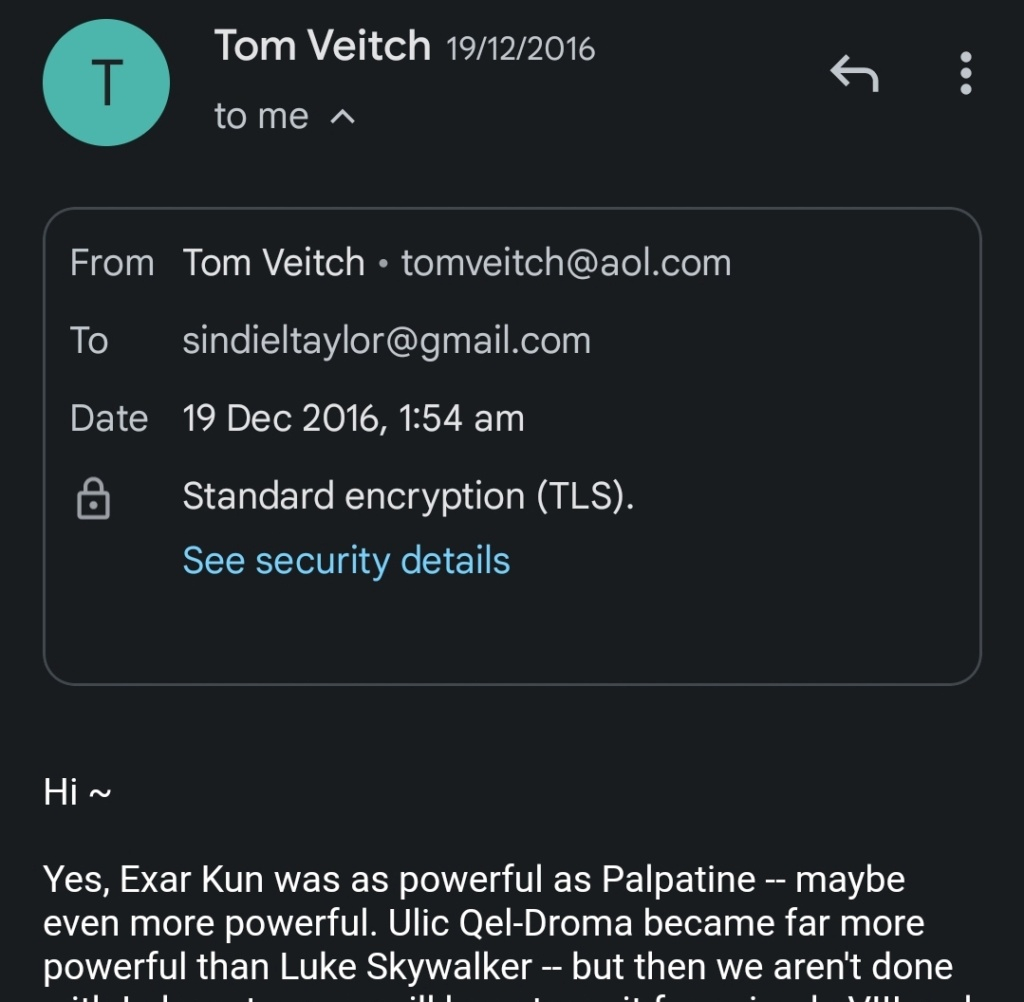
Sith'Ari
You claim that Palpatine is the Sith'Ari of prophecy. So is King Adas, Sirak, Darth Bane and Darth Plagueis depending on who you ask. Dan Wallace had every writer in Book of Sith believing themselves to be the Sith'Ari as a running joke. The actual Sith'Ari is Darth Bane however, as stated by The Complete Star Wars Encyclopedia:
Again, there's no reason to believe this actually bears any relevance where Exar Kun is concerned.
Fighting Palpatine
It'd be a shame if even Exar Kun's powerless spirit with no hosts, his weakest state in the Jedi Academy trilogy since returning from Chaos, could do the same thing:
Even as he expends his limited incorporeal energy reserves to choke the twelve of them, he grows more powerful due to their expended effort to resist him. Again, I really don't see how any of this has any bearing against Exar Kun.
Vitiate Scaling
I'm not about to be drawn into a Vitiate debate, suffice it to say there's a million things to be said about that and nothing your side has said has ever managed to actually definitively prove this claim. This is about Exar Kun, not Tenebrae, who long ago literally transformed into another being the moment he underwent that ritual. Another thing Exar Kun and Tenebrae have in common I might add.
What Exar Kun actually does, is mass drain the massassi as fuel dor the ritual, a ritual that opens the hidden doorways of power, power which he then wields, he is unlocking metaphysical power reserves:
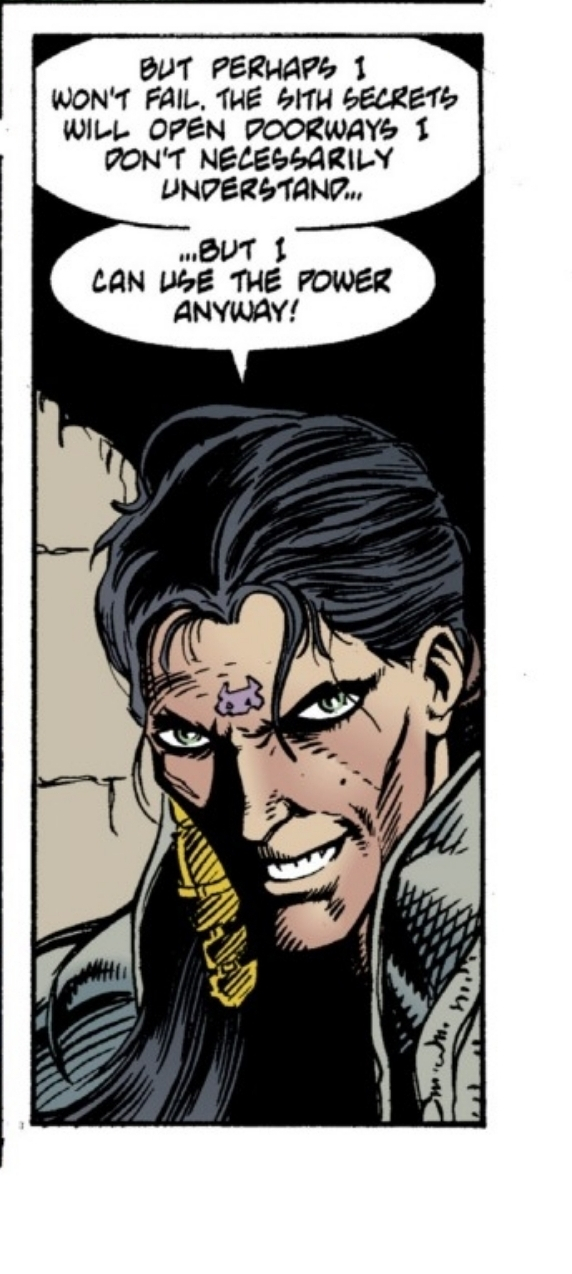

Opening those doorways again is what he plans to do during the events of the Jedi Academy trilogy:
Given the distinct lack of Massassi, the last one to exist having already left on a ship thanks to the aid of Luke Skywalker, it's obvious that the Massassi only ever served as as a source of fuel. They were never the primary source of power Kun was after nor even a component of the actual ritual itself. So, this whole game of numbers is irrelevant as a form of comparison as the rituals do completely different things.
Just to expedite this part of the debate, the only actual source that you can use as a 'gotcha' in regards to comparing the rituals would be this:

Now let's assume for your sake that 'largest' is a comparison of power. You should probably consider this:
If Nathema is > Yavin IV ritual due to being 'larger', it's likewise 'larger' than Upekzar which is stronger with the dark side of the Force than anything Luke Skywalker had ever faced. Which includes Dark Emperor Palpatine. Thus Vitiate swats Palpatine.
Ritual Kun vs. The Jedi Order
This panel you have provided as proof is from prior to the ritual:
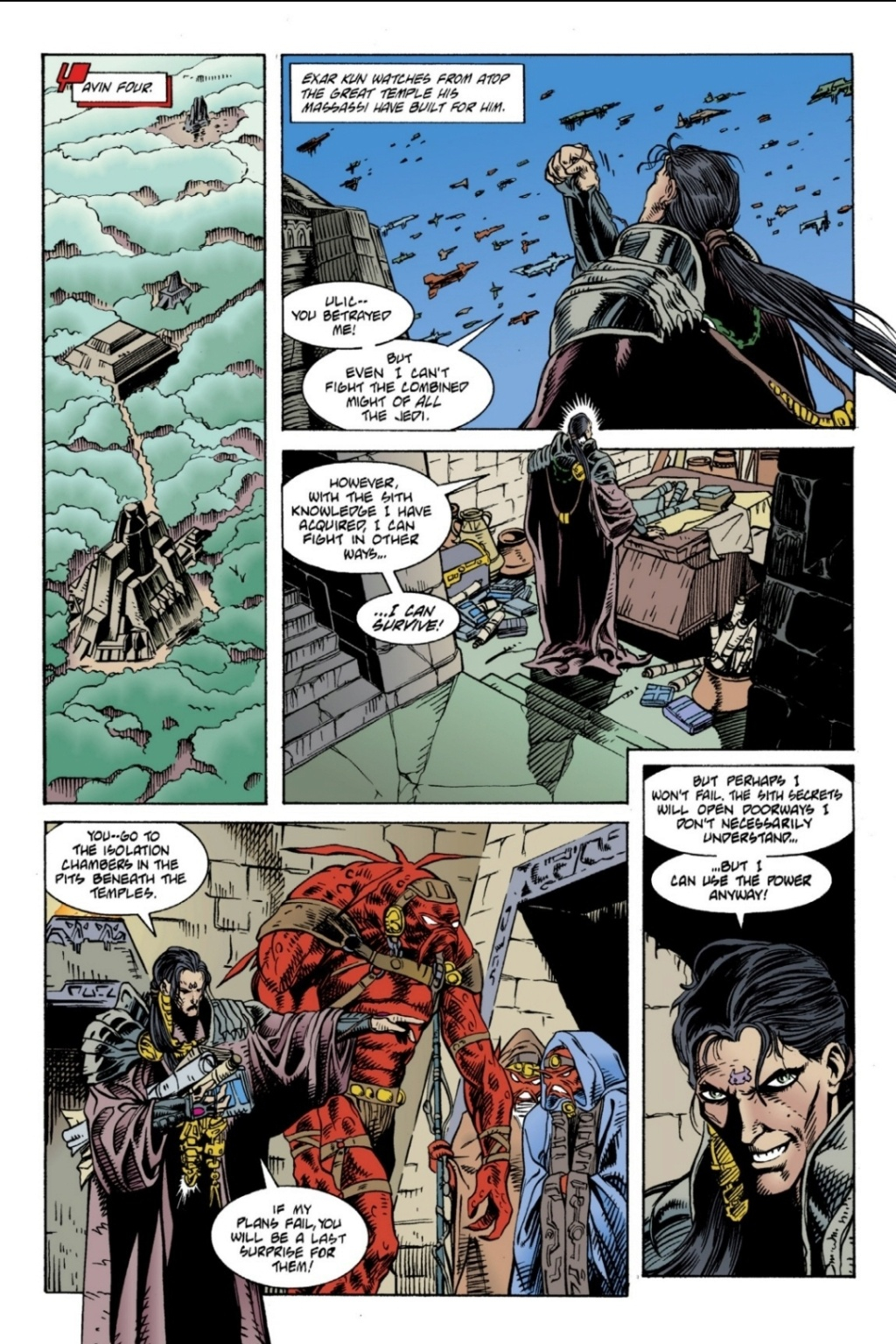

Post-ritual Kun doesn't just believe he can fight the Jedi Order, he does. Which is something I already provided at the end of my opening post. I'll repeat myself:
In fact, Exar Kun's performance against the combined Jedi Order was nothing short of excellent, as an 'all-powerful' being:



I'm going to assume for a second that you're not an idiot, and that you're only taking in to account what is depicted by TOR and not all the proof I've already posted that shows Exar Kun fighting the entire unified Jedi Order simultaneously.
We literally only see things from Exar Kun's perspective, it is impossible to quantify what Exar Kun is facing in those pictures as we don't get the entire depiction. Only close-ups of Kun himself. We have no idea how much damage he is doing in those frames of the battle. Oh, wait, yes we do. TOR media that post-dates that timeline, tells us what happened:
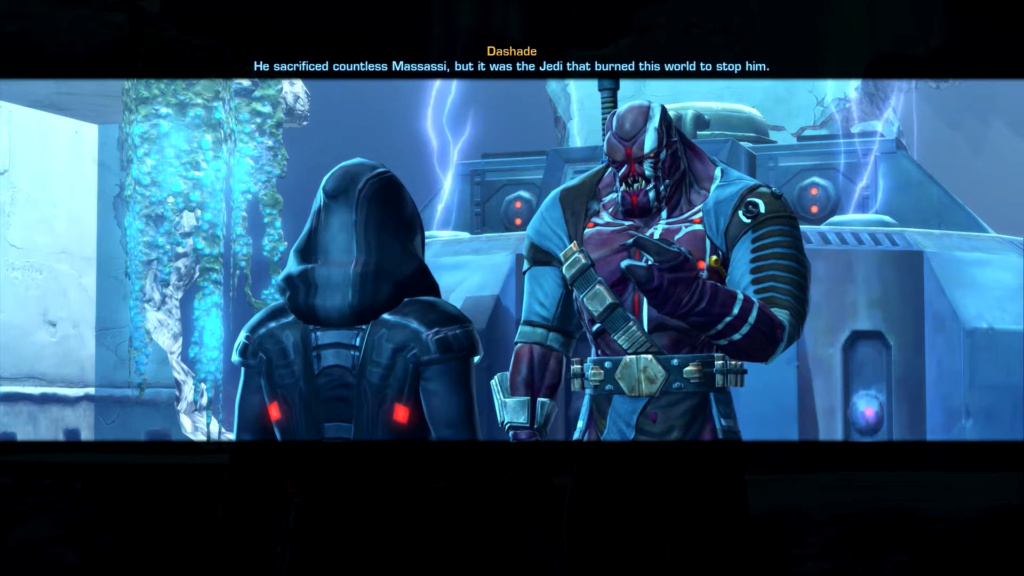
Exar Kun is 'pushed back' into the temple by the oncoming might of the entire combined Jedi Order reacting and walling him in. There's endless speculation that can go on but it certainly isn't 'nameless, featless Jedi and some Republic troopers pushed back Ritual Kun even though they apparently had to burn down the moon to imprison him.'
And frankly your argument is just pretty stupid over-all here from its inception. The last assumption you make here is that he loses to some handful of nooks when we have decades of both SWTOR and the greater Expanded Universe telling us that is the farthest thing from the truth.
Nightsisters
Palpatine has Dooku kill her because he senses that the level she has already achieved is close enough that he suspects Dooku will soon try to usurp him using her help. Which is what the quotes actually say if you properly read them, and is what I'm saying. Dooku and Ventress together could usurp Palpatine in the immediate future. Nothing more and nothing less. But it also serves to prove the legitimacy of Talzin's power relative to his.
Talzin's power comes from Dathomir, that's almost half my point. Dathomir itself grows in power:
You can see Talzin or other Nightsisters using rituals on basically every single occasion. As you have said, there is a divergence between what we see from TCW Nightsisters and prior EU Nightsisters. Talzin and her followers use ichor and Dathomir itself. Gethzerion and the founding Nightsisters use both the dark side and their own Nightsister spells. Now spells and ichor aren't the same thing due to the aforementioned divergence but we do see Talzin using spells as you pointed out. And on all of those occasions she is chanting.
I am willing to discuss why the bifurcation changes things but as far as I can see, after all the research I put into it, my stance holds. I'd need to see a specific instance of Talzin using silent spells, not ichor, to wave the statement. Though admittedly, I can see why this could get muddied.
EU Nightsisters: spells and the dark side
TCW Nightsisters: spells and dark ichor
Sidious, who you've pointed out is the supreme coward, went to Dathomir and killed Talzin personally. Palpatine in a far, far more powerful state is completely terrified of Gethzerion despite having personally killed Talzin amplified by Dathomir. Unless Gethzerion is significantly more powerful than Talzin, he has no reason to be gifting an Executor-class super star destroyer to a commander who did nothing more than bomb the planetside ports and the station in orbit.
Palpatine is a coward
Sources also state that Yoda and Sidious are equals. Which is more than enough reason to want to get the hell out of there. He even puts his lot in with Yoda at the literal start of the fight scene:
Perhaps more importantly, per George Lucas, Sidious had just legitimately lost a fight against Master Windu:
Now imagine if you'd just lost a fight against the Jedi's no.2, you're not going to be very excited about fighting their no.1.
Showing a clip of Yoda disarming Ventress when she's vastly, vastly pre-prime isn't exactly convincing, Durin. More importantly, Sidious tried to have her killed because he feared what she and Tyranus could do if they carried on. Which is the only claim I've been making.
Well, isn't that convenient, he can never have a legitimate reason to be afraid of someone. He's just a piss-ant who's scared. But he's also this ten-dimensional chess wizard smarter than anyone else ever. But he's also irrationally stupid when it comes to the part that matters most. But he's got infinite plans and is a Satan figure tier master manipulator with all the answers. Let's just pick and choose when he is one or the other and not actually logically deconstruct each event.
Vader Binding
I'm not seeing a single quote here that isn't within the context of the Empire and his immense authority within it. Might sound like a cop-out to you but it's the most immediate explanation for the quotes when considering this:
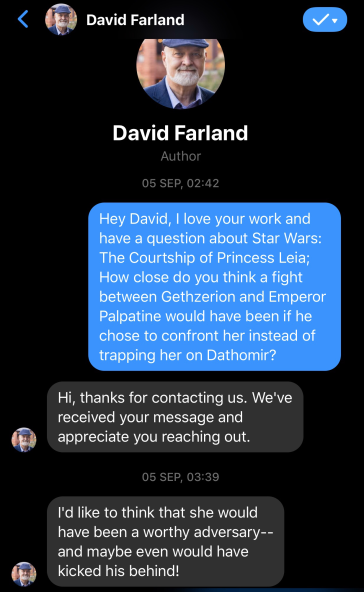
The author himself has confirmed that Palpatine's fears are legitimate and immediate and that she could actually win a confrontation. Given your earlier tangent about the writers, I'd expect you to take this into consideration where you clearly didn't earlier. And given we have Leland Chee saying authors are the closest thing to an actual authority on the matter of their owns works, I'm inclined to go with the author and not your use of quotes that may or may not even hold weight here. Depending on your interpretation.
Side note: I find it hilariously incredulous to believe that the dozen or so quotes all saying the same thing about the dynamic between Palpatine and Gethzerion, are actually hot air because Palpatine is actually just irrationally afraid. Especially given author confirmation of the original source material.
Tell me, at what point does what Kirana Ti says, provide literally any context to the fear Palpatine has of Gethzerion? Ti is entirely oblivious to this, and isn't taking either Palpatine or Gethzerion into account regarding this. Nor is what she says even mutually exclusive to all the sources you're ignoring on the point. Both can very easily be true.
[u]Kueller > Gethzerion[/u]
This is an astute observation. Unluckily for you, it isn't really that important given the other quotes:
NOTE: This must be referring to the Emperor as of Return of the Jedi as Bantam didn't recognise the Cloned Emperor unless specifically stated.
To clarify, the only version of Exar Kun's spirit she meets is one that doesn't have Kyp to draw on and only has Streen, and is simultaneously maintaining his domination of Luke Skywalker's body and spirit, as well as Mon Mothma's. Exar Kun's spirit in this trilogy is at its peak at the end of Dark Apprentice. Therefore: Mid-novel Kueller > Gethzerion, and Exar Kun's spirit > mid-novel Kueller.
G-Canon vs. SWG
Yeah this is a wild conclusion to draw. The heroes being discussed only operate in the time between 0ABY and 1ABY. Palpatine's power is growing to such a degree that he's rapidly dwarfing himself from the prior year each time. As does Darth Vader. As does Luke Skywalker. It's entirely plausible that the three years after the events of Star Wars: Galaxies result in these heroes getting left in the dirt. Which is a perfectly reasonable explanation and doesn't result in your executive decision to conveniently retcon everything that happens.
The Only Real Conclusion
You seemed awfully certain here, unfortunately
I'm glad you utterly failed to respond to literally the most important part of my entire argument. But I guess I can reiterate it so that it'll stick:
Dark Emperor Palpatine using his full potency cannot stand against Luke Skywalker and Leia Organa Solo's powers as they unlock the energy of luminous beings:





Indeed, he's blanketly stated to have used the power to become a luminous being and a spirit against the spirit of Exar Kun, just as he intended to do against Kueller:

Despite this, the power that they had whilst joined together was nothing compared to the power unleashed when Dorsk 81 channelled even more to throw a fleet of seventeen star destroyers out of a solar system:

And you can tell given that they aren't husked by the amount of channelled Force energy they use, like Dorsk 81 is.
Indeed, the feat is quite clearly even more overshadowed by the wall of light that was summoned to destroy Exar Kun, four millennia earlier:

In fact, Exar Kun's performance against the combined Jedi Order was nothing short of excellent, as an 'all-powerful' being:



You can do some nitpicking here and there about how much power is used and where, but really, the gap in power between the wall of light formed by the entire combined Jedi Order and the Dorsk 81 feat, which is just Kyp and four dozen of the weaker students, 80% of which are literally nameless, which is explicitly stronger than the union in Jedi Academy with Luke Skywalker using luminous beings power. Is insurmountable.
No amount of supremacy quotes and vague George Lucas appeals can save the Emperor from the direct and objective chain of power arrayed against him.
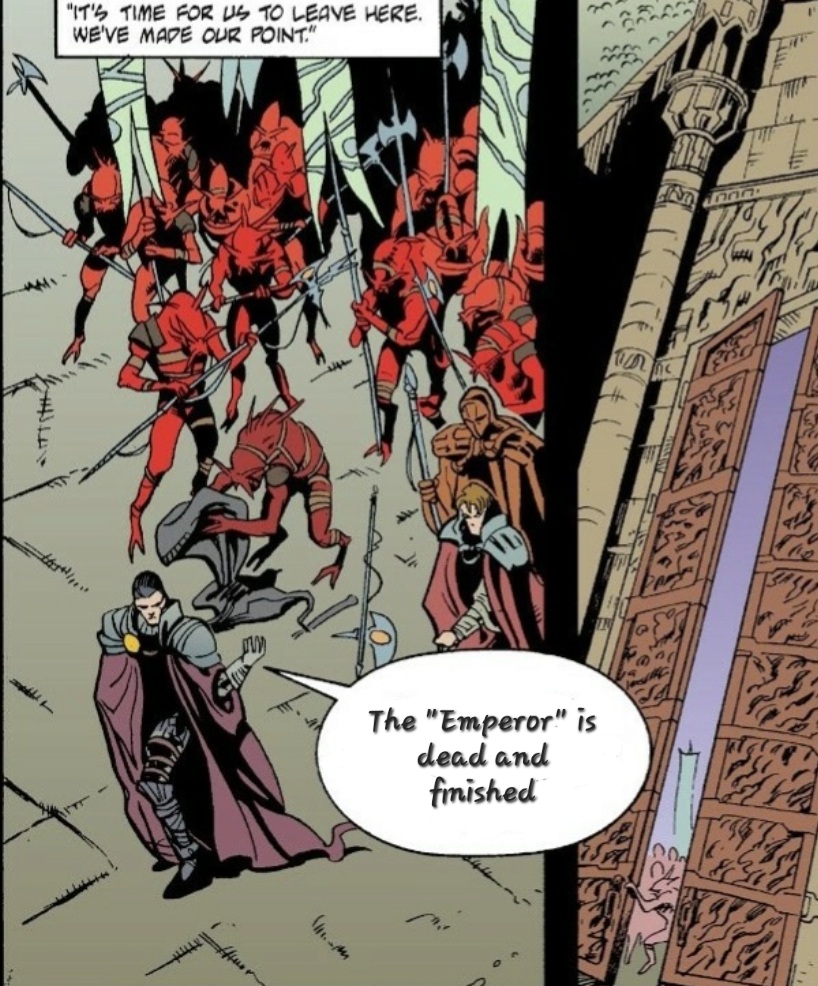
Your assertion is frankly just entirely irrelevant. Whilst you can point to some quotes that have dating after the establishment of Exar Kun's full physical prime. It necessitates that said writers actually acknowledge this too when writing. Even after said incarnation was established, the narrative has almost always been that the ritual turned Exar Kun into a spirit and the Jedi trapped him there. There's little reason to believe that these writers actually went into these supremacy quotes with the idea of what Exar Kun is. Nominally because there was a broad ban on writing about SWTOR content outside of Darth Malgus until the actual release of the game, and even then SWTOR as a whole wasn't truly woven into the greater tapestry of the Expanded Universe until approximately 2013 at the earliest. SWG is even worse, because most writers treated SWG as its internal MMO world that bore no relevance on the 'actual narrative'. There is next to nothing written about SWG in Expanded Universe material at all, even years after it closed.
For the Palpatine supremacy quotes to really hold any weight against this incarnation of Exar Kun, it would necessitate that the source itself even acknowledges it in the first place. Because, as I just said, the narrative regarding the battle of Yavin IV was as I described for decades and is largely what's believed by writers who weren't involved in the 2010/2011/2012 changes.
Kevin J. Anderson
What we have here are around a dozen quotes, all from after Ritual Kun’s introduction in TotJ, with several after his clearer establishment as a physical being by SWTOR and SWG related content, a couple from extremely high profile, G-Canon-peripheral content, and one from a book co-written by Kevin J. Anderson, certainly one of Kun’s greatest contributors and advocates.
You pointed out that Kevin J. Anderson co-wrote a book with a Palpatine supremacy statement in it. You're wrong, however, the source was principally authored by Dan Wallace. Kevin J. Anderson merely helped write the profiles.
But given you seem to have found an appreciation for author quotes, there's one from a man who wrote the characters of Dark Emperor Palpatine and Exar Kun that goes something like this:

Sith'Ari
Durin wrote:Just as Anakin, the Chosen One, was a tool to bring balance to the Force, so, too, was Palpatine, the Sith’ari.
You claim that Palpatine is the Sith'Ari of prophecy. So is King Adas, Sirak, Darth Bane and Darth Plagueis depending on who you ask. Dan Wallace had every writer in Book of Sith believing themselves to be the Sith'Ari as a running joke. The actual Sith'Ari is Darth Bane however, as stated by The Complete Star Wars Encyclopedia:
Sith'Ari, The Complete Star Wars Encyclopedia wrote:This was the name used by the ancient Sith to describe a perfect being who would rise to power and bring balance to the Force. According to prophecy, the Sith'ari would rise up and destroy the Sith, but in the process would return to lead the Sith and make them stronger than ever before. The first being known to have carried the title was the ancient King Adas, who unified the Sith tribes on Korriban some 3,000 years before the formation of the Republic. After Adas's death at the hands of Rakatan invaders, many pretenders claimed to hold the title of Sith'ari, but none of them was able to restore the Sith to power until the discovery of a man named Dessel. Dessel was trained on Korriban during the years leading up to the Battle of Ruusan; he eventually became Darth Bane, the man who reinvented the Sith and established the Rule of Two.
Again, there's no reason to believe this actually bears any relevance where Exar Kun is concerned.
Fighting Palpatine
The act of fighting Palpatine is to lose. Yoda never stood a chance of beating Palpatine, not because he was so much less powerful. Palpatine is fueled by combat itself. Fighting him that way doesn't work. That's why Exar Kun can't win.
It'd be a shame if even Exar Kun's powerless spirit with no hosts, his weakest state in the Jedi Academy trilogy since returning from Chaos, could do the same thing:
Jedi Academy Vol.III: Champions of the Force wrote:Streen felt his throat constrict, his windpipe close. He choked, unable to breathe. The black silhouette turned, staring at those who resisted him. The Jedi trainees grasped their throats, straining to breathe, their faces darkening with the effort. Kun's shadow expanded, growing darker and more powerful.
Even as he expends his limited incorporeal energy reserves to choke the twelve of them, he grows more powerful due to their expended effort to resist him. Again, I really don't see how any of this has any bearing against Exar Kun.
Vitiate Scaling
As previously established, Palpatine has every reason to be above every previous Sith Lord, including the Emperor Vitiate. If, for whatever reason, you take issue with Palpatine’s categorical supremacy being not-quite-categorical in regards to Ritual Kun, it certainly would apply to the Sith Emperor Vitiate, a well-known figure who is, unfortunately for him, caught wide net of Palpatine’s supremacy statements.
I'm not about to be drawn into a Vitiate debate, suffice it to say there's a million things to be said about that and nothing your side has said has ever managed to actually definitively prove this claim. This is about Exar Kun, not Tenebrae, who long ago literally transformed into another being the moment he underwent that ritual. Another thing Exar Kun and Tenebrae have in common I might add.
Exar Kun drains thousands of Massassi. Vitiate drains an entire planet, along with thousands of Sith Lords. The scale of Vitiate’s ritual is far greater, so it would stand to reason that Vitiate’s own amplification would be greater than Exar’s. Exar has no reason to be above the other Sith that Palpatine represents the ultimate version of.
What Exar Kun actually does, is mass drain the massassi as fuel dor the ritual, a ritual that opens the hidden doorways of power, power which he then wields, he is unlocking metaphysical power reserves:


Opening those doorways again is what he plans to do during the events of the Jedi Academy trilogy:
Exar Kun, Jedi Academy Vol.II: Dark Apprentice wrote:"I want your anger, Gantoris. I want you to open the doorways of power. I am barred from the physical plane--but with enough other Sith followers, I could be at peace. I could even live again."
Given the distinct lack of Massassi, the last one to exist having already left on a ship thanks to the aid of Luke Skywalker, it's obvious that the Massassi only ever served as as a source of fuel. They were never the primary source of power Kun was after nor even a component of the actual ritual itself. So, this whole game of numbers is irrelevant as a form of comparison as the rituals do completely different things.
Just to expedite this part of the debate, the only actual source that you can use as a 'gotcha' in regards to comparing the rituals would be this:

Now let's assume for your sake that 'largest' is a comparison of power. You should probably consider this:
Fate of the Jedi: Ascension wrote:They all felt it, down to the last Jedi Knight. Luke could sense the dark side here more strongly than anywhere else he could recall. And even he found his stomach clenching and his skin erupting in goose-flesh; he, who had looked into the face of the dark side and defeated it more times than he could recall.
The evil was not merely ancient. It was-
"Distilled," Jaina said, stepping beside him as they looked at the ruins of the city before them. Directly above the city and the dormant volcano a mere three kilometers away roiled an ugly black cloud. No simple storm, this; it did not drift from its site, and its gray-black depths occasionally flashed with blue Force lightning. Wind blew from the city, strong and foul smelling and cold. The storm, and the dark-side energies, were here.
Just here.
"A good word," said Kyle Katarn. "It's ... coalesced here, somehow."
Fate of the Jedi: Ascension wrote:"Of course, sir." She nodded at him. Luke gave Ben a final concerned, affectionate glance, then started off with his Jedi.
Toward a city more full of concentrated dark-side energy, of hate, and anger, and fear, and violence, than anything Luke Skywalker had known before.
Fate of the Jedi: Ascension wrote:The crack widened, and more darkness was revealed - darkness that was luminous, pulsating. Abeloth had somehow managed to harness all, or close to all, the dark-side energy that permeated this world, and compress it into this one pitiable being. What had once been Tola Annax now contained unfathomable dark-side energy waiting to be released. It had been both a trick and a test. Had they attacked her, leaping into the pit and slicing her to ribbons with lightsabers, they would have been at the center of the explosion. No one would have survived - and they might yet not survive.
If Nathema is > Yavin IV ritual due to being 'larger', it's likewise 'larger' than Upekzar which is stronger with the dark side of the Force than anything Luke Skywalker had ever faced. Which includes Dark Emperor Palpatine. Thus Vitiate swats Palpatine.
Ritual Kun vs. The Jedi Order
Durin wrote:Even in his ritual form, Kun knows that he cannot fight the entire Jedi Order. It’s not on the table. His objective of becoming a spirit is to survive, and to survive alone.
This panel you have provided as proof is from prior to the ritual:


Post-ritual Kun doesn't just believe he can fight the Jedi Order, he does. Which is something I already provided at the end of my opening post. I'll repeat myself:
In fact, Exar Kun's performance against the combined Jedi Order was nothing short of excellent, as an 'all-powerful' being:
I, Jedi wrote:I let Streen fill Kun with our resolve to unite and defeat him, but Kun's contempt for us came rolling back along the line like an echo. He had faced fleets of ships and all the known Jedi. He had slain his own master. His power was unrivaled. He had defeated our Master and beyond our resolve to fight, we had no operative plans and nothing with which to challenge him. We were snacks he would devour at his leisure, not morsels that might choke him.
Gnost-Dural, Timeline: The Exar Kun War wrote:The Republic drove Kun back to Yavin 4, where the Dark Lord enacted a ritual, sacrificing his armies to keep his spirit alive. Though unable to defeat him entirely, the Jedi were able to imprison Exar Kun's spirit in the temples on Yavin 4. From what we know, it remains there to this day.



Durin wrote:In the images that you asserted to be of Ritual Kun in your unassailable blog fleshing out the concept of Ritual Kun as a usable character, Kun is being driven back into his temple by a handful of Republic troops, and he is backed into the asylum of his inner chambers by a couple unnamed, featless Jedi that, shockingly, miraculously, have been able to survive long enough against the Ritual Kun who was active in that battle to back him up that far and live.
I'm going to assume for a second that you're not an idiot, and that you're only taking in to account what is depicted by TOR and not all the proof I've already posted that shows Exar Kun fighting the entire unified Jedi Order simultaneously.
We literally only see things from Exar Kun's perspective, it is impossible to quantify what Exar Kun is facing in those pictures as we don't get the entire depiction. Only close-ups of Kun himself. We have no idea how much damage he is doing in those frames of the battle. Oh, wait, yes we do. TOR media that post-dates that timeline, tells us what happened:
Galactic History 61: The Brotherhood is Broken wrote:But Exar Kun had sensed the approach of the Republic forces and laid preparations. Summoning his loyal Massassi warriors, he performed a dreadful ritual that drained them of their life essence. Exar Kun became a spirit of pure darkness.The Jedi in the fleet sensed Exar Kun’s actions. Led by Nomi, they created a “wall of light” through the Force. Exar Kun found himself trapped within the temples of Yavin Four for eternity, screaming with rage and helpless to escape.

Exar Kun is 'pushed back' into the temple by the oncoming might of the entire combined Jedi Order reacting and walling him in. There's endless speculation that can go on but it certainly isn't 'nameless, featless Jedi and some Republic troopers pushed back Ritual Kun even though they apparently had to burn down the moon to imprison him.'
And frankly your argument is just pretty stupid over-all here from its inception. The last assumption you make here is that he loses to some handful of nooks when we have decades of both SWTOR and the greater Expanded Universe telling us that is the farthest thing from the truth.
Nightsisters
Palpatine, in all those quotes, is frightened of her potential, not the level Asajj actually reaches. Asajj, throughout the Clone Wars, is able to semi-match the growth rates of Anakin and Obi-Wan, which would be a pretty terrifying trajectory if you know that your apprentice, Dooku, is likely trying to train her up to help him betray you. The quotes don't betray parity with Sidious in any way.
Palpatine has Dooku kill her because he senses that the level she has already achieved is close enough that he suspects Dooku will soon try to usurp him using her help. Which is what the quotes actually say if you properly read them, and is what I'm saying. Dooku and Ventress together could usurp Palpatine in the immediate future. Nothing more and nothing less. But it also serves to prove the legitimacy of Talzin's power relative to his.
You seem to be trying to have your cake and eat it too here. Talzin is only capable of challenging Sidious when she’s on Dathomir. Otherwise, her powers are severely weakened. With Gethzerion, we are, as you pointed out, given no indication that her powers are dulled offworld. So while both are offworld, Gethzerion is certainly more powerful than Talzin, but nothing puts Gethzerion above the circumstantially powerful Talzin that is able to challenge Sidious. Dathomir simply impacts their powers differently (everything about the nightsisters is very different from TCW and surrounding material, as previously established.
Talzin's power comes from Dathomir, that's almost half my point. Dathomir itself grows in power:
Cracken Threat Dossier wrote:The growing "Dark Energy" emerging from Dathomir did not go unnoticed.
We see Talzin do magick without incantations though, on several occasions, including the panels you posted of her and Palpatine doing battle.
You can see Talzin or other Nightsisters using rituals on basically every single occasion. As you have said, there is a divergence between what we see from TCW Nightsisters and prior EU Nightsisters. Talzin and her followers use ichor and Dathomir itself. Gethzerion and the founding Nightsisters use both the dark side and their own Nightsister spells. Now spells and ichor aren't the same thing due to the aforementioned divergence but we do see Talzin using spells as you pointed out. And on all of those occasions she is chanting.
I am willing to discuss why the bifurcation changes things but as far as I can see, after all the research I put into it, my stance holds. I'd need to see a specific instance of Talzin using silent spells, not ichor, to wave the statement. Though admittedly, I can see why this could get muddied.
EU Nightsisters: spells and the dark side
TCW Nightsisters: spells and dark ichor
Convenient for me, then, that you’ve proven that Gethzerion’s power isn’t tied to Dathomir in the same way that Talzin’s is, giving Palpatine a reason to fear Gethzerion leaving but not Talzin even if Talzin may be the stronger of the two on Dathomir.
Sidious, who you've pointed out is the supreme coward, went to Dathomir and killed Talzin personally. Palpatine in a far, far more powerful state is completely terrified of Gethzerion despite having personally killed Talzin amplified by Dathomir. Unless Gethzerion is significantly more powerful than Talzin, he has no reason to be gifting an Executor-class super star destroyer to a commander who did nothing more than bomb the planetside ports and the station in orbit.
Palpatine is a coward
Durin wrote:He wins that battle, and was the more powerful of the two. “Why leave”, indeed.
Sources also state that Yoda and Sidious are equals. Which is more than enough reason to want to get the hell out of there. He even puts his lot in with Yoda at the literal start of the fight scene:
Perhaps more importantly, per George Lucas, Sidious had just legitimately lost a fight against Master Windu:
Now imagine if you'd just lost a fight against the Jedi's no.2, you're not going to be very excited about fighting their no.1.
Beyond that, Palpatine was also scared enough of Ventress that he ordered her killed, a fact that you’ve shown quite clearly. Ventress, however, is still quite a ways away from being in Palpatine’s league as a combatant.
Showing a clip of Yoda disarming Ventress when she's vastly, vastly pre-prime isn't exactly convincing, Durin. More importantly, Sidious tried to have her killed because he feared what she and Tyranus could do if they carried on. Which is the only claim I've been making.
Palpatine being afraid of someone far less powerful than he is not only has established precedent, but is fully in keeping with the foundation of his character.
Well, isn't that convenient, he can never have a legitimate reason to be afraid of someone. He's just a piss-ant who's scared. But he's also this ten-dimensional chess wizard smarter than anyone else ever. But he's also irrationally stupid when it comes to the part that matters most. But he's got infinite plans and is a Satan figure tier master manipulator with all the answers. Let's just pick and choose when he is one or the other and not actually logically deconstruct each event.
Vader Binding
Atop this, not only Palpatine, but Vader as well, is stated quite explicitly many times over to be Gethzerion’s superior.
This includes a SWG peripheral source that brings up Gethzerion herself in the same article.
I'm not seeing a single quote here that isn't within the context of the Empire and his immense authority within it. Might sound like a cop-out to you but it's the most immediate explanation for the quotes when considering this:

The author himself has confirmed that Palpatine's fears are legitimate and immediate and that she could actually win a confrontation. Given your earlier tangent about the writers, I'd expect you to take this into consideration where you clearly didn't earlier. And given we have Leland Chee saying authors are the closest thing to an actual authority on the matter of their owns works, I'm inclined to go with the author and not your use of quotes that may or may not even hold weight here. Depending on your interpretation.
Side note: I find it hilariously incredulous to believe that the dozen or so quotes all saying the same thing about the dynamic between Palpatine and Gethzerion, are actually hot air because Palpatine is actually just irrationally afraid. Especially given author confirmation of the original source material.
Finally, Jedi Academy further contextualizes the nature of the threat Gethzerion and the Nightsisters pose to the Empire and the galaxy at large, noting that the threat is the darkness that would come over time through Nightsisters’ influence, rather than their direct defeat of Palpatine, that would threaten the galaxy’s stability.
Tell me, at what point does what Kirana Ti says, provide literally any context to the fear Palpatine has of Gethzerion? Ti is entirely oblivious to this, and isn't taking either Palpatine or Gethzerion into account regarding this. Nor is what she says even mutually exclusive to all the sources you're ignoring on the point. Both can very easily be true.
[u]Kueller > Gethzerion[/u]
Leia met Exar Kun after Gethzerion though, so there’s easily room for Gethzerion to be outside the span of “in years”, especially if “in years” is only going back to the last person she met with that kind of power, which would be Kun.
This is an astute observation. Unluckily for you, it isn't really that important given the other quotes:
The New Rebellion wrote:The presence had neared. It was strong in the dark side. He could feel the ripples, feel a power he hadn’t felt in a living being since he encountered the Emperor.
NOTE: This must be referring to the Emperor as of Return of the Jedi as Bantam didn't recognise the Cloned Emperor unless specifically stated.
To clarify, the only version of Exar Kun's spirit she meets is one that doesn't have Kyp to draw on and only has Streen, and is simultaneously maintaining his domination of Luke Skywalker's body and spirit, as well as Mon Mothma's. Exar Kun's spirit in this trilogy is at its peak at the end of Dark Apprentice. Therefore: Mid-novel Kueller > Gethzerion, and Exar Kun's spirit > mid-novel Kueller.
G-Canon vs. SWG
Durin wrote:So if we have four or more videogame PC characters running around during the course of the original trilogy that are not only heroic in nature, but individually have grown to become opponents on Palpatine’s level, then that flies in the face of the Original Trilogy’s narrative.
At the end of the day, the scaling you’ve argued for hits a hard G-Canon wall at its conclusion, preventing it from hitting, or even coming near, its intended target.
Yeah this is a wild conclusion to draw. The heroes being discussed only operate in the time between 0ABY and 1ABY. Palpatine's power is growing to such a degree that he's rapidly dwarfing himself from the prior year each time. As does Darth Vader. As does Luke Skywalker. It's entirely plausible that the three years after the events of Star Wars: Galaxies result in these heroes getting left in the dirt. Which is a perfectly reasonable explanation and doesn't result in your executive decision to conveniently retcon everything that happens.
The Only Real Conclusion
Palpatine is repeatedly and categorically regarded as the GOAT Sith Lord of the Star Wars universe. Far from this being inane or arbitrary, the out-of-universe timeline for these statements allows one to see that this has roots with George’s canon and the underlying ideas of the Star Wars universe.
Exar Kun has no way of defeating Palpatine blow for blow, he would only be adding fuel to Palpatine’s cleansing fire.
Ritual Kun has neither the reason nor the showings to break out from under Palpatine.
The proposed Gethzerion scaling falls flat on several points and is necessarily untrue.
Exar Kun is made into another of Palpatine’s victims.
You seemed awfully certain here, unfortunately
I'm glad you utterly failed to respond to literally the most important part of my entire argument. But I guess I can reiterate it so that it'll stick:
Dark Emperor Palpatine using his full potency cannot stand against Luke Skywalker and Leia Organa Solo's powers as they unlock the energy of luminous beings:





Indeed, he's blanketly stated to have used the power to become a luminous being and a spirit against the spirit of Exar Kun, just as he intended to do against Kueller:

Despite this, the power that they had whilst joined together was nothing compared to the power unleashed when Dorsk 81 channelled even more to throw a fleet of seventeen star destroyers out of a solar system:

And you can tell given that they aren't husked by the amount of channelled Force energy they use, like Dorsk 81 is.
Indeed, the feat is quite clearly even more overshadowed by the wall of light that was summoned to destroy Exar Kun, four millennia earlier:
I, Jedi wrote:Twelve half-trained apprentices and two toddlers planning to annihilate someone who had survived an onslaught by the combined might of the Jedi of his age sounded ridiculous on the surface of it.

In fact, Exar Kun's performance against the combined Jedi Order was nothing short of excellent, as an 'all-powerful' being:
I, Jedi wrote:I let Streen fill Kun with our resolve to unite and defeat him, but Kun's contempt for us came rolling back along the line like an echo. He had faced fleets of ships and all the known Jedi. He had slain his own master. His power was unrivaled. He had defeated our Master and beyond our resolve to fight, we had no operative plans and nothing with which to challenge him. We were snacks he would devour at his leisure, not morsels that might choke him.
Gnost-Dural, Timeline: The Exar Kun War wrote:The Republic drove Kun back to Yavin 4, where the Dark Lord enacted a ritual, sacrificing his armies to keep his spirit alive. Though unable to defeat him entirely, the Jedi were able to imprison Exar Kun's spirit in the temples on Yavin 4. From what we know, it remains there to this day.



You can do some nitpicking here and there about how much power is used and where, but really, the gap in power between the wall of light formed by the entire combined Jedi Order and the Dorsk 81 feat, which is just Kyp and four dozen of the weaker students, 80% of which are literally nameless, which is explicitly stronger than the union in Jedi Academy with Luke Skywalker using luminous beings power. Is insurmountable.
No amount of supremacy quotes and vague George Lucas appeals can save the Emperor from the direct and objective chain of power arrayed against him.

 AncientPowerSuspect Hero | Level Four
AncientPowerSuspect Hero | Level Four
 Re: SS - EXAR KUN (AncientPower) VS. DARTH SIDIOUS (Durin)
Re: SS - EXAR KUN (AncientPower) VS. DARTH SIDIOUS (Durin)
September 24th 2023, 1:14 am
As I'm not on the Discord server and really can't justify re-joining, I'd appreciate hearing what anyone has to say about this here in the comments. This whole battle is basically going to be me trying to put all my finishing touches in before I retire.
 Darth Durin's Baneling
Darth Durin's Baneling
 Go For Papa Palpatine (1/2)
Go For Papa Palpatine (1/2)
November 23rd 2023, 3:19 pm

Supremacy Statements
Your assertion is frankly just entirely irrelevant. Whilst you can point to some quotes that have dating after the establishment of Exar Kun's full physical prime. It necessitates that said writers actually acknowledge this too when writing. Even after said incarnation was established, the narrative has almost always been that the ritual turned Exar Kun into a spirit and the Jedi trapped him there. There's little reason to believe that these writers actually went into these supremacy quotes with the idea of what Exar Kun is. Nominally because there was a broad ban on writing about SWTOR content outside of Darth Malgus until the actual release of the game, and even then SWTOR as a whole wasn't truly woven into the greater tapestry of the Expanded Universe until approximately 2013 at the earliest. SWG is even worse, because most writers treated SWG as its internal MMO world that bore no relevance on the 'actual narrative'. There is next to nothing written about SWG in Expanded Universe material at all, even years after it closed.
For the Palpatine supremacy quotes to really hold any weight against this incarnation of Exar Kun, it would necessitate that the source itself even acknowledges it in the first place. Because, as I just said, the narrative regarding the battle of Yavin IV was as I described for decades and is largely what's believed by writers who weren't involved in the 2010/2011/2012 changes.
I think that you’re missing my point here completely.
The number of supremacy statements for Palpatine is important because it shows that a majority of writers to weigh in on who the most powerful Sith may be have reason to believe it to be Palpatine. They believe this to be clear enough that they assert it, sometimes repeatedly, in the works themselves. That makes this being untrue, even by technicality, very unlikely.
It would be exceedingly strange for anyone to be excepted from this rule, and Exar Kun has absolutely nothing going against it except for maybe one obscure supremacy quote against Palpatine’s many, including several more authoritative, several more visible, and several more recent.
These supremacy quotes for a category that includes both characters not only as members, but as figureheads (as you noted Kun to be at the start of your first post), is a more direct link between them than anything else. Palpatine is winning that competition very decisively.
Your interpretation of when this version of Kun was accepted as Ritual Kun seems inconsistent, and entirely hinging on what favors you at any given point. The elaboration on Ritual Kun from 2010 and after has little to do with the material you’ve been looking at to describe the actual strength of Ritual Kun.
When you justify Kun’s power with statements like a 1998 novel describing Kun facing off against fleets of Jedi and a 2001 sourcebook calling him all-powerful, and Palpatine is still given as many GOAT statements as he is (including from people who have almost undoubtedly read books such as I, Jedi and Essential Guide to Alien Species like Luceno and Wallace), I don’t think Kun escapes this. These accolades were attributed to some version of Kun, spirit or physical, and that Kun was placed under Palpatine many times after.
If your case is that all the sources with Ritual Kun wank that came out before Palpatine supremacy quotes are just so obscure that none of the makers of the Palps supremacy quotes were aware of them or the ideas behind them… would that not undermine those quotes’ relevance in the first place?
You pointed out that Kevin J. Anderson co-wrote a book with a Palpatine supremacy statement in it. You're wrong, however, the source was principally authored by Dan Wallace. Kevin J. Anderson merely helped write the profiles.
Right, Wallace was the primary writer. I’d hazard a guess though that:
- KJA read the WIP of the book he’s credited as coauthoring
- He would have some say in the book he’s credited as coauthoring
Meaning (more likely) KJA didn’t take issue with the Palpatine GOAT quote at all, or (less likely) Wallace is so confident in Palpatine’s superiority that he simply vetoed KJA’s protests. Either way, great for Palps, less so for Kun.
But given you seem to have found an appreciation for author quotes, there's one from a man who wrote the characters of Dark Emperor Palpatine and Exar Kun that goes something like this:
Sure. That’s one against many, from a source profoundly lacking in both officiality and in proximity to his officially released works (those also tend to favor a narrative of Palpatine being the GOAT).
The email has zero official weight in and of itself, and its application for determining intent at the time of writing any of the comics is severely limited by it being said a good 20 years after the fact.
You claim that Palpatine is the Sith'Ari of prophecy. So is King Adas, Sirak, Darth Bane and Darth Plagueis depending on who you ask. Dan Wallace had every writer in Book of Sith believing themselves to be the Sith'Ari as a running joke. The actual Sith'Ari is Darth Bane however, as stated by The Complete Star Wars Encyclopedia:
The chapter being titled “Sith’ari”, coupled with Palpatine going on to bring the Sith to power in a way none before him did seems to be a pretty firm indicator of the novel Darth Plagueis’s take on the matter – highly visible, primary material with Lucas involvement, as opposed to an entry in older, secondary material.
Contention and Palpatine’s Power
It'd be a shame if even Exar Kun's powerless spirit with no hosts, his weakest state in the Jedi Academy trilogy since returning from Chaos, could do the same thing:
Even as he expends his limited incorporeal energy reserves to choke the twelve of them, he grows more powerful due to their expended effort to resist him. Again, I really don't see how any of this has any bearing against Exar Kun.
That would indeed be a shame. Thankfully, we’re saved from that unfortunate scenario by your interpretation of the passage being far off the mark.
Jedi Academy: Champions of the Force (1994, Kevin J. Anderson) wrote:
As his eyes adjusted, Streen saw that all twelve of the Jedi candidates were limned with the faintest sheen of an iridescent blue glow that grew brighter as the new Jedi converged around Exar Kun.
“Even joined together, you are too weak to fight me!” the shadowy man said.
Streen felt his throat constrict, his windpipe close. He choked, unable to breathe. The black silhouette turned, staring at those who resisted him. The Jedi trainees grasped their throats, straining to breathe, their faces darkening with the effort.
Kun’s shadow expanded, growing darker and more powerful. He towered over Streen. “Streen, take your lightsaber and finish these weaklings. Then I will allow you to live.”
Streen heard the blood sing in his ears as his body strained for oxygen. The rushing sound reminded him of blowing wind, gale-force storms. Wind. Air. He grasped the wind with his Jedi powers, moving the air itself and making it flow into his lungs, past Kun’s invisible stranglehold.
Cool, sweet oxygen filled him, and Streen exhaled and inhaled again. Reaching out with his power, he did the same for all the other Jedi students, nudging air into their lungs—helping them breathe, helping them grow stronger.
“We are more powerful than you,” Dorsk 81 said, gasping, in a tone that mixed challenge with amazement.
The passage is from the point of view of Streen (“Streen saw”, “Streen felt”). Exar Kun’s shadow grows darker and more powerful from Streen’s perspective only when he moves to tempt Streen by preying on his insecurities. Streen sees no change in Kun’s appearance when Kun is targeting the other students (Kirana Ti, Tionne, etc.), suggesting that there is no actual change.
Additionally, Kun’s shadow/presence becoming darker and more powerful, even taken completely at face value and ignoring the point of the fight… and the trilogy… can easily be Kun simply revealing more of the power that he had in store the whole time as he brings more of his abilities to bear on his enemies.
Kun can’t turn dark side energies on the scale of an individual fight in his own favor the same way Palpatine can.
Ritual Mechanics
What Exar Kun actually does, is mass drain the massassi as fuel dor the ritual, a ritual that opens the hidden doorways of power, power which he then wields, he is unlocking metaphysical power reserves:
This would be assuming that Vitiate is unaware of those same doorways, despite having spent a century researching dark side rituals in the ancient times when the knowledge that Kun is picking up the scraps of was developed and stored by the Sith Empire.
The Old Republic: Revan (Drew Karpyshyn) wrote:“At thirteen he presented himself to Marka Ragnos, the Lord of all Sith and the ruler of the Sith Council. Impressed by the teenager’s ambition and power, Marka Ragnos granted him the title of Lord Vitiate. His position as ruler of Nathema officially recognized, Lord Vitiate returned to his home to conduct his research into the depths of the dark side’s power. He stayed there for a hundred years. When Marka Ragnos fell, Lord Vitiate did not join in the mad rush to claim his position. He was not part of the Great Hyperspace War against the Republic. When Naga Sadow and Ludo Kressh fought for leadership of the Sith, he took no side."
Kun notably does not even understand exactly how his ritual would work.
Do we think that the idea is that Vitiate is just doing a massively more inefficient ritual than Kun, both in terms of resources used and time taken? Is that meant to show that Vitiate is less knowledgeable than Kun or the ancient Sith who designed the ritual? That seems unlikely. That he’s afraid of opening those doorways? The idea behind Nathema seems to be that it’s more a perversion than other ancient Sith rituals, and we know that he cares for Sith politics and tradition even less than the likes of Sadow. Why, then, would Vitiate need more fuel and more time to accomplish a weaker ritual?
Even if we were to come up with a logical explanation for how it could be logical for Kun’s ritual to be more efficient than Vitiate’s, the scale of the “wrongness” resulting from Vitiate’s ritual is clearly meant to inform the audience on the power that’s going into Vitiate. I struggle to envision any writer looking at the two rituals side-by-side and saying that somehow Kun came away from his with more power.
There’s also the inescapable fact that, as the ritual was discovered by another Sith, at a time where powerful Sith Lords would have had more than their fair share relative to Kun of Dark Side artifacts and Massassi slaves, there was at least one past Sith who either:
- Used that same ritual to achieve great power and eternal life (Ragnos, perhaps?)
- Decided it wasn’t such a screaming deal after all and decided not to
If it’s the former, then Palpatine would be firmly better than that Sith for my already outlined reasons for general supremacy, and Kun wouldn’t have too many independent reasons for breaking free. Additionally, this past Sith would clearly not be the combined Jedi Order-level combatant you’re pushing for Kun to be.
If it’s the latter, then the ritual probably does not, in fact, give nigh-limitless power.
Opening those doorways again is what he plans to do during the events of the Jedi Academy trilogy:Exar Kun, Jedi Academy Vol.II: Dark Apprentice wrote:
"I want your anger, Gantoris. I want you to open the doorways of power. I am barred from the physical plane--but with enough other Sith followers, I could be at peace. I could even live again."
Given the distinct lack of Massassi, the last one to exist having already left on a ship thanks to the aid of Luke Skywalker, it's obvious that the Massassi only ever served as as a source of fuel. They were never the primary source of power Kun was after nor even a component of the actual ritual itself. So, this whole game of numbers is irrelevant as a form of comparison as the rituals do completely different things.
Where’s the fixation on the Massassi specifically as the power source coming from? We see that Kun needs the Force energies of Luke’s students to open up the gateways. Kun’s found a new source of fuel, and it’s much more efficient per capita than the Massassi were – and still doesn’t come close to measuring up to what Vitiate was working with.
I'm not about to be drawn into a Vitiate debate, suffice it to say there's a million things to be said about that and nothing your side has said has ever managed to actually definitively prove this claim. This is about Exar Kun, not Tenebrae, who long ago literally transformed into another being the moment he underwent that ritual. Another thing Exar Kun and Tenebrae have in common I might add.
And yet Vitiate continues to be categorized a Sith Lord all the way through his Vanilla appearance in pretty much everything to talk about him.
I don’t know all of what has and has not been said in past debates, and I don’t really care unless you have some specific evidence and/or reasoning from those in mind for this point. Of course it’s your choice on whether or not to engage on this, but don’t expect anyone to treat “I’d rather not” as a counterargument.
Exar Kun’s Lackluster Displayed Prowess
The Absolute State of the Jedi Order
The Jedi Order had, at this point, just undergone several major losses, including a purge labeled a “holocaust”.
On Deneba, Krath War Droids attacked the Jedi assembly, killing many Jedi, specially targeting the most powerful Jedi present (and being strongly implied to kill some of those unnamed Masters), as well as Arca Jeth, one of the Order’s most powerful disciples.
- Spoiler:
On Ossus, Exar Kun murdered Odan-Urr, leader of the Jedi Order.
- Spoiler:
Most of the top Masters (at least eight) were assassinated by former students of theirs – twenty ambitious Jedi learners possessed by Ancient Sith spirits. At the same time, Ulic Qel-Droma attacked Coruscant with his Krath and Mandalorian forces, presumably slaying many of the defending Jedi. This was followed up by Exar Kun arriving at the doors of the Senate and personally killing his master, Vodo-Siosk Baas.
Only Thon, Ood, and an assortment of Knights and Apprentices are shown remaining.
- Spoiler:
Ood Bnar is rooted forever on Ossus.
- Spoiler:
Of the “great Jedi Masters of the era,” this leaves only Thon still alive.
Cay is dead. Crado is dead. Ulic can’t use the Force. Qrrl Toq, Shoaneb Culu, and Dace Diath are dead. All the most ambitious students of the great masters turned traitor.
The only named Jedi left to picture as contributing anything to the Wall of Light are Thon, Nomi, Oss, Tott, and Sylvar.
Besides them, and a handful of people we see later in KotOR material, everybody else is both featless and highly unlikely to be at the level of any of the shown great masters or prodigies. On top of that, even those fodder Knights and apprentices are severely diminished in number by the many slaughters they’d withstood in recent years.
The Jedi Order that puts Kun away for four millennia has exactly one named Jedi Master.
What does Kun do to “fight” the Order?
Durin wrote:
Even in his ritual form, Kun knows that he cannot fight the entire Jedi Order. It’s not on the table. His objective of becoming a spirit is to survive, and to survive alone.
This panel you have provided as proof is from prior to the ritual:
Uh-huh. But in that panel, Kun goes on to describe what his plan is with the ritual.
As he is pre-ritual, he can’t fight the combined might of all the Jedi in any way.
However, as he will be post-ritual, he can fight the Jedi Order in other ways [than beating them in a straight up fight].
He will do this by surviving [with the immortality aspect of the ritual].
Jedi Academy: Champions of the Force (1994, Kevin J. Anderson) wrote:
Kun laughed. "Perhaps it was your own failings as a teacher. Or their own delusions."
"What makes you think I'll stay like this for thousands of years?" Luke said.
"You will have no choice," Kun answered, "once I have destroyed your physical body. Trapping my own spirit inside these temples was the only way I could survive when the final holocaust came. The allied Jedi Knights devastated the surface of Yavin 4. They killed off the few Massassi people I had kept alive, and they destroyed my own body in the inferno.
"My spirit was forced to wait and wait and wait until finally you brought your Jedi students here, students who could hear my voice once they learned how to listen."
Kun’s goal here isn’t to solo the proverbial Death Star. His ritual is not a proton torpedo; it’s a false floor for him to hide under.
Star Wars (1977) wrote:

Whatever power bonus he gets from the ritual is explicitly not enough that he can fight the combined Jedi Order in a conventional manner. This is consistent with what goes on to happen, which is… not him fighting the combined Jedi Order in a conventional manner.
The bulk of the Order’s numbers are inside their ships for the entirety of the battle, including all the named characters. The Jedi on the ground get burned to death, per the Unassailable Blog.
The fleet before the battle:
The fleet after the battle:
No damaged ships, no discernable decrease in numbers. No material depicting the battle has ever shown Kun damaging the ships or the Jedi inside them in any fashion. Up until the moment of the wall of light – which landed in its totality, greatly diminishing Kun’s actual power and trapping him on Yavin IV – Kun neither dishes out nor withstands any blows against this greater fleet.
Post-ritual Kun doesn't just believe he can fight the Jedi Order, he does. Which is something I already provided at the end of my opening post. I'll repeat myself:
In fact, Exar Kun's performance against the combined Jedi Order was nothing short of excellent, as an 'all-powerful' being:
Let’s take a look at what your quotes actually say about Kun’s performance here.
I, Jedi (1998, Michael Stackpole) wrote:
I let Streen fill Kun with our resolve to unite and defeat him, but Kun's contempt for us came rolling back along the line like an echo. He had faced fleets of ships and all the known Jedi. He had slain his own master. His power was unrivaled. He had defeated our Master and beyond our resolve to fight, we had no operative plans and nothing with which to challenge him. We were snacks he would devour at his leisure, not morsels that might choke him.
Are we still taking Kun’s manipulations at face value here? I know you like the character, but c’mon. His presentation of events to the relatively ignorant in a desperate ploy to discourage fighting him openly (because he knows he’d lose!) shouldn’t be treated as accurate. Yes, technically Kun “faced” a fleet of all the known Jedi. What was the end result of that encounter? Force nuke.
Kun leaves that part vague for a reason.
Gnost-Dural, Timeline: The Exar Kun War (2011) wrote:
The Republic drove Kun back to Yavin 4, where the Dark Lord enacted a ritual, sacrificing his armies to keep his spirit alive. Though unable to defeat him entirely, the Jedi were able to imprison Exar Kun's spirit in the temples on Yavin 4. From what we know, it remains there to this day.
And why weren’t they able to defeat him entirely? Because his spirit persisted. As was the stated primary goal of the ritual. The Jedi did defeat him utterly in a conventional battle (he’s trapped forever, his plans for ruling the galaxy are shattered, he lost a ton of his power per the Unassailable Blog’s version, his body was destroyed per many versions), but they didn’t defeat him completely (in all senses) only because his spirit survived.

Kun nearly exterminated the Jedi before Yavin… so in this version of events the Jedi are close to extinction, their forces would be less than the thousands shown in the comics (and in your argument). This quote is already having trouble with other sources, but you’re ignoring both what this implies for the quote’s consistency with other material and the part of the quote that would diminish Kun’s feat.
The battle is titanic… in what sense? It seems like an awkward descriptor both for what’s shown in the comics or for your idea of Kun directly fighting all the Jedi on his own. It technically fits either (titanic doesn’t mean close), but it makes me think the writers of the quote thought Kun had a lot of forces on his side there, instead of just the already-drained-and-dead Massassi fighters.


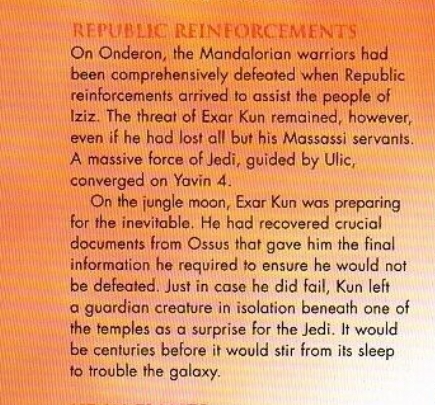
Right, and again, he does get soundly defeated in the battle. When all these quotes say Kun’s not “defeated”, they mean that he’s not killed forever. That much is made abundantly clear from the source material.

I’m not sure why the “all-powerful” description applied to a version of Kun that, per the Unassailable Blog, is only a hypothetical version of the character, as the ritual did not make him into a spirit in the first place, should apply to the actual, living Ritual Kun. If the quote is totally off the mark when it describes one part of what the ritual does, why do we give its other part weight when applying it to the fundamentally different, but correct, version of the event?
It says nothing about him fighting the Jedi, beyond them not being able to destroy his spirit (wow, that’s emphasized a lot by all this, almost as if that’s the main point of the ritual because he knows he can’t actually kill the Jedi). Any version of Kun… spirit Kun, living Ritual Kun, whatever… is clearly not all-powerful. “All-powerful” doesn’t mean anything of substance.
I'm going to assume for a second that you're not an idiot, and that you're only taking in to account what is depicted by TOR and not all the proof I've already posted that shows Exar Kun fighting the entire unified Jedi Order simultaneously.
I’m not seeing anything like that. Sounds cool though, would you mind posting it in your next one?
We literally only see things from Exar Kun's perspective, it is impossible to quantify what Exar Kun is facing in those pictures as we don't get the entire depiction. Only close-ups of Kun himself. We have no idea how much damage he is doing in those frames of the battle.
Evidently not enough to keep some unnamed Jedi Knights and Republic troopers very far at bay.
Oh, wait, yes we do. TOR media that post-dates that timeline, tells us what happened:Galactic History 61: The Brotherhood is Broken wrote:
But Exar Kun had sensed the approach of the Republic forces and laid preparations. Summoning his loyal Massassi warriors, he performed a dreadful ritual that drained them of their life essence. Exar Kun became a spirit of pure darkness.The Jedi in the fleet sensed Exar Kun’s actions. Led by Nomi, they created a “wall of light” through the Force. Exar Kun found himself trapped within the temples of Yavin Four for eternity, screaming with rage and helpless to escape.
Another one talking about him being a spirit before the Jedi arrive, at odds with the Unassailable Blog. And it emphasizes the life Force of the Massassi going into him as the source of his power, too? How curious.
Could you please explain to me which part of either of these elaborates on the damage Kun did to the combined Order? All I’m seeing is more stuff on how the Jedi nuked Kun and his planet.
Exar Kun is 'pushed back' into the temple by the oncoming might of the entire combined Jedi Order reacting and walling him in. There's endless speculation that can go on but it certainly isn't 'nameless, featless Jedi and some Republic troopers pushed back Ritual Kun even though they apparently had to burn down the moon to imprison him.'
“The Order had to burn down the moon to beat him” would necessitate that the Jedi made a conscious decision to sacrifice the moon and their forces down there to destroy Kun. That was not the case. The moon being set aflame is their plan going awry, and was obviously unintended.
And frankly your argument is just pretty stupid over-all here from its inception. The last assumption you make here is that he loses to some handful of nooks when we have decades of both SWTOR and the greater Expanded Universe telling us that is the farthest thing from the truth.
Probably the single most repeated thing, from the source material to the stuff from far later, is that Kun can’t fight the combined Order in the way that you mean. The only people we see him fighting conventionally are low numbers of random mooks, and the source material (and the Unassailable Blog) tell us that most of the Jedi stayed up in the ships for the Wall of Light nuke.
None of the quotes you’ve pointed to thus far are saying what you’re saying they are, and many outright contradict your version of events.
I’d also like to note that, going off of SWTOR’s version of events, Kun wasn’t the only target of the Wall of Light. The aim was to wipe out the residual Dark Side energies in the temples from Sadow, Nadd, and their Massassi as well as Kun.
The Old Republic Codex: The Dark Legacy of Yavin Part IV (2014) wrote:
From the journal of Jedi Master Arlo Grennen during his investigation into the dark side’s influence on Yavin 4:
“A few hundred years ago, the Jedi Order thought they could cleanse Yavin 4 of its dark influence. They were more aggressive then. I’m actually impressed. The Jedi bombarded the world from orbit with a destructive manifestation of light side power in the hopes it would free the moon from its dark embrace.
“The attacking Jedi destroyed much of the life on Yavin 4, which they later worked to restore to its previous state. They thought they’d won, that they’d removed the influence of the dark side. How wrong they were. The Massassi are still here. The dark side is still present. I would not be surprised if Exar Kun’s spirit remains, waiting for someone–a Jedi like myself, perhaps–to find him…”
I guess Nadd and Sadow’s post-dissipation auras must be Order-soloers as well.

Mind you, this would also make the place all the ground fighting takes place an ultra-powerful Dark Side nexus. Kun would not do so well (if one calls it well) in a neutral environment.
Lightsaber Combat
Exar Kun is not so powerful that he’s beyond the need for using a lightsaber, as evidenced by him being shown wielding one in his post-ritual form almost every time he’s pictured.
Not only does this tell us that he can’t simply handwave the Jedi and Republic soldiers we see getting into close quarters against him (and pushing him back into the temple and helping to kill him off!), but it also lets us know that dueling is not a non-factor against Kun. Maybe he’s so ignorant of the ritual’s effects that he can’t practically bring his full “all-powerful” Force abilities to bear against the Jedi. Or, maybe, hear me out on this, “all-powerful” was flowery language here, as it is almost every other time we see that word used to describe a mortal Force user.
While the ritual would have amplified his abilities by quite a bit, it would not have impacted his technical skill with the lightsaber, and, mentally speaking, the rushed, last-ditch-effort ritual of unknown effect is unlikely to have done anything positive for his balance as a combatant.
Kun instills his victory over Vodo-Siosk Baas, one of the most skilled Jedi duelists, as one of his all-time greatest feats in the Jedi Academy students’ minds, right up there with his “faceoff” against the Jedi armada. Vodo’s the best fighter Kun’s ever bested.
Compare this with someone like Agen Kolar, who has, if anything, greater all-time hype as a duelist than Baas. He was out of the fight against Palpatine before it even began.
An “one of the most skilled Jedi duelists of the era” is Exar Kun’s toughest opponent.
A “one of the most skilled Jedi duelists of all time” is Palpatine’s appetizer.
When Palpatine, undoubtedly more powerful than any of the randoms who got close enough to Kun that his lightsaber was of use, gets up close to duel Kun, it won’t go well for him, ritual or no ritual.
Exar Kun and his Failures through the Ages
If it is Ritual Exar Kun who is put into spirit-mode by the Jedi Order, then it is Ritual Kun’s spirit form that we see ever since. This is particularly relevant when your case is based on quotes attributing an “all-powerful” nature to living Kun and Spirit Kun. If Ritual Kun is a supreme being matched or surpassed only by the very top tier, we would expect to see that unquestioning supremacy when Kun’s spirit is compared to other Sith spirits. Unfortunately for him, that’s not quite the case.
Temple of Sacrifice
The Temple of Sacrifice is one of the Temples on Yavin IV that Revan plans to use to drain the lives of Revanite, Republic, and Sith forces as fuel to resurrect Vitiate. At the time of the SoR expansion, the idea was that it was found, but not created, by Vitiate.
The temples were built by Naga Sadow, however it’s noted that these were later amplified by Kun with arcane technology… a clear reference to the Temple of Sacrifice pictured at the conclusion of that series of Codex entries.
The Old Republic: Shadow of Revan (2014) wrote:
[Darth Marr:] “The Order of Revan is garrisoned inside an old Massassi temple. That is where the Dark Side is most prevalent.”
The Old Republic: Shadow of Revan (2014) wrote:
[Lana Beniko:] “According to Ivan, there’s a device inside the temple they had hoped to use to bring the Emperor back. It’s a weapon designed to eradicate all living things on the moon, save for those safely inside the temple.”
[C2-D4:] “Ooh, I should like to see that. Just imagine!”
[Theron Shan:] “D4, button it.”
[Lana:] “The device appears to be Sith in origin. That’s how the Emperor knew about it: why he chose to retreat to Yavin IV.”
[Sith Warrior:] “Ivan’s team was going to activate the device. Use the loss of life to restore the Emperor.”
[Lana:] “Yes. And now, Revan plans to use it for the same purpose. If we can’t stop him, we’re all dead.”
The Old Republic Codex: The Dark Legacy of Yavin Part III (2014) wrote:
From the journal of Jedi Master Arlo Grennen during his investigation into the dark side’s influence on Yavin 4:
“Just as Naga Sadow trained his eventual replacement, so did Freedon Nadd’s spirit find a powerful apprentice in Exar Kun. And just as Nadd killed his lord Sadow, Kun destroyed Nadd’s spirit here on Yavin 4. These notable deaths likely served to further imbue the moon’s temples with dark power, further fueling the barbaric Massassi–as well as the succession of Dark Lords who would later reside here.
“I think Kun saw what Naga Sadow had accomplished here with Sith alchemy and architecture and decided he could do better. He forced the Massassi to build new temples, but this time with a focus on complementing and augmenting the dark side. Kun even went so far as to use various technologies to manipulate the Force in ways that I can’t say I understand. I can’t, but I would like to….”
The Old Republic Codex: The Dark Legacy of Yavin Part V (2014) wrote:
Jedi Master Arlo Grennen’s final journal entry during his investigation into the dark side’s influence on Yavin 4:
“I thought I would find Exar Kun. I believed like a fool that I might be next in line. I felt its pull, the dark side. I yearned for it. Yearned to be taught everything, to become more than what I am.
“What I found instead, what found me, is exquisite. Terrifying. Perfect. Perfect.
“Revan is coming. I vowed to do everything in my power to stop Revan, but he does not want me to. He chose this place, he knew this day would come, knew the very core of me, everything.
“Vitiate, I will make you stronger, I will grant you the only sustenance I know to give, I will become a part of your glory. It’s going to be so beautiful I only wish I could live to see.”
So Kun is not only well aware of the Temple of Sacrifice’s existence and function, but its designer. And, while trapped, he is only ever said to be constrained to Yavin IV’s temples… which would include his Temple of Sacrifice. If the temple has the ability to drain the armies to give Vitiate corporeal form again, it would be able to do the same to its creator, spirit Kun (his stated goal).
Yet when Yavin IV is bloated for the first time in hundreds of years with the fat, juicy Force imprints of so many luminous beings, including several of the most powerful living Jedi and Sith, Kun makes no bid to activate the Temple’s destructive capabilities for his own purposes.
He, and the other dark presences of Yavin IV, are nowhere to be seen while Revan’s at the controls. Kun cucks while his own Temple is used to revive a different Dark Lord. Not a good look for an “all-powerful” spirit.
Jedi Academy
Exar Kun makes no distinction between the difficulty it would take to destroy him completely as Spirit Kun and the difficulty it would take to destroy him completely as Ritual Kun. Luke and his trainees did exactly what the TotJ Order did not.
Jedi Academy: Dark Apprentice (1994, Kevin J. Anderson) wrote:
The shadow man laughed, then spoke with his antiquated accent. "Good! I am glad to see you have learned to respect me. Four thousand years ago the entire military fleet of the Old Republic and the combined forces of hundreds of Jedi Masters could not destroy me. You would certainly be unable to do so alone."
The dark man had shown him how to borrow energy from other living things, to shore up his own reserves. His mind was alert, but his nerves were frayed and his body exhausted. "What do you want with me?" Gantoris said. "You don't just want to teach me."
On both occasions of Exar Kun opting to corrupt one of Luke’s pupils to do his bidding, Exar Kun went for the strongest of the disciples: Gantoris initially, and Kyp Durron later on. Neither trusted Kun implicitly, and both turned on him eventually. This suggests that Kun chose them due to their strength in the Force, needing that to accomplish his goals, rather than due to any unusual susceptibility to his influences.
Jedi Academy: Dark Apprentice (1994, Kevin J. Anderson) wrote:
Streen and Gantoris moved first, side by side; Gantoris looked full of self-importance. Of all those Luke had gathered at his Jedi training center, Gantoris had so far shown the most progress, the most inner strength--yet the man from Eol Sha did not seem to realize that he stood at a crossroads. Gantoris would soon need to decide exactly how he would proceed in his growth with the Force.
[...]
Every Jedi built his own lightsaber. It was a rite of passage in the training of a new student. Master Skywalker had not yet begun to teach him, though Gantoris had waited and waited. He knew he was the best of the students--and he chose not to wait any longer.
Jedi Academy: Dark Apprentice (1994, Kevin J. Anderson) wrote:
In little more than a week of intensive work, Kyp had surpassed the achievements of the other Jedi students. Kyp shut himself off from socialization among the trainees. He spoke to few of the others, focusing every moment upon honing his Jedi ability, increasing his concentration, developing a rapport with the Force. He hounded Master Skywalker to give him new tasks, to set him greater challenges so he could continue to learn and grow stronger in the Force.
Additionally, when Exar Kun moves to accomplish feats of power with Kyp, it is Kyp’s power aided by Exar Kun’s mastery and connection to Yavin’s darkness that is emphasized to accomplish these, rather than Exar Kun’s power topped off with Kyp’s own contributions. Both the retrieval of the Sun Crusher and his fight with Luke Skywalker takes place in a Dark Side nexus tailor-made for Kun himself, noted to be a major factor in these exchanges.
Jedi Academy: Dark Apprentice (1994, Kevin J. Anderson) wrote:
"Exar Kun, help me," Kyp said, closing his eyes.
He reached out with his mind, following the paths of the Force that led to every object in the universe, drawing power from the cosmic focal point of the Massassi temple. He searched, sending his thoughts like a probe deep into the storm systems of the gas giant.
Behind him Kyp felt the black-ice power of Exar Kun arise, tapping into him and reinforcing his abilities. His own feeble exploratory touch suddenly plunged forward like a blaster bolt. Kyp felt larger, a part of the jungle moon, then a part of the entire planetary system, until he burrowed into the heart of the gas giant itself.
Pale orange clouds whipped past him. He sensed pressure increasing as he plummeted down, down to the incredibly dense layers near the core. He sought the tiny speck of machinery, a small, indestructible ship that had been cast away.
When he reached the bottommost levels of the atmosphere, Kyp finally found the Sun Crusher. It stood out like a beacon, a bull's-eye in the funneling field lines of the Force.
Size matters not, Master Skywalker had repeated. Kyp engulfed the Sun Crusher with his mind, surrounding it, touching it with his limitless, invisible hands. He thought about heaving it back up, dragging the Sun Crusher out of the depths of Yavin. But he discarded that thought.
Instead, with the assistance of Exar Kun, he used his innate skill to power up the controls again, to move control levers, push buttons to alter the course stored in the Sun Crusher's memory, bringing it out of its entombment.
Kyp continued to watch the weapon's progress, focusing on the sphere of the enormous planet as it crested the misty treetops. The Sun Crusher appeared as a silvery dot, seeming no larger than an atom as it emerged from the highest cloud layers and streaked across space toward the emerald-green moon where Kyp waited.
He stared upward and waited, opening his arms to receive the indestructible weapon.
The Sun Crusher approached like a long, sharp thorn of crystalline alloy, cruising upright on its long axis. The toroidal resonance-torpedo launcher hung at the bottom of the long hook. It looked beautiful.
The Sun Crusher descended through the jungle moon's atmosphere, straight down--like a spike to impale the Great Temple. Kyp controlled it, slowed its descent, until the superweapon hovered to a stop, suspended in front of him.
As the sky brightened with planetrise, the alloy hull of the Sun Crusher seemed as pristine as a firefacet gem, scoured of all oxidation and debris by the intense temperatures and pressures at the core of Yavin. The Sun Crusher looked clean, and deadly, and ready for him.
"Thank you, Exar Kun," Kyp whispered.
Jedi Academy: Dark Apprentice (1994, Kevin J. Anderson) wrote:
"Don't make me fight you," Luke said in a low voice.
Kyp made a dismissive gesture with one hand, and a sudden wave of dark ripples splashed across the air like the shock front from a concussion grenade.
Luke stumbled backward. The lightsaber turned cold in his hand. Frost crystals grew in feathery patterns around the handle. At the core of the brilliant green blade a shadow appeared, a black disease rotting away the purity of the beam. The humming blade sputtered, sounding like a sickly cough. The black taint rapidly grew stronger, swallowing up the green beam.
With a fizzle of sparks Luke's lightsaber died.
Trying to control his growing fear, Luke felt a sudden brush of cold behind him. He turned to see a black, hooded silhouette--the image that had impersonated Anakin Skywalker in Luke's nightmare... the dark man who had lured Gantoris into a devastating loss of control.
Kyp's voice came as if from a great distance. "At last, Master Skywalker, you can meet my mentor--Exar Kun."
Luke dropped his useless lightsaber and crouched. His every muscle suddenly coiled and tensed. He rallied all the powers of the Force around him, seeking any defensive tactic.
With the Sun Crusher looming behind him, Kyp stretched out both hands and blasted Luke with lightning bolts like black cracks in the Force. Dark tendrils rose up from gaps in the temple flagstones, fanged, illusory vipers that struck at him from all sides.
Luke cried out and tried to strike back, but the shadow of Exar Kun joined the attack, adding more deadly force. The ancient Dark Lord of the Sith lashed out with waves of blackness, driving long icicles of frozen poison into Luke's body.
He thrashed, but felt helpless. To lose control to anger and desperation would be as great a failure as if he did nothing at all. Luke called upon the powers that Yoda and Obi-Wan had taught him--but everything he did, every skillful technique, failed utterly.
Against the full might of Kyp Durron and the forbidden weapons of the long-dead spirit of Exar Kun, even a Jedi Master such as Luke Skywalker could not prevail.
The black serpentlike tentacles of evil force struck at him again and again, filling his body with a pain like lava coursing through his veins. As he screamed, his voice was swallowed by a hurricane from the dark side.
Luke cried out one last time and crumpled backward to the blessedly cool flagstones of the Great Massassi Temple, as everything turned a smothering, final black around him....
When the aspiring Jedi overcome their fears and insecurities, Kun’s power goes away entirely. He can’t touch them.
Jedi Academy: Champions of the Force (1994, Kevin J. Anderson) wrote:
Kun raised his opaque arms in a sudden brisk gesture. With a flicker of wind the twelve candles around Master Skywalker’s body snuffed out, plunging the room into deep shadow.
“We’re not afraid of the darkness,” Tionne said in a firm voice. “We can make our own light.”
As his eyes adjusted, Streen saw that all twelve of the Jedi candidates were limned with the faintest sheen of an iridescent blue glow that grew brighter as the new Jedi converged around Exar Kun.
“Even joined together, you are too weak to fight me!” the shadowy man said.
Streen felt his throat constrict, his windpipe close. He choked, unable to breathe. The black silhouette turned, staring at those who resisted him. The Jedi trainees grasped their throats, straining to breathe, their faces darkening with the effort.
Kun’s shadow expanded, growing darker and more powerful. He towered over Streen. “Streen, take your lightsaber and finish these weaklings. Then I will allow you to live.”
Streen heard the blood sing in his ears as his body strained for oxygen. The rushing sound reminded him of blowing wind, gale-force storms. Wind. Air. He grasped the wind with his Jedi powers, moving the air itself and making it flow into his lungs, past Kun’s invisible stranglehold.
Cool, sweet oxygen filled him, and Streen exhaled and inhaled again. Reaching out with his power, he did the same for all the other Jedi students, nudging air into their lungs—helping them breathe, helping them grow stronger.
“We are more powerful than you,” Dorsk 81 said, gasping, in a tone that mixed challenge with amazement.
“How you must hate me,” Exar Kun said. Desperation tinged the edges of his voice. “I can feel your anger.”
Cilghal used the silken ambassadorial voice she had worked so hard to develop. “There is no anger,” she said. “We don’t hate you, Exar Kun. You are an object lesson for us. You have taught us much about what it is to be a true Jedi. By observing you we see that the dark side has little strength of its own. You have no power that we do not have. You merely used our own weaknesses against us.”
“We have seen enough of you,” Kam Solusar said grimly from the edge of the circle, “and it’s time for you to be vanquished.”
The Jedi trainees stepped closer together, cinching the circle around the trapped shadowy form. Streen held his lightsaber high, while across the circle Kirana Ti raised hers to a striking position. The nebulous glow around the new Jedi Knights grew brighter, a luminous fog that joined them in an unbroken ring, a solid band of light forged by the power of the Force within them.
“I know your flaws,” Kun said stridently. “You all have weaknesses. You—” The shadow lunged toward the streamlined form of Dorsk 81. The cloned Jedi candidate flinched, but the other trainees gave him strength.
“You: Dorsk 81, a failure!” He sneered. “Eighty generations of your genetic structure were perfect, identical—but you were an anomaly. You were an outcast. A flaw.”
But the olive-skinned alien would not back down. “Our differences make us strong,” he said. “I’ve learned that.”
“And you”—Exar Kun whirled to Tionne—“you have no Jedi powers. You are laughable. You can only sing songs about great deeds, while others go out and actually do them.”
Tionne smiled at him. Her mother-of-pearl eyes glittered in the dim light. “Someday the songs will tell of our great victory over Exar Kun—and I will sing them.”
The glow continued to brighten as the synergy between the trainees grew more powerful, weaving threads to reinforce their weak spots, to emphasize their strengths.
Streen wasn’t sure exactly when another image joined the Jedi candidates. He saw a new form without a physical body—short and hunched, with withered hands held in front of it. A misshapen funnel face, whiskered with tentacles, stared with small eyes hooded by a shelf of brow. Streen recognized the ancient Jedi Master Vodo-Siosk Baas, who had spoken to them from the Holocron.
Kun’s image also saw the ancient Jedi Master, and his expression froze in a sculpted grimace of astonishment.
“Together Jedi can overcome their weaknesses,” Master Vodo said in a bubbly, congested voice. “Exar Kun, my student—you are defeated at last.”
“No!” the shadow screamed in a night-rending voice as the silhouette fought to discover a part of the circle he could breach.
“Yes,” came another voice, a strong voice. Opposite Master Vodo glimmered the faint, washed-out form of a young man in Jedi robes. Master Skywalker.
“The way to extinguish a shadow,” Cilghal said in her calm and confident voice, “is to increase the light.”
Kirana Ti stepped forward with the lightsaber that had been built by Gantoris. Streen met her with Luke Skywalker’s lightsaber. The two stared into each other’s eyes, nodded, and then struck with the brilliant luminous blades.
Their beams crossed in the middle of Exar Kun’s shadowy body—pure light intersecting pure light with an explosion of lightning. The flash of dazzling white seemed as bright as an exploding sun.
Darkness flooded out of the shade of Exar Kun. The blackness shattered, and fragments flew around the circle, seeking a weak heart in which to hide.
Streen and Kirana Ti kept their lightsabers crossed, the energy sizzling and searing.
With the Force, Streen touched the winds again. The air inside the grand audience chamber swirled with increasing coriolis force to form a whirlwind. The cyclone grew tighter in an invisible knot around the shredded shadow, trapping it and carrying it up toward the rooftop and out, flinging it into the vast emptiness.
Exar Kun vanished with only a brief, curtailed scream.
Kun’s actual performance against Luke’s order only becomes more embarrassing when, despite already having beaten Kun’s spirit forever 3 years before, Luke thinks his current Order needs all its strength to be able to beat Ragnos.
Jedi Knight: Jedi Academy (2003) wrote:
[Luke Skywalker:] "If Ragnos is resurrected, there's no telling what he might be able to do. It will take all of our strength to stop him."
At the very worst, Ragnos’s spirit is treated as having parity with Ritual Kun’s spirit.
 Darth Durin's Baneling
Darth Durin's Baneling
 Go For Papa Palpatine (2/2)
Go For Papa Palpatine (2/2)
November 23rd 2023, 3:23 pm
Scaling Counters
Witches, Dolphs, and Self-Inserts, oh my!
Palpatine has Dooku kill her because he senses that the level she has already achieved is close enough that he suspects Dooku will soon try to usurp him using her help. Which is what the quotes actually say if you properly read them, and is what I'm saying. Dooku and Ventress together could usurp Palpatine in the immediate future. Nothing more and nothing less. But it also serves to prove the legitimacy of Talzin's power relative to his.
…no? Palpatine plans for the future. He sees Asajj Ventress growing stronger, and he’s able to put two and two together and know that’s an issue. None of the quotes you’ve presented so far say anything that would suggest he’s afraid of them knocking on his door and beating him up later this week, whereas several necessitate that it’s a farther off scenario that he’s trying to nip in the bud.
The majority emphasize the rate of her power’s growth, which would be irrelevant if it were a concern of next Tuesday, while those emphasizing her current power would still be relevant if it were a concern for five years for now, as an indicator of where she’d be at then.
- Spoiler:

It would seem a bit late for her to start “becoming an issue requiring attention” if she were already at the level where she and Dooku might be able to take Palpatine.Nightsisters Episode Gallery wrote:In his palace on Serenno, Count Dooku receives a holographic transmission from Darth Sidious. Sidious warns that Dooku’s assassin, Asajj Ventress, has become too powerful, and cautions Dooku to think twice before training an apprentice to kill him.
Suggests Dooku needs to train Ventress up to kill Palpatine, a training which hasn’t even started yet.
Emphasizes the trajectory of her abilities, and “one day” definitely implies a fair amount of time passing before Dooku might use her against him.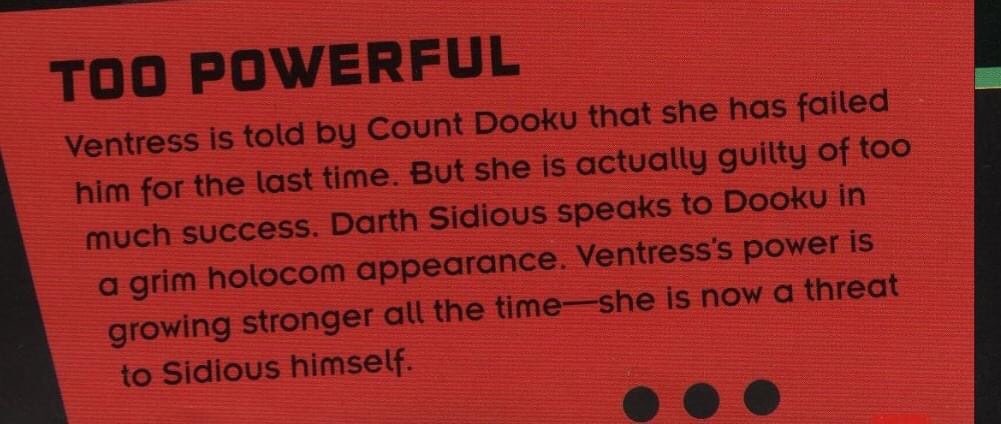
Emphasizes the trajectory of her abilities.Galactic Files #230: Asajj Ventress (2012) wrote:
Darth Sidious senses her growing powers and orders Dooku to eliminate her.
Emphasizes the trajectory of her abilities.starwars.com Count Dooku Biography Gallery wrote:
Wary of Ventress’ growing power, Sidious ordered Dooku to prove his allegiance by eliminating her.
Emphasizes the trajectory of her abilities.
All of these emphasize the trajectory of her abilities.
Talzin's power comes from Dathomir, that's almost half my point.
Right, and I agreed with that and acknowledged that. Gethzerion’s power, on the other hand, is independent from Dathomir. So Gethzerion being more powerful than Talzin offworld doesn’t mean she scales to Talzin’s on-world performance against Palpatine.
Dathomir itself grows in power:
Relevant how?
You can see Talzin or other Nightsisters using rituals on basically every single occasion. As you have said, there is a divergence between what we see from TCW Nightsisters and prior EU Nightsisters. Talzin and her followers use ichor and Dathomir itself. Gethzerion and the founding Nightsisters use both the dark side and their own Nightsister spells. Now spells and ichor aren't the same thing due to the aforementioned divergence but we do see Talzin using spells as you pointed out. And on all of those occasions she is chanting.
I am willing to discuss why the bifurcation changes things but as far as I can see, after all the research I put into it, my stance holds. I'd need to see a specific instance of Talzin using silent spells, not ichor, to wave the statement. Though admittedly, I can see why this could get muddied.
EU Nightsisters: spells and the dark side
TCW Nightsisters: spells and dark ichor

In the case of EU Witches, it’s all spells and all the Force/Dark Side.
In the case of TCW Witches, it’s all spells and all dark ichor, a different manifestation of the Force/Dark Side.
In neither case are the witches’ abilities divided into two different things; that’s never said.
Teneniel Djo is shocked that Luke can do regular Force abilities (“spells”) nonverbally.
Courtship of Princess Leia (1994, Dave Wolverton) wrote:
“I had to ask, at least,” Teneniel said, glancing away. She had been wondering all day if it was possible to keep a male witch enslaved. The ease with which he’d just freed himself answered that question, and the fact that he could cast spells without voicing them or using gestures unnerved her. Some of the sisters could do that with simple spells, but this male witch did it with even complex spells. She didn’t want him to see the fear in her face, or the hope. “Tell me, offworlder, do men on your planet have names?”
This spoken spell sure uses a lot of that same green ichor that also pops up in the instances of Talzin’s nonverbal magic (already posted). The dark ichor seems to be present in all the nightsisters’ magic, not just the nonverbal stuff.
The Clone Wars Season 3 Episode 12: Nightsisters (2011) wrote:
The distinctions between spells and general nightsister powers just isn’t there. To them, it’s all magic, all spells. Some are just simpler than others, and thus easier to do unspoken.
Both Talzin and Gethzerion can do nonverbal spells. Both Talzin and Gethzerion need to speak and make motions for more complex spells. I don’t see how this comparison so clearly favors Gethzerion.
Sidious, who you've pointed out is the supreme coward, went to Dathomir and killed Talzin personally. Palpatine in a far, far more powerful state is completely terrified of Gethzerion despite having personally killed Talzin amplified by Dathomir. Unless Gethzerion is significantly more powerful than Talzin, he has no reason to be gifting an Executor-class super star destroyer to a commander who did nothing more than bomb the planetside ports and the station in orbit.
Palpatine may be a coward, but I never claimed he was impractical. He won’t take risks where he won’t have to, but against Talzin he did have to. In that case, the cost of letting her live – the loss of Count Dooku and the continued overt threat of Maul’s Shadow Syndicate – would have outweighed the risk he took by confronting her. In Gethzerion’s case, the cost of diverting some of his practically unlimited resources to strand her did not outweigh the risks of fighting her (and her many Force-capable allies and disciples).
Sources also state that Yoda and Sidious are equals. Which is more than enough reason to want to get the hell out of there. He even puts his lot in with Yoda at the literal start of the fight scene:
Not sure if you posted the wrong clip or something, but Palps says nothing about expecting Yoda to win that fight here – or anywhere, to my knowledge.
Some stuff states that they were equals, sure. The vast majority that do side with one over the other pick Palpatine, and it’s Palpatine who ends up winning that fight. Palpatine won and lost nothing by engaging Yoda in a duel, but was afraid to anyway, which should tell us something about how he picks his battles.
Perhaps more importantly, per George Lucas, Sidious had just legitimately lost a fight against Master Windu:
Now imagine if you'd just lost a fight against the Jedi's no.2, you're not going to be very excited about fighting their no.1.

- Lucas doesn’t say anything about whether Palpatine lost the duel legitimately or not here, just that he lost.
- Anakin siding with Palpatine after seeing Palpatine cut down Mace in cold blood wouldn’t make sense, hence the change mentioned in the video, hence Palpatine’s goal can’t logically be to kill Mace there.
- “Legitimate” and “without circumstances” are two very different things; if you need me to run through why Mace’s fight versus Palpatine is a display beyond his usual capabilities regardless of whether Palpatine’s holding back or not, I can.
- Again, Palpatine did defeat Yoda, making his fear of fighting Yoda not indicative of Yoda being the better fighter.
Showing a clip of Yoda disarming Ventress when she's vastly, vastly pre-prime isn't exactly convincing, Durin. More importantly, Sidious tried to have her killed because he feared what she and Tyranus could do if they carried on. Which is the only claim I've been making.
I’m sure Filoni and crew would have Ventress giving Yoda a great fight if only it happened in Season 3 instead of in Season 1.
Just like how s3 Ventress almost managed to kill Dooku!* ** *** **** *****
The Clone Wars Season 3 Episode 12: Nightsisters (2011) wrote:
*ambushing Dooku while he’s asleep
**while Dooku was drugged/blinded
***with the help of two of the most powerful nightsisters
****while all three were invisible
*****it didn’t work
Yes, Ventress could potentially have contributed to Palpatine’s undoing, if trained up specially as a weapon against him. She hasn’t gotten to that point yet, and Palpatine had no reason to wait until she did to act.
Well, isn't that convenient, he can never have a legitimate reason to be afraid of someone. He's just a piss-ant who's scared. But he's also this ten-dimensional chess wizard smarter than anyone else ever. But he's also irrationally stupid when it comes to the part that matters most. But he's got infinite plans and is a Satan figure tier master manipulator with all the answers. Let's just pick and choose when he is one or the other and not actually logically deconstruct each event.
Palpatine’s both a manipulative genius and an incredibly pathetic being all the time. That position is fully consistent internally, fully consistent with every claim I’ve made, and fully consistent with the fundamental nature of the character (as explained in my first post). If those aspects are convenient for my argument and inconvenient for yours, what’s the natural takeaway from that?
I'm not seeing a single quote here that isn't within the context of the Empire and his immense authority within it. Might sound like a cop-out to you but it's the most immediate explanation for the quotes when considering this:
All of these quotes are either entirely or more firmly than anything else in the context of his apprenticeship to the Emperor. This does not come with political power in itself, but would of course have a lot to do with his personal prowess – emphasized directly in two of the four quotes.
Might sound like a cop-out to you but it's the most immediate explanation for the quotes when considering this:
The author himself has confirmed that Palpatine's fears are legitimate and immediate and that she could actually win a confrontation. Given your earlier tangent about the writers, I'd expect you to take this into consideration where you clearly didn't earlier. And given we have Leland Chee saying authors are the closest thing to an actual authority on the matter of their owns works, I'm inclined to go with the author and not your use of quotes that may or may not even hold weight here. Depending on your interpretation.
“I’d like to think” is not a confirmation.
It’s one writer’s speculation that probably has a reason that it didn’t make it into the source material.
Wolverton, the creator of Gethzerion, is far more likely to have Geth with Palps than most any other writer. Same for Veitch, the co-creator of Kun. Their ideas of their works are definitely worth taking into consideration, their opinions on tangentially related questions like this to a lesser degree, but definitely not enough to force the published works of other writers to reconcile with their uncertainly phrased social media opinions, instead of the other way around.
Such speculation is outright confirmed to not be canon in any context (this would apply to the aforementioned Veitch statement, as well).
What do you think is the reason that you need to keep coming to social media messages instead of the source material to find any of these guys being put directly with or above Palpatine?
Side note: I find it hilariously incredulous to believe that the dozen or so quotes all saying the same thing about the dynamic between Palpatine and Gethzerion, are actually hot air because Palpatine is actually just irrationally afraid. Especially given author confirmation of the original source material.
The air isn’t hot, it’s just blowing in a different direction than you’d like.
Tell me, at what point does what Kirana Ti says, provide literally any context to the fear Palpatine has of Gethzerion? Ti is entirely oblivious to this, and isn't taking either Palpatine or Gethzerion into account regarding this. Nor is what she says even mutually exclusive to all the sources you're ignoring on the point. Both can very easily be true.
I’m not claiming that it’s mutually exclusive to the sources saying Palpatine fears Gethzerion and her Nightsisters. I’m saying the exact opposite. If, as Kirana says, the Nightsisters not having spaceflight capabilities is the only thing that saved the galaxy from slow corruption by their magic, then there’s another explanation for Palpatine being afraid of that possibility than specifically losing a 1v1 against Gethzerion.
This is an astute observation. Unluckily for you, it isn't really that important given the other quotes:The New Rebellion wrote:
The presence had neared. It was strong in the dark side. He could feel the ripples, feel a power he hadn’t felt in a living being since he encountered the Emperor.
NOTE: This must be referring to the Emperor as of Return of the Jedi as Bantam didn't recognise the Cloned Emperor unless specifically stated.

Granted, Bantam often ignores DE. It doesn’t always though. Find me something saying that it’s only when “specifically stated” that it adheres to continuity.
I obviously can’t prove that unspecified references to Palpatine are in fact to specifically DE Palpatine, and cases where it is specified to be DE Palpatine would obviously fall into the “specifically stated” category. Goofy argument.
Yeah this is a wild conclusion to draw. The heroes being discussed only operate in the time between 0ABY and 1ABY. Palpatine's power is growing to such a degree that he's rapidly dwarfing himself from the prior year each time. As does Darth Vader. As does Luke Skywalker. It's entirely plausible that the three years after the events of Star Wars: Galaxies result in these heroes getting left in the dirt. Which is a perfectly reasonable explanation and doesn't result in your executive decision to conveniently retcon everything that happens.

No, we only see the heroes operate in the time between 0 ABY and 1 ABY.
It seems very unlikely for us to see any writer have 2 ABY Palpatine ripping 1 ABY Palpatine to shreds, or RotJ Vader tearing ESB Vader in half. They have reasons for growth, yeah. But dwarfing themselves each year?
Basically all material focused on answering versus-related questions – the Darth Maul vs Darth Vader Tales comic, for example – make no distinction between the various iterations. Do we think that the writers’ idea was for the comic to prove that RotJ Vader scales 10x above the performance by ANH Vader and just dumpsters Maul in the first lightsaber exchange?
Additionally, it seems unlikely that four beings who traversed the gap between an uninitiated Force-sensitive and 1 ABY Palpatine in the span of a single year (in itself a completely ridiculous scenario with no tenable explanation) somehow fall behind the growth rates of Palpatine, Vader, and Luke for no apparent reason. Or that these four Palpatine-tier beings all die offscreen to nothing in particular. Or that these heroes collectively decide to abandon their duties and live out their lives at a Zeltros resort.
Regardless, this rationalization can’t work with the movies. Luke/Leia are the last hopes of the galaxy. This is the case throughout the original trilogy, and, if we’re not being incredibly dishonest, throughout the span of all six movies. This is not because Yoda/Ben are incompetent and missed the window where 4+ beings each with the current ability to give Palpatine a run for his money are running around.
No matter how you go about it, your idea of the SWG Protags’ powers is astoundingly tone-deaf to both SWG itself and the movies, and cannot possibly coexist with the plot of the G-Canon OT.
A Series of Somewhat-Less-Than-Luminous Comparisons
Dark Emperor Palpatine using his full potency cannot stand against Luke Skywalker and Leia Organa Solo's powers as they unlock the energy of luminous beings:
Indeed, he's blanketly stated to have used the power to become a luminous being and a spirit against the spirit of Exar Kun, just as he intended to do against Kueller:
I’m not sure what makes you think that what Luke does against Exar Kun or Kueller is the same thing as what he and Leia do against DE Palpatine.
Rather than being likened to this event, it’s instead compared directly to Obi-Wan becoming a Force ghost – moving to be other luminous beings on the other side, but he was a luminous being all the time, as is every living being. This is a distinct action from connecting to and wielding the energies of every luminous being in history, which is what Luke and Leia are doing here.
If this weren’t readily apparent from how it’s actually described in the quotes you posted, and the more tangible disconnect of DE Luke and Leia’s not-ghostly nature, just compare what Luke and Leia are able to do against DE Palpatine to what Ghost Yoda and Ghost Ben are able to do against RotJ Palpatine in the Revenge of the Jedi scripts.
Star Wars Archives 1977-1983: Revenge of the Jedi Rough Draft, February 24, 1981 wrote:
Although Luke defeats Vader – he cuts off Vader’s sword hand, which falls into the flaming lake – he refuses to kill his father, insisting that there is still good in him. When Vader likewise refuses to kill his son, the Emperor sends deadly lightning bolts at Luke. At first, Ben and Yoda protect Luke from the netherworld (and their images flash momentarily as the bolts land) but soon Luke is on his knees writhing in pain.
The difference between what Yoda and Ben are able to do here… and what Luke and Vodo are able to do against Kun, and what Luke would have been able to do against Kueller… and DE's conclusion is the difference between one or two luminous beings lending their assistance from beyond the veil, and joining with every Jedi in the history of the Order and letting the Force in its entirety flow through them.
Not only this, but trying to scale these other barely related (and in reality, far smaller scale) instances of connection between Jedi to “the Force in all its intensity” is problematic, to say the least.
Conveniently for me, these same quotes also clarify that nothing can stop DE Palpatine short of this full, perfect connection to the Force, meaning that he would not be stopped by the other stuff you’re pointing to (that did stop Kun).
Indeed, the feat is quite clearly even more overshadowed by the wall of light that was summoned to destroy Exar Kun, four millennia earlier:
In fact, Exar Kun's performance against the combined Jedi Order was nothing short of excellent, as an 'all-powerful' being:
You can do some nitpicking here and there about how much power is used and where, but really, the gap in power between the wall of light formed by the entire combined Jedi Order and the Dorsk 81 feat, which is just Kyp and four dozen of the weaker students, 80% of which are literally nameless, which is explicitly stronger than the union in Jedi Academy with Luke Skywalker using luminous beings power. Is insurmountable.
And what reason are we given for the twelve students and two toddlers being able to do what the combined Jedi Order could not?
Jedi Academy: Champions of the Force (1994, Kevin J. Anderson) wrote:
“I’ve found only sketchy information, but it seems that in the final battle the unified Jedi wiped out most of the jungles on Yavin 4, laying waste to everything in their efforts to destroy Exar Kun. Kun drained dry the life force of all his Massassi slaves in one last gambit. The ancient Jedi succeeded in destroying much of what he had built and obliterated Kun’s body, but he somehow managed to preserve his spirit within the temples. For all these years.”
“Then we must finish the job,” Kirana Ti said, standing up. She wore her reptilian body armor all the time now, unencumbered by a Jedi robe because she did not know when she might need to fight at a moment’s notice.
“I agree,” Kam Solusar said. His gaunt face held the expression of a man who had long ago forgotten how to smile.
“But how?” Streen said. “Thousands of Jedi could not obliterate the Dark Man. We are only twelve.”
“Yes,” Kirana Ti said, “but this time Exar Kun doesn’t have a race of enslaved people to draw upon. He has no resources but himself. Besides, Kun has already been defeated once—and he knows it.”
It seems like that distinction lies entirely with the Massassi Kun had, the factor you’ve been trying so hard to downplay as Ritual Kun’s primary source of strength.
I’ve already covered how Kun’s performance against the combined Jedi Order is not quite so stellar.
The Inherent Problem with Lengthy Scaling Chains
No amount of supremacy quotes and vague George Lucas appeals can save the Emperor from the direct and objective chain of power arrayed against him.
Explain to me exactly why Kun’s supremacy quotes in other areas that both of your chains rely on so heavily should each be weighted more heavily than Sidious’s more clearly and more often stated direct supremacy quotes over Kun.
With Palpatine’s supremacy statements, we can tell exactly what each author – and their approved and published material – thinks about Palpatine vs Exar Kun. Palpatine is the GOAT. Exar Kun is not.
With your chains, even if they were credible connections at each individual step (they’re not!), we still couldn’t say definitively that the writers involved with the referenced material – let alone those uninvolved – would agree with that final takeaway, by those methods. The only writer you’ve got saying Palpatine is not better than Kun is Tom Veitch – in an email a good 20 years after he wrote anything for either character.
Wolverton might like to think that Gethzerion can beat Palpatine. Do we also think that Wolverton would like to think that Exar Kun would solo four Gethzerions?
The nature of multi-writer scaling chains like this are always more tenuous than direct comparisons, even when perfectly reasonable otherwise.
Bruu Jun-Fan, probably wrote:I fear not the man who has 10,000 scaling links repeated once, but I fear the man who has one scaling link repeated 10,000 times.
Conclusion
Palpatine is repeatedly stated supreme in a category that includes Kun as another prominent figure. Your Ritual Kun is not exempt from this due to OOU dating, as the material you use to establish his power level predates many of the Palpatine quotes.
This categorical supremacy also extends to characters such as:
-Vitiate
-Marka Ragnos
It is both illogical in-universe and strongly counterintuitive out-of-universe for Kun’s ritual to give him more power than the Nathema ritual.
Kun’s ritual is not Kun’s ritual; Kun neither made it nor understood it. The Sith who made it necessarily either conducted it (and would also remain sub Palpatine) or decided it was not worth conducting, leaving it highly questionable that it truly offers as much power as you assert.
Palpatine would become empowered from Kun’s resistance.
Ritual Kun’s performance against a crippled Jedi Order was him fighting a handful of its less powerful members on a dark side nexus and then hiding away while the storm of the main force smiting the planet blew over.
Ritual Kun is not beyond the use of the lightsaber against even randoms, and his demonstrated proficiency with that tool pales before Palpatine’s.
Spirit Kun, with almost all of Ritual Kun’s same wank attributed to him, is consistently underperforming for his supposed level.
Both proposed pro-Kun scaling chains are full of connections ranging from doubtful to outright impossible and are contradicted by our more direct comparisons.
Kun’s final death is the warm-up in a book that culminates in a battle against Admiral Daala.
Palpatine is the archvillain of all time.
Palpatine gets to add a third tally onto his speeder’s fuselage.
"It has nothing to do with my talents." Palpatine turned slightly in the driver's seat. "When I was younger I was responsible for the deaths of two pedestrians. At the time, my father threatened never to allow me to fly, but he eventually relented."

 AncientPowerSuspect Hero | Level Four
AncientPowerSuspect Hero | Level Four
 Re: SS - EXAR KUN (AncientPower) VS. DARTH SIDIOUS (Durin)
Re: SS - EXAR KUN (AncientPower) VS. DARTH SIDIOUS (Durin)
November 23rd 2023, 8:11 pm
 AncientPowerSuspect Hero | Level Four
AncientPowerSuspect Hero | Level Four
 PART ONE
PART ONE
November 30th 2023, 5:46 am
Supremacy Quotes:
The number of supremacy statements for Palpatine is important because it shows that a majority of writers to weigh in on who the most powerful Sith may be have reason to believe it to be Palpatine. They believe this to be clear enough that they assert it, sometimes repeatedly, in the works themselves. That makes this being untrue, even by technicality, very unlikely.
It would be exceedingly strange for anyone to be excepted from this rule, and Exar Kun has absolutely nothing going against it except for maybe one obscure supremacy quote against Palpatine’s many, including several more authoritative, several more visible, and several more recent.
The ultimate question can be boiled down to this: what is the most important form of evidence: a claimed theory or demonstrated evidence?
Darth Sidious, Sheev Palpatine, the Emperor. He almost certainly has the most supremacy quotes of any one in any format of the 'most powerful' statements within the Expanded Universe. A guy who has been the figurehead for villainy in the franchise for 46 years, has the most quotes. Go figure.
In practice, exactly how valuable are these quotes? Let's take a look at the track record for Palpatine in terms of just how credible these claims are when put to the test:
Exhibit A: Emperor Palpatine vs. Ancient Sith spirits on Korriban

The Great Temple and the mummified Sith are seen a second time when Freedon Nadd leads Exar Kun to them in Tales of the Jedi: Dark Lords of the Sith:
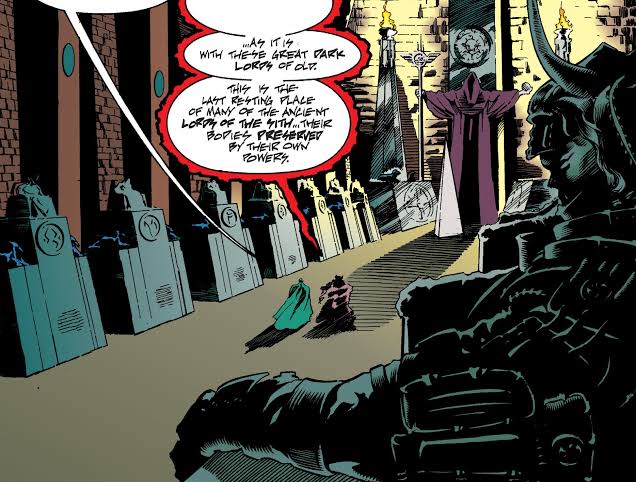
These Sith are the same ones who Emperor Palpatine is 'cowed' by:
Star Wars Gamer 5 (2001) wrote:Shortly after the Battle of Yavin, Droga rescued his cowed master after Palpatine had enraged the mummified Sith by demanding dark side knowledge. Palpatine recovered from the assault in a bacta tank on Imperial Center while Droga retrieved one of the Emperor’s clones.
He himself states they 'almost killed' him:

In fact, the Dark Emperor states that he'd been to this Great Temple on Korriban 'ten years' prior. The exact time period the Emperor's 'cowing' took place, in direct reference to the 'mummified Ancients' he faces currently:
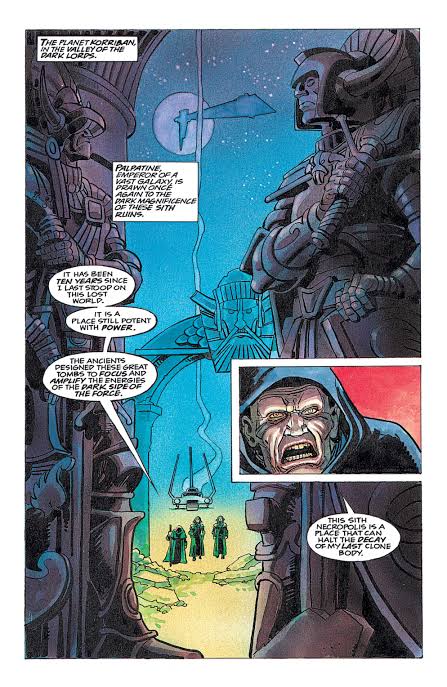
So essentially what happened was this:
Exhibit B: Emperor Palpatine vs Karness Muur
The Emperor got well and truly folded by Muur's peers, I wonder if he'll do any better against one of the Exile's finest. Karness Muur is kept in an oubliette which specifically prevents him from growing in power or using it:
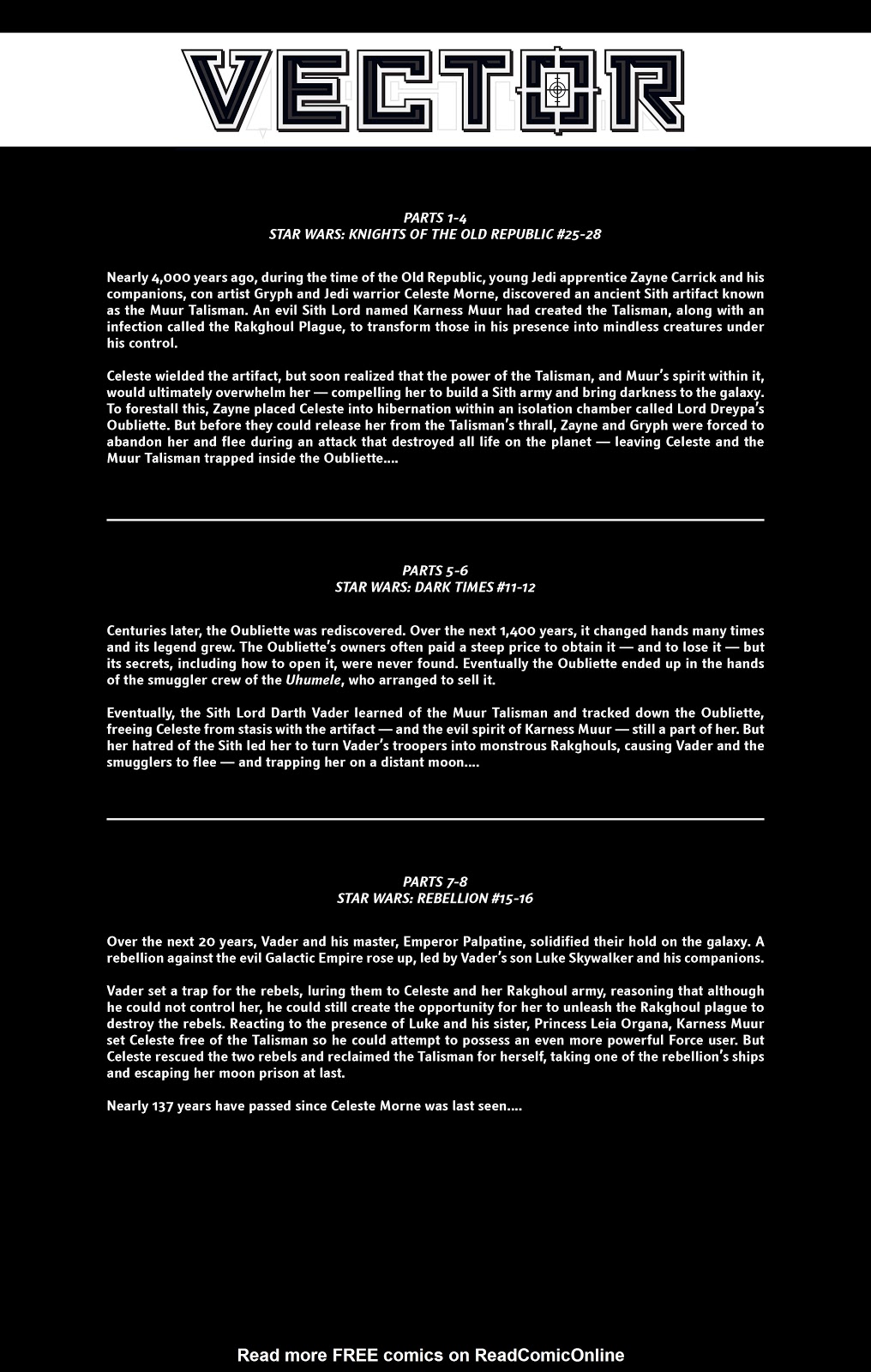
It's this Karness Muur who would become the new Dark Lord of the Sith. Over a Darth Vader, who now wields the power of the talisman to kill the Emperor outright:

It's important to note which Darth Vader this is, precisely 3 months after the Declaration of the New Order in Revenge of the Sith. This is the state of Darth Vader at that point:
Dark Lord: Rise of Darth Vader wrote:Yes, Vader was not precisely what he had bargained for. Vader’s legs and arms were artificial, and he would never be able to summon lightning or leap about like the Jedi had been fond of doing. His dark side training was just beginning. But Sith power resided not in the flesh but in the will. Self-restraint was praised by the Jedi only because they didn’t know the power of the dark side. Vader’s real weaknesses were psychological rather than physical, and for Vader to overcome them he would need to be driven deeper into himself, to confront all his choices and his disappointments.
Powered by treachery, the Sith Master-apprentice relationship was always a dangerous game. Trust was encouraged even while being sabotaged; loyalty was demanded even while betrayal was prized; suspicion was nourished even while honesty was praised.
In some sense, it was survival of the fittest.
Fundamental to Vader’s growth was the desire to overthrow his Master.
Had Vader killed Obi-Wan on Mustafar, he might have attempted to kill Sidious, as well. In fact, Sidious would have been surprised if Anakin hadn’t made an attempt. Now, however, incapable of so much as breathing on his own, Vader could not rise to the challenge, and Sidious understood that he would need everything in his power to shake Vader out of that despair, and reawaken the incredible power within him.
Described as being at his 'lowest possible point':
STAR WARS OFFICIAL FIGURINE COLLECTION #12 wrote:Strikingly, in the story of Anakin Skywalker, the hero must fall from grace -- then later redeem himself -- in order to fulfil the prophecy. Thus, Darth Vader becomes a 'fallen angel' figure. From being the most powerful Jedi, a 'fearless hero ' of the Republic, Anakin falls to the lowest possible point because of his desire for power and security.
So the power of the talisman brings a pathetic, broken man at his lowest possible point up to the level of killing the Emperor. And Karness Muur is still his master immediately after that.
Exhibit C: Emperor Palpatine vs. Karness Muur Round 2

The Emperor has Darth Vader at his side, plus an army and he's grown in power across 19 years. And he's still just as dead.
So that's THREE occasions where Palpatine dies or almost dies when faced with an ancient Sith. Just so we're keeping track.
But then you gave us this gem:
As previously established, Palpatine has every reason to be above every previous Sith Lord, including the Emperor Vitiate. If, for whatever reason, you take issue with Palpatine’s categorical supremacy being not-quite-categorical in regards to Ritual Kun, it certainly would apply to the Sith Emperor Vitiate, a well-known figure who is, unfortunately for him, caught wide net of Palpatine’s supremacy statements.
Exhibit D: Emperor Palpatine vs Tenebrae
Now let's assume everything you just said in that quote is accurate. There's a slight problem with this, in that the powers on display in Echoes of Oblivion are also necessarily the powers he has since the Nathema Ritual or at the very least when he made this failsafe trap with his original body. Which is noted to be right after the events of the Revan novel.
Let's go over just how badly Tenebrae slaps Sidious. Above I showed just how strongly Muur is depicted against the Emperor. And when I tell you that doesn't bode well for you, oh you better believe it:
Ajunta Pall, Knights of the OId Republic wrote:"I... had a name, once. Ajunta Pall. Yes, that was my name. I was one of many. We were servants of the dark side... Sith Lords, we called ourselves. So proud. In the end we were not so proud. We hid... hid from those we had betrayed. We fell... and I knew it would be so..."
"Our temple... our tomb. Built far from our enemies. We revered power and threw off the teachings of our old masters. It... we were not the first to fall to the dark side. But we... had more power than those before us. It... came from elsewhere..."
"Our oldest secret. Only... only we would know, we lords. Only we would know where our power came from..."
"I... see your heart, human Jedi. I see your power, your pride. You... you will find the old place, the dark place... and you will regret it."
"So much power... it is blinding. I...I remember so little..."
"I... I do not remember. A map? Perhaps it is a map. But it has not been buried with me. All I have now is my sword."
The Exiles have this opinion of the dark side energies surrounding the Star Map. By comparison, the Star Forge is the pinnacle of the might and technology of the Rakata:
Darth Malak, Knights of the Old Republic wrote:"The Star Forge is more than just a space station. In some ways, it is like a living creature. It hungers. And it can feed on the dark side that is within all of us!"
It could end the Force:
Bastila Shan, Knights of the Old Republic II:The Sith Lords wrote:"There is no one left with the power to control the Forge, though many have tried. I have watched them be devoured, their life drained from them as they attempt to tap into its power. Knowing what we do of the Builders and their fate, I'm convinced that Revan did not intend us to keep the Star Forge - to use it would mean the end of the Sith... the end of the Force."
Yes, the Star Forge killed and/or drained the life force of nearly an entire species across all Rakatan territory throughout the galaxy. And that's the kind of power it has when Revan finds it:
Ancient Rakata Computer, Knights of the Old Republic wrote:"In your terminology, the Star Forge is a tool of the dark side. It corrupts those who use it so that it can generate greater and greater amounts of negative energy to fuel itself. The Builders thought they were strong enough to control this effect, but they were wrong. They became victims of their own creation, and eventually their hatred turned them against each other. Civil war destroyed the Infinite Empire - a lesson to remember. Only one who is immensely strong in mind can harness the power of the Star Forge without suffering a similar fate."
Rakata Codex Entry wrote:However, the Rakata’s rapid expansion came to an abrupt end when a strange plague swept through the species. Millions died, and most of those who survived lost their connection to the Force.
Darth Malak is defeated by Revan despite being super-powered by the Star Forge, that absolutely dwarfs the power of Karness Muur by every imaginable metric:
Then Revan goes on to face Tenebrae and:
As Meetra and Scourge battled the Guard, Revan charged toward the Emperor.
His opponent stood perfectly still, focusing and channeling his power. At the last possible instant, the Emperor unleashed a wave of energy that swept Revan off his feet and sent him flying backward.
Revan twisted in midair so that he was able to roll with the impact when he landed. He quickly sprang back to his feet and advanced again, moving more slowly this time.
The Emperor stood in the exact same position as before; it was as if he hadn’t even moved. Revan began to sense the oppressive presence of the dark side weighing down on him. The Emperor was trying to crush his will: to dominate and enslave his mind as he had before. This time, however, Revan was ready.
Instead of charging forward, he opened himself up to the Force, letting both the light and the dark side flow through him like twin rushing rivers. But instead of focusing or channeling the Force, he released it in its purest form.
There was brilliant flash as the air between the two combatants lit up. The energy unleashed was powerful enough to send Revan staggering. The Emperor, unprepared and with much of his strength diverted to his effort to dominate Revan’s mind, was sent flying backward.
He landed in a heap on the floor and Revan raced toward him. The Emperor rolled over, lifted himself up on one knee, and his hands flew forward as he hurtled a bolt of dark side lightning at his enemy.
Revan intercepted the bolt with the blade of his lightsaber, though the impact stopped his charge dead in its tracks.
The Emperor unleashed three more bolts in quick succession. Revan batted the first aside with his lightsaber, ducked the second, then deflected the third back in the direction of its source.
It struck the Emperor in the chest, sending him sliding several meters back on the floor. For the first time the Sith’s emotionless veneer cracked as he let out a primal hiss of hate. The sound sent shivers down Revan’s spine.
The Emperor rose to his feet, his robes smoking and singed where the lighting had struck him. His black eyes flashed red, and he raised both hands high above his head.
Revan knew he was gathering his power to unleash a swirling storm of pure dark side energy, just as Nyriss had done. The Jedi quickly calculated his options. Realizing he couldn’t close the gap between them quickly enough to stop the assault, he gathered his own energy and spread his hands before him, ready to catch and absorb the Emperor’s attack.
A dozen bolts of purple lightning arced from the Emperor toward him. Revan tried to draw them in and contain them, but the Emperor was infinitely more powerful than Darth Nyriss had ever been.
Revan’s body was engulfed in agony as the electricity coursed through his body. His skin began to boil and blister, the flesh of his face melting and sticking to the superheated metal of his mask as the Emperor poured more and more power into him.
The Emperor's raw might looks more like this compared to Revan however:
And to double-down, that's not even likely to be his pinnacle given that he absorbs the power of Vaylin and also possibly Arcann(if the Outlander kills him) on-top of his own in Knights of the Eternal Throne whilst in command of the Outlander, who he has formed into a perfect host:
In conclusion, Tenebrae absolutely dusts Revenge of the Sith Darth Sidious using a direct chain of demonstrated power that he is at the bottom of, that you cannot begin to counter. He's demonstratably getting flattened by Karness Muur and some nameless spirits on Korriban he still needs help from in his penultimate incarnation.
If the supremacy quotes in question are not demonstratably true, even on a single point, then it stands to reason that they're not unassailable. And more importantly, just not that important when faced with any form of actual direct evidence.
These supremacy quotes for a category that includes both characters not only as members, but as figureheads (as you noted Kun to be at the start of your first post), is a more direct link between them than anything else. Palpatine is winning that competition very decisively.
Supremacy quotes are the furthest thing from their most direct link, but seeing as you keep trying to wiggle out of it, I'll not only prove it fully here. I'll also counter everything you say later on, don't worry.
18.8BBY Darth Vader is far more powerful than Kar Vastor who has power 'on the scale' of early Clone Wars era Anakin Skywalker and Master Yoda:
Coruscant Nights I: Jedi Twilight wrote:The Force was powerful in Vader; even the dim wattage of Nick's connection could feel that. It was far more powerful than it had been in Kar Vastor. It had pulsed from Vastor in waves of fury, blasted like an open furnace.
Shatterpoint wrote:I could not answer; Vastor has power on the scale of Master Yoda, or young Anakin Skywalker. And I had no desire to debate with Depa on Jedi tradition, and the necessary distinction between dark and light.
The Darth Vader that Luke is defeating is far, far beyond that. This is the concept Luke Skywalker has of Darth Vader as of their fight on Mimban:
The Princess fought bravely, but she was no match for Vader. She used the last of her strength to throw the lightsaber to Skywalker, just as he emerged from under the rubble. Facing the Sith Lord, Skywalker said, “Ben Kenobi is with me, Vader, and the Force is with me too.”
The duel was furious, and carried Vader and Skywalker through the temple to a chamber where there was a dark circular opening in the floor, the mouth of a deep pit. As the battle wore on, Vader found himself breathing hard through his respirator. But then, thanks to his proximity to the Force-enhancing Kaiburr Crystal, he felt a sudden surge of the power of the dark side, allowing him to project lightning from his fingertips for the first time in his life. He hurled Force-energized lightning at Skywalker, but his young opponent deflected the blast.
“Not … possible!” Vader muttered, feeling his energy drain. “Such power … in a child. Not possible!”
As Skywalker threw himself at the towering black figure, Vader raised his lightsaber to defend himself. But he wasn’t fast enough. Skywalker’s blade cut through the Sith Lord’s prosthetic right arm, and it fell to the floor, still clutching the red-bladed lightsaber.
-The Rise and Fall of Darth Vader
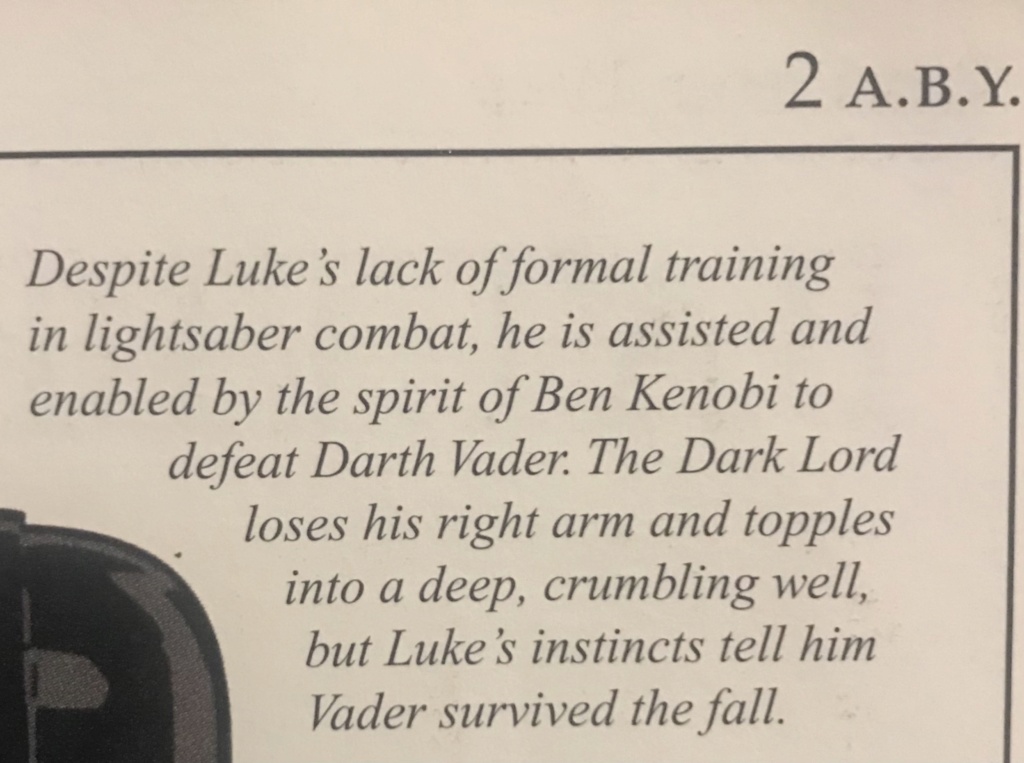

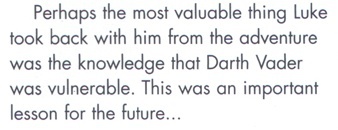
This is what Luke Skywalker projects onto the dark side spirit in the Dagobah Cave, and destroys:
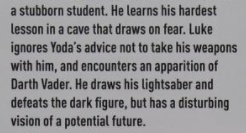

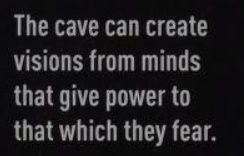


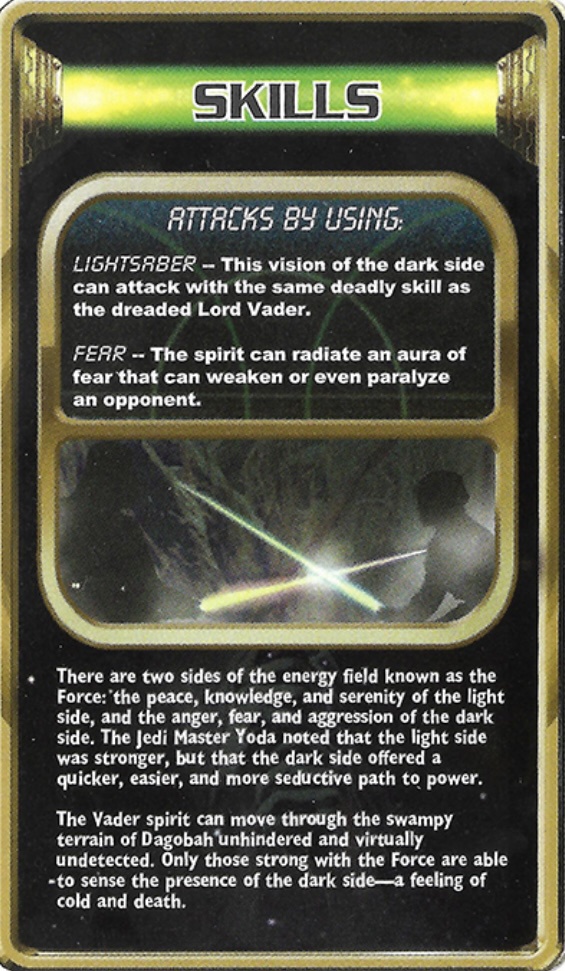
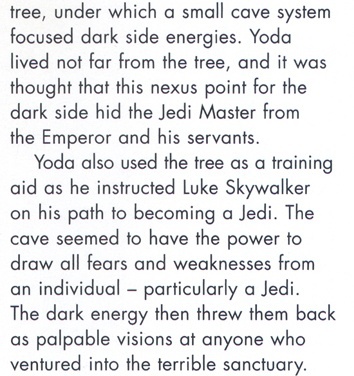
Yet when Luke Skywalker faces Darth Vader on Bespin:

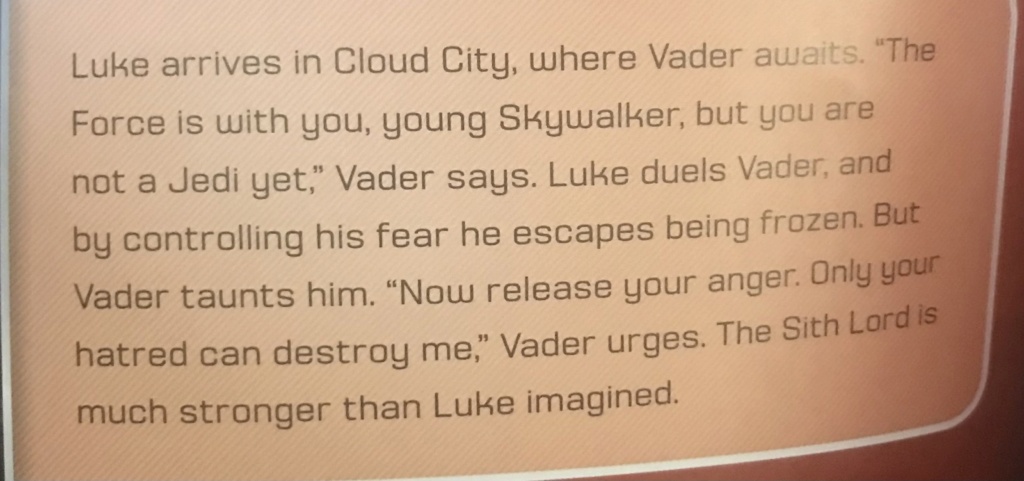
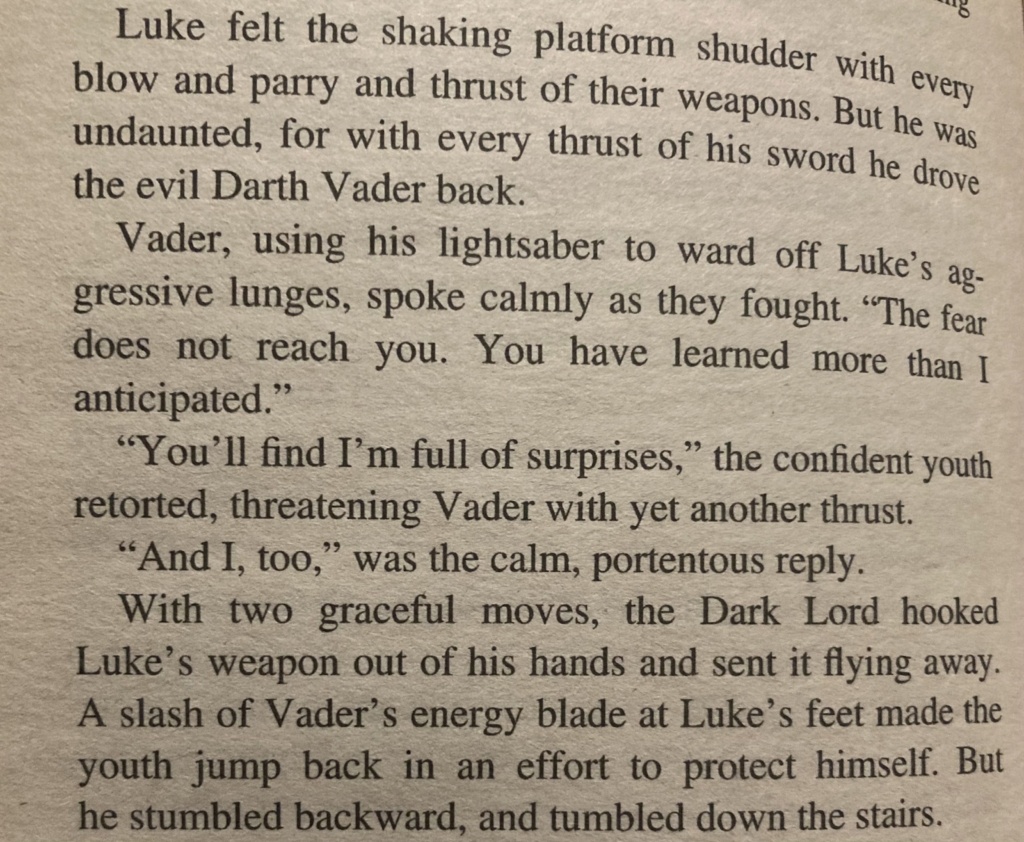



A Kaiburr-crystal amplified Darth Vader, who is nearly 19 years of power growth beyond being far more powerful than Kar Vastor, goes from being dismantled instantly by a Luke Skywalker hindered by the Dagobah Cave's dark side nexus, to far more powerful on Bespin, where Luke "could not be more wrong" about how ready he is to face him, and is only beginning to realise how powerful Darth Vader really is when he actually engages him.
We also know that as of 2012, Return of the Jedi Darth Vader is his strongest incarnation so far:
Darth Vader: Return Of Anakin Skywalker wrote:More powerful in the Force than ever before as well as a master of the lightsaber, Darth Vader prepares for his final battle as the Rebel fleet hammers the fully operational Death Star.
Darth Vader is capable of 'destroying' a 'powered up' Darth Maul specifically meant to replace him, and a host of Dark Side Prophets, at once, with the Force:
Dark Side Prophet to Darth Vader, Tales 9: Resurrection wrote:Of course you could refuse the duel and attempt to destroy all of us here and now. You might even succeed. But such a deed would diminish you in the Emperor's eyes, would it not? And you would always wonder. Doubt would always nag at you. You could never be certain whether Darth Maul was your better...unless you take up this challenge.
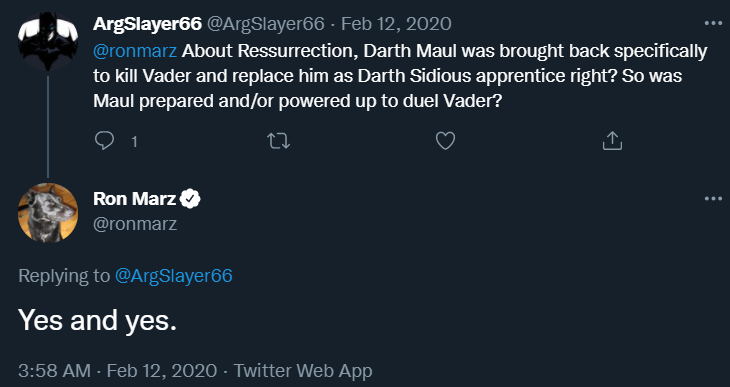

But even worse for Luke Skywalker:
Return of the Jedi Novelization wrote:His power was great, now, greater than it had ever been. It shimmered from within, and resonated with the waves of darkness that flowed from the Emperor.
Despite this, Return of the Jedi Luke Skywalker is handily besting Darth Vader:
So Luke Skywalker is capable of defeating a prime, immensely amplified Darth Vader. Whilst simultaneously resisting the corrupting powers of Emperor Palpatine:
The Movie Trilogy Sourcebook wrote:Still, even these were not insurmountable problems: with young Skywalker at his side, all could be made right again. But the boy found it inside himself to rise above the Emperor’s compelling power, and thwarted Palpatine's attempts to turn him to the dark side. In some baffling way, that young whelp was stronger than him! This was intolerable!



In Revenge of the Sith we know Darth Sidious could use his monstrous willpower to create a dark side confusion haze to reduce Kit Fisto, Saesee Tiin and Agen Kolar to speedblitz tier:
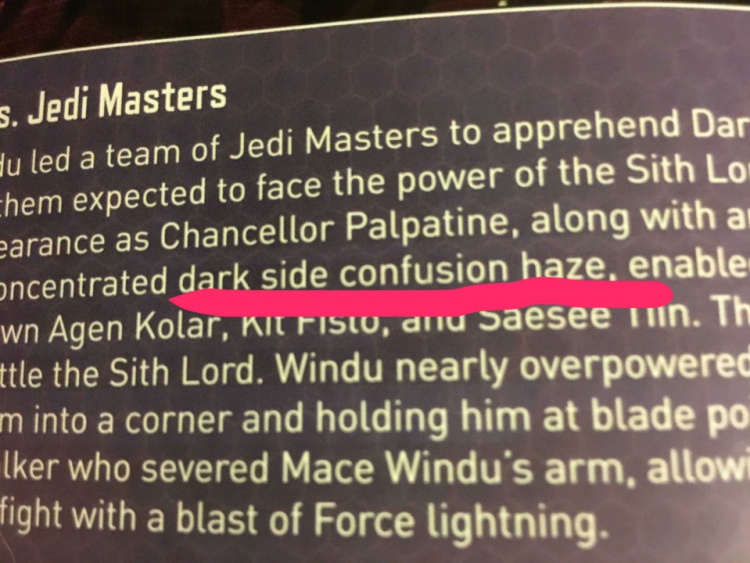
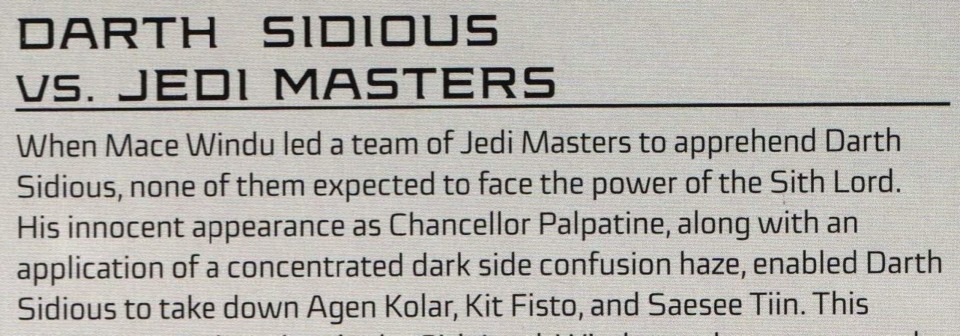
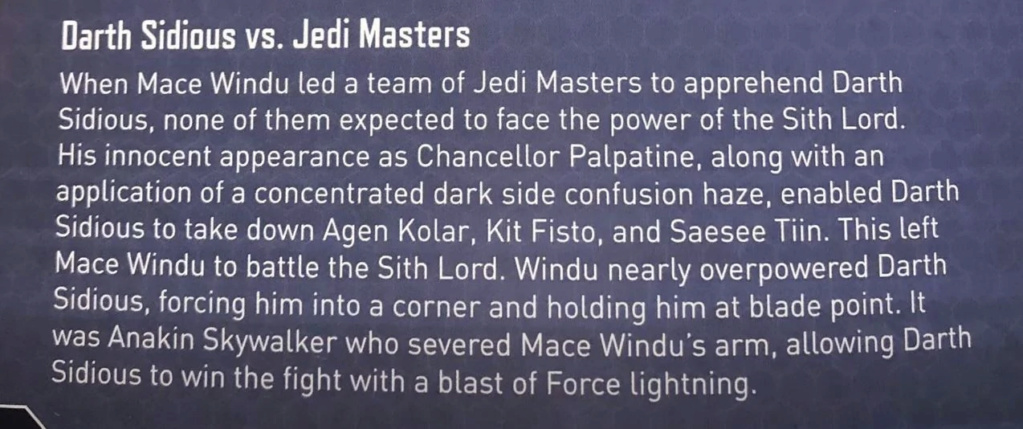
And, by the way, Sidious far before then is able to 'cloud' the mind of Darth Plagueis up to his death:
Darth Sidious to Darth Plagueis, Star Wars: Darth Plagueis wrote:"You may be wondering: when did he begin to change? The truth is that I haven’t changed. As we have clouded the minds of the Jedi, I clouded yours."
So, Jedi Knight Luke Skywalker completely and utterly dwarfs the mental capabilities of Kit Fisto, Saesee Tiin, Agen Kolar and massively moreso Darth Plagueis, whilst defeating an enraged and empowered version of Darth Vader, who feels humiliated. But we're not done yet. The dark side of the Force itself, is also 'actively and desperately' trying to convert Luke Skywalker at the same time:

Most importantly, George Lucas himself confirms that Darth Vader and Luke Skywalker together might be able to defeat the Emperor:
George Lucas: He knows that if he gets into a laser fight with the Emperor, he won't win. He knows his son can't win. Neither one of them can beat the Emperor. Together they might. In the first sequel, he reveals that when he says, 'Together we can rule the universe.
Which leads me to the next point. How long is it before Luke's power reaches the point where he doesn't need his father's help to do this by himself?
Over the next seven years, Luke grows exponentially:
Dark Empire End-notes wrote:Through the long years of struggle, Luke grew more and more adept in the skills of a Jedi.
Dark Emperor Palpatine likewise is now massively stronger:
Dark Empire Sourcebook wrote:Soon he was ready to strike. Fully healed and in greater control of the Dark Side than ever, he finally acted to end the Mutiny.
Dark Empire Sourcebook wrote:Palpatine held a power over Luke that C'baoth never could. Where Luke felt concern and even pity for C'baoth, Palpatine's power seemed overwhelming. The Emperor was not a mad, deluded shadow of a once great man; he was a conscious, willing participant in corruption for its own sake. Luke apprenticed himself to the Emperor of his own free will. Palpatine was so powerful in this new incarnation that Luke felt the only way to defeat the Dark Side was to know its ways and find its weaknesses. Luke had chosen his destiny: to understand the Dark Side from within and to use that knowledge to conquer it.
And Palpatine can now almost dominate Luke at will:
Dark Empire Audio Drama wrote:Palpatine's hologram: ...and I have come to realize that the dark side is my only ally. The dark side is the only means to power.
R2-D2: (beeb beeb)
Luke: Be quiet, R2, I don't care about the time, but can you do something about the heat? I suddenly... feel... cold...
Palpatine's hologram: My explorations of the Force have revealed to me many wonderful secrets.
Luke: Cold... like a dead hand pressing on my heart...
Palpatine's hologram: I have learned that Anger and Will, when joined together, forge a most unholy and devastating alliance.
Luke: Maybe R2's right... time to leave... but it's like a great weight... pressing down on me... I... can't move... can't... leave...
Palpatine's hologram: Using Anger, I have learned to unlock the hidden reservoirs of the glorious dark side power.
Luke: No...
Palpatine's hologram: Anger concentrated by Will in the vital center of the body creates a portal, through which vast energies are released. The energies of the dark side of the Force. This is the power I command, now that I am one with the dark side.
Luke: Is this what my father felt?
Palpatine's hologram: With these energies, I have slain my enemies across the empty reaches of space.
Luke: I shouldn't... listen...
Palpatine's hologram: I have created lightning, and unleashed devastating fires.
Luke: ...but I can't... stop...
Palpatine's hologram: With this knowledge, I can unleash dark side energies that swirl invisibly around us, even to shatter the fabric of space itself. In this way, I have created Storms.
Luke: Got... to break... free!
R2-D2: (beeb beeb)
Luke: I'm... alright, R2. (panting). This place... is still strong with the dark side. And the presence of the Emperor, even in a hologram, is almost overpowering.
Handbook 3: Dark Empire wrote:After a brief lightsaber battle, the Emperor subdued Luke and broke his will.

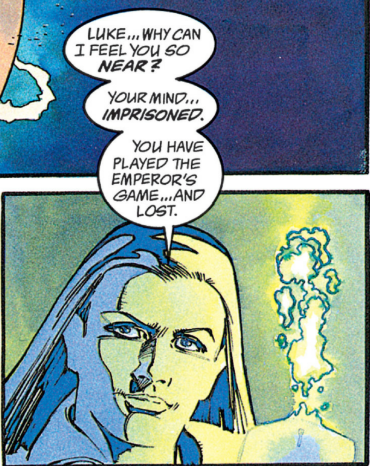
Luke breaks free of this due to Leia and his will becomes immune to the Emperor's:

The Dark Emperor grows in power since Luke's fall:
Dark Empire wrote:Even now, as Luke appears to fall under the Emperor's ever-expanding power, massive engines of destruction are inflicting death blows to the floating cities of the Calamari, long-standing allies of the Rebel Alliance...
Dark Empire wrote:But the Emperor cannot be overcome so easily. He gives Leia a painful demonstration of his ever-expanding power, crowing in triumph that he has finally captured the last of the Jedi!
And in a new body, the Dark Emperor is more powerful than ever:
Handbook 3: Dark Empire wrote:Luke knew that without clones to inhabit, Palpatine's spirit would be consigned forever to the void. But Palpatine was able to transfer himself at the last moment. Within a new clone body, the Emperor was more powerful than ever.
Luke is thus far beyond the stomp gap range of by far the most powerful version of the Dark Emperor's telepathy, corruption and especially his augmentation:
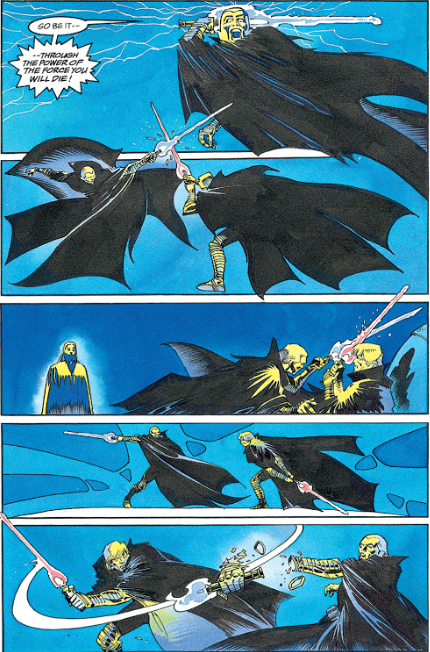
Luke Skywalker is now capable of turning the Dark Emperor's knowledge against him and 'overpowering' him in the Force by joining his mind with Leia's:
TOM: At the time I sent in my original proposal, I didn’t quite know how the story would end, except that Luke and Leia would overpower the Emperor by joining their minds in the Force. Tim had a problem with that, of course. He said my idea was “an insult to the Star Wars philosophy”. He said that the idea that Luke and Leia would use mental power to destroy the Emperor was “completely and absolutely WRONG.” [his caps]
Q: Weird.
TOM: Well, I think he might have misunderstood what I wrote in the proposal, about “whole areas of the dark mind falling to the light side of the Force…” I also said that at that moment “everything Luke has learned about the dark side is transmuted and turned against the Emperor.”
LINK: http://starwarsinterviews1.blogspot.com/2020/07/exclusive-16-pages-of-dark-empire.html
Kevin J. Anderson wrote:Q: You did have a lot of experience behind the scenes really putting this universe together…
A: At the time, we were all a team of authors. I was in contact with Dave Wolverton, Kathy Tyers, Mike Stackpole, and Tim Zahn, along with Tom Veitch a great deal with Tales of the Jedi comics. We were like a small team exchanging ideas. Tim Zahn would plant something in The Last Command that I picked up on in Jedi Search, and we did that sort of stuff. I’ve been out of the loop for a while, I’m not sure if LucasFilm writers do the same thing now, but we had a great little team who were building the history of this universe. We were like the worker bees building a foundation.
Dark Empire II Luke Skywalker is thus far, far beyond the likes of the 'Titans' of the Revenge of the Sith by any and all manner of comparison, with the Emperor as common denominator.
KYLE FUCKING KATARN
Jerec is very nearly as powerful as Darth Vader:
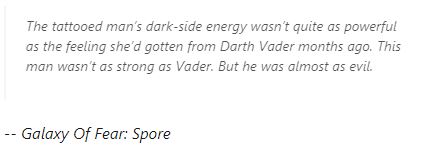
Dark Forces II: Jedi Knight Game Manual wrote:His embrace of the Force's dark side gives him powers that rival Vader's.
Jerec in the Valley of the Jedi is multiple times more powerful:
Dark Forces II: Jedi Knight, lucasarts.com wrote:His heavy brow overshadows the empty recesses that normally embrace eyes. Tattoos flow from his mouth and he hides his empty eye sockets with a thin blindfold-like mask. His power and advantages mainly stem from his vast knowledge of the Force and the Well.
When battling him he can drain most of your resources from the Well leaving you weak and vulnerable. He is more powerful since he has absorbed some of the Void from the Valley of the Souls.
Dark Side Sourcebook wrote:Jerec's followers held Kyle off long enough for Jerec to access the Valley's secrets and gain phenomenal Force powers. But even with his increased might, Jerec was unable to defeat Kyle or to prevent him from freeing the Valley's trapped Jedi spirits.
Dark Forces II: Jedi Knight Novelization wrote:Now that the Valley was under his control, Jerec was in no particular hurry. He needed time to prepare, but more than that, time in which to savor that which destiny had placed before him, much as a gourmet might linger over a rare and carefully prepared dessert. There was leakage, though - leakage that could double or even triple his ability - and whet his appetite for more.
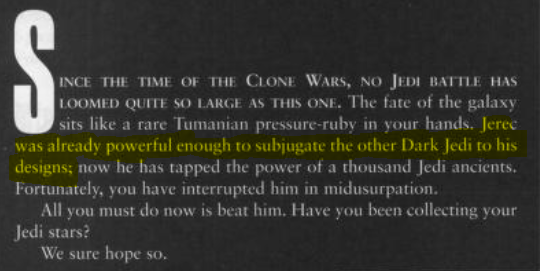
Kyle Katarn was still too powerful for Jerec to defeat:
Dark Side Sourcebook wrote:Jerec's followers held Kyle off long enough for Jerec to access the Valley's secrets and gain phenomenal Force powers. But even with his increased might, Jerec was unable to defeat Kyle or to prevent him from freeing the Valley's trapped Jedi spirits.
LucasArts Continuity Supervisor Ryan Kaufman, starwars.com wrote:But what a task! At the end of Jedi Knight, the player (as Kyle) is either a consummately powerful warrior, having vanquished the evil Dark Jedi Jerec in face-to-face combat...
If Kyle Katarn had gone over to the dark side of the Force, he would have absorbed the power of the Valley of the Jedi, become Emperor and wielded power almost on par with Emperor Palpatine's:
LucasArts Continuity Supervisor Ryan Kaufman, starwars.com wrote:A figure of almost Palpatine-like power, as a Dark Jedi in charge of the Imperial Remnant.
After this we get Dark Forces II: Mysteries of the Sith:
Dark Forces II: Mysteries of the Sith wrote:It has been more than five years since Jerec was defeated at the Valley of the Jedi. Kyle Katarn, continuing his pursuit of the light side of the Force, has joined the fragile New Republic in the struggle against the remnants of the Empire.
In Mysteries of the Sith, Kyle Katarn goes over to the dark side of the Force being corrupted by the Dark Force Temple:
Wizards of the Coast: The Dark Forces Saga 5 wrote:Kyle Katarn travelled there after learning of the witch world in ancient inscriptions, battling a host of Sith abominations in the planet's seemingly endless bogs before succumbing to the spell of the dark side of the Force.
LucasArts Continuity Supervisor Ryan Kaufman, starwars.com wrote:As he grew in knowledge and power, he realized they were Sith ruins. But some part of him was drawn to their dark call. So, without telling Mara why, he went off to investigate.
There Kyle finds and harnesses power that he describes as greater than any he'd ever known:
Kyle Katarn, Dark Forces II: Mysteries of the Sith wrote:“I found a greater source of power than I had ever known.”
Kyle Katarn, Mysteries of the Sith wrote:"Feel the power embrace you as your Jedi powers fail you!"
Kyle Katarn, redeemed, joined the Jedi Academy at Luke's request so he could better use his power:

New Essential Chronology wrote:He located other candidates, including the clone Dorsk 81, the warrior woman Kirana Ti from Dathomir, and Corran Horn from Rogue Squadron. New Republic Commander Kyle Katarn also joined the first batch of students...
Dark Forces Saga Part 1, wizards.com wrote:Kyle realized he still carried the taint of the dark side from his conflict with Jerec. When Master Skywalker made a second offer to train him, Kyle immediately took him up on it, believing it would help him tame his dark feelings. Kyle developed a friendship with fellow Jedi trainee Corran Horn, but when two of Luke's students fell to the dark side, the anxiety Kyle felt about his earlier brush with darkness multiplied.
Abel G. Pena wrote:"I don't think Kyle was tied up doing something else during that series, he just wasn't mentioned by the writers of most of those books, same way Streen, Kirana Ti, and a bunch of others weren't. Even KJA didn't put the spotlight on all of his original Jedi-dozen in the Jedi Academy trilogy. Kyle's just in the background of the NJO like he was in the JA3."
As we know from all available evidence that the spirit of Exar Kun as seen in Jedi Academy and I, Jedi is at best close to Tales of the Jedi Exar Kun:
Stats:
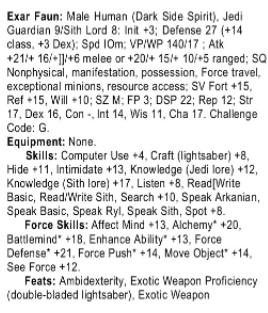
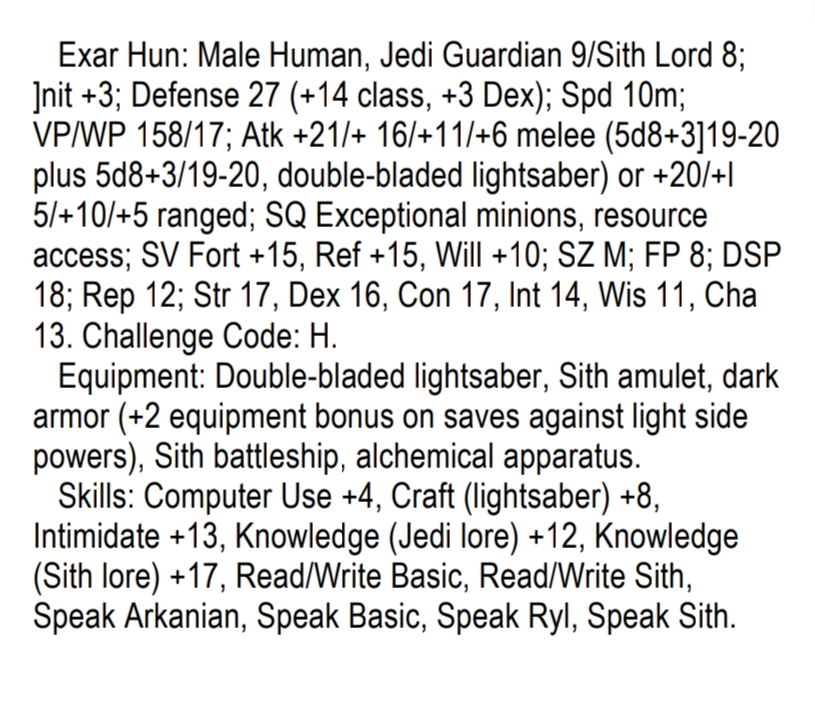
The Authorities:


The Source Material:
Sources from before The Sith War arc, which contains the ritual, all state the same thing and that is him desiring to restore his lost reserves of energy from when he was alive so that he can live again:
Jedi Academy Sourcebook wrote:A few scant years later, Kun is brought sharply awake by the arrival of not one or two, but a dozen humans blazing with the power he needed to live again. Eagerly but cautiously, Kun observes each arrival, probing for weaknesses and the power he needs to restore his lost reserves of energy. For a time, he is able to subside by feeding on their residual energy, but soon he will need worshippers if he is to grow more active. With a nucleus of followers to provide him energy-providing anger and fear, Kun will have enough power to escape his exile and take on human form.
Exar Kun, Jedi Academy Trilogy Vol.2: Dark Apprentice wrote:"I want your anger, Gantoris. I want you to open the doorways of power. I am barred from the physical plane--but with enough other Sith followers, I could be at peace. I could even live again."
Sources such as The Essential Guide to the Force and Star Wars Galaxies also make it obvious that Kun was far from his upper limit, though clearly still had a lot of power left when relative to others:
- Corran Horn, Jedi vs Sith The Essential Guide to the Force. wrote:The only vaguely positive explanation for Exar Kun's dormancy that I could come up with was that his effort to draw the Suncrusher from Yavin and to down Luke had tired him out. I had no way to determine how powerful Exar Kun could be, but it struck me as possible that he'd expended a lot of energy to defeat a Jedi Master.
Domain of Evil, Star Wars Galaxies wrote:Exar Kun's essence remains trapped in his temple on Yavin 4. The Dark Lord of the Sith is far from powerless, and he bides his time in his domain, waiting for just the right opportunity to return.
Kevin J. Anderson and Tom Veitch actively cooperated so that the Dark Empire, Tales of the Jedi and Jedi Academy series were interwoven. Kevin J. Anderson even wrote the last six issues of the Dark Lords of the Sith series of Tales of the Jedi:
Kevin J. Anderson wrote:I got to working with Tom Veitch in order to make his Dark Empire comics series and my Star Wars novels tie together. My Jedi Academy Trilogy has a character, Exar Kun, who is a spirit from 4,000 years in the past and Tom was writing his Tales of the Jedi series set 4,000 years in the past. I asked him if I could write a guest issue telling the origin of Exar Kun, but Tom was thinking much bigger. He said, "Let's do this grand epic where we pit your guy against my characters in a big war that wrecks half the galaxy." That certainly sounded more fun than a guest issue. So I worked with him on Dark Lords of the Sith. We plotted the whole 12 issues together, even though I wrote the last six of them solo.
LINK: https://www.darkhorse.com/Interviews/667/Kevin-J-Anderson
Tom Veitch wrote:Q: In Dark Empire’s appendixes, part of the history of Ulic Qel Droma and Nomi Sunrider was told. It also showed the relationship of certain characters like Vodo Baas and Vima Da Boda with the Tales of the Jedi saga, which helped to give more cohesion to the Star Wars universe over those years. Had you already thought ahead about telling this story in comics?
TOM: The TALES OF THE JEDI series was under development while I was working on DARK EMPIRE, so it was easy to build inner connections. As a matter of fact, I proposed Tales of the Jedi to LucasArts right after the first issue of Dark Empire came out. The lady at LucasArts said "George will never go for this." But he loved it and once again gave us carte blanche.
LINK: http://starwarsinterviews1.blogspot.com/2020/07/exclusive-16-pages-of-dark-empire.html
Exar Kun is able to bind Luke Skywalker's soul to his existence, and is close to being powerful enough to claim him entirely:

Jedi Academy Trilogy Vol.III: Champions of the Force wrote:With a wheezing cough as he expelled long-trapped air from his lungs and drew in a fresh breath, Master Skywalker groaned and sat up on the stone platform.
"You've-done it!" Luke said, gaining strength from each lungful of cool, clean air. The new Jedi Knights surged toward him. "You have broken the bonds."
Jacen Solo, The Complete Star Wars Encyclopedia wrote:Later, Jacen joined forces with the other Jedi students in destroying Exar Kun's spirit forever and freeing Luke's spirit.
Kirana Ti, The Complete Star Wars Encyclopedia wrote:Later she became one of Skywalker's Jedi candidates and joined his other Jedi students on Yavin IV in defeating the spirit of Dark Lord Exar Kun, protecting Luke's body and freeing his spirit.
Luke Skywalker states that he actually became more powerful when becoming a Force spirit in his fight against Exar Kun:
New Rebellion wrote:Luke was raising his lightsaber, his heart pounding. He was reaching out with the Force, going back to the place he had gone when he first fought Exar Kun. He would be out of his body but protected within the Force. Just as Ben had done in his battle with Darth Vader.
Luke would come back even stronger, and he would guide Leia to defeat Kueller.
After Exar Kun's defeat, this is stated about Luke Skywalker:
Jedi Academy Trilogy Vol.III: Champions of the Force wrote:Luke clapped him on the back and smiled with dark-ringed eyes that shone with an inner brightness stronger than ever before. As he conquered each seemingly insurmountable obstacle, Luke's Jedi powers grew greater and greater- but, like Obi-Wan Kenobi and Yoda, a Jedi Master learned to use his powers even less, relying on wits instead of showmanship.
So Luke Skywalker is definitively in his absolute prime of power by this point, and yet we know his powers alone aren't enough to defeat Exar Kun's spirit:
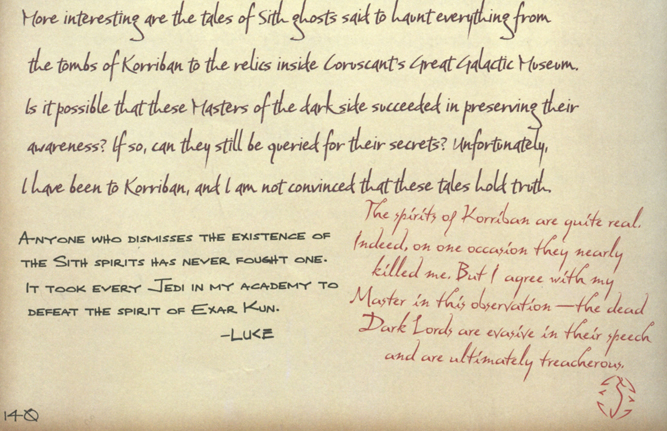

Galaxy Magazine 8: The Deadly Dozen wrote:Millennia later, Kun’s spirit was freed by Kyp Durron, a Jedi student of Luke Skywalker. It would take the power of a group of Jedi students and Skywalker himself to defeat Kun and banish his spirit.
Luke himself specifically remembers the power 'flowing' through him during the bond with the others:
Children of the Jedi wrote:"Yes,” said Luke, remembering the power of the Force flowing into him as he’d battled Exar Kun for the final time,
So it takes Luke Skywalker in a form more powerful than normal, a Kyle Katarn who I've already established is arguably Return of the Jedi Emperor Palpatine levels of powerful in his own right, the spirit of Vodo-Siosk Baas, and a dozen Jedi who are all Knighted and beyond Luke's teaches by this point, all combining their power to defeat the spirit of Exar Kun.
Who is in his weakest state and had been goaded into a trap he wasn't ready for:
Jedi Academy Sourcebook wrote:She supposes that the students have a chance of defeating him, since Kun no longer has his servants to draw power from, he[Streen] is his only source.
I, Jedi wrote:Gantoris was on Yavin just over two weeks before his death, which could be seen as a cap to one cycle. Kyp arrived a week or so later and was here just over a week before he stole the Headhunter. Inside a week he came back and dropped Luke like a hot rock. By rights the dark man should have been back preying on us within days after Luke's defeat, but he wasn't, and this frightened me.
*
The only vaguely positive explanation for Exar Kun's dormancy that I could come up with was that his effort to draw the Sun Crusher from Yavin and to down Luke had tired him out. I had no way to determine how powerful Exar Kun could be, but it struck me as possible that he'd expended a lot of energy to defeat a Jedi Master. There was no telling how long it would take for him to recover.
*
"I know I can buy us time, but not much. At the rate he recovers, Kun should be ready for something tomorrow, maybe tonight."
*
My thinking was that Kun, still taxed from his having funneled enough power through Streen to create that cyclone, would take the chance at having Streen use the Headhunter to kill Luke.
*
"Council of war, good. Right now, not good." I sighed. "Kun has been defeated tonight. He's not going to be coming back right away."
*
"Right. It will have to shine so brightly no shadow can withstand it." I looked around at all of them. "That's your job. When he comes for Luke again, you give him more light than he can ever handle."
*
"Not going to happen." I leaned forward, holding myself up by posting my arms on the table. "Up to this point, Exar Kun has acted on his own schedule. He's moved when he wants to move, done what he's wanted to do. Not anymore. Tomorrow evening, as night is coming on, we'll force him to act. He won't be ready, but he'll think he can still beat us. He'll be wrong."
*
I managed a weak smile. "Bait. Kun's heading into a trap. A big trap."
*
She weighed my words. "Any chance he can get out of it?"
*
"Shouldn't be able to. It really is over for him."
So when we get quotes such as Kevin J. Anderson writing this about the spirit of Exar Kun in his books:
Jedi Academy Trilogy Vol.III: Champions of the Force wrote:If Kyp could face this final test, Luke would know he'd passed through the fire of his testing-tempered by forces as dire and powerful as those Luke himself had endured.
It certainly follows then that the portrayals are intended on their part to reflect this, and they do. Everything from stats to material statements to author clarification from both Tom Veitch and Kevin J. Anderson; as well as common sense, makes it a concrete canonical fact that Exar Kun in Tales of the Jedi is more powerful than he is in Jedi Academy Trilogy.
People seem to believe that 'TOTJ Kun just doesn't have feats and accolades as good as JA Kun', thus indicating that it's not true, three things:
1.Absence of evidence is not evidence of absence, if he is stated to be better in Tales of the Jedi then he simply is, no arbitrary reasoning required.
2.This claim comes from the fact that living Kun is perceived to have not done as many impressive things, but in reality what people are actually stating is that because TOTJ Kun hasn't done things to Luke or Sheev calibers in his own time then he's not as good. Perhaps I need remind you, but the reason they aren't in his era is because they're not born for 3,900-4,000 years later. Kun is the absolute dominant force of his era, and he has no competition specifically because he's that much better than everyone else.
3.I don't even see how this can be held to be true:
3.A. Exar Kun in life has so much power that he's effecting the cosmic Force across the universe:
Cargo Bay, starwars.com wrote:In the remote reaches of the Star Wars universe, an ancient and deadly power has been reawakened by a foolish and arrogant young Jedi. He will begin a quest to become a Dark Lord of the Sith, and every galaxy will be threatened by his power.
Cargo Bay, starwars.com wrote:In the depths of galactic space, a foolish and arrogant young Jedi awakes an ancient, deadly power. This seductive evil will lead him down a path that will make him a Dark Lord of the Sith, and his darkling power will make the very galaxies tremble.
3.B. Exar Kun in life 'struck down' the light side of the Force with Sith magic:
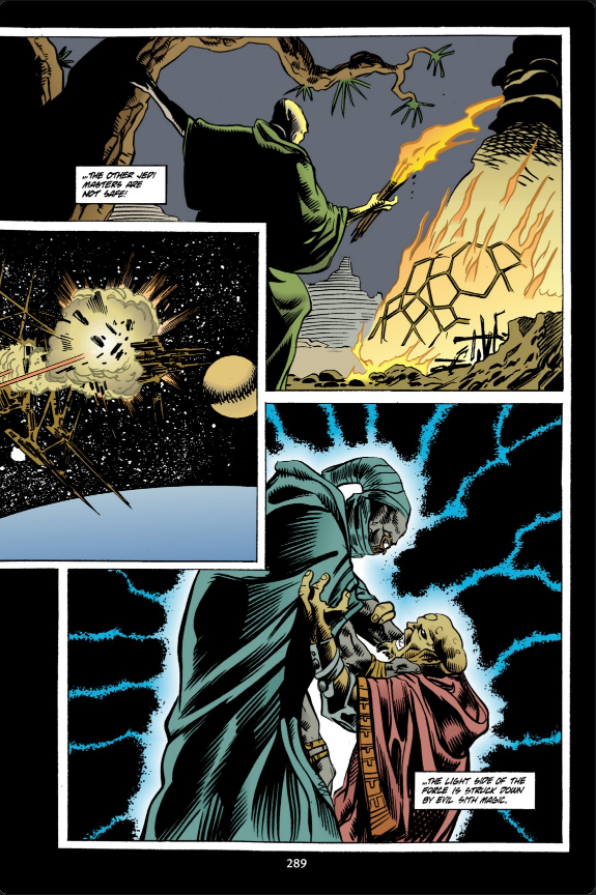
3.C. Exar Kun in life was going to grow more powerful on his own, than he achieved with the ritual energies:

Before we continue, we must add layers of context onto that last point, first of all we know Exar Kun used a great deal of his power to prevent massively greater destruction to his temples than would have been:
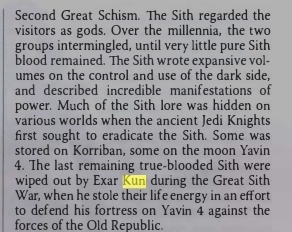
He also uses some of that power to encyst himself in the network of temples after he loses:
Exar Kun, Databank wrote:Finally, a joint Republic and Jedi taskforce came to Yavin 4 to capture Exar Kun. He knew he could not survive the attack, so he summoned his dark side energies and trapped his consciousness into the temples his Massassi warriors had built for him.
So the power that Exar Kun uses to actually defend himself from the strike, is not even close to the totality of the power he actually has.
But, what is also telling is the fact that he will actually become 'too great' for the Jedi to stop, that's something that happens regardless of ritual power, eventually. Now, this is where Exar Kun's power growth comes into play because really, his starting point in Tales of the Jedi is literally at most two years before the battle of Yavin four. On the grand scale of Exar Kun's power growth; he starts out as less powerful than the shade of Freedon Nadd and then becomes multiple times stronger than that by the time of Ulic's betrayal. It's stated in the comic that the time between Kun dueling Ulic and the beginning of the Sith War arc is merely six months, so it's arguable that the entire ordeal is a year at most. So, how far off is Exar Kun from this power?
Now, we know Exar Kun on his own didn't stand a chance against the combined Jedi Order as of that battle, how many fewer Jedi than that do we need to get before it starts to turn into a more even engagement? How much of the totality of the power he uses in the battle is from the drain and how much of it is his own, given he is in the first place capable of draining them? There's a lot of context to this, but the absolute of this comparison is as follows:
Tales of the Jedi Exar Kun is relative, to a certain degree, to a power that enormously dwarfs the power that it takes to destroy the spirit of the Exar Kun, demonstrably:
It is stated that the power used against the spirit of Exar Kun is far, far less than the power channeled through Dorsk 81 to fling the Star Destroyer fleet out of Yavin IV:
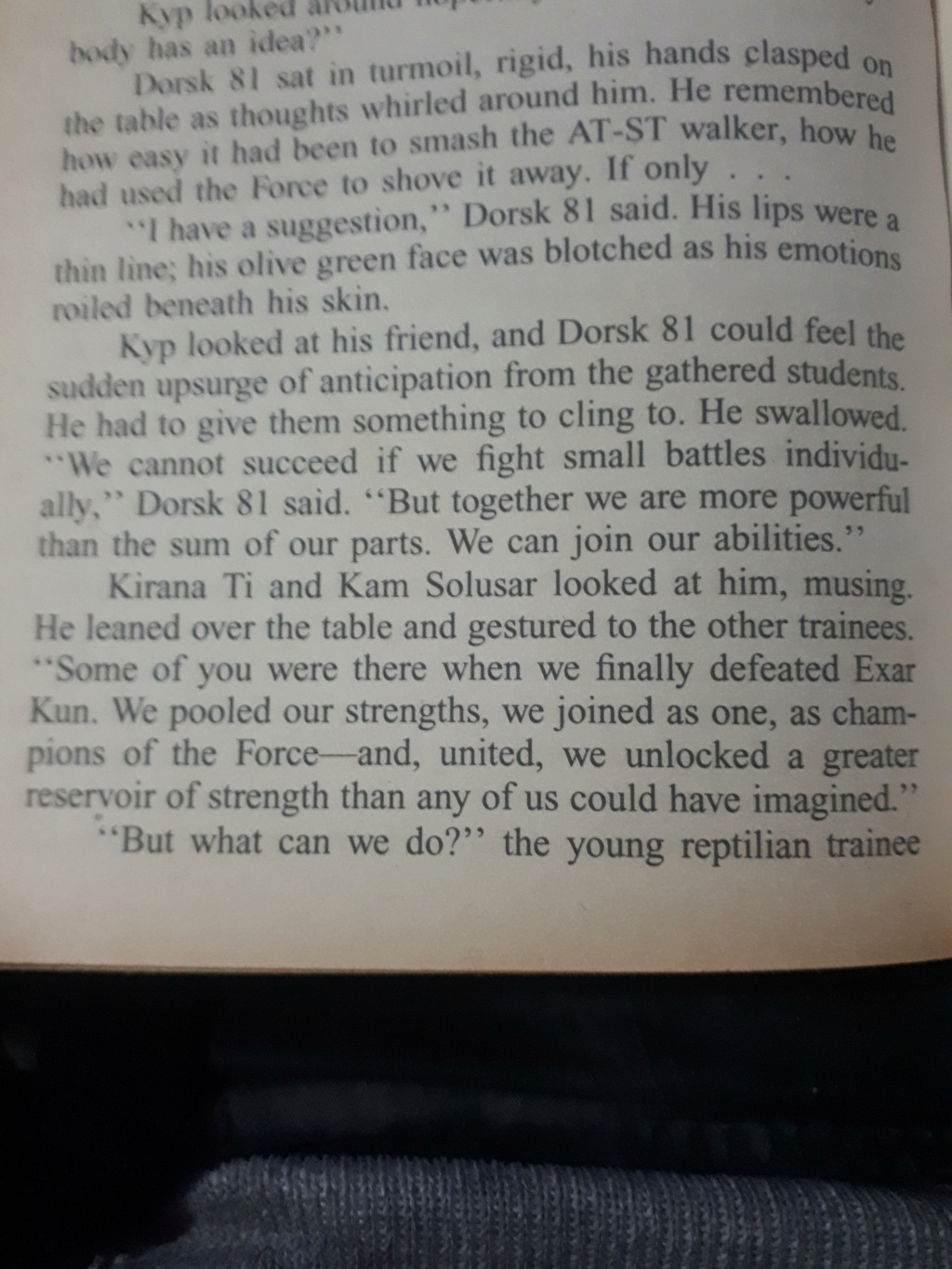
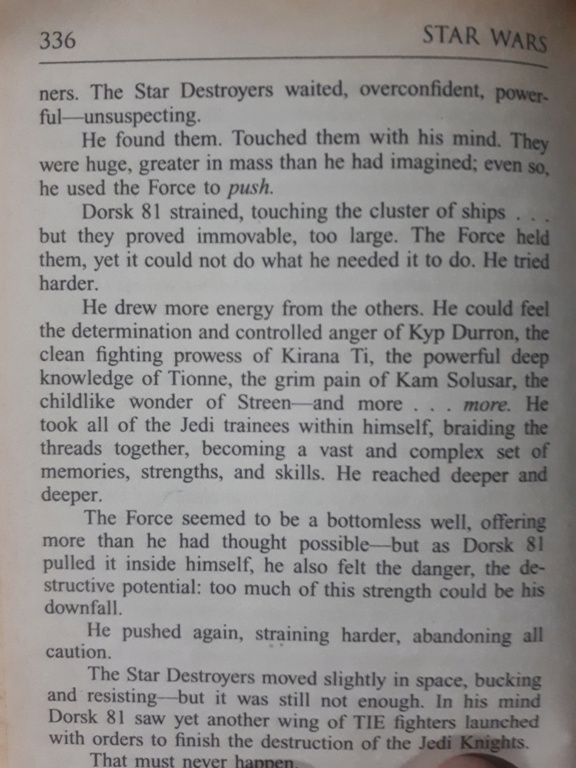
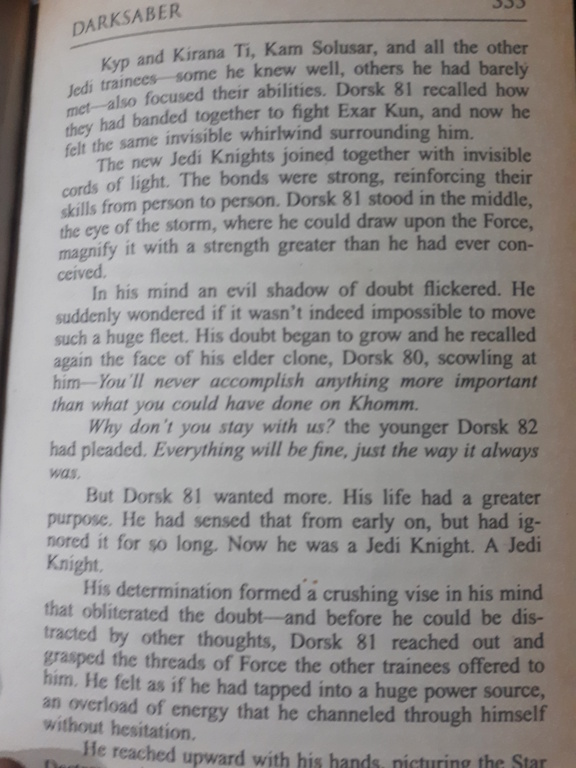
Noting that the lack of Luke Skywalker and Vodo-Siosk Baas in the bond with Dorsk 81 evidently isn't consequential in the least, it is outright stronger regardless. This indicates that the combined numbers both make up for and dwarf this initial base power discrepancy between individuals. This then obviously scales up enormously as pertains to the entire Jedi Order as faced by Exar Kun with the ritual energies:
I, Jedi wrote:Twelve half-trained apprentices and two toddlers planning to annihilate someone who had survived an onslaught by the combined might of the Jedi of his age sounded ridiculous on the surface of it.
I, Jedi wrote:I let Streen fill Kun with our resolve to unite and defeat him, but Kun's contempt for us came rolling back along the line like an echo. He had faced fleets of ships and all the known Jedi. He had slain his own master. His power was unrivaled. He had defeated our Master and beyond our resolve to fight, we had no operative plans and nothing with which to challenge him. We were snacks he would devour at his leisure, not morsels that might choke him.
Exar Kun, Jedi Academy Trilogy Vol.II: Dark Apprentice wrote:"Good! I am glad to see you have learned to respect me. Four thousand years ago the entire military fleet of the Old Republic and the combined forces of hundreds of Jedi Masters could not destroy me. You would certainly be unable to do so alone."
Vodo-Siosk Baas, Jedi Academy Trilogy Vol.II: Dark Apprentice wrote:"All the Jedi banded together and came to the jungle moon in a united front against the Sith stronghold Exar Kun had built. The allied Jedi combined their power into a massive annihilating strike."
So to be clear, the combined Jedi Order = an insane amount of >>> the Dorsk 81 conduit which is >>>> Jedi Academy conduit.
Now you can infer comparisons to the Luke, Leia & Anakin vs. Dark Emperor Sheev with the Jedi Academy conduit given everything I've said since the start, Tom Veitch has made his intent known about the power levels involved there:
TOM: At the time I sent in my original [Dark Empire] proposal, I didn’t quite know how the story would end, except that Luke and Leia would overpower the Emperor by joining their minds in the Force. Tim had a problem with that, of course. He said my idea was “an insult to the Star Wars philosophy”. He said that the idea that Luke and Leia would use mental power to destroy the Emperor was “completely and absolutely WRONG.” [his caps]
Q: Weird.
TOM: Well, I think he might have misunderstood what I wrote in the proposal, about “whole areas of the dark mind falling to the light side of the Force…” I also said that at that moment “everything Luke has learned about the dark side is transmuted and turned against the Emperor.”
LINK: http://starwarsinterviews1.blogspot.com/2020/07/exclusive-16-pages-of-dark-empire.html
Or you can just scale Kun unfathomably over Luke's current power in general, as I've highlighted in this very post, which is reflected by all of the much later accolades Kun's spirit gets, indicating that he is still stronger than Luke even by New Rebellion or the Hand of Thrawn duology.
So, to assert that Tales of the Jedi Exar Kun goes from this kind of power to being essentially trash next to Revenge of the Sith Darth Sidious, all because of supremacy quotes, is utterly wrong. Why is it utterly wrong? Simply put, you're asserting that quotes that never intended to retcon these power levels, can do so due to a 'power wall' given the number of relevant quotes. In other words, it isn't that deep and these guys didn't go into those quotes with some omniscient oversight into the grandiose EU with the idea to retcon establish power dynamics.
1: Whenever we actually see these power levels genuinely demonstrated in a direct comparison to one another, there isn't a single occasion in which Darth Sidious or Emperor Palpatine came out looking good against the ancient Sith; never mind the mightiest of their number in Exar Kun.
2. Perhaps just as indicatively, all of Exar Kun's quotes and scaling, directly address the Emperor, in fact they always have, he was conceived as such from the inception of his character. We know that exceptions can be made in hardline quotes, and this would be doubly true when concerning quotes that only imply a power comparison due to IU chronology. Your accolades don't save you because they demonstratably don't.
3.People make exceptions constantly, whenever they perceive that a quote cannot be true via direct contradiction or shouldn't apply due to merely being an implicit/indirect bind that only comes into effect due to IU chronology; Tenebrae > the Son or Abeloth, Sidious > the Son or Abeloth, or Bane > Tenebrae. When Exar Kun has such an enormous base of power to work from, itself woven deeply into the core of the Expanded Universe, then this is clearly one of those cases given the vast enormity of data contradicting it that you have to outright ignore to maintain the position you're holding.
If your case is that all the sources with Ritual Kun wank that came out before Palpatine supremacy quotes are just so obscure that none of the makers of the Palps supremacy quotes were aware of them or the ideas behind them… would that not undermine those quotes’ relevance in the first place?
Obscurity is no marker on validity, in fact the exact opposite is much more likely to be the case. You can't assume all the authors are going to be aware of everything, that doesn't assert anything but the fact they just haven't accounted for it.
Author Intent
Right, Wallace was the primary writer. I’d hazard a guess though that:
KJA read the WIP of the book he’s credited as coauthoring
He would have some say in the book he’s credited as coauthoring
Meaning (more likely) KJA didn’t take issue with the Palpatine GOAT quote at all, or (less likely) Wallace is so confident in Palpatine’s superiority that he simply vetoed KJA’s protests. Either way, great for Palps, less so for Kun.
Given that Kevin J. Anderson spends an entire trilogy saying Exar Kun's spirit trumps the Emperor, I think his stance on this was evident from the get-go. That he doesn't step on the feet of the opinion of the principle author of a project he was invited to, means effectively nothing. Rendering your initial 'gotcha' here completely worthless.
Sure. That’s one against many, from a source profoundly lacking in both officiality and in proximity to his officially released works (those also tend to favor a narrative of Palpatine being the GOAT).
So you mean to tell me, quotes that precede Exar Kun's existence by 3 whole years are somehow relevant to any of this? I mean, you do you.
 AncientPowerSuspect Hero | Level Four
AncientPowerSuspect Hero | Level Four
 Part Two
Part Two
November 30th 2023, 5:47 am
It would be exceedingly strange for anyone to be excepted from this rule, and Exar Kun has absolutely nothing going against it except for maybe one obscure supremacy quote against Palpatine’s many, including several more authoritative, several more visible, and several more recent.
To go deeper into Karness Muur, I want to establish something. The main reason people seem to think Reborn Krayt is so good is because of his resurrection, the biggest growth quote we have is the one from Krayt himself:
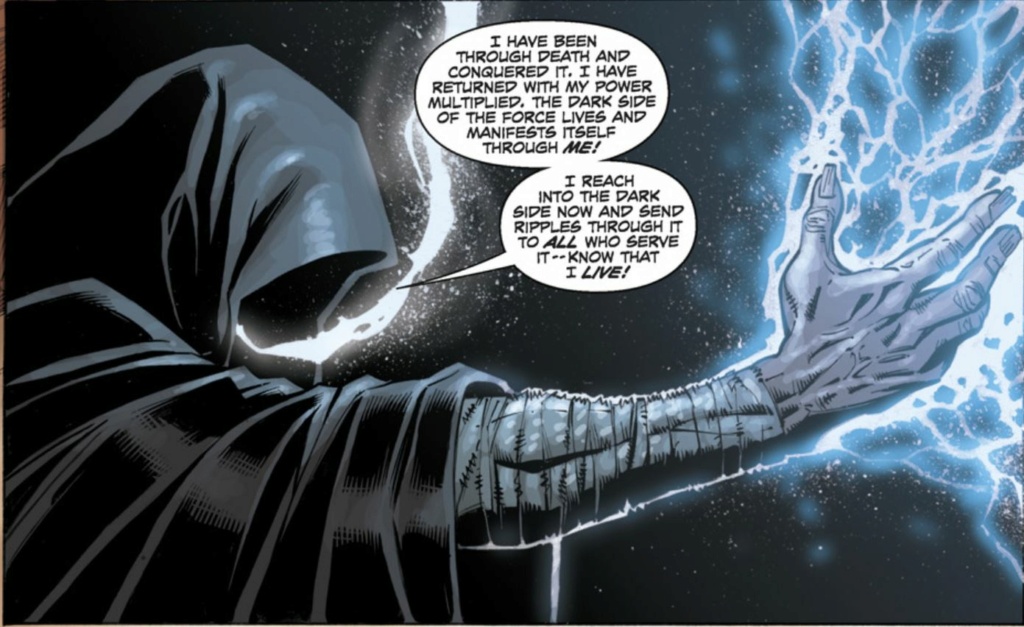
No other source corroborates that his power has increased this drastically, but this is largely irrelevant. Darth Krayt has always been seeking to restore his lost power:
Fall 2007 Comics, starwars.com wrote:In a reckless bid to right one of his many past wrongs, Cade Skywalker has become a prisoner of the Sith. It's a banner day for Emperor Darth Krayt, who hopes that Skywalker's abilities will complete Krayt's longtime quest to restore his own power.
So even if Krayt's power multiplying can be taken literally, this can largely be explained by two things:
1.His power has deteriorated with his body as he slowly succumbed to his physical destruction sustained from the Vong parasites.
He states this at the start of the series:
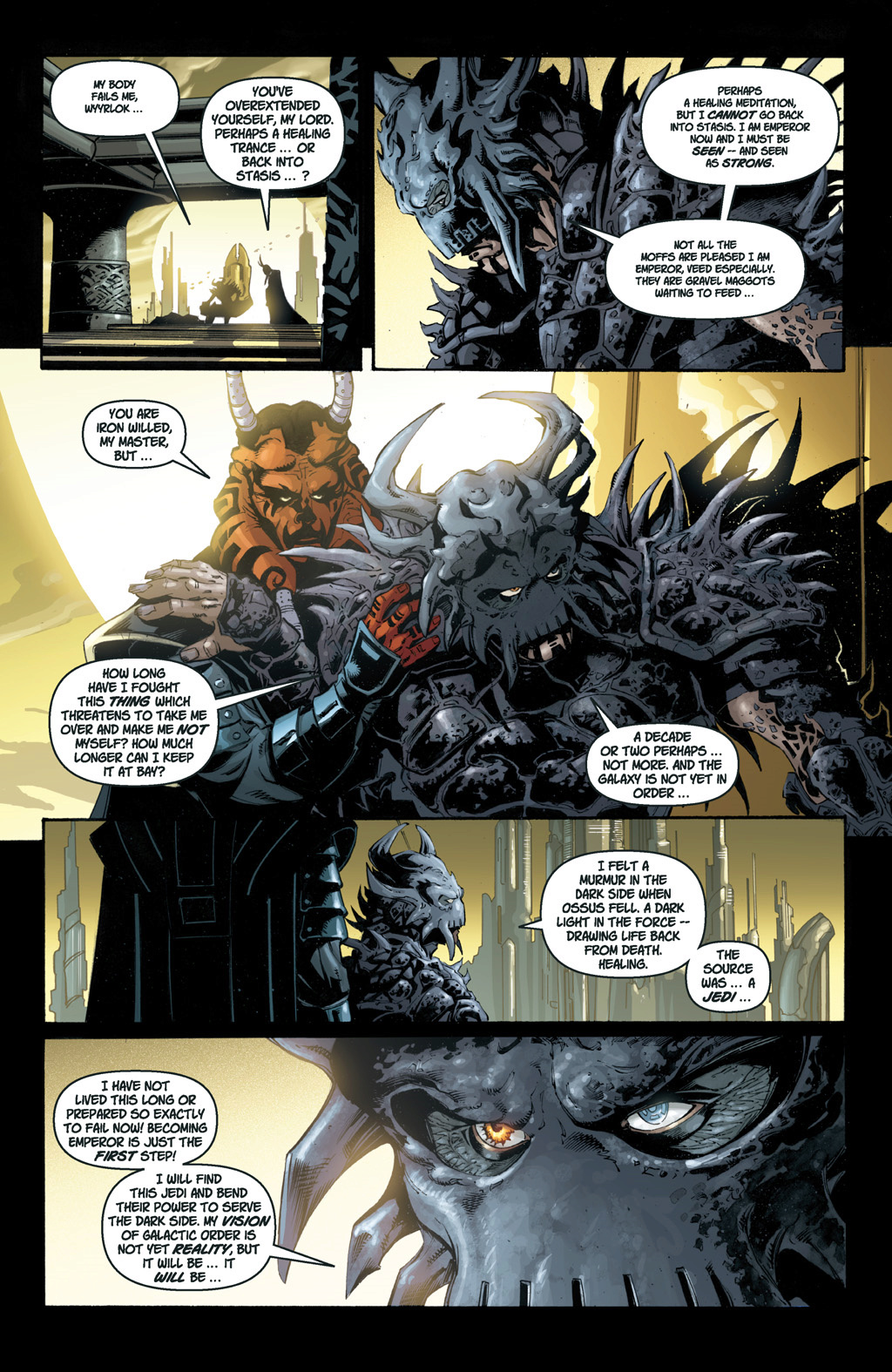
By #27, his body is so far gone that individual events are weakening him:
Star Wars: Legacy #27 wrote:“Cade’s escape has left the Emperor weakened”

He says this in Legacy: Vector:
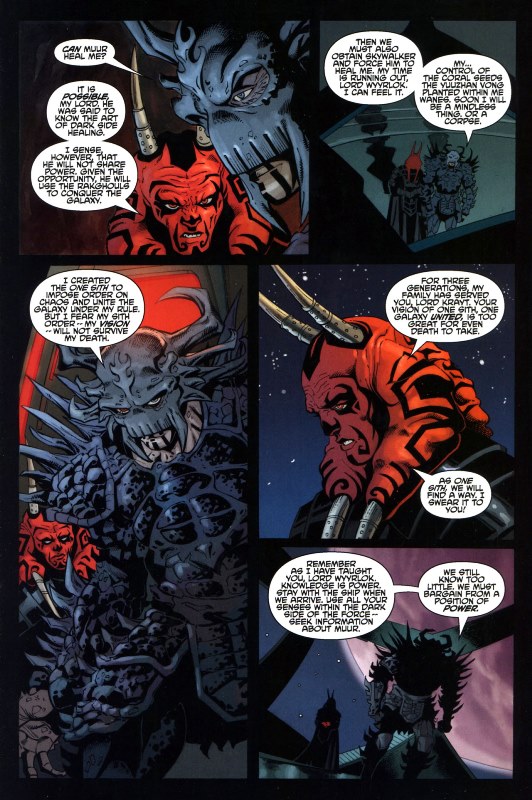
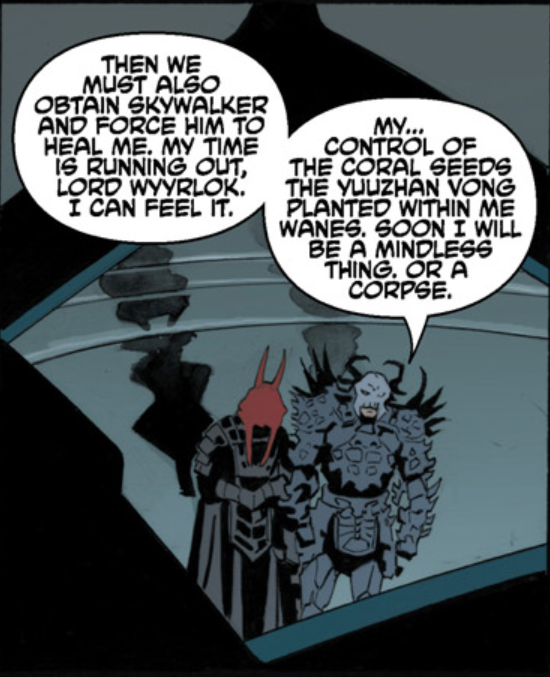
And Muur calls his body a 'failing husk':
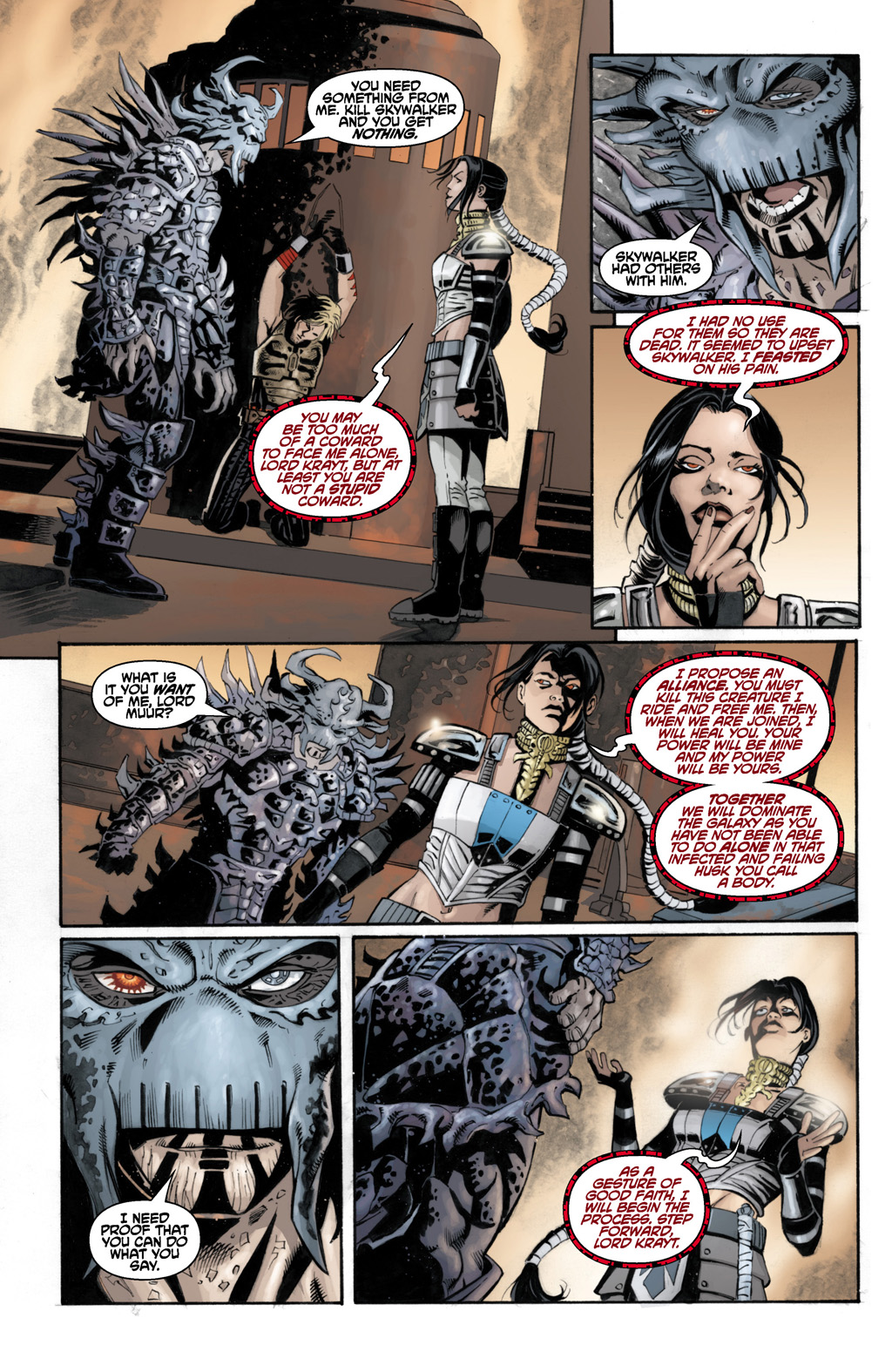
2.Krayt is resurrected which usually results in massive power returns. The slight problem with this is that he confirms he didn't in fact die. He drove his consciousness 'deep within myself' so he could heal his body fully using the technique that Karness Muur showed him, Dark Healing:
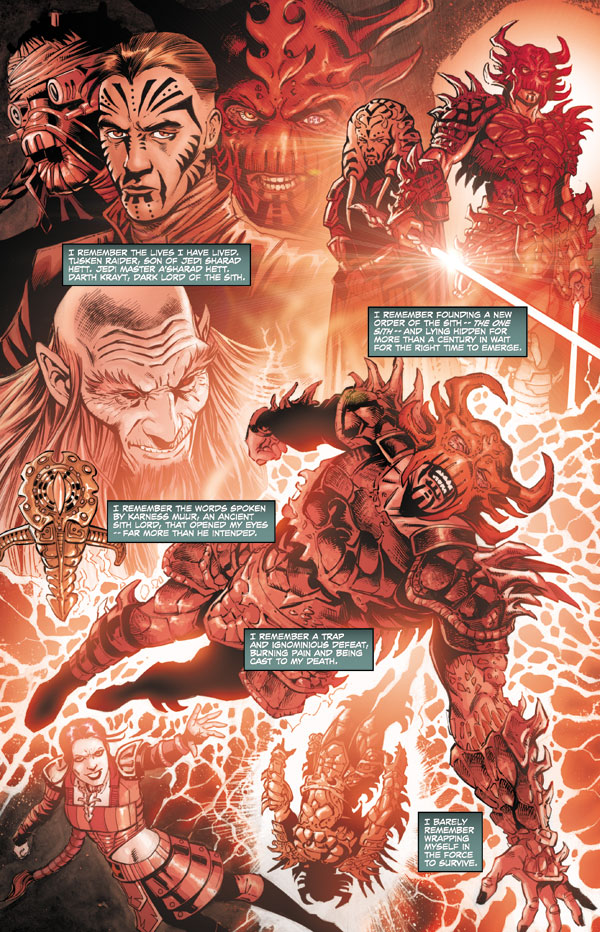
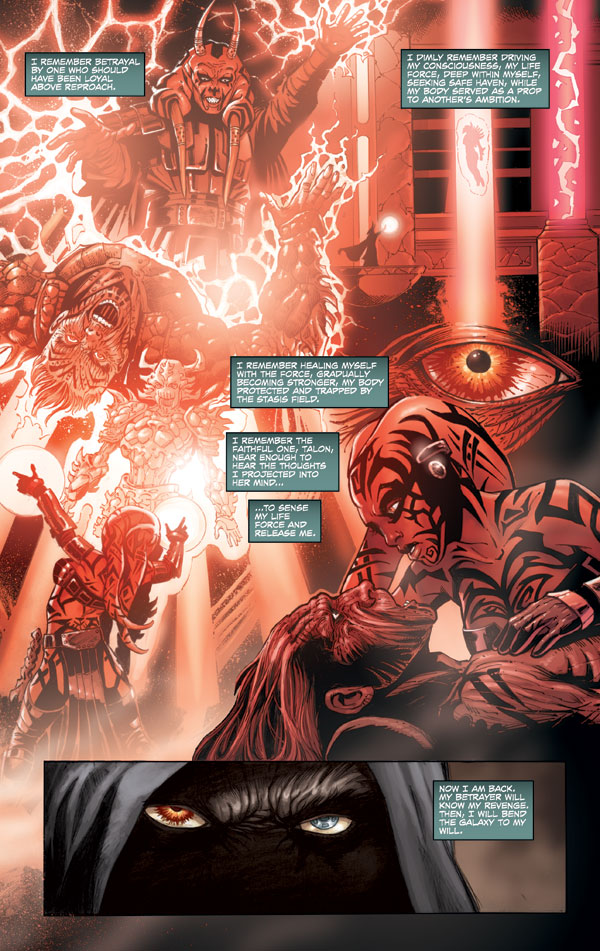
So in reality all that really happened was Krayt fulfilling his own dream with his own power, restoring his body to full health and thus his power, by essentially hiding his consciousness in his body. If you say Krayt is wrong, then you're also undermining his credibility when he claims his power has multiplied. So both are right or neither are right.
This is where we get some issues, first of all we know Karness Muur's spirit outshone the powers of Darth Krayt prior to him restoring his power:
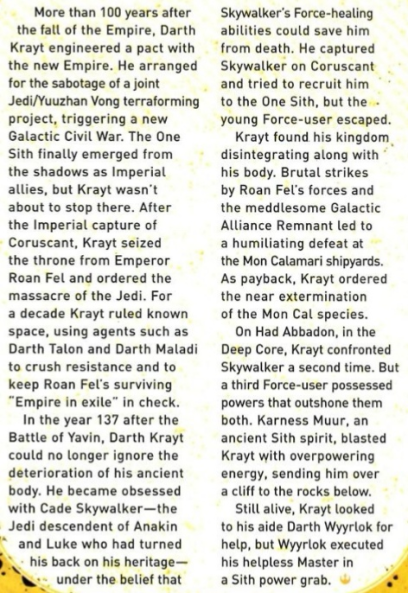
But per the author, John Ostrander:
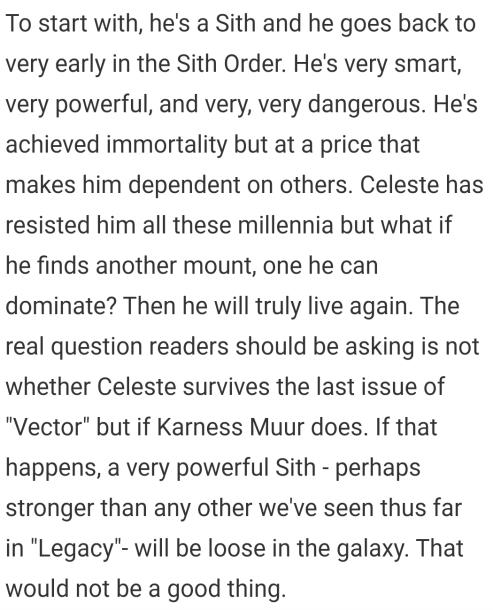
I'd describe this myself, but let's leave it to the words of the person who originally discovered this quote:
DarthAnt66 wrote:Points of note:
- Muur being "perhaps stronger" than Krayt doesn't necessarily mean he is, but it is indicative they're at least close enough for him to be a legitimate contender.
- Muur is "perhaps stronger" than "any other [Sith] we've seen thus far," meaning the "perhaps stronger" is referring to Krayt at the start of the series.
Link: https://www.suspectinsightforums.com/t2866-ostrander-karness-muur-vong-krayt?
The Krayt prior to his powers being so severely diminished is the Krayt that a 'truly live again' Muur might be superior to, which is the only truly stated reason for Krayt being so powerful again, something the Editor of Legacy specifies himself is because he's 'new and invigorated' not because of newfound power, the newfound power is just his original power being restored:
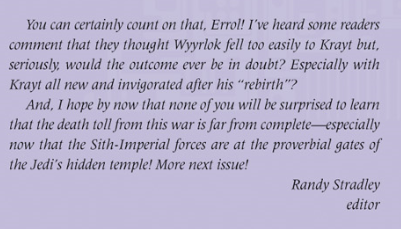
Krayt reborn's big power boon is because of the fact he has healed his body and restored his power, this is the entire plot point from the start of Legacy, Krayt is seeking a way to heal his body and restore his power. That has always been his goal and the entire plot of his hunt for Cade Skywalker. To assert that his power exceeds what he used to have, you'd need evidence suggesting this is the case, but every single one of the quotes describing Krayt's increase in power can all be adjusted to reference the restoration of his body and power. None of them actually refer to his rebirth itself making him more powerful, it's the restoration of his body to full health which restores his power.
In other words a Muur who has himself been restored by overwhelming and escaping Morne; something thus far prevented by the stasis she places herself in, as explained by Vector:
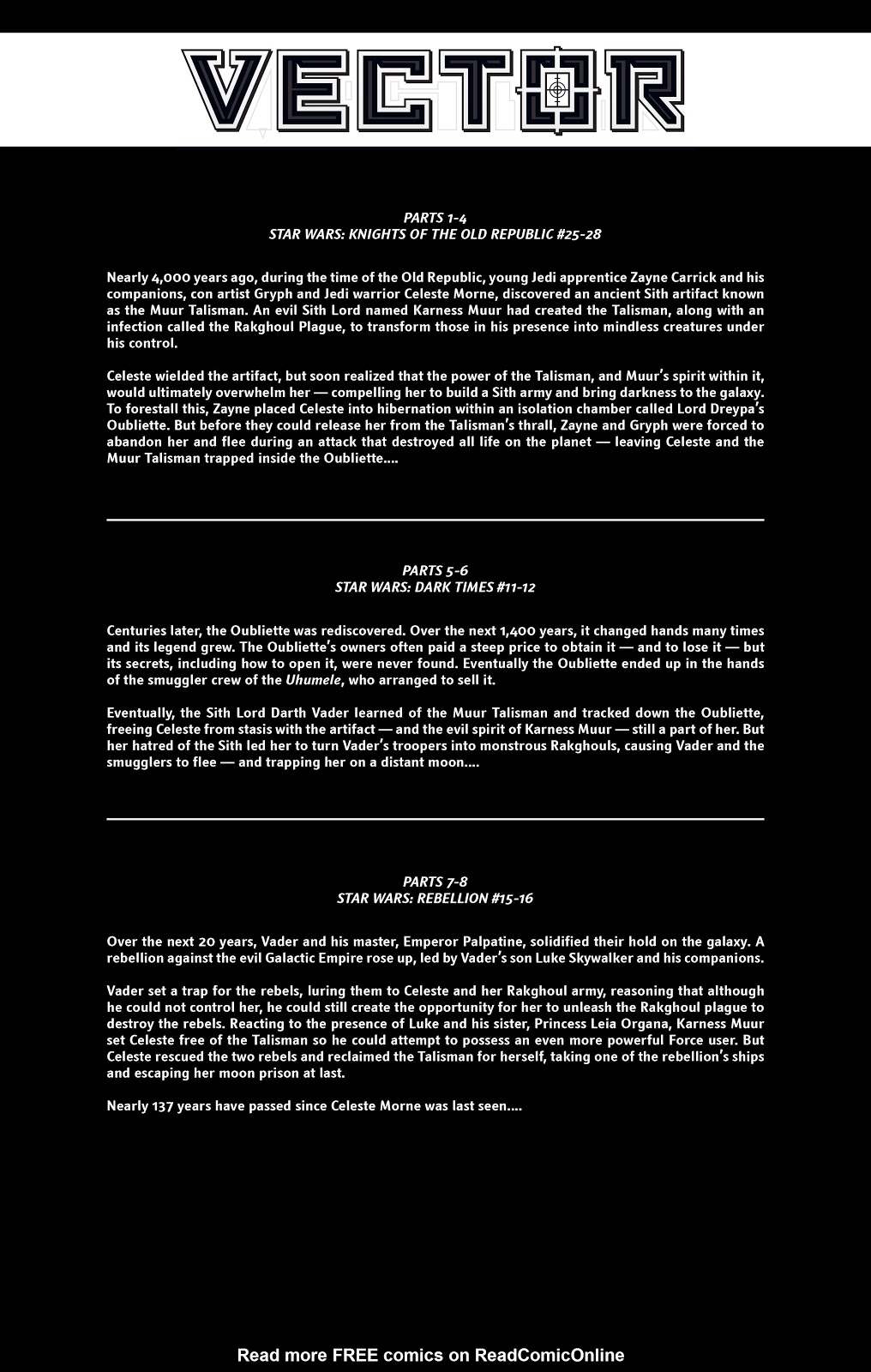
(Repeating to jog your memory)
And Muur goes as far as to call those millennia useless:

And which is confirmed in Legacy: Vector by both Muur and Morne:
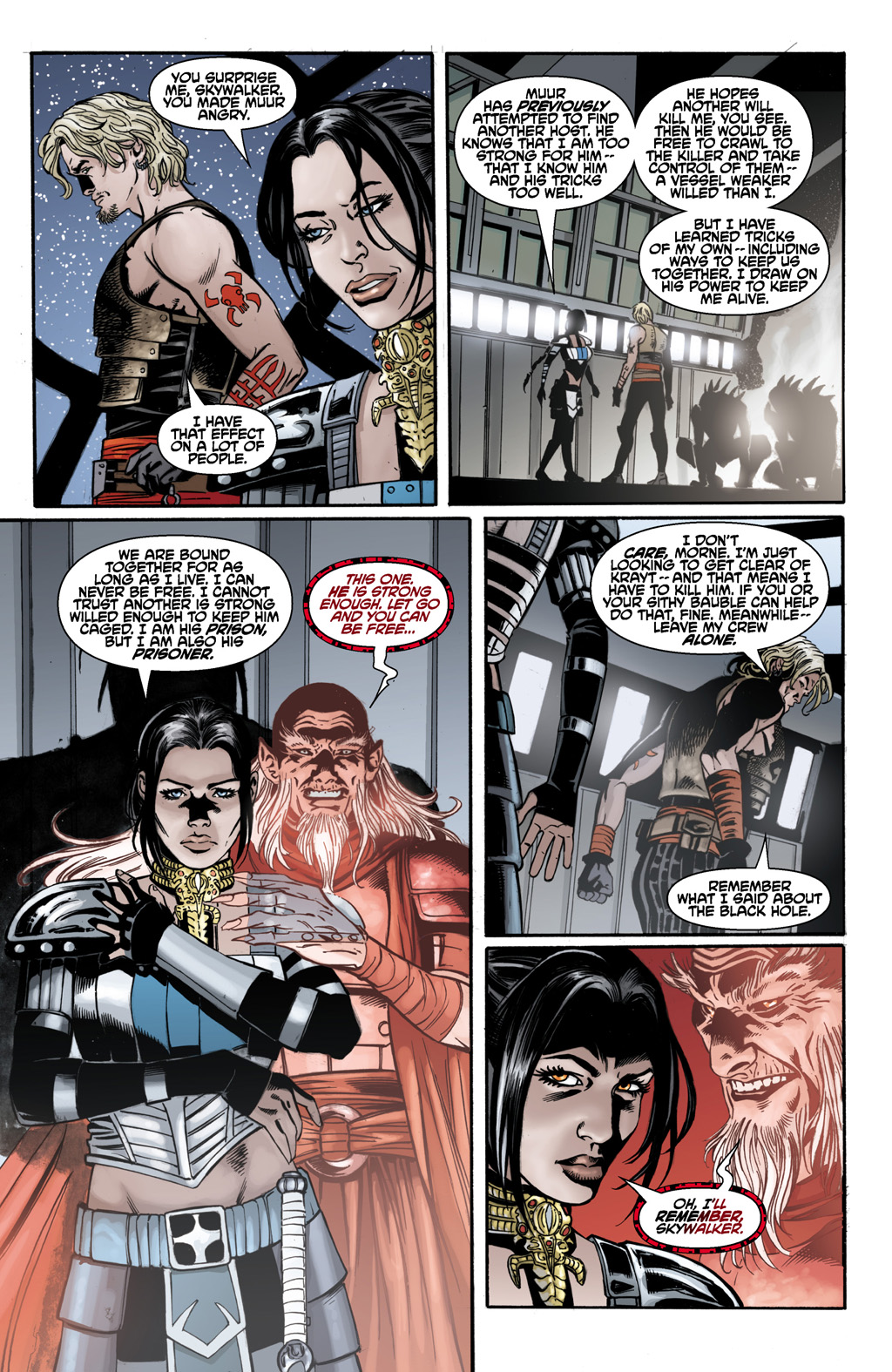
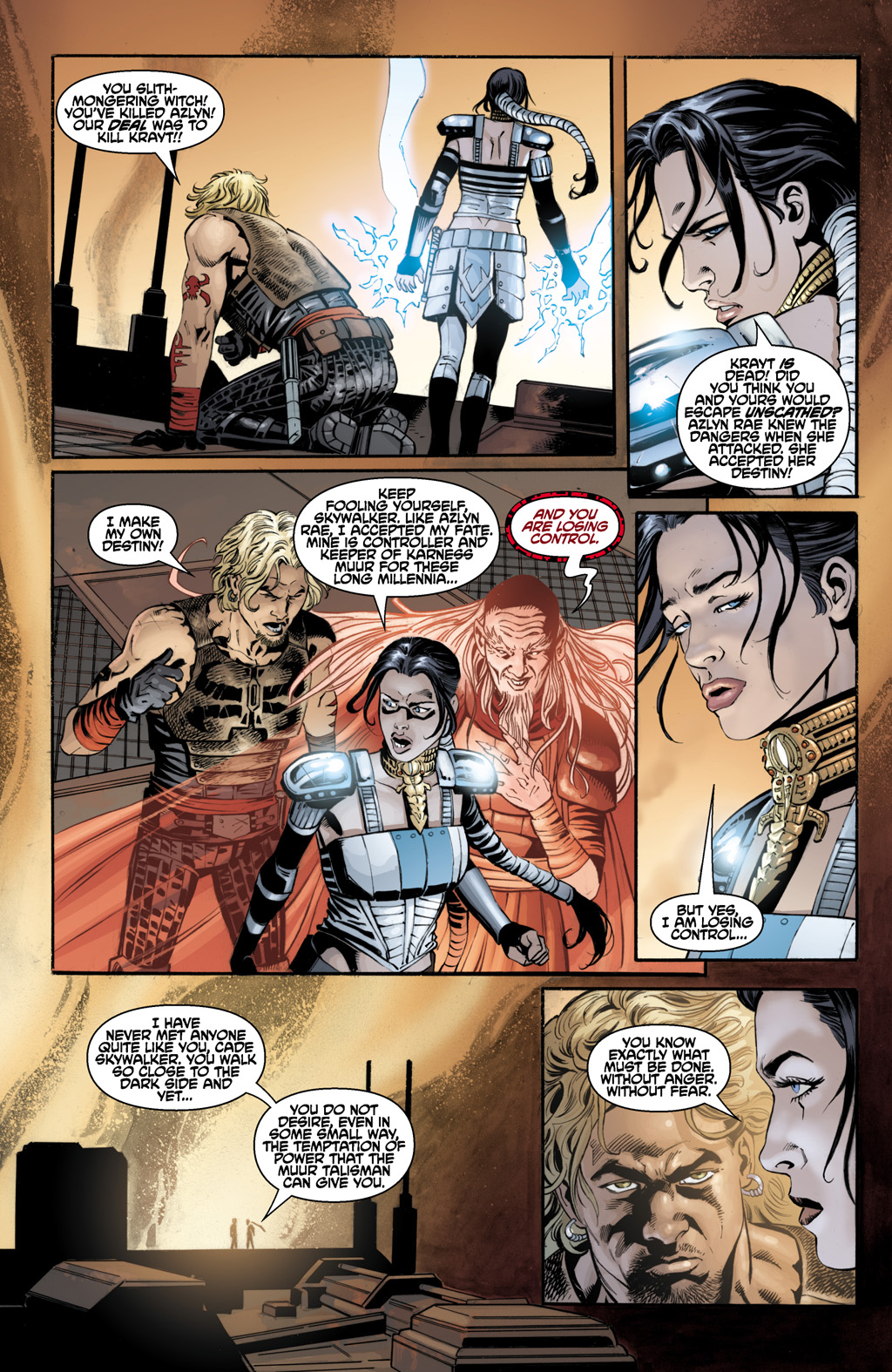
Would be able to surpass a restored Krayt. Our evidence for this is even more blatant given that Karness Muur estimates that he can heal and restore Krayt to power, and still control him as a new host, which he has no doubts about his ability to do:

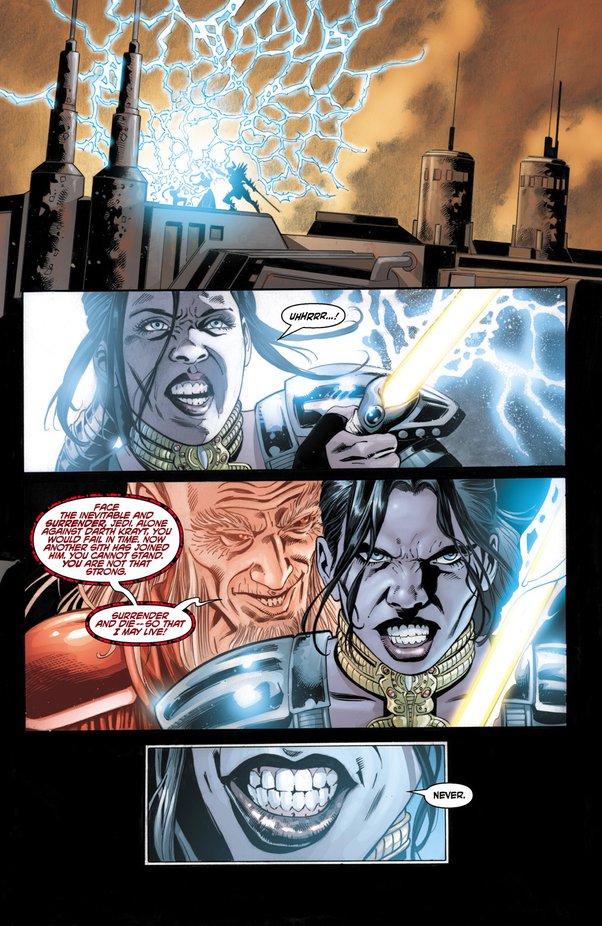
So we have an extremely solid basis for Karness Muur being at least on par with the strongest incarnations of Krayt there are, but he's far from the only Exile that Krayt has experience with. His Sith master was Xoxaan, Muur's contemporary:
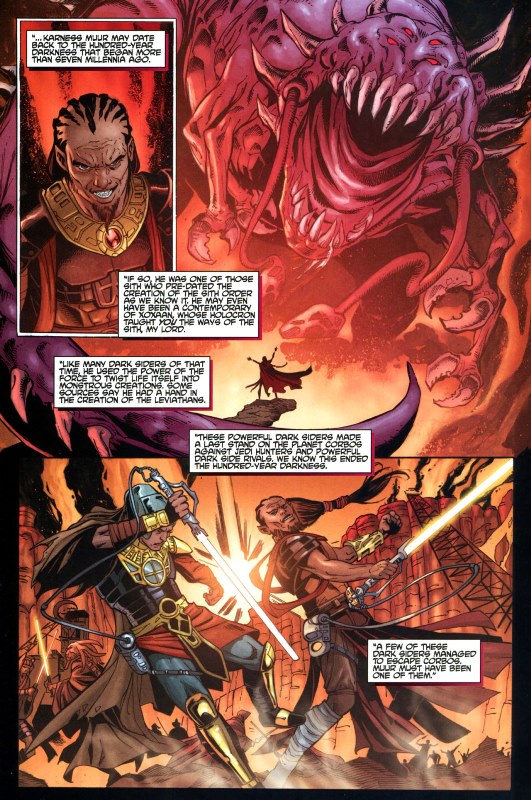
Which is important, because Krayt is already just incredibly strong, as A'sharad Hett, he's able to take down an enraged Anakin Skywalker after Attack of the Clones:
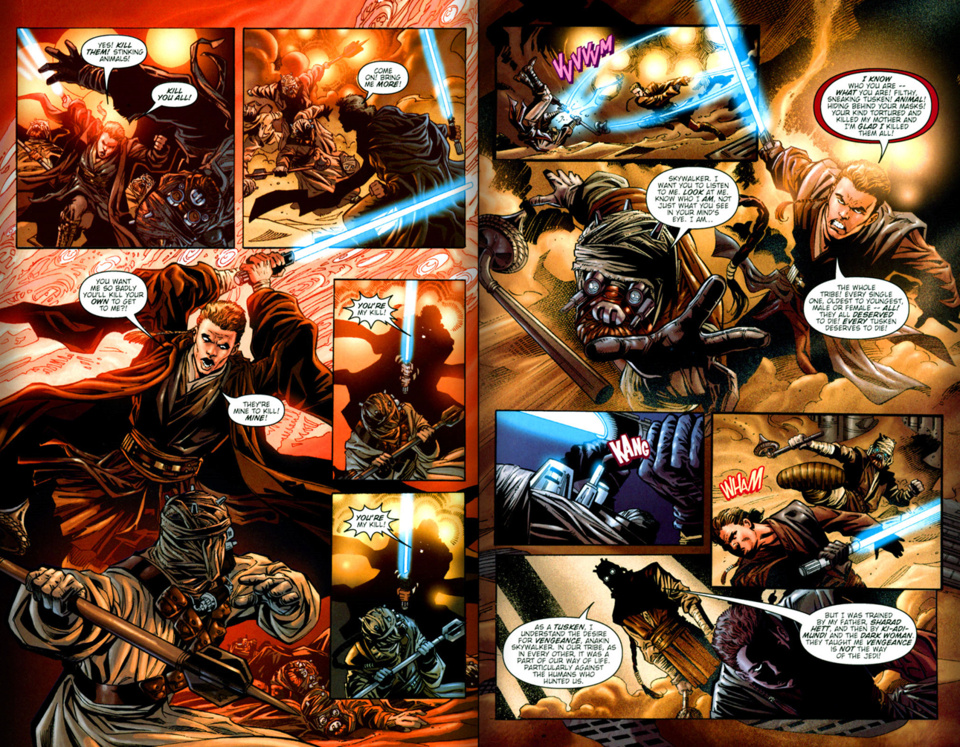
Noting Anakin Skywalker can already do this to Darth Tyranus in Attack of the Clones:
Attack of the Clones wrote:"I am a slow learner," Anakin replied coolly, and he came on then, so suddenly, so powerfully, his green blade whirling with such speed that he seemed almost encased in green light.
For the first time, Count Dooku lost his little confident smile. He had to work furiously to keep Anakin's blade at bay, dodging more than parrying. He tried to step out to the side, but stopped as if he had hit a wall, and his eyes widened a bit when he realized that this young Padawan, in the midst of that assault, had used the Force to block his exit.
"You have unusual powers, young Padawan," he sincerely congratulated. His little grin returned, and gradually Dooku put himself back on even footing with Anakin, trading thrust for slash and forcing Anakin to dodge and parry as often as he tried to strike.
Which fatigues Tyranus:
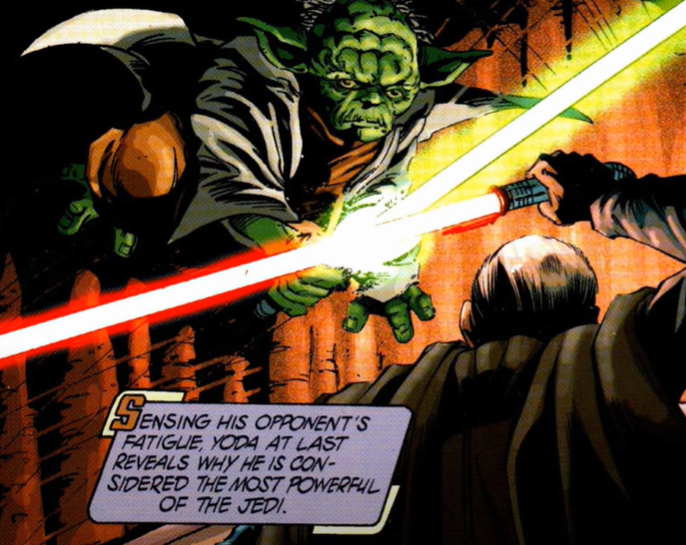
Who immediately thereafter goes on to equal Master Yoda:
George Lucas, Attack of the Clones DVD Commentary wrote:"You can't just go right into the sword fight, so I decided to go back to The Empire Strikes Back of throwing things at each other, even though I knew they were equal to each other, so it was a hopeless gesture and they would've figured that out in two seconds. But for the audience it's nice for them to go through this process of throwing everything around."
And a month afterward Anakin is far more powerful than that:
Official Star Wars Fact File 107 wrote:The ancient Jedi Master warned that the knowledge he would pass to Anakin would let him resist the effects of the Force-stripping Harvester and the Dark Reaper it activated, but would perhaps give him too much power.
Official Star Wars Fact File 107 wrote:However, Obi-Wan was growing uneasy with the power Anakin had wielded, and his Padawan seemed unwilling both to see the risks and, most worrying of all, to acknowledge Obi-Wan as his superior.
Ulic Qel-Droma to Anakin Skywalker, Star Wars The Clone Wars Video Game wrote:"Yes I can teach you to harness the power of the Force around you, making you immune to the Dark Reaper's effects."
Official Star Wars Fact File 107 wrote:Although the knowledge given to Anakin allowed him to destroy the Dark Reaper, Obi-Wan was uncomfortable with the power that his Padawan now wielded.
Star Wars The Clone Wars Prime Official Strategy Guide wrote:Follow the advice of Ulic Qel-Droma throughout this fight and you grow more powerful than you can imagine.
That's the Anakin he puts in the dirt. Fast word 5 years and Hett is then able to face Obi-Wan Kenobi two years after Revenge of the Sith and do incredibly well in his own right:
The Life and Legend of Obi-Wan Kenobi wrote:Ben did not know whether Hett was aware that Anakin Sky walker had become Darth Vader. But if Hett knew-as Qui-Gon's spirit claimed-that Anakin was responsible for killing the Tuskens who tortured his mother, Ben could only imagine what Hett might do if he discovered the existence of Anakin Skywalker's son. Ben suspected that Hett knew nothing about Luke, if only because Luke was still alive. If Hett's sole purpose on Tatooine had been to kill Luke, Luke would probably be dead already. Now, as Hett approached, Ben ban-ished all thoughts of Anakin and Luke from his mind.
Hett stopped in front of Ben, standing so close that Ben had to be careful not to inhale too deeply, for the stench of Hett's filthy robes and wrappings was almost overwhelming. Gazing into the red lenses of the Tusken's goggles, Ben said, "Master Hett."
"The Force be with you, Master Kenobi," replied Hett, his voice remarkably calm. "So, you too survived Order 66. I thought I was alone. What brings you to Tatooine, let alone these trackless wastes?"
"You do, Master Hett," Ben said without hesitation. Keeping his eyes fixed on Hett's goggles, he continued, "You lead these Tuskens as their warlord. Not something a Jedi should do. "
"Do not lecture me, Obi-Wan," Hett replied, still calm and without any hint of threat. "We were both generals in the Clone Wars, 'warlords' for a republic that turned on us. " Hett shifted his feet slightly and turned to look past Ben and let his gaze travel across the moisture farm. "The Tuskens have been hunted and killed by both settlers and farmers. Jedi defend those who need help. Sometimes you defend life by taking the life of the aggressor."
"Past mistakes do not justify current ones," Ben said, not letting his eyes stray from Hett. "The danger is in becoming what you fight. It was the trap that the Jedi fell into. It is the trap that takes you now. It must stop. You must see that, A'Sharad Hett."
"I do not," Hett replied grimly. "I was raised to man-hood amongst Tuskens by my father, Sharad Hett, the greatest Jedi of his age. He taught me to think and act as a Tusken." He remained facing the farm but gestured to the mounted Tuskens, and raised his voice as he said, "These are my people! Will the settlers stop killing Tuskens?"
Ben did not answer. He believed that the Tuskens could kill every settler on Tatooine and their hunger for violence would still be unsatisfied.
Taking Ben's silence as a negative response, Hett said, "Then blood calls for blood! The settlers will be forced to abandon the land . . . or be buried beneath it!"
"I cannot permit that," Ben said as he drew his lightsaber. "You were a great Jedi, Hett, and the son of a great Jedi, but you have given yourself over to revenge. It stops here." Ben ignited his lightsaber.
"You will have a Jedi funeral, Master Kenobi," Hett said. "That I promise."
Hett's hands dropped to his belt and the two light-sabers practically leapt into his gloved hands. He ignited both weapons at once, unleashing their identical green energy beams. He swung fast with the lightsaber in his right hand but Ben blocked it. The lightsabers sizzled loudly as they clashed.
It was fortunate for Ben that he had continued his Jedi exercises on Tatooine, that he had not allowed his reflexes to become dull. He did not think about how long it had been since he had last used his lightsaber in combat. Nor did he consider that he was older than Hett by at least a decade, or Hett's considerable skills with his own weapons, and that the Tusken was far more experi-enced at fighting in the desert. Ben knew that any such thoughts would probably only get him killed.
As prepared as Ben was for many things, he was not ready to die. Not yet. Not today.
Hett brought his other lightsaber in at a sharp angle, forcing Ben to lurch back. Ben gripped his own weapon with both hands as he swung at Hett's legs, but Hett blocked the swipe. There was another loud sizzle as the blades dragged across each other.
Ben gasped as Hett launched a powerful kick to his midriff. The kick knocked Ben off his feet, and as he fell back through the air, Hett hurled one of his lightsabers at Ben's body. Ben clung tight to his own lightsaber as he twisted his body in midair to avoid being struck by the spinning blade of Hett's weapon. The moment Hett's lightsaber whipped past Ben's head, Hett used the Force to retrieve it, drawing it back to his waiting left hand.
As Hett caught the lightsaber, Ben rolled up from the ground and swung out again. Hett blocked the strike with his right lightsaber, then threw his left arm forward to smash his other lightsaber's handle into Ben's jaw .
Ben ignored the painful jolt to his head and reflex-ively brought his blade up high, forcing Hett to block the blow with his right lightsaber and leaving his own midsection briefly exposed. Before Hett could strike with his other lightsaber, Ben kicked him hard in the stomach.
Hett grunted, but he didn't go down. He lashed out again at Ben, kicking up sand as he moved in for the kill. Not one of the mounted Tuskens so much as flinched as they watched the duel, nor did they rally for their chief. They merely watched in silence, waiting for the outcome.
Ben blocked each blow, but he wasn't doing it with ease. Hett was far more experienced at fighting on the sand and in the desert heat. Ben knew that his opponent would never surrender, let alone withdraw. As much as he hoped to avoid killing Hett, he also knew that they couldn't keep fighting indefinitely.
But in the end, Ben knew he wasn't fighting for his own life. He was fighting for Luke's .
Quickly raising his left hand, Ben used the Force to push out at Hett, shoving him back through the air as Ben's lightsaber swept up and through Hett's right arm. Hett shouted as his arm fell away from his body. As Hett stumbled back, Ben used the Force to tear Hett's other lightsaber from his left hand's grip. Both of Hett's lightsabers deactivated as they sailed past Ben and landed in the sand behind him.
Hett crumpled to his knees. His tribesmen watched as Ben stepped forward, leaned down to grip the top of Hett's facemask, and then pulled the mask off his head.
Red: A'sharad Hett is able to tag Obi-Wan numerous times throughout their duel. Obi-Wan has not let his skills decrease in the time between then and Mustafar (less than two years) and knows that any distracting thoughts, be they about Anakin, Luke, the environment, his age or Hett's skill, would only get him killed.
Blue: An environmental disadvantage is assumed by Kenobi.
Orange: Kenobi is trying not to kill Hett.
Blue: Really isn't important here, given the following duel:
The Phantom Menace wrote:He carried a lightsaber of another make, and the weapon was cutting at the Jedi Master even before the attacker's feet had touched the ground. Qui-Gon, surprised by the other's quickness and ferocity, barely blocked the blow with his own weapon, the blades sliding apart with a harsh rasp. The attacker spun away in a whirl of dark clothing, then attacked anew, lightsaber slashing at his intended prey, face alight with a killing frenzy that promised no quarter.
Anakin was back on his feet, staring at them, clearly unable to decide what he should do. Fighting to hold his ground, Qui-Gon caught sight of him out of the corner of his eye.
"Annie! Get out of here!" he cried out.
His attacker closed with him again, forcing him back, striking at him from every angle. Even without knowing anything else, Qui-Gon knew this man was trained in the fighting arts of a Jedi, a skilled and dangerous adversary. Worse, he was younger, quicker, and stronger than Qui-Gon, and he was gaining ground rapidly. The Jedi Master blocked him again and again, but could not find an opening that would provide any chance of escape.
"Annie!" he screamed again, seeing the boy immobilized. "Get to the ship! Tell them to take off Go, go!"
Hammering at the demonic-faced attacker with renewed determination, Qui-Gon Jinn saw the boy at last begin to run.
They could see Qui-Gon Jinn now, engaged in battle with the dark-garbed, demonic figure. The combatants surged back and forth across the flats, lightsabers flashing brightly with each blow struck, sand and grit swirling in all directions. Qui-Gon's long hair streamed out behind him in sharp contrast to the smooth horned head of his adversary. The pilot Ric took the spacecraft toward them quickly, skimming the ground barely higher than a speeder bike, coming in from behind the attacker. Anakin held his breath as they closed on the fighters. Ric's hand slid over the control that would lower the ramp, easing it forward carefully.
"Stand by," he ordered, freezing them all in place as he swung the ship about.
The combatants disappeared in a fresh swirl of sand and the glare of Tatooine's twin suns. All eyes shifted quickly to the viewscreens, searching desperately.
One would think that if the sand was a major deciding factor in a duel then it'd be readily apparent, but in both duels the sand is not at all relevant. The most Hett does is kick sand up without even intending to.
Orange: This is likely the part where people would point out that Kenobi was not aiming to kill Hett, so he's fighting on the defensive. Obi-Wan Kenobi is fighting defensively. Kenobi was always going to be fighting defensively, and it's this part that gets important:
Revenge of the Sith wrote:Kenobi's Master had been Qui-Gon Jinn, Dooku's own Padawan; Dooku had fenced Qui-Gon thousands of times, and he knew every weakness of the Ataru form, with its ridiculous acrobatics. He drove a series of flashing thrusts toward Kenobi's legs to draw the Jedi Master into a flipping overhead leap so that Dooku could burn through his spine from kidneys to shoulder blades-and this image, this plan, was so clear in Dooku's mind that he almost failed to notice that Kenobi met every one of his thrusts without so much as moving his feet, staying perfectly centered, perfectly balanced, blade never moving a millimeter more than was necessary, deflecting without effort, riposting with flickering strikes and stabs swifter than the tongue of a Garollian ghost viper, and when Dooku felt Skywalker regain his feet and stride once more toward his back, he finally registered the source of that blinding defensive velocity Kenobi had used a moment ago, and only then, belatedly, did he understand that Kenobi's Ataru and Shii-Cho had been ploys, as well.
Kenobi had become a master of Soresu.
Dooku found himself having a sudden, unexpected, overpowering, and entirely distressing bad feeling about this . . .
His farce had suddenly, inexplicably, spun from humorous to deadly serious and was tumbling rapidly toward terrifying. Realization burst through Dooku's consciousness like the blossoming fireballs of dying ships outside: this pair of Jedi fools had somehow managed to become entirely dangerous.
These clowns might-just possibly-actually be able to beat him.
No sense taking chances; even his Master would agree with that. Lord Sidious could come up with a new plan more easily than a new apprentice.
He gathered the Force once more in a single indrawn breath that summoned power from throughout the universe; the slightest whipcrack of that power, negligent as a flick of his wrist, sent Kenobi flying backward to crash hard against the wall, but Dooku didn't have time to enjoy it.
A'sharad Hett lands more blows on Obi-Wan Kenobi than Darth Tyranus could. This is not an alien idea, of course, as Jan Duursema, who helped author the Republic and Legacy series of comics suggests that Darth Krayt can definitely defeat Darth Tyranus:

Hett only gets much more powerful after the fact, after spending his time in the Embrace of Pain. Then Hett knelt at Xoxaan's feet for twenty years henceforth to become Darth Krayt:
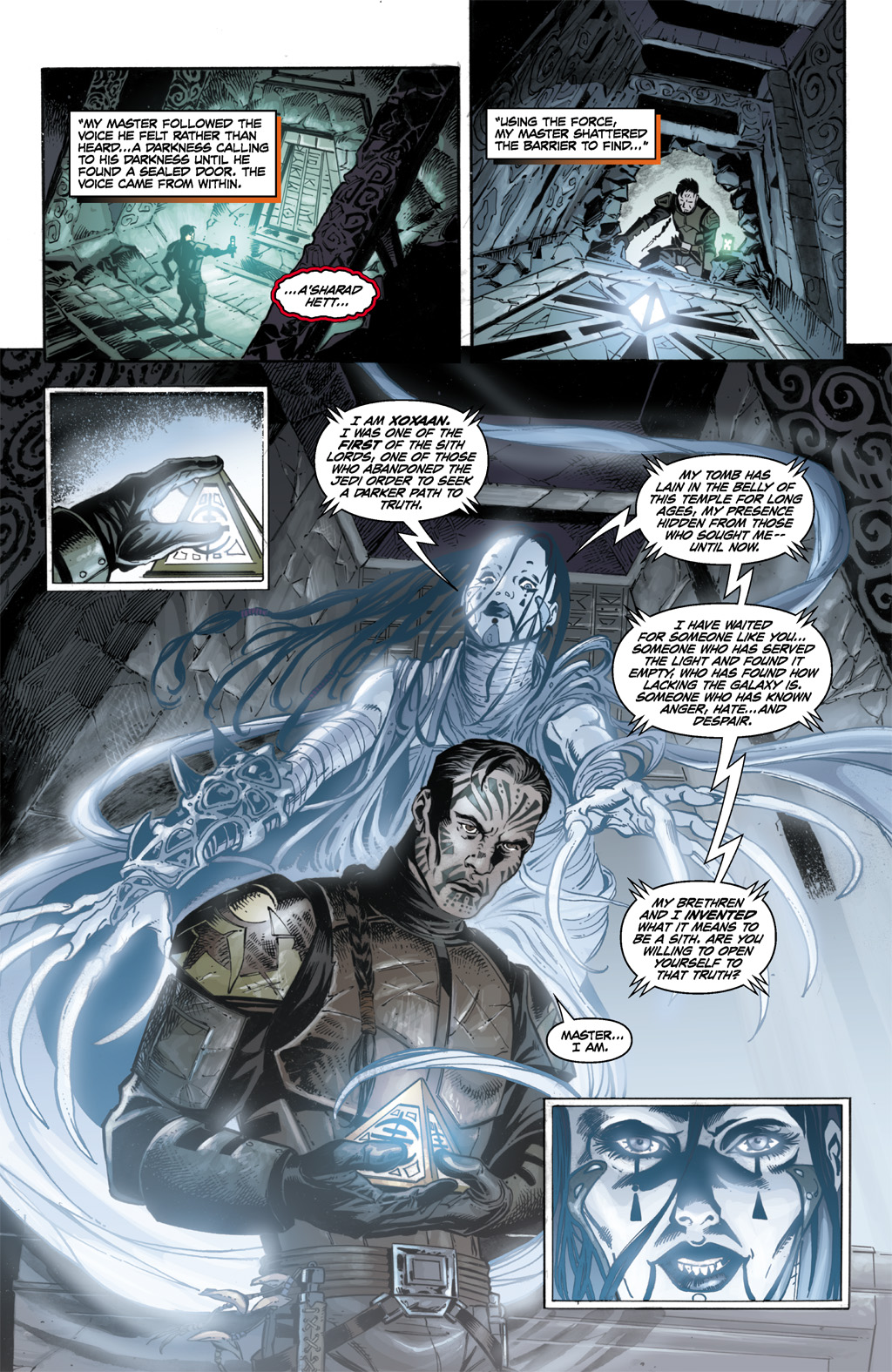

And he considers her his Master and guide even upon founding the One Sith:
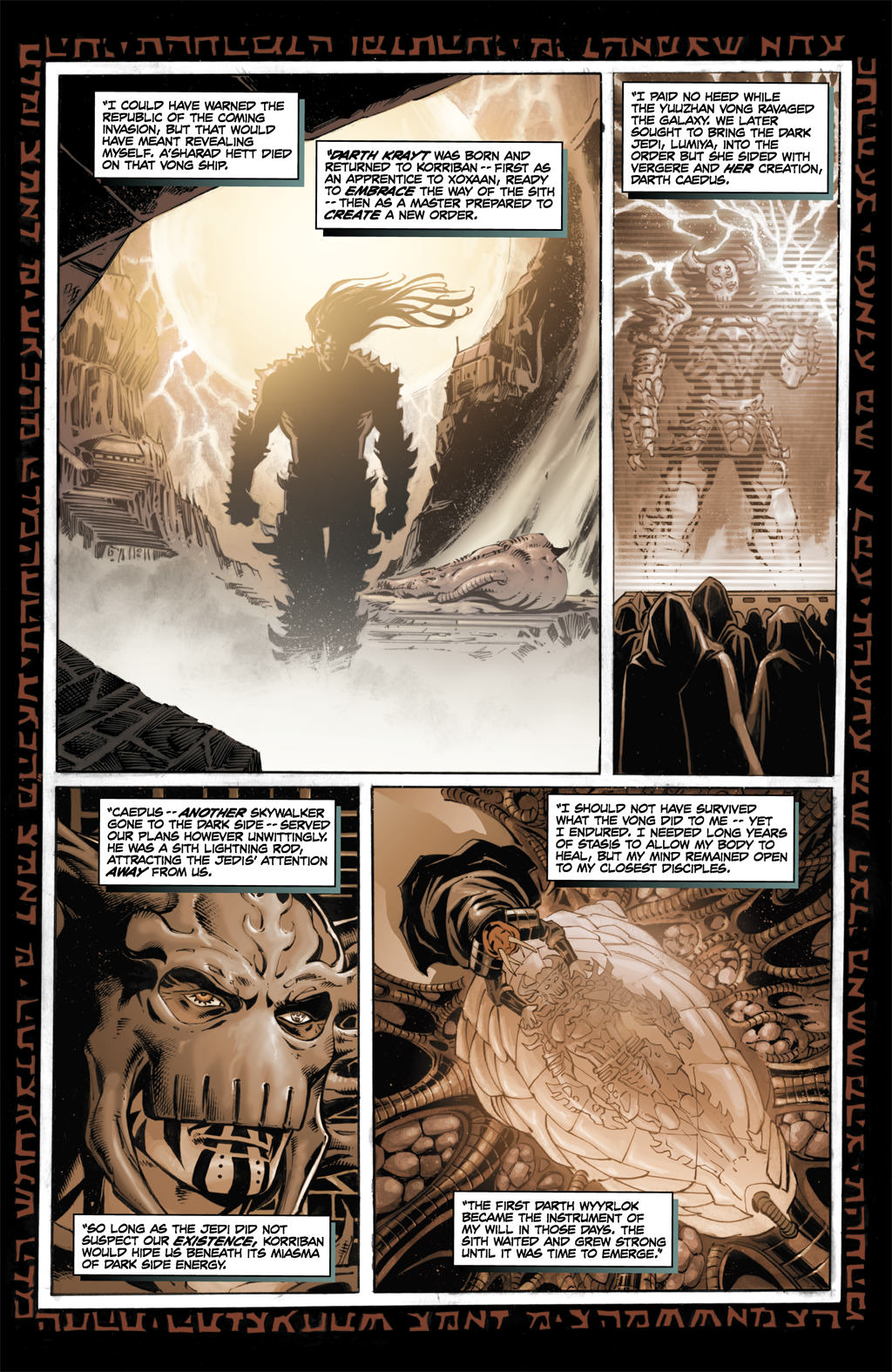
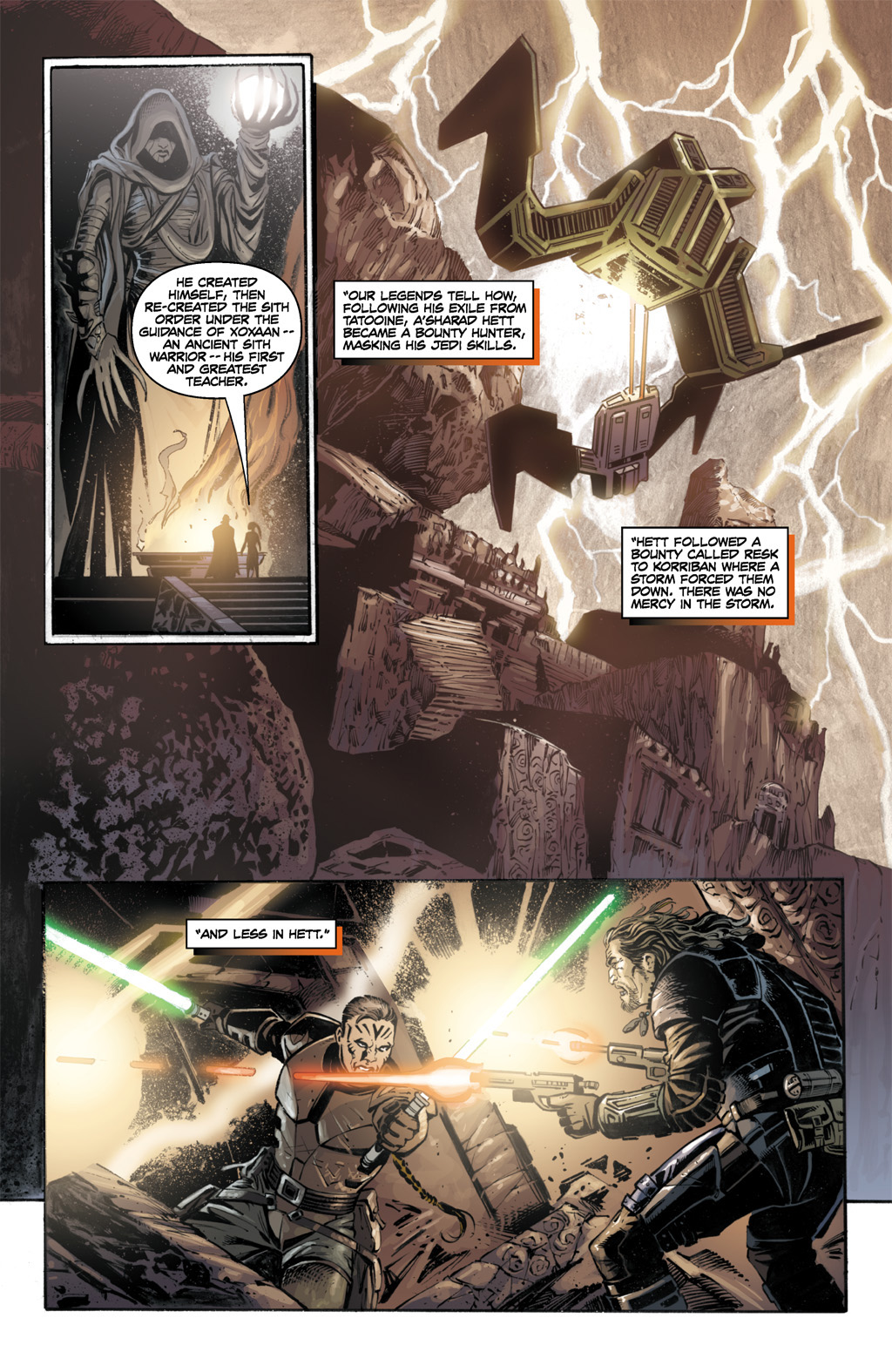
As he states in the above scan, even as he established his One Sith he needed extended periods of stasis and healing pretty much right away, due to what the Vong did to him with the Coral Seeds. So his body(and power) deterioration effectively started immediately from the point when he becomes Master of a new Order, but is still taking 'guidance' from his own Master, Xoxaan.
Likewise, Xoxaan and Remulus Dreypa are Karness Muur's stated 'rivals' 7,000 years ago:

Naga Sadow is the end result of some of the Exiles, including Xoxaan and Remulus Dreypa, mating for thousands of years with a primary purpose of producing stronger offspring with each generation:
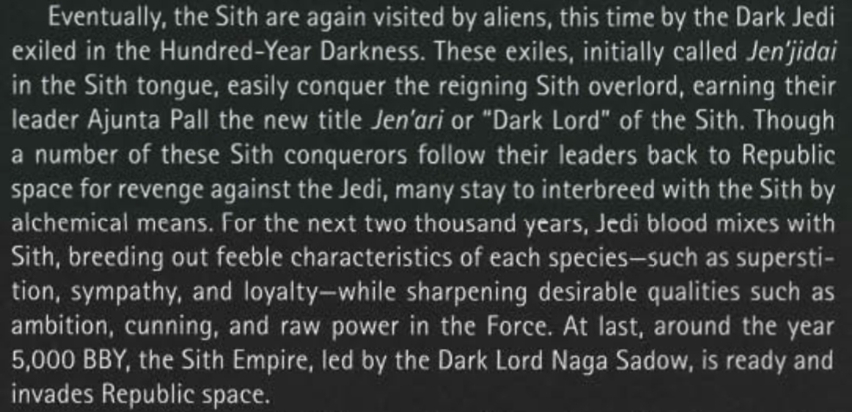
He was utterly surpassed by Freedon Nadd, despite Sadow having six hundred years of growing stronger in the Force after becoming that pinnacle:
The Official Fact File 90 wrote:Eventually, the apprentice became far more powerful than the teacher...
The Dark Legacy of Yavin IV, Star Wars the Old Republic wrote:And just as Nadd killed his lord Sadow, Kun destroyed Nadd’s spirit here on Yavin 4. These notable deaths likely served to further imbue the moon’s temples with dark power, further fueling the barbaric Massassi–as well as the succession of Dark Lords who would later reside here.
Freedon Nadd spends a century growing stronger:
The Complete Star Wars Encyclopedia wrote:"As Nadd's power grew over more than 100 years of rule..."
Before he is, in turn, utterly surpassed, drained and replaced by Exar Kun:

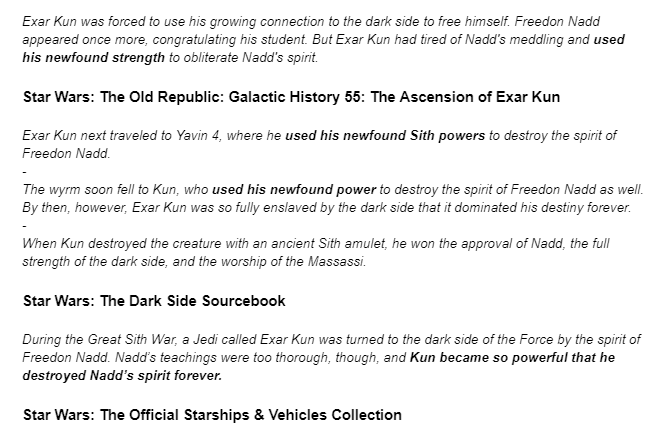

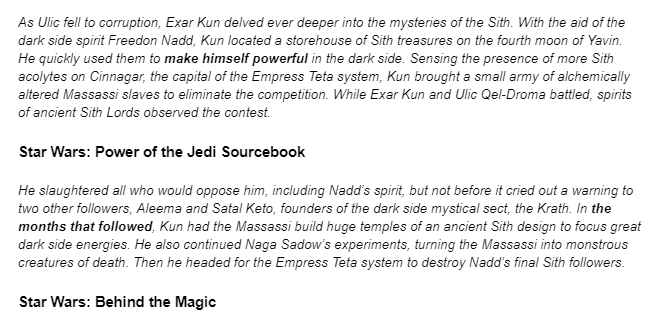

Exar Kun's power grows even more after this:
Chronicles of the Old Republic wrote:Exar Kun's power is in the ascendance.
Chronicles of the Old Republic wrote:Ulic unleashes a force of unruly fury at the death of Master Arca, avenging the death by defeating Keto, and taking the Krath throne by the side of Aleema. Meanwhile on Yavin 4, a more powerful EXAR KUN rests in his meditation chamber.
New Essential Chronology wrote:An extremely powerful figure now, Kun dabbled in dark side alchemy, creating freakish two-headed avians and hulking terentateks that thirsted after Force-rich blood. He invented a glowing golden sphere that trapped the children of the Massassi and allowed him to feed off their energies.
Yet the spirit of Marka Ragnos is so powerful that he is able to fog the minds of and control both Exar Kun and his hard equal at that point, Ulic Qel-Droma:
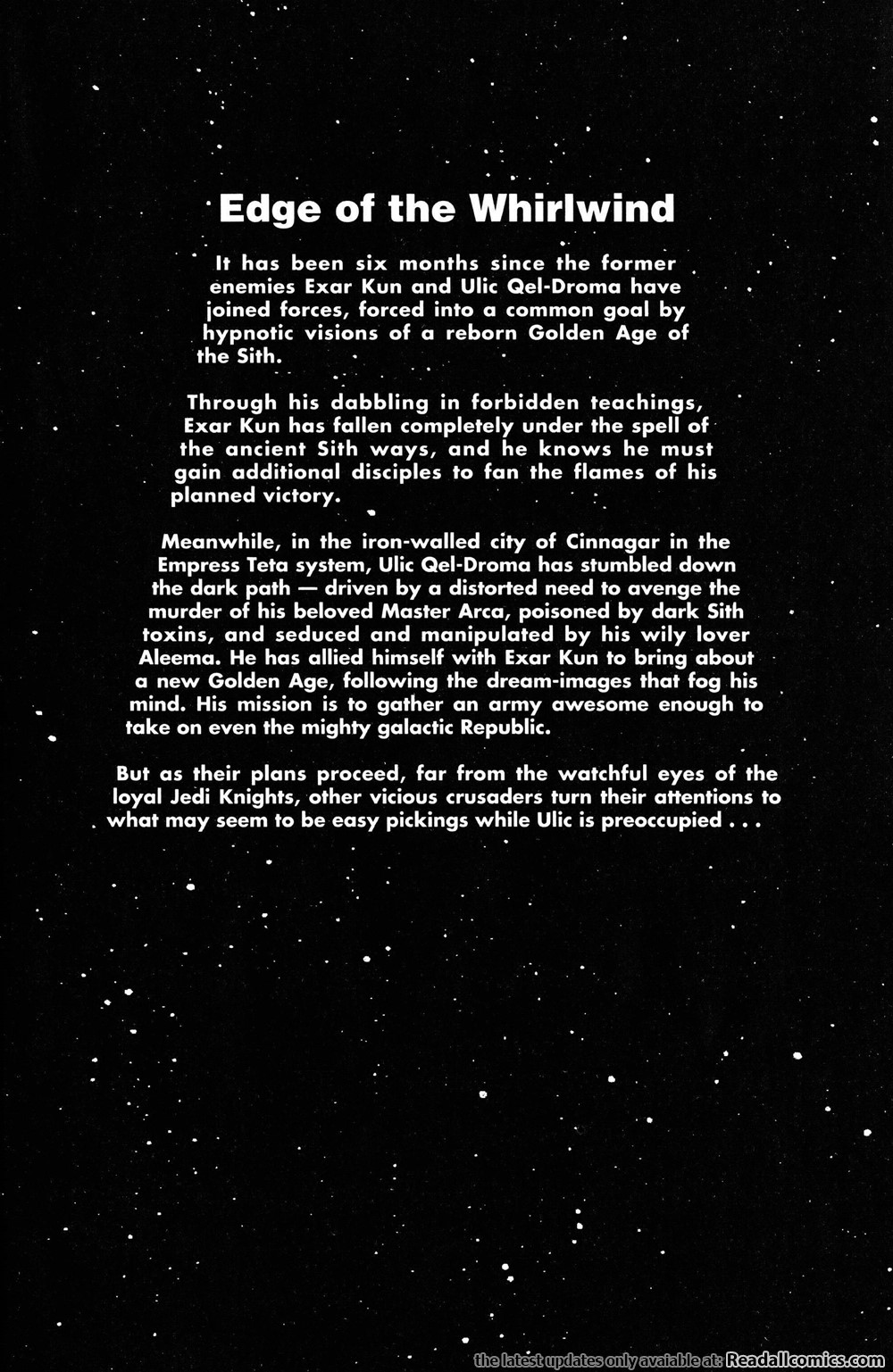
Exar Kun is stated to be more powerful than Marka Ragnos and any other Sith in history multiple times:
Star Wars Omnibus: Tales of the Jedi Vol.2 wrote:Nearly four thousand years before the birth of Luke Skywalker, the galaxy faces its greatest threat since the founding of the Republic!
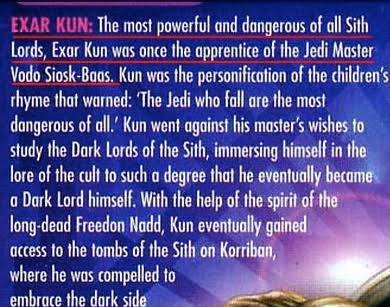
The Complete Star Wars Encyclopedia wrote:Kun, Exar. Once the most powerful and dangerous of the Dark Lords of the Sith, he was responsible for the deaths of millions four millennia before the Rise of the Empire.
What we end up with is a clear scaling chain of:
Exar Kun > Marka Ragnos > Cinnagar Exar Kun & Ulic Qel-Droma >>> Freedon Nadd >>> Naga Sadow > Karness Muur ~ Xoxaan ~ Founding Krayt ~ Reborn Krayt >>>> Vong Krayt > Republic Darth Tyranus & A'sharad Hett ~ 17BBY Obi-Wan Kenobi.
And even if I grant you that reborn Krayt is more powerful than the pre-degradation Darth Krayt given any evidence for it. Realistically, there's no bridging that level of gap. And there's certainly no way in which Founding Krayt doesn't end up at least in proximity to Revenge of the Sith Darth Sidious, given the plethora of evidence indicating that he is.
Yet again, a direct chain leading to Exar Kun flattens Darth Sidious.
The email has zero official weight in and of itself, and its application for determining intent at the time of writing any of the comics is severely limited by it being said a good 20 years after the fact.
There is no sell-by-date on author intent, all that matters is what he confirms his intent was at the time of writing. And for someone like me, he's stating the obvious. Jedi Academy has Exar Kun blatantly above Emperor Palpatine, a project that he and Kevin J. Anderson jointly developed alongside the Tales of the Jedi. This serves to tell us that Exar Kun's placement above the Emperor is far from smoke and mirrors on behalf of the authors. He's genuinely written to be better. We had Tom Veitch write Dark Emperor Palpatine into high heaven, then 3 years later he helps write a guy who is written to be better than Darth Vader from his first scene per an extremely high-level official:


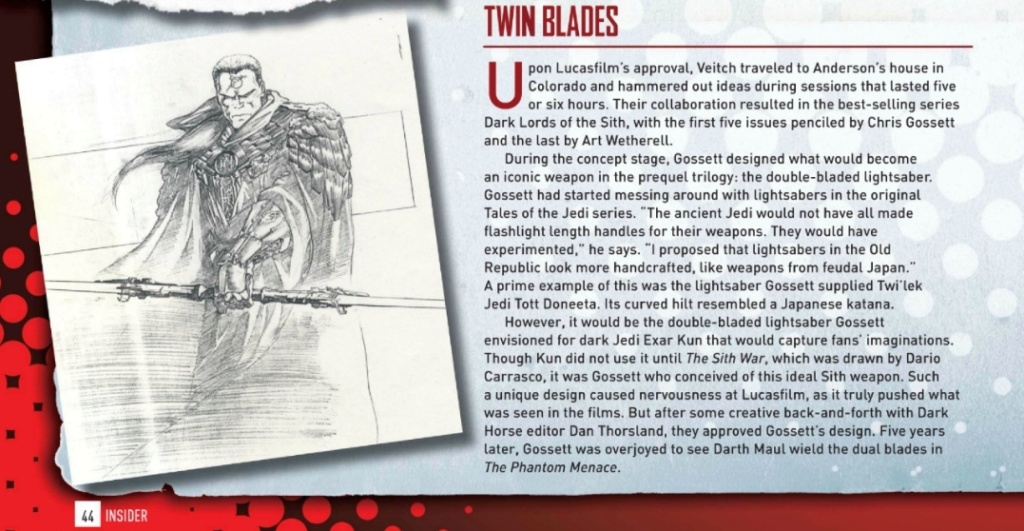
Noting that this was 1994, long before the new Lucas meta of Darth Vader came about. And to give you an idea of what their version of Darth Vader looks like:
Dark Empire I wrote:"Yes, that mask inspired terror throughout the galaxy but the feeble heart within was forever possessed by the impotent side of the Force. You can be far stronger than he was."
Dark Empire Endnotes wrote:"Yes... you have that talent... you are a Skywalker, after all... You can be like him... You can be greater than he was!"
And he eventually goes on to be even stronger than the Dark Emperor himself given all the effort they go to, to establish that, as I've already laid out.
 AncientPowerSuspect Hero | Level Four
AncientPowerSuspect Hero | Level Four
 Re: SS - EXAR KUN (AncientPower) VS. DARTH SIDIOUS (Durin)
Re: SS - EXAR KUN (AncientPower) VS. DARTH SIDIOUS (Durin)
December 2nd 2023, 5:21 am
The chapter being titled “Sith’ari”, coupled with Palpatine going on to bring the Sith to power in a way none before him did seems to be a pretty firm indicator of the novel Darth Plagueis’s take on the matter – highly visible, primary material with Lucas involvement, as opposed to an entry in older, secondary material.
First of all, Lucas knows nothing about what a Sith'ari even is. It was a concept created by Drew Karpyshyn in Knights of the Old Republic:
Surprise, surprise, Drew Karpyshyn also happens to be the author of the Darth Bane trilogy. Which likewise has an entire narrative dedicated to the assertion that he is the Sith'Ari. Wouldn't you know it, he fits the bill perfectly:
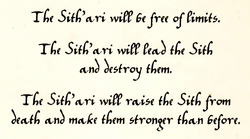
The Complete Star Wars Encyclopedia is an omniscient narrator POV coffee-table book written by Stephen J. Sansweet and Pablo Hidalgo:
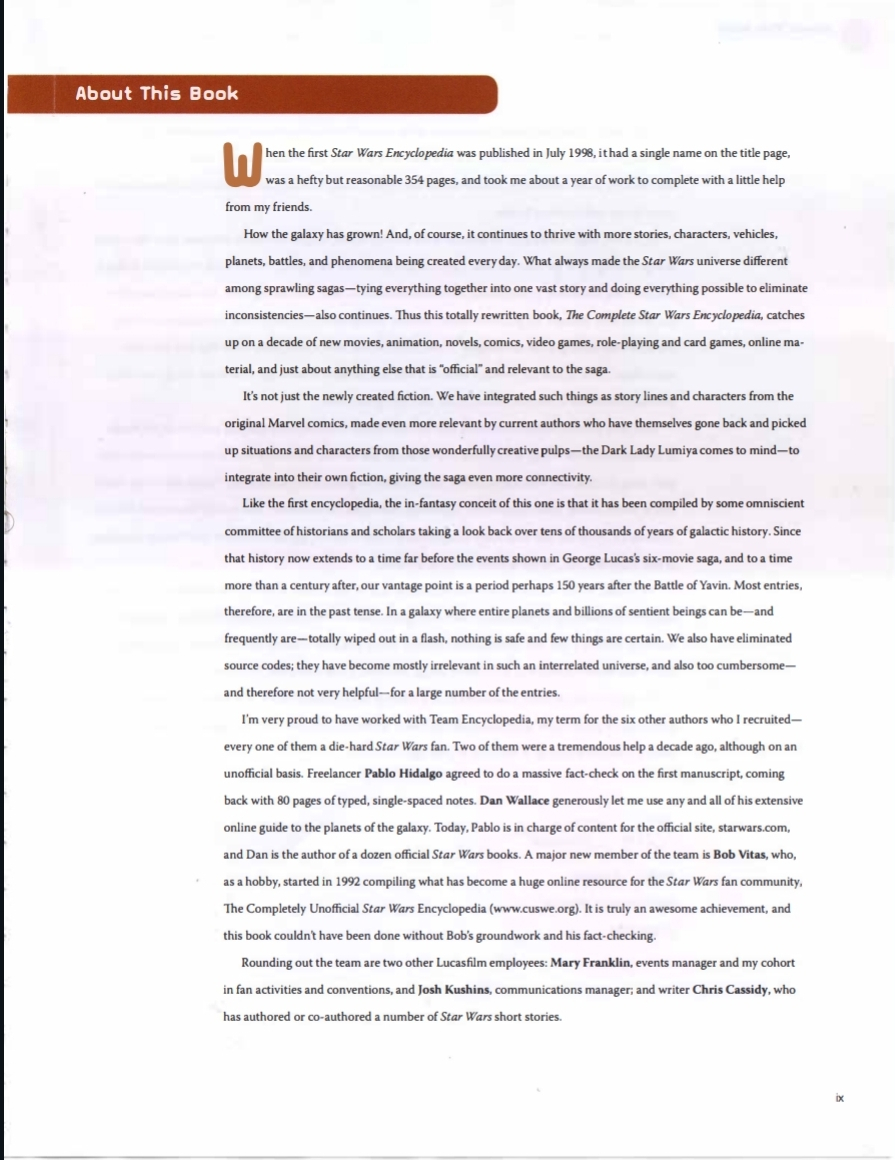
Which was directly fact-checked by Leland Chee himself:
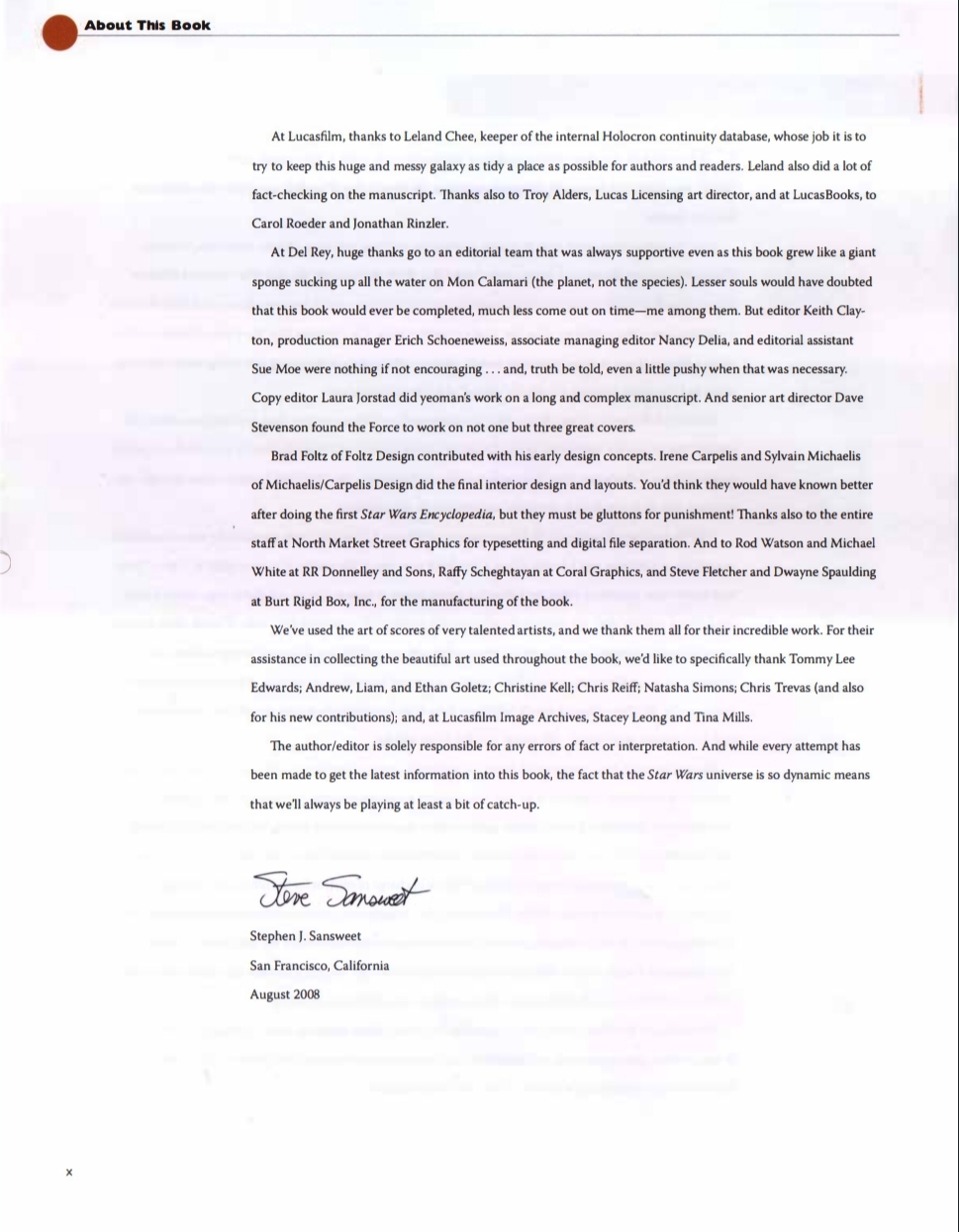
An omniscient POV written by none other than Lucasfilm's Director of Content Management, and edited by the Keeper of the Holocron himself. States that Darth Bane is definitively the Sith'Ari. Which was already obvious given the fact that the guy who invented the prophecy had set it up for one of his own future characters in Darth Bane. Like be realistic, Darth Plagueis is from the point of view of two of the most delusional Sith we've ever had the fortune of getting in the head space of. There's no comparison here, Sidious is not the Sith'Ari. Darth Bane is and always was. Which makes this entire appeal a moot point.
The passage is from the point of view of Streen (“Streen saw”, “Streen felt”). Exar Kun’s shadow grows darker and more powerful from Streen’s perspective only when he moves to tempt Streen by preying on his insecurities. Streen sees no change in Kun’s appearance when Kun is targeting the other students (Kirana Ti, Tionne, etc.), suggesting that there is no actual change.
Additionally, Kun’s shadow/presence becoming darker and more powerful, even taken completely at face value and ignoring the point of the fight… and the trilogy… can easily be Kun simply revealing more of the power that he had in store the whole time as he brings more of his abilities to bear on his enemies.
Kun can’t turn dark side energies on the scale of an individual fight in his own favor the same way Palpatine can.
I fully disagree, because the wording is very specific:
Champions of the Force wrote:Streen felt his throat constrict, his windpipe close. He choked, unable to breathe. The black silhouette turned, staring at those who resisted him. The Jedi trainees grasped their throats, straining to breathe, their faces darkening with the effort.
Kun’s shadow expanded, growing darker and more powerful. He towered over Streen.
Exar Kun is looking at all of them as he chokes them out and grows more powerful from their attempt to fight back. Nothing implies this is something only Streen is seeing, you're just making an assumption when the wording implies the exact opposite. They are collectively making him more powerful with 'their' 'effort' specifically.
This would be assuming that Vitiate is unaware of those same doorways, despite having spent a century researching dark side rituals in the ancient times when the knowledge that Kun is picking up the scraps of was developed and stored by the Sith Empire.
Given that the specific knowledge Exar Kun is using is one that was lost to time until Kun himself returned, I'm gonna have to say no, Vitiate doesn't:
Jedi Academy Sourcebook wrote:The dark knowledge of the Sith teachings died with Kun, it is extremely unlikely that any records survive, either on Yavin IV or elsewhere.
Something that is corroborated by Exar Kun himself, specifically said 'doorways to power':
Exar Kun, Jedi Academy Vol.2: Dark Apprentice wrote:"I could show you techniques that were lost thousands of years ago, secret rites and hidden doorways of power that no weak Jedi Master like Skywalker dares to touch."
Especially given that the technique in question was one developed by Naga Sadow on Yavin IV:
Dark Side Sourcebook wrote:There, where he first won their loyalty by slaying the wyrm, Kun used Sadow's ancient techniques and the life energy of every Massassi to leave his body and become one with the dark side. In the end, the Massassi died exactly as they lived, in absolute and unquestioning service to evil.
And, interestingly enough given the context of this debate, that Emperor Palpatine refused to share Naga Sadow's knowledge lest he end up getting killed because of it:
Darth Sidious, The Essential Guide to the Force wrote:One of the most powerful Sith alchemists was Naga Sadow, who left detailed records of his work within a Sith Holocron I came across some years ago.

Do we think that the idea is that Vitiate is just doing a massively more inefficient ritual than Kun, both in terms of resources used and time taken? Is that meant to show that Vitiate is less knowledgeable than Kun or the ancient Sith who designed the ritual? That seems unlikely. That he’s afraid of opening those doorways? The idea behind Nathema seems to be that it’s more a perversion than other ancient Sith rituals, and we know that he cares for Sith politics and tradition even less than the likes of Sadow. Why, then, would Vitiate need more fuel and more time to accomplish a weaker ritual?
Even if we were to come up with a logical explanation for how it could be logical for Kun’s ritual to be more efficient than Vitiate’s, the scale of the “wrongness” resulting from Vitiate’s ritual is clearly meant to inform the audience on the power that’s going into Vitiate. I struggle to envision any writer looking at the two rituals side-by-side and saying that somehow Kun came away from his with more power.
There’s also the inescapable fact that, as the ritual was discovered by another Sith, at a time where powerful Sith Lords would have had more than their fair share relative to Kun of Dark Side artifacts and Massassi slaves, there was at least one past Sith who either:
Used that same ritual to achieve great power and eternal life (Ragnos, perhaps?)
Decided it wasn’t such a screaming deal after all and decided not to
If it’s the former, then Palpatine would be firmly better than that Sith for my already outlined reasons for general supremacy, and Kun wouldn’t have too many independent reasons for breaking free. Additionally, this past Sith would clearly not be the combined Jedi Order-level combatant you’re pushing for Kun to be.
If it’s the latter, then the ritual probably does not, in fact, give nigh-limitless power.
1.Exar Kun's base-line here is specifically important. As I've stated above, the 2014 Fact Files state that Exar Kun is stopped before his power could become 'too great' outside of the ritual which was a Kun reaction to the Jedi attempting to pre-empt him:
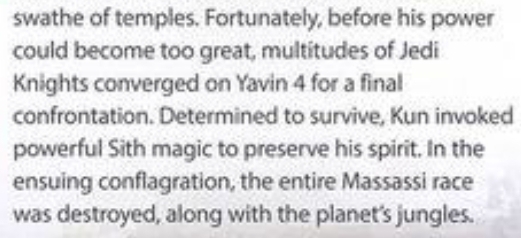
2.The ritual is opening him up to previously locked away power sources, which he can harness. And evidently this is outside of Kun himself, as he's going to try and re-open said doorways:
Exar Kun, Jedi Academy II: Dark Apprentice wrote:"I want your anger, Gantoris. I want you to open the doorways of power. I am barred from the physical plane--but with enough other Sith followers, I could be at peace. I could even live again."
He specifically no longer has access to it after he loses he needs to regain access to re-claim that power source.
3.'Wrongness' as a metric is inherently difficult to place. What Darth Nihilus does is undoubtedly similar to what Tenebrae does. Albeit he isn't using a ritual. Yet he has done his thing to multiple planets, which Kreia would know given she teaches him how:
Knights of the Old Republic Campaign Guide wrote:Then, when all seems lost, he discovers that his emptiness hungered. The first time, he fed it unconsciously. Draining another being's life is frightening, nauseating, but for a euphoric moment, the memories, the illness, and the hunger disappeared. But it proves insatiable. The more he indulges it, the shorter the satisfaction lasts and the more severe the hunger becomes. He begins feeding relentlessly, still always craving. Existence again becomes unbearable, but then hope materializes. A blind Sith Lord appears. She has felt his existence like a gaping wound through the Force. The Force, she explains, fuels his hunger, and she will show him how to devours worlds. The Sith and the Force are meaningless to him, but the hunger must be appeased.
Knights of the Old Republic Campaign Guide wrote:Darth Traya indeed teaches the newly christened Darth Nihilus to harness his life-draining gift to radical heights—so effectively, in fact, that Nihilus saps Traya's powers in a calculated double-cross.
Yet he's only potentially 'rivalling' some of the ancient Sith per Kreia even whilst reaching the pinnacle of the technique:
Kreia, Knights of the Old Republic II: The Sith Lords wrote:"The blind seer, her master harnessed this technique and he is rapidly approaching the height of its power. I fear he may even rival some of the ancient Sith. He is already more of a force than a living thing, a hole in the Force that threatens to draw everything to it.”
Darth Nihilus could be considered more 'wrong' than most of the people you or I would place above him, the situation with the Nathema Ritual is no different.
Though most of this argument is moot given I've already shown how Tenebrae ashes Darth Sidious with mere suggestion. It'd literally be akin to:
Where’s the fixation on the Massassi specifically as the power source coming from? We see that Kun needs the Force energies of Luke’s students to open up the gateways. Kun’s found a new source of fuel, and it’s much more efficient per capita than the Massassi were – and still doesn’t come close to measuring up to what Vitiate was working with.
A dozen Jedi hardly makes up for draining the life energy of the entire Massassi species. Thousands upon thousands of dark side-empowered abominations. But let's assume you're right on this point for a moment:
Massassi who provide Kun vastly more power than the power unleashed by the Ambrian Sorceress and all of her Sith. Given that's something dealt with single-handedly by Master Thon. One of the Jedi in the fleet fighting Exar Kun:
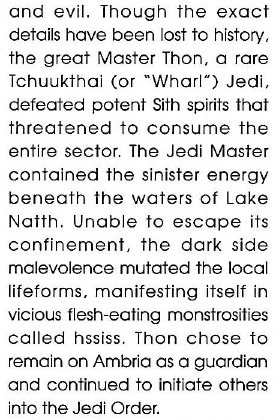
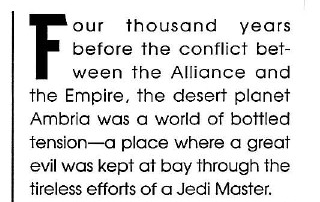
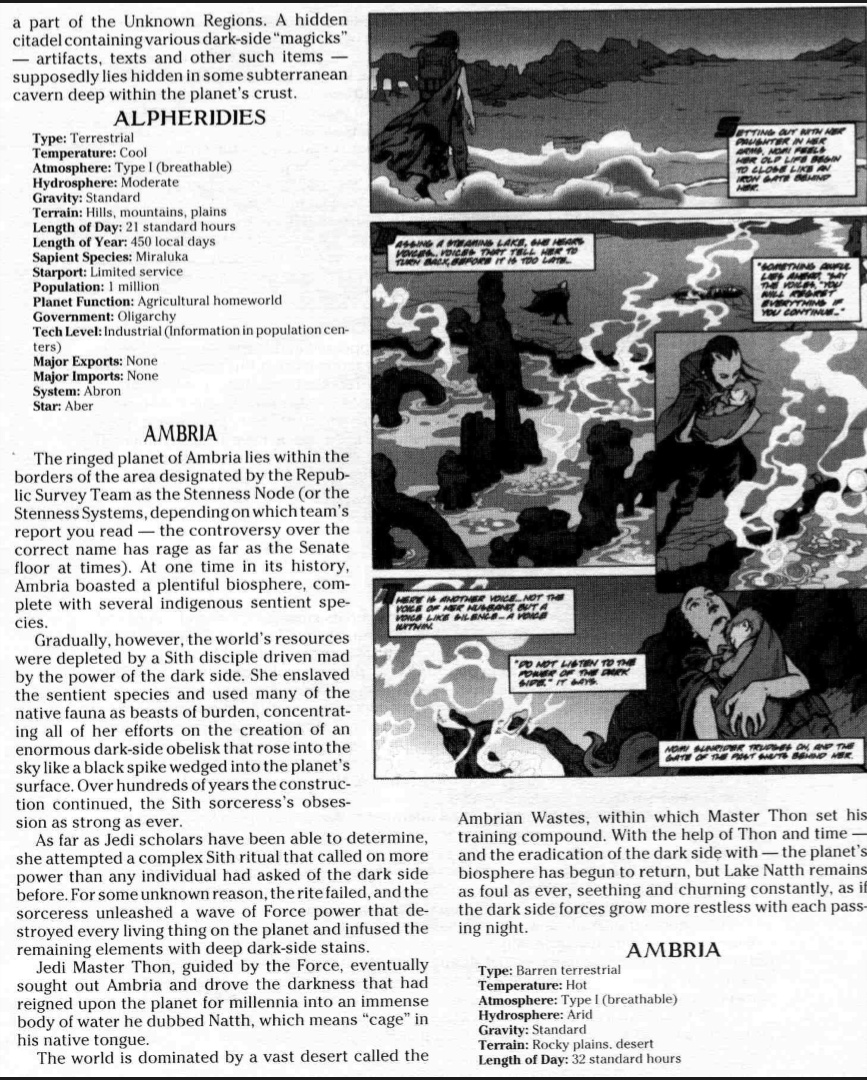

NOTE: As the only metric the Jedi could have after the ritual took place is the energy they could presently sense on Ambria, then it has to be this power that is the basis for the estimate, and therefore must be greater on its own.
And given that all the ritual does is essentially planet surface wiping, it's very interesting that the very first quote states that the Sith spirits threaten to consume the entire sector. Almost as if the spirits are even more dangerous now than the initial ritual was. Regardless:
Thus Thon is single-handedly stronger than Naga Sadow amplified by the Corsair summoning dark side energy to cause a sun to go supernova, which is recorded in Jedi holocrons:

Now, it's certainly interesting that this is brought up, given that we do have this:
Star Wars the Old Republic Encyclopedia wrote:The Sith Emperor, history's most powerful dark side master, performed a ritual of incredible scope to consume the life energy of every being on his homeworld. Ancient Sith were also masters of these arts - Lord Naga Sadow was able to affect the stars themselves, and caused the red supergiant Primus Goluud to go nova.
Such power is clearly thought of very highly even in the very next sentence to the Nathema Ritual. Makes you think, don't it?
And yet Vitiate continues to be categorized a Sith Lord all the way through his Vanilla appearance in pretty much everything to talk about him.
I don’t know all of what has and has not been said in past debates, and I don’t really care unless you have some specific evidence and/or reasoning from those in mind for this point. Of course it’s your choice on whether or not to engage on this, but don’t expect anyone to treat “I’d rather not” as a counterargument.
I bet you wish you hadn't insisted on this now, huh?
The Absolute State of the Jedi Order
The Jedi Order had, at this point, just undergone several major losses, including a purge labeled a “holocaust”.
On Deneba, Krath War Droids attacked the Jedi assembly, killing many Jedi, specially targeting the most powerful Jedi present (and being strongly implied to kill some of those unnamed Masters), as well as Arca Jeth, one of the Order’s most powerful disciples.
- Spoiler:
On Ossus, Exar Kun murdered Odan-Urr, leader of the Jedi Order.
- Spoiler:
Most of the top Masters (at least eight) were assassinated by former students of theirs – twenty ambitious Jedi learners possessed by Ancient Sith spirits. At the same time, Ulic Qel-Droma attacked Coruscant with his Krath and Mandalorian forces, presumably slaying many of the defending Jedi. This was followed up by Exar Kun arriving at the doors of the Senate and personally killing his master, Vodo-Siosk Baas.
Only Thon, Ood, and an assortment of Knights and Apprentices are shown remaining.
- Spoiler:
Ood Bnar is rooted forever on Ossus.
- Spoiler:
Of the “great Jedi Masters of the era,” this leaves only Thon still alive.
Cay is dead. Crado is dead. Ulic can’t use the Force. Qrrl Toq, Shoaneb Culu, and Dace Diath are dead. All the most ambitious students of the great masters turned traitor.
The only named Jedi left to picture as contributing anything to the Wall of Light are Thon, Nomi, Oss, Tott, and Sylvar.
Besides them, and a handful of people we see later in KotOR material, everybody else is both featless and highly unlikely to be at the level of any of the shown great masters or prodigies. On top of that, even those fodder Knights and apprentices are severely diminished in number by the many slaughters they’d withstood in recent years.
The Jedi Order that puts Kun away for four millennia has exactly one named Jedi Master.
Thon may be the one named Jedi Master in the material we see but I'd be very surprised if Vandar Tokare wasn't there given he's already the legendary Jedi Master by the time of the Mandalorian Wars:
Knights of the Old Republic wrote:Olive-skinned, long-eared and pint-sized, Vandar Tokare serves as the leading master of the respected Dantooine Jedi Council during the Mandalorian Wars.
Knights of the Old Republic Campaign Guide wrote:Though the future is always in motion, Tokare excels at reading portents. His wisdom is frequently questioned by contemporaries such as Master Vrook Lamar, but as history engulfs the future, the diminutive Jedi's insights repeatedly prove correct. When the Jedi Exile comes to Revan's side against the Mandalorians (and against the Jedi Order's wishes),
Not that it matters, Kun prides himself on the fact that hundreds of Jedi Masters were among the Order's numbers in the battle:
Exar Kun, Jedi Academy II: Dark Apprentice wrote:"Four thousand years ago the entire military fleet of the Old Republic and the combined forces of hundreds of Jedi Masters could not destroy me."
And unlike what you'd like to think, the amount of Jedi still around is far greater than you'd like us to ballpark in:
Knights of the Old Republic Campaign Guide wrote:The victory is temporary, however. Fifty years of betrayals, defections, and death have dwindled Jedi spirits and numbers.
Yet the numbers of Jedi being killed off by the Sith Triumvirate are still in the tens of thousands:


So 50 years of the Jedi Order's numbers being dwindled result in there still being tens of thousands of Jedi for the Triumvirate to kill. How many should we say were that at the battle of Yavin IV? 100,000? 150,000? Given the Mandalorian Wars and Jedi Civil War had left the Order in pieces, and that the Jedi Order had been reduced to only 'tens of thousands' after the Star Forge was destroyed. I can only imagine the immense numbers that 'all the known Jedi' as of the Great Sith War represented, according to Vodo Siosk Baas and in-universe Jedi records on the matter:
I, Jedi wrote:I let Streen fill Kun with our resolve to unite and defeat him, but Kun's contempt for us came rolling back along the line like an echo. He had faced fleets of ships and all the known Jedi. He had slain his own master. His power was unrivaled.
I, Jedi wrote:Twelve half-trained apprentices and two toddlers planning to annihilate someone who had survived an onslaught by the combined might of the Jedi of his age sounded ridiculous on the surface of it.
Vodo Siosk Baas, Jedi Academy II: Dark Apprentice wrote:"All the Jedi banded together and came to the jungle moon in a united front against the Sith stronghold Exar Kun had built. The allied Jedi combined their power into a massive annihilating strike."
 AncientPowerSuspect Hero | Level Four
AncientPowerSuspect Hero | Level Four
 Re: SS - EXAR KUN (AncientPower) VS. DARTH SIDIOUS (Durin)
Re: SS - EXAR KUN (AncientPower) VS. DARTH SIDIOUS (Durin)
December 4th 2023, 2:13 am
As he is pre-ritual, he can’t fight the combined might of all the Jedi in any way.
However, as he will be post-ritual, he can fight the Jedi Order in other ways [than beating them in a straight up fight].
He will do this by surviving [with the immortality aspect of the ritual].
I'm going to respond to your entire Yavin IV diatribe off of this first quote here, just to save some time. I'm covering everything so don't worry.
All you have done here is put words in his mouth. That's it. You can't go on to say Kun is bullshitting about everything when it suits you, lmao. You should be better than this.
Exar Kun only says he can fight back in other ways and survive. Exar Kun goes on to say he faced hundreds of Jedi Masters and they couldn't defeat him, and not just because he cheated out of it. Something you dismissed as him lying just because it suits your argument.
That's not the only thing people say about the power dynamic:
I, Jedi wrote:He had faced fleets of ships and all the known Jedi. He had slain his own master. His power was unrivaled.
It's not some trumped up lie, it's a genuine belief and something Corran Horn experiences himself.
Indeed 'the key' to defeating him for the Jedi Order, was that they 'fought together as a unit where all the pieces fit together, as components in a much larger machine powered by the Force.':
Jedi Academy III: Champions of the Force wrote:"Though Kun had enormous power, it seems that the key was that the other Jedi combined their might. They fought together as a unit where all the pieces fit together, as components in a much larger machine powered by the Force."
So it's not just that the Jedi combined their might, they created a union in the same fashion that the Praxeum created to defeat Kun as a spirit. The power 'directed' at Kun himself:


It was a wall of light quite literally more than the sum of its parts. So it's not even just the power of the combined Jedi order, it's the Jedi order acting as components in a larger machine for the Force to dunk on Kun with. Which is very interesting given that the response of the Jedi Order to Kun prior to even knowing the ritual was even going to occur, is itself absolutely insane. They saw that Exar Kun was the final threat that remained:

And responded with the greatest massed force of Jedi in history by that point:
Jedi Academy II: Dark Apprentice wrote:When Master Vodo did not succeed, the other Jedi banded together in a massive strike force such as had never before been gathered.
They aren't rallying every single Jedi they can get to beat the ritual Kun, they are getting every single Jedi to fight the Kun they sense. Which goes right into my above quote that the Jedi were 'fortunate' to stop Kun before he could become too strong for them to stop. That's not including the ritual, which was merely a reaction from Kun.
And here's the important part in all of this, your main claim is to appeal to the idea that Kun cheats by becoming a spirit, therefore becoming unbeatable. Let's get this straight, you think the Jedi firing a massive Wall of Light at Exar Kun directly, which is literally just straight up Force Light as we see when the Praxeum imitates them by 'increasing the light' to kill him. As a spirit. Is escaped by him... becoming a spirit? The power they use is basically the ultimate trump card against pure dark side energy. And it's not like Kun dodges, it's literally aimed at him directly. Even assuming he's a spirit at that point for your sake only makes it worse for you. If Kun is hopelessly outmatched as you are saying is, and if he is just ducking the Jedi by becoming a spirit made out of dark side energy, as you are claiming is the notion here. None of that makes any sense. He's more vulnerable to pure Force energy as a spirit of Dark Side energy, as we see when his spirit gets dunked by overwhelming 'light' in the trilogy. And given that you think he's hopelessly outmatched by that power as said spirit, there's literally no logical reason that he should even still exist. The reason he persists is because he's strong enough to tank it on the chin. That's it, that's the reason why.
1.The Jedi Order turns up to deal with the usual Exar Kun, deeming that a necessary response to beat him.
2.Kun realises there is no way he can defeat all of them in a throw down in his current state. They straight up pre-empt him becoming strong enough to do that.
3.Kun uses the ritual to unlock doorways of power that can make him powerful enough to literally become too strong for them to beat him. Which is basically just him counter-acting their pre-emptive move.
4.The wall of light nuke hit him directly, no dodging or hiding in the temple as a spirit. He is specifically hit with it, no matter what form you think he is in. And he isn't dusted or wiped out. This same power being whole magnitudes more powerful than anything to do with Luke's spirit or the Praxeum or any of that. As shown by the Dorsk 81 feat utterly dwarfing the combination that includes Luke's spirit and Kyle Katarn. He goes on to survive four thousand years off of his own strength, and makes two major attempts to be resurrected.
There is no amount of undermining you can do here to negate the fact that this feat is absurdly beyond anything that Revenge of the Sith Darth Sidious could hope to replicate.
 AncientPowerSuspect Hero | Level Four
AncientPowerSuspect Hero | Level Four
 Re: SS - EXAR KUN (AncientPower) VS. DARTH SIDIOUS (Durin)
Re: SS - EXAR KUN (AncientPower) VS. DARTH SIDIOUS (Durin)
December 7th 2023, 10:27 pm
I’m not sure why the “all-powerful” description applied to a version of Kun that, per the Unassailable Blog, is only a hypothetical version of the character, as the ritual did not make him into a spirit in the first place, should apply to the actual, living Ritual Kun. If the quote is totally off the mark when it describes one part of what the ritual does, why do we give its other part weight when applying it to the fundamentally different, but correct, version of the event?
This is already covered by the blog, as I've said before most sources assume Kun becomes a spirit by absorbing Massassi, and gets trapped there by losing his power. That Kun is described as 'all-powerful' stands irrelevant of this. It doesn't make the whole source unusable in this regard, it merely applies a greater context. That Kun is 'all-powerful' is due to the power gained through the ritual, that's regardless of which form he is in. See my previous post.
It says nothing about him fighting the Jedi, beyond them not being able to destroy his spirit (wow, that’s emphasized a lot by all this, almost as if that’s the main point of the ritual because he knows he can’t actually kill the Jedi). Any version of Kun… spirit Kun, living Ritual Kun, whatever… is clearly not all-powerful. “All-powerful” doesn’t mean anything of substance.
This is an absolutely hilarious stance to take here. Palpatine and Valkorion are full of these kinds of quotes, and they're super impressive when it describes them. But when it's Exar Kun suddenly it's empty and irrelevant.
But more importantly, Exar Kun is 'all-powerful' in comparison to the Jedi Order arrayed against him. That's the very obvious meaning of this quote. Both Palpatine and Tenebrae lose in their strongest states and still get these kinds of quotes. But the reason you can say these kinds of quotes still stand, is because the circumstances of their losses don't actually debunk them. Tenebrae loses to an intervention by the Force, Palpatine loses to something very similar. As I have shown in my prior post so does Exar Kun. I'm sure you'd rail against this claim, but what would a true Force intervention actually be defined as? Where do we draw the line?
When Tenebrae loses, the alliance arrayed against him acts as a conduit for the intervention by the Force which destroys him. Luke and Leia and Anakin unite as their own conduit to sever Palpatine from the Force. What the Jedi Order does is described in the same vein, the Jedi acting as components in a larger machine powered by the Force. This was their hail Mary effort to channel the Force against Exar Kun and stop him. And it doesn't destroy him, in fact it's stated that after his defeat:
Chapter 9: The Fury of Exar Kun announcement, Star Wars Galaxies, LucasArts wrote:Exar Kun's spirit is so strong and malevolence so great, that he has withstood death for 4,000 years, waiting for an opportunity to finally obtain the godhood he so desires.
Not only does he take a blow from the Force itself, he's still hanging on through sheer strength and will four thousand years after the fact. Then when he is finally put to rest in 1ABY:
'Chapter 9: The Fury of Exar Kun' announcement, Star Wars Galaxies, LucasArts wrote:Players must eliminate each of the now twisted but powerful archeologists on their way to finally put the spirit of Exar Kun to rest.
He returns from Chaos in 11ABY:
Evil Never Dies: The Sith Dynasties wrote:Seven years after the Battle of Endor, when Luke Skywalker established an academy with the intention of rebuilding the Jedi Order, the spirit of the ancient Sith Lord Exar Kun returned to prevent the Jedi Brotherhood's resurrection. Three short years later, another Sith daemon, this time the Dark Lord Marka Ragnos, also was called back from the realm of Chaos to terrorize the galaxy.
Returning from Chaos is something paraded to no end by you Palpatine supporters. Yet here we have a massively depowered Exar Kun doing so as well, just because he hates Jedi that much.
I’m not seeing anything like that. Sounds cool though, would you mind posting it in your next one?
I like how you contradict your own point here by making this insanely bad faith attempt at lowballing him despite overwhelming and incontrovertible evidence to the contrary:
Evidently not enough to keep some unnamed Jedi Knights and Republic troopers very far at bay.
Again, we literally don't see the full picture or context. There could be hundreds, thousands, tens of thousands. And given that the Jedi deem it necessary to summon their entire galaxy-wide force against him. And that both records in-universe and out-of-universe all support that the 'key' to defeating him was the wall of light thrown at him by the Force through the conduit created by the Jedi. Something I've just proven. Every single one of your attempts to undermine his demonstrated prowess is about as effective as Palpatine's supremacy quotes are when it comes to protecting him from being 'cowed'(bullied, intimidated, broken by violence) by ancient Sith spirits to the point he was reduced to being rescued and then being placed inside a bacta tank for weeks instead of his own healing powers. Something Sidious himself admits to.
Another one talking about him being a spirit before the Jedi arrive
That he senses their arrival should not be construed as before they arrived in the system or above Yavin IV. I'd also like to see you actually prove this or any other quote means he was a spirit before they arrive. It doesn't track with the actual depicted events or anything else on it for that matter.
“The Order had to burn down the moon to beat him” would necessitate that the Jedi made a conscious decision to sacrifice the moon and their forces down there to destroy Kun.
I have absolutely no idea where you even got to this conclusion. They don't need to make a conscious decision whatsoever. They had to use this much power to reduce his power by as much as they did to stop him. Noting that this was their maximum effort to act as a larger machine to launch as much power as possible at him with one directed effort, and 'in the wake' of that power hitting Kun the whole moon was ashed.
Probably the single most repeated thing, from the source material to the stuff from far later, is that Kun can’t fight the combined Order in the way that you mean.
Except he has and he does. As I've already proven beyond doubt.
I’d also like to note that, going off of SWTOR’s version of events, Kun wasn’t the only target of the Wall of Light. The aim was to wipe out the residual Dark Side energies in the temples from Sadow, Nadd, and their Massassi as well as Kun.
Going off of Arlo Grennen's interpretation of events, sure? That's not even the only SWTOR based version of the events. But just in case you decide to push this for whatever reason. Exar Kun didn't even put all his new power into defending himself, he also protected the temples from the nuke. The only reason that power is still around is thanks to Exar Kun:

Not only does this tell us that he can’t simply handwave the Jedi and Republic soldiers we see getting into close quarters against him (and pushing him back into the temple and helping to kill him off!), but it also lets us know that dueling is not a non-factor against Kun. Maybe he’s so ignorant of the ritual’s effects that he can’t practically bring his full “all-powerful” Force abilities to bear against the Jedi. Or, maybe, hear me out on this, “all-powerful” was flowery language here, as it is almost every other time we see that word used to describe a mortal Force user.
Nice fanon you wrote there, unfortunately for you we have absolutely no idea how much strength is being arrayed against him. But given you so kindly decided to appeal to the one depicting the Wall of Light. We can assume given the fact it is literally called Wall of Light, and depicts him in it. This represents the Wall of Light event. And given we have like a thousand quotes all saying it was the entire combined Jedi Order, and better yet the actual in-universe records/depictions stating that it was actually necessary to do far more than just summon the army; to the degree it was 'the key' to beating him. Then your claims of a handful of unknowns is blatantly wrong. And even then it wasn't even a total defeat given what he goes on to do four millennia later. So contrary to your snide, bad faith takes on still images. It's actually probable that Kun might have won if the Jedi hadn't opted for the wall of light summoned from the Force via acting as a conduit.
While the ritual would have amplified his abilities by quite a bit, it would not have impacted his technical skill with the lightsaber, and, mentally speaking, the rushed, last-ditch-effort ritual of unknown effect is unlikely to have done anything positive for his balance as a combatant.
Kun instills his victory over Vodo-Siosk Baas, one of the most skilled Jedi duelists, as one of his all-time greatest feats in the Jedi Academy students’ minds, right up there with his “faceoff” against the Jedi armada. Vodo’s the best fighter Kun’s ever bested.
Compare this with someone like Agen Kolar, who has, if anything, greater all-time hype as a duelist than Baas. He was out of the fight against Palpatine before it even began.
An “one of the most skilled Jedi duelists of the era” is Exar Kun’s toughest opponent.
A “one of the most skilled Jedi duelists of all time” is Palpatine’s appetizer.
When Palpatine, undoubtedly more powerful than any of the randoms who got close enough to Kun that his lightsaber was of use, gets up close to duel Kun, it won’t go well for him, ritual or no ritual.
Good god that's a terrible argument, on all fronts. First of all, Exar Kun puts this in their heads because Exar Kun successfully killed his own master. And given his prey are students, currently witnessing the defeat of their own master, Luke Skywalker, he's clearly showing how far above them he is where their own current situation is relevant.
You can't just say Agen Kolar's hype as a duelist all-timer is superior to Vodo's and expect me or anyone else to just nod along. Vodo's dueling skills outstrip Agen Kolar's in miniature stats by quite some margin:



Just as an example.
But far more important than random appeals to stats or vague hype using characters they're somewhat relevant to. Here's an example of how well one of Kun's neophytes of a few days faired in a duel with Master Luke Skywalker:
Jedi Academy II: Dark Apprentice wrote:But Gantoris stood like a weathered Massassi colossus, holding the blazing edge of his lightsaber vertically in front of his face. "If you don't ignite your lightsaber and fight me, I will cut you down right here." He paused with a smirk. "That would be a rather embarrassing fate for a Jedi Master, wouldn't it?"
Reluctantly, Luke shrugged out of his robe. He pulled his own lightsaber from the waist of his comfortable gray flightsuit and, feeling the Force thrum through him, ignited the yellow-green blade.
The other trainees watched in amazed silence. Luke wondered how he could have miscalculated so greatly, how Gantoris had gained access to information that only an advanced student should have obtained.
He stepped forward, raising his blade. Gantoris stared unblinking. Luke saw his red-rimmed eyes burn with a depthless intensity, and he felt a twinge of fear.
They crossed blades with a crackle of dissipating power, testing each other. He felt the resistance of the energy blades, the flow of the Force. He and Gantoris struck again, harder this time, and sparks flew.
Abandoning all pretense of testing, Gantoris launched himself at Luke, hacking and slashing with the white-violet saber. Luke blocked each blow, but fought only defensively to keep from provoking his student.
Gantoris made no sound as he struck again and again. The lightsabers intersected with a flash of multicolored lightning. The fury in Gantoris astonished Luke, and he backed toward the jungle's edge, unnerved by the violence.
Gantoris pressed his advantage. Luke blocked away all thoughts of the other trainees watching.
"Am I a Jedi now?" Gantoris asked in a husky voice.
Luke parried, then blocked another blow, locking both blades in a snapping, sizzling spray of discharged energy. He spoke through clenched teeth. "Training requires diligence and commitment. And control. A Jedi needs to know more than how to build a lightsaber. He must also learn how and when to use it!"
Luke drove forward, suddenly taking the offensive. He struck and struck, careful not to injure Gantoris but confident in showing his mastery. "The lightsaber is the weapon of a Jedi Knight, but a true Jedi rarely uses it to settle a dispute. It is better to outthink and outmaneuver your opponent. But when forced, a Jedi strikes quickly and decisively!" He slashed down, hard.
Clumsily defending himself, Gantoris backed into a tangle of jungle. Dew sprayed from underbrush as they trampled stands of climbing ferns. Startled flying creatures flapped away with squawks. Gantoris swung and slashed wildly at Luke's lightsaber, using brute force but no finesse. He bumped against a wide-boled Massassi tree, and flakes of purplish bark fell to the ground in an uneven patter.
Luke stood over him, intending to call an end to the duel, but Gantoris's eyes blazed brighter. As if springing a trap, he fingered a button on his lightsaber handle--and the violet-edged blade suddenly extended like a spear, flashing outward to nearly double its length.
Reacting with lightning reflexes, Luke jerked aside, and the point of Gantoris's energy blade slashed through the sleeve of his gray flightsuit, leaving a smoldering gash.
He stared at Gantoris in disbelief for a precious fraction of a second. Not only had Gantoris built his own lightsaber, but he had constructed a blade with multiple jewels, allowing him to adjust the amplitude of his blade. Such a weapon was at least twice as difficult to make as a traditional lightsaber, and Gantoris had done it by himself!
Without pausing Gantoris pressed his advantage, lunging with his longer blade, knowing that Luke could not come close enough to touch him.
The thin, wavering voice of Streen called out, "Gantoris!" unheeded by Luke or Gantoris. The other students pressed toward the edge of the jungle, but this battle was between Luke and Gantoris alone.
He was dismayed to see the recklessness in Gantoris--it reminded him of his own last battle with Darth Vader as the Emperor gloated, encouraging Luke to feel the anger flow through him. Luke had almost fallen then, almost allowed himself to give in to his anger and begin the journey to the dark side. But he had been strong enough in the end.
Gantoris seemed dangerously close to the edge.
Luke coiled his muscles, gathered his strength, and leaped upward. With a boost of his levitating ability, he soared high enough to reach a thick lower branch of the Massassi tree. He landed gently, keeping his balance as he looked down at the outraged Gantoris.
"How did you learn all this?" Luke called over the hum of lightsabers, trying to break through Gantoris's intensity.
The fiery-tempered man turned his face up, glaring with red-rimmed eyes. "You are not the only teacher of the Jedi way!"
With a low-throated outcry, Gantoris held his lightsaber with both hands and slashed sideways, sizzling through the massive trunk of the tree. Sparks and smoke and the wet cinnamon smell of scalded sap spilled into the air. The ancient tree shifted sideways, then crashed through clinging upper branches as it toppled.
Luke leaped free and landed easily in a rotting tangle of moss and fallen branches. He needed to end this soon. Gantoris seemed possessed by an anger he could not control, and simple Jedi calming techniques could not reach him.
Gantoris shortened his blade to a more usable length, matching Luke's as he came in for the attack. Luke let his student press him back, through climbing ferns and brilliant nebula orchids. He reached out through the Force, sensing the jungle around them, looking for a useful diversion.
And found it.
He faked a stumble against a broken fungus-covered rock and lurched sideways toward a thicket. Gantoris charged after him, slashing vines out of the way in puffs of gray steam. Gantoris would never hear the burbling grunting noises coming from the thicket.
Luke jumped aside as Gantoris hammered down with his lightsaber. The violet-white blade sliced through thorns and interlocked twigs--and a startled, outraged beast charged out of the underbrush with an operatic range of bellows.
The snorting runyip flailed from side to side as it stampeded past them. It was a massive, clumsy creature covered with oily fur and clods of dirt stuck to its flexible nose where it had been rooting among the decaying vegetation.
The outburst distracted Gantoris for only a second. But Luke used the moment to reach out with the Force. Grasping with invisible hands, he yanked the lightsaber handle out of Gantoris's grip and used his skill to push the button that deactivated the blade.
Luke snatched Gantoris's weapon from the air, gripping it with his left hand, and switched off his own lightsaber. Suddenly, without the roaring hiss of dual blades, the jungle seemed disturbingly silent.
Gantoris does well enough to feign clumsiness and lure Luke in and almost kills him. Gantoris is a total novice with no training until Exar Kun teaches him for a few days. And that's just an Exar Kun who had just returned from the maddening void of Chaos, had spent 4,000 years being driven mad by the isolation and thus nowhere near his prime as a duelist.
Your stance is empty and if there's going to be any form of actual dictating evidence here, it's what I just provided. Not whatever the fuck that appeal you tried was.
If it is Ritual Exar Kun who is put into spirit-mode by the Jedi Order, then it is Ritual Kun’s spirit form that we see ever since. This is particularly relevant when your case is based on quotes attributing an “all-powerful” nature to living Kun and Spirit Kun. If Ritual Kun is a supreme being matched or surpassed only by the very top tier, we would expect to see that unquestioning supremacy when Kun’s spirit is compared to other Sith spirits. Unfortunately for him, that’s not quite the case.
******
So Kun is not only well aware of the Temple of Sacrifice’s existence and function, but its designer. And, while trapped, he is only ever said to be constrained to Yavin IV’s temples… which would include his Temple of Sacrifice. If the temple has the ability to drain the armies to give Vitiate corporeal form again, it would be able to do the same to its creator, spirit Kun (his stated goal).
Yet when Yavin IV is bloated for the first time in hundreds of years with the fat, juicy Force imprints of so many luminous beings, including several of the most powerful living Jedi and Sith, Kun makes no bid to activate the Temple’s destructive capabilities for his own purposes.
He, and the other dark presences of Yavin IV, are nowhere to be seen while Revan’s at the controls. Kun cucks while his own Temple is used to revive a different Dark Lord. Not a good look for an “all-powerful” spirit.
Yes, but he loses all his power. And is forced to slumber thereafter. This is established in the blog but I'll repeat this for you:
Jedi Academy Sourcebook wrote:Exar Kun passed the millennia in uneasy slumber.
A few scant years later, Kun is brought sharply awake by the arrival of not one or two, but a dozen humans blazing with the power he needed to live again. Eagerly but cautiously, Kun observes each arrival, probing for weaknesses and the power he needs to restore his lost reserves of energy. For a time, he is able to subside by feeding on their residual energy, but soon he will need worshippers if he is to grow more active.
He's also insane:


And what you seem to have missed is that he no longer has access to the source of power he unlocks with the ritual after losing. He wants to re-access this during his returns:
Exar Kun, Jedi Academy II: Dark Apprentice wrote:"I want your anger, Gantoris. I want you to open the doorways of power. I am barred from the physical plane--but with enough other Sith followers, I could be at peace. I could even live again."
So this doesn't apply on any level. It takes years for him to restore his power level to that seen in Star Wars Galaxies:

Exar Kun makes no distinction between the difficulty it would take to destroy him completely as Spirit Kun and the difficulty it would take to destroy him completely as Ritual Kun. Luke and his trainees did exactly what the TotJ Order did not.
Whilst he isn't making a specific distinction, the distinction is already obvious in the text. This absolutely does not mean he is equating himself to himself at his height. On the contrary, he specifically says to Gantoris that he needs to rebuild his strength to return to life, etc. As I just showed above.
Additionally, when Exar Kun moves to accomplish feats of power with Kyp, it is Kyp’s power aided by Exar Kun’s mastery and connection to Yavin’s darkness that is emphasized to accomplish these, rather than Exar Kun’s power topped off with Kyp’s own contributions.
Yeah, that's just not true in the slightest:
Jedi Academy Sourcebook wrote:Over a number of weeks, Kun slowly bends Kyp to his will, and begins to augment his power. He grows very powerful on Kyp's hate, and soon his hold on Kyp is so complete that he can send Kyp beyond the planet to do his will and still retain control over his subject.
I, Jedi wrote:"You are not my master!" Kyp pointed back toward the dining room, "He is not my master! What good is it being a Jedi if we do not act?"
"What good is it being Jedi if we don't act responsibly?" I hauled myself upright, "Remember Kyp, the 'no good Jedi' kicked Kun's butt.." Kyp struck at me again through the Force but I expected it this time, I absorbed enough of it to let me create a shield.
"You're involved with someone who lost a long time ago, don't compound his error."
`"And who will stop me?" I hesitated because Kyp's words seemed to echo within themselves, we were not alone, which meant Kyp's mentor had come to aid his apprentice.
"I will, if you make it necessary." An ancient sneer of contempt twisted Kyp's features.
"Puny Jedi, you are of no concern to me." Even though I had braced myself for another attack, it did no good. Kyp's previous blows were like light breezes compared to this full-on gale. I slammed back into the wall with teeth rattling-impact.`
Specters of the Past wrote:There in front of him, starkly visible against the blackness of space, he could see the faint images of Emperor Palpatine and Exar Kun, two of the greatest focal points of the dark side he’d ever had to face. They were standing there before him, gazing back at him. And laughing.
Domain of Evil, Star Wars Galaxies wrote:Exar Kun's essence remains trapped in his temple on Yavin 4. The Dark Lord of the Sith is far from powerless, and he bides his time in his domain, waiting for just the right opportunity to return.
Both the retrieval of the Sun Crusher and his fight with Luke Skywalker takes place in a Dark Side nexus tailor-made for Kun himself, noted to be a major factor in these exchanges.
It's also a place that we see Jedi using to amplify themselves when Dorsk 81 tosses Pallaeon's fleet away:
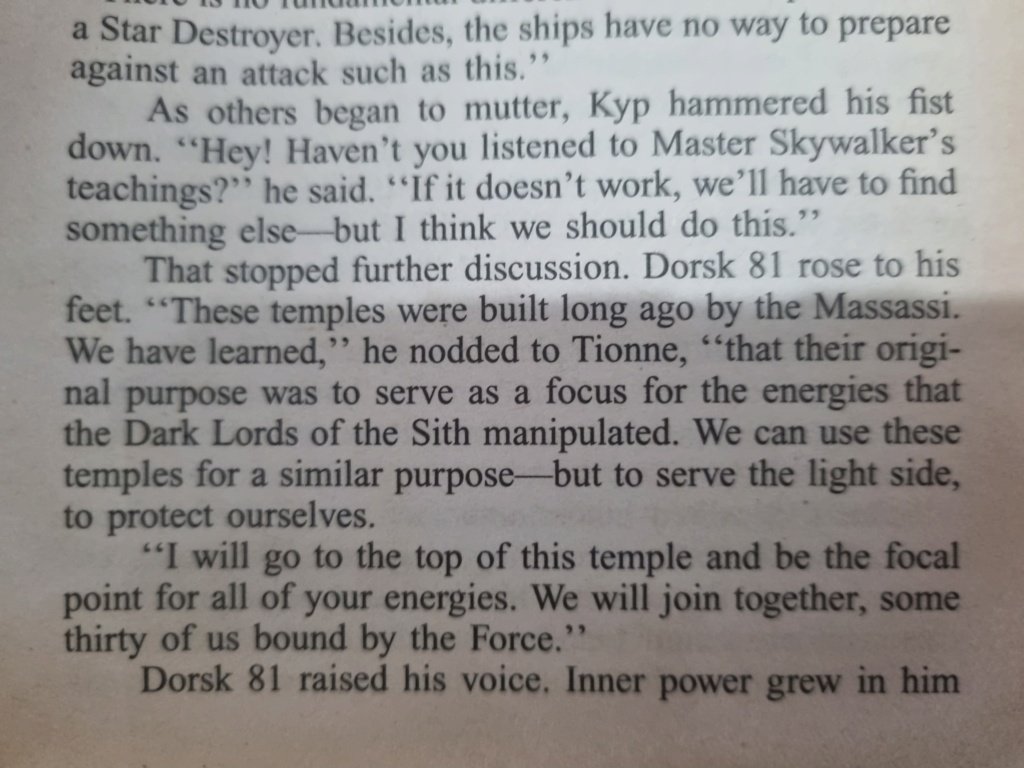
When the aspiring Jedi overcome their fears and insecurities, Kun’s power goes away entirely. He can’t touch them.
Yes, because the entire thing is a trap. Otherwise they never would've beaten him:
I, Jedi wrote:Gantoris was on Yavin just over two weeks before his death, which could be seen as a cap to one cycle. Kyp arrived a week or so later and was here just over a week before he stole the Headhunter. Inside a week he came back and dropped Luke like a hot rock. By rights the dark man should have been back preying on us within days after Luke's defeat, but he wasn't, and this frightened me.
*
The only vaguely positive explanation for Exar Kun's dormancy that I could come up with was that his effort to draw the Sun Crusher from Yavin and to down Luke had tired him out. I had no way to determine how powerful Exar Kun could be, but it struck me as possible that he'd expended a lot of energy to defeat a Jedi Master. There was no telling how long it would take for him to recover.
*
"I know I can buy us time, but not much. At the rate he recovers, Kun should be ready for something tomorrow, maybe tonight."
*
My thinking was that Kun, still taxed from his having funneled enough power through Streen to create that cyclone, would take the chance at having Streen use the Headhunter to kill Luke.
*
"Council of war, good. Right now, not good." I sighed. "Kun has been defeated tonight. He's not going to be coming back right away."
*
"Right. It will have to shine so brightly no shadow can withstand it." I looked around at all of them. "That's your job. When he comes for Luke again, you give him more light than he can ever handle."
*
"Not going to happen." I leaned forward, holding myself up by posting my arms on the table. "Up to this point, Exar Kun has acted on his own schedule. He's moved when he wants to move, done what he's wanted to do. Not anymore. Tomorrow evening, as night is coming on, we'll force him to act. He won't be ready, but he'll think he can still beat us. He'll be wrong."
*
I managed a weak smile. "Bait. Kun's heading into a trap. A big trap."
*
She weighed my words. "Any chance he can get out of it?"
*
"Shouldn't be able to. It really is over for him."
Kun’s actual performance against Luke’s order only becomes more embarrassing when, despite already having beaten Kun’s spirit forever 3 years before, Luke thinks his current Order needs all its strength to be able to beat Ragnos.
Literally all he says is that he has no idea what they'll need to beat Marka Ragnos. Someone he has no knowledge of whatsoever. Given that what actually happens is Marka Ragnos's spirit loses to Kyle Katarn's apprentice Jaden Korr. Exar Kun is demonstratably far more impressive. It takes a union of Kyle Katarn himself, Luke Skywalker's spirit, Vodo's spirit, and the Solo twins who would be far greater help than Anakin Solo was when he entered a union with his mother and uncle, whilst still in the womb. As well as a bunch of potentials described as a 'wellspring' of potential. Including Brakiss, who goes on to be able to exhaust Luke in a duel. I don't know why you thought this would be a good argument to make, but thanks for the freebie.
…no? Palpatine plans for the future. He sees Asajj Ventress growing stronger, and he’s able to put two and two together and know that’s an issue. None of the quotes you’ve presented so far say anything that would suggest he’s afraid of them knocking on his door and beating him up later this week, whereas several necessitate that it’s a farther off scenario that he’s trying to nip in the bud.
The majority emphasize the rate of her power’s growth, which would be irrelevant if it were a concern of next Tuesday, while those emphasizing her current power would still be relevant if it were a concern for five years for now, as an indicator of where she’d be at then.
The apparent availability of the potential of her becoming strong enough at a fast enough rate to out-pace Darth Sidious's own rate of power growth. To the point that he fears she and Dooku can kill him, is literally the entire point here. She has power growth that is at a rate that Sidious cannot outgrow this threat, seeing the need to eliminate her instead. This is specifically meant to support where Talzin stands relative to Sidious as well. Talzin is by far the stronger of the two, and given she has multiple avenues of power gain to go through as opposed to Ventress's solely potential based growth. This further supports that Sidious is much closer to the Mother than you'd like to portray her as.
Right, and I agreed with that and acknowledged that. Gethzerion’s power, on the other hand, is independent from Dathomir. So Gethzerion being more powerful than Talzin offworld doesn’t mean she scales to Talzin’s on-world performance against Palpatine.
I am asserting that both is true. There are multiple Nightsister lines going on at the moment. Gethzerion isn't present in the T-canon version, but Talzin must also simultaneously submit to C-canon quotes on the matter. Gethzerion's in-universe foundation of the Nightsisters still stands:
Cracken Threat Dossier wrote:Gethzerion used her newfound knowledge to gather the other outcasts. While the clan looked on, Gethzerion used her "Shadow Magic" to form the Nightsisters. They found their power grew quickly.
Dark Side Sourcebook wrote:When Gethzerion created the Nightsisters clan, she decided that they needed their own book of lore to pass down through the generations-if only to tell the story of how their clan was formed. The Book of Shadows goes into quite a bit of detail about the dark side of the Force as well, providing the reader advice on using dark side powers.
The most powerful Nightsister as of the Clone Wars is Old Daka:
History Gallery, starwars.com wrote:But for all her power, Talzin was not the mightiest of the witches -- even older Nightsisters dwelled deep within the fortress on Dathomir. During the Clone Wars, the oldest and most powerful witch was Old Daka.
But notice the wording, Daka is not the only one. Other older witches are mightier than her. This almost certainly would include the founding Nightsister, Gethzerion.
Note, Talzin herself confirms that multiple Clan Mothers exist simultaneously:
Book of Sith wrote:Only the clan mothers may broker the services of the Nightsisters. But not all Nightsisters have equal expertise. We will not repeat the mistakes of Shaman Yansu Grjak, who too eagerly sold the services of her clan to Separatist buyers and then could not protect her sisters from the Jedi counterattack.
Better yet, Gethzerion's superiority is firmly established over Charal, another Nightsister:
The Illustrated Star Wars Universe wrote:The Force witch Charal, who called herself a Nightsister, freed us after promise to take her with us when the retrieval ship homed in our beacons.
Charal was able to take the power of the 'all-potent' Sunstar with her defenses until it was empty. The Sunstar has 'just enough' power to prevent 'the coming darkness' from taking over:

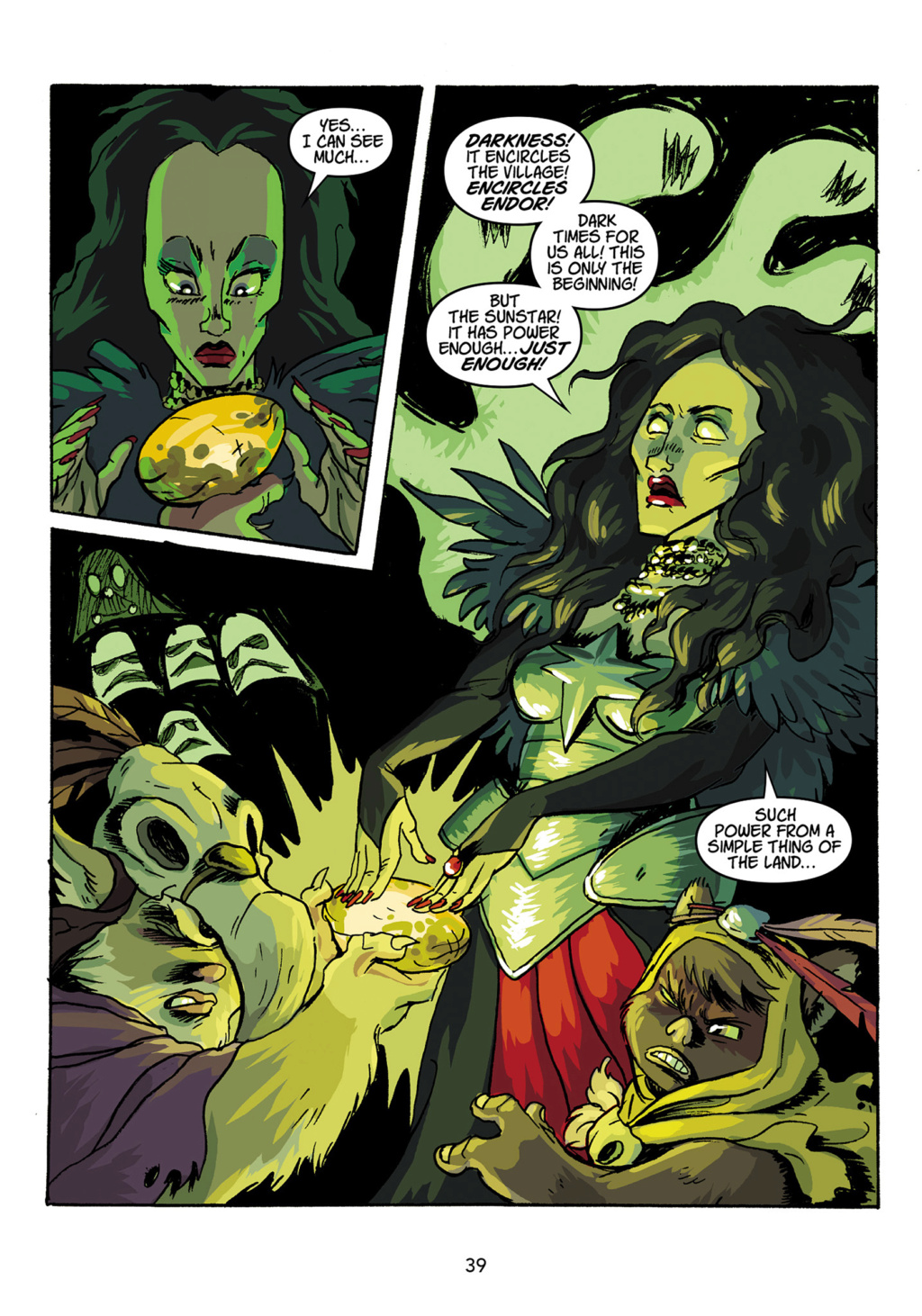











Gethzerion is repeatedly stated to be the strongest Nightsister. Well after Charal was created:
Dark Side Sourcebook wrote:The most powerful of the Nightsisters was an aged crone named Gethzerion.
Faces of Evil, Star Wars Galaxies Website wrote:To afford a steady supply of powerful Force sensitive beings, she set up a personal training retinue, selected from the most talented of the Nightsister Spell Weavers. From this pool Axkva chose the most powerful pupils and sent them out to establish a presence for the Nightsister conclave across the face of Dathomir.
In truth, Axkva was consuming the life forces of these students and later disposing of the bodies when her needs had been fulfilled. When the scope of her atrocities was brought to light, Axkva Min drew the ire of the most powerful of the Nightsisters.
Axkva Min was banished and imprisoned in the dark underground tunnels of Dathomir. She remains a menace to all beings on the planet as long as she lives.
Noting that Charal is in Star Wars Galaxies:

As you can see, Charal has an arguably even more impressive feat than Talzin 'standing toe-to-toe' with Sidious. Being strong enough to take the power of an artifact that could stop the darkness in its entirety and then walk it off casually. Yet her inferiority to Gethzerion is directly stated whilst Charal is around, twice.
The distinctions between spells and general nightsister powers just isn’t there. To them, it’s all magic, all spells. Some are just simpler than others, and thus easier to do unspoken.
Both Talzin and Gethzerion can do nonverbal spells. Both Talzin and Gethzerion need to speak and make motions for more complex spells. I don’t see how this comparison so clearly favors Gethzerion.
As this distinction is inherently difficult to parse through, I'm going to leave this as-is. It isn't necessary to prove my point anyway.
Palpatine’s both a manipulative genius and an incredibly pathetic being all the time. That position is fully consistent internally, fully consistent with every claim I’ve made, and fully consistent with the fundamental nature of the character (as explained in my first post). If those aspects are convenient for my argument and inconvenient for yours, what’s the natural takeaway from that?
Or more like you're appealing to situations that are ultimately irrelevant to this one. This isn't some one enough throw-away quote granted to one character. It's multiple direct instances from characters who are interconnected themselves, and all of them build a strong enough narrative that says Gethzerion more likely than not, can smack 1ABY Sidious around, convincingly. Appealing to random other occurrences to get around the actual argument proposed isn't going to fly.
All of these quotes are either entirely or more firmly than anything else in the context of his apprenticeship to the Emperor. This does not come with political power in itself, but would of course have a lot to do with his personal prowess – emphasized directly in two of the four quotes.
And all of them are stated within the framework of his rise in the Empire, namely from Tarkin's pathetic bitch to the second most feared man in the Empire. Which is something George Lucas himself states. In no way is this convincing evidence when used against multiple people who throw-down with Vader's master. Especially given that even as of his amplified prime state in Return of the Jedi, he's still only half of the required power to maybe defeat the Emperor. A far cry from the Nightsisters having explicit power comparisons and combative feats against the Emperor. Noting that the one Sidious does fight, is explicitly below Old Daka and some elder Nightsisters in power.
“I’d like to think” is not a confirmation.
It’s one writer’s speculation that probably has a reason that it didn’t make it into the source material.
Wolverton, the creator of Gethzerion, is far more likely to have Geth with Palps than most any other writer. Same for Veitch, the co-creator of Kun. Their ideas of their works are definitely worth taking into consideration, their opinions on tangentially related questions like this to a lesser degree, but definitely not enough to force the published works of other writers to reconcile with their uncertainly phrased social media opinions, instead of the other way around.
Such speculation is outright confirmed to not be canon in any context (this would apply to the aforementioned Veitch statement, as well).
Unfortunately that's not the prevailing attitude here:


The Holocron Keeper Leland Chee indicate that not is an author's answer as official as it is going to get unless stated in published material. He actively uses author's intent when dictating answers on lore questions.
What do you think is the reason that you need to keep coming to social media messages instead of the source material to find any of these guys being put directly with or above Palpatine?
I mean if you went to misconstrue my entire argument as requiring this, then go ahead. But that's blatantly not the case as I have proven. That the authors all say I'm right in my interpretation of the source material and you aren't says a lot.
But given you have in fact misconstrued my argument, allow me to repeat it clearly for you:
Courtship of Princess Leia states numerous times that Palpatine was absolutely terrified of Gethzerion. The author of the book confirms that this fear was legitimate and an actual direct threat to Palpatine presently. All of the source material after the fact says that Palpatine is genuinely under threat from Gethzerion. Confirming both the book's claim and the author's confirmation of the veracity of the book's claim.
The idea that this hinges on Wolverton's inbox is a laughable misrepresentation of my argument. Makes me wonder why you're having to resort to these kinds of claim.
The air isn’t hot, it’s just blowing in a different direction than you’d like.
Or you're deliberately trying to downplay how in the shitter your argument is for the audience. But nice to see you keeping your gloves up this long into the fight.
I’m not claiming that it’s mutually exclusive to the sources saying Palpatine fears Gethzerion and her Nightsisters. I’m saying the exact opposite. If, as Kirana says, the Nightsisters not having spaceflight capabilities is the only thing that saved the galaxy from slow corruption by their magic, then there’s another explanation for Palpatine being afraid of that possibility than specifically losing a 1v1 against Gethzerion.
Again, not only does Kirana Ti have no idea what Palpatine is actually afraid of. Not only does Kirana Ti have no idea of the powers she is dealing with. But again, what she says does not in any way have any bearing on the overwhelming evidence that there's four or five Nightsisters that can go 'toe-to-toe' with Palpatine and possibly win. And the strongest of the lot is most certainly Gethzerion. Who very likely surpassed Old Daka after Daka's death in the Clone Wars.
There is no winning this point of the argument for you. It's even more stacked than your absurd claim of Sidious being the Sith'ari.
Granted, Bantam often ignores DE. It doesn’t always though. Find me something saying that it’s only when “specifically stated” that it adheres to continuity.
I obviously can’t prove that unspecified references to Palpatine are in fact to specifically DE Palpatine, and cases where it is specified to be DE Palpatine would obviously fall into the “specifically stated” category. Goofy argument.
It really isn't, Bantam book's infamously saw Dark Empire as non-canon and didn't understand what they were doing. The books repeatedly have characters claim he wasn't the real Emperor at all but a fake. As well as Essential Guide to the Force even claiming that the cloned Emperor were just insane clones who didn't have the real Palpatine involved at all. Namely Timothy Zahn who hated everything to do with it, hence the Hand of Thrawn duology outright having Mara and Luke claim he was just some weird clown trick on behalf of the Imperial Remnant to regain authority. I'm not going to list out every single instance for you here, but suffice it to say. There was a dispute. This included New Rebellion. There's already been a healthy debate about this on Discord including EC, etc. I'm not looking to spend even more time on it here. So if you'll allow me for the sake of brevity given the monstrous size of my reply already, I'll simply quote him:
Even before the release of the prequel trilogy some contributors to the Expanded Universe made known publicly (and privately) that they were dissatisfied with the Dark Empire comics due to many pivotal events occurring within a single panel or entirely off-panel, and most importantly, with the decision to bring Palpatine back to life. Timothy Zahn was a proponent of this. In Vision of the Future, Timothy Zahn included a conversation that refers to the events of Dark Empire with Luke Skywalker mentioning "the resurrected Emperor" and Mara Jade retorting, "Whatever. Personally, I'm not convinced it was actually him," Implying that his dissatisfaction was being portrayed in the novels he was writing. And, during the writing of the Thrawn Trilogy, Zahn was asked to incorporate references and elements from Dark Empire into his books, since they were set chronologically later than the comic. Zahn outright refused, however, so Tom Veitch had to work around this issue, and Dark Empire was ultimately relocated to being set after the events of Zahn's books. Zahn was releasing his novels under the publishing company Bantam Spectra, the same company that Kristine Katheryn Rusch was publishing under, who is the author of The New Rebellion. While some authors included Dark Empire events in their book, like Zahn did above, they still reference him as "the reborn Emperor" or "the resurrected Emperor," not simply "the Emperor" as The New Rebellion has.
No, we only see the heroes operate in the time between 0 ABY and 1 ABY.
It seems very unlikely for us to see any writer have 2 ABY Palpatine ripping 1 ABY Palpatine to shreds, or RotJ Vader tearing ESB Vader in half. They have reasons for growth, yeah. But dwarfing themselves each year?
Basically all material focused on answering versus-related questions – the Darth Maul vs Darth Vader Tales comic, for example – make no distinction between the various iterations. Do we think that the writers’ idea was for the comic to prove that RotJ Vader scales 10x above the performance by ANH Vader and just dumpsters Maul in the first lightsaber exchange?
Additionally, it seems unlikely that four beings who traversed the gap between an uninitiated Force-sensitive and 1 ABY Palpatine in the span of a single year (in itself a completely ridiculous scenario with no tenable explanation) somehow fall behind the growth rates of Palpatine, Vader, and Luke for no apparent reason. Or that these four Palpatine-tier beings all die offscreen to nothing in particular. Or that these heroes collectively decide to abandon their duties and live out their lives at a Zeltros resort.
Regardless, this rationalization can’t work with the movies. Luke/Leia are the last hopes of the galaxy. This is the case throughout the original trilogy, and, if we’re not being incredibly dishonest, throughout the span of all six movies. This is not because Yoda/Ben are incompetent and missed the window where 4+ beings each with the current ability to give Palpatine a run for his money are running around.
No matter how you go about it, your idea of the SWG Protags’ powers is astoundingly tone-deaf to both SWG itself and the movies, and cannot possibly coexist with the plot of the G-Canon OT.
I'm sorry, are you Leland Chee? Pablo Hidalgo? Steve Sansweet? You don't get to dictate the canon to me or anyone else. Star Wars Galaxies is canon. You're making this argument as if it can't apply to Galen Marek or any one of his numerous clones in the The Force Unleashed series. He is active in various incarnations right up to the events of Empire Strikes Back and presumably lives on after the fact. He outwardly has the potential and power to be a Luke figure:

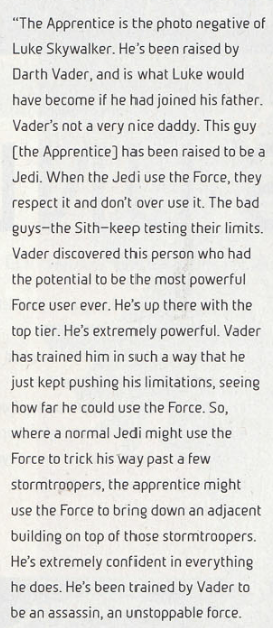



George Lucas himself states how important this is to the story of Darth Vader:
CNET Force Unleashed article wrote:“George (Lucas) gave us an hourlong history lesson and let us go away and write a story, encouraging us to create original characters that filled familiar archetypes and giving us feedback as to how Darth Vader would act as a master,” Blackman explains. “The Force Unleashed” also introduces two behavioral simulation programs, NaturalMotion’s Euphoria and Pixelux’s Digital Molecular Matter, which imbue the characters with central nervous systems and add complex new variables to gameplay.
Lucas has taken an active involvement in The Force Unleashed right through production, from approving the team's original concept for the game to annotating their scripts and helping them create new characters within the Star Wars canon - or even to decide the fates of existing characters. What has emerged is a game which slots in between Revenge of the Sith and A New Hope. It links together the new trilogy with the original trilogy, and reveals what happens in between Darth Vader's creation and Leia's theft of the Death Star plans.
For Star Wars fans, then, this is the real deal - a brand new, totally canon, Lucas-approved chapter in the continuity, told in the form of a videogame but built around a completely new, movie-style script. For gamers, it's the promise of a title which will employ every trick next-gen affords to bring the powers of The Force to life as never seen before. So then - no pressure, eh guys?
You can argue some very hilariously arbitrary lines here, but all the complaints you can muster don't render the events and power levels of Star Wars Galaxies N-canon just because you have no argument against it. Nor do they render the events and power levels of The Force Unleashed N-canon either.
Note, if you make the argument that Starkiller isn't powerful enough yet, you're also drawing an even worse line here. Starkiller has the potential to surpass the Emperor, is the photo-negative of Luke Skywalker himself. He infringes on this pseudo-Canon wall you've desperately attempted to conjure up to prevent this argument far more than the Hero of the Rebellion can. There's very legitimate arguments to make that Luke and the Emperor simply rise above the power dynamic present in 0ABY-1ABY. But there's no such argument to be made against Galen Marek and Starkiller. And George Lucas.
I’m not sure what makes you think that what Luke does against Exar Kun or Kueller is the same thing as what he and Leia do against DE Palpatine.
Rather than being likened to this event, it’s instead compared directly to Obi-Wan becoming a Force ghost – moving to be other luminous beings on the other side, but he was a luminous being all the time, as is every living being. This is a distinct action from connecting to and wielding the energies of every luminous being in history, which is what Luke and Leia are doing here.
If this weren’t readily apparent from how it’s actually described in the quotes you posted, and the more tangible disconnect of DE Luke and Leia’s not-ghostly nature, just compare what Luke and Leia are able to do against DE Palpatine to what Ghost Yoda and Ghost Ben are able to do against RotJ Palpatine in the Revenge of the Jedi scripts.
Except Dark Empire, Tales of the Jedi and Jedi Academy trilogy are all written to be interconnected by the same two authors, involved in each other's work. As I've already proven in this debate. The luminous beings power is readily accessible to Luke, which you know full well is the case given I have proven it, again, in this very same debate. Worse yet, Luke is literally a spirit in Jedi Academy and notes he's more powerful both during the experience and because of it when he returns to his body. Again, as I've proven in this very debate. There's absolutely no reason at all why this power wouldn't be used against Exar Kun and later on when he's going to attempt it again against Kueller.
The Dark Empire Endnotes confirm that becoming a spirit is part of the luminous beings power, that's what Luke is unlocking in the first place. Where are you getting hung up here?
Dark Empire Endnotes wrote:But in fact, as the greatest Jedi Masters have known, such powers are a kind of chimera, because they can only threaten "this crude flesh." Yes, such powers can inspire fear and obedience in the weak-minded. But such powers cannot touch the brightness that surrounds us and binds us together...the brightness to which the Jedi, as luminous beings, are forever joined.
Luke often wondered what happened to Ben and Yoda, when they passed out of this universe and their physical bodies simply vanished, leaving only heaps of empty robes behind.
How could such a marvel be?
Now, as the flood gates of the Force open in him, Luke begins to understand how such things are possible. The Force itself, beyond the physical outlines of the body, is not only a Jedi's greatest ally, but unshakable luminous reality.
And the Force, in all its intensity, belongs to no single entity - but to all.
The difference between what Yoda and Ben are able to do here… and what Luke and Vodo are able to do against Kun, and what Luke would have been able to do against Kueller… and DE's conclusion is the difference between one or two luminous beings lending their assistance from beyond the veil, and joining with every Jedi in the history of the Order and letting the Force in its entirety flow through them.
Tom Veitch, Story Treatments wrote:Now Tim doesn't like the idea of "the power of all the Jedi who have gone before" being focused in Luke. I think it follows logically from the fact, shown in the films, that the Jedi don't break off communication when they die. There would be a tremendous need, among the fallen Jedi, to right the great wrong done to the Company. They wouldn't just drift off to the Elysian Fields (as Zahn shows Obi-Wan doing in his plot outline).
Thus the idea of focusing on Luke, the last of their kind - the last hope for the Jedi.
I disagree that knowledge of the Force is merely "a highly individual and personal thing", a kind of talent that one develops. Indeed, we know the Force is "an energy field created by all living things that binds the universe together". The Jedi Knights were trained to tap into this collective energy, and use it in combat or for other magical purposes.
Yes, that takes a certain talent and skill - and an individual relationship to this vast well of power... But the ultimate talent for using the Force not from the ego or "one's own efforts", but from "letting go" the ego's need to control. The Force then "becomes strong in you", suggesting a kind of mystical sharing, through feeling - a conscious relationship to this collective and all-pervasive energy.
I think it's Tim who misses the mark and reduces knowledge of the Force to a "highly individual and personal thing, coming from one's OWN [his caps] talent and efforts to develop that talent." He would (it seems) reduce what is essentially an Eastern idea to the ordinary Western struggle for heroic identity.
Needless to day, Tim's idea contradicts the way Luke learned to let go of the need to control and to "feel the Force" in the very first Star Wars film.
You're gonna need to explain why Luke isn't able to do this constantly. It's a lesson learned and gained, and is something the Jedi Knights have been taught to do. That they are there to help Luke tap into this himself, is what we're actually getting here. Per Veitch himself.
And Luke doing this in Jedi Academy puts to bed any kind of doubts:
Jedi Academy II: Dark Apprentice wrote:Luke dropped his useless lightsaber and crouched. His every muscle suddenly coiled and tensed. He rallied all the powers of the Force around him, seeking any defensive tactic. With the Sun Crusher looming behind him, Kyp stretched out both hands and blasted Luke with lightning bolts like black cracks in the Force. Dark tendrils rose up from the gaps in the temple flagstones, fanged, illusionary vipers that struck at him from all sides. Luke cried out and tried to strike back, but the shadows of Exar Kun joined the attack, adding more deadly force. The ancient Dark Lord of the Sith lashed out with waves of blackness, driving long icicles of frozen poison into Luke’s body.
He thrashed, but felt helpless. To lose control to anger and desperation would be as great a failure as if he did nothing at all. Luke called upon the powers that Yoda and Obi-Wan had taught him—but everything he did, every skillful technique, failed utterly.
Nothing short of turning to the dark side of the Force, is enough for Luke Skywalker to fight back. Every single defensive technique and tactic he knows doesn't work. Again this is coming from the same author who worked with Tom Veitch on this entire three series epic. He does absolutely everything he knows, and it all fails utterly. He's absolutely destroyed.
And Luke in a luminous beings form needs all the help he can get to beat a Kun who is specifically not fully recovered from downing Luke in the first place(see above):
Massassi Temples, Databank wrote:Drawn to the Jedi was the ancient spirit of Exar Kun, who possessed several of Luke's students. Nearly killing Skywalker, the spirit of Kun challenged all the Jedi, who combined their Force abilities to banish Kun's presence.
Galaxy Magazine 8 wrote:Millennia later, Kun’s spirit was freed by Kyp Durron, a Jedi student of Luke Skywalker. It would take the power of a group of Jedi students and Skywalker himself to defeat Kun and banish his spirit.

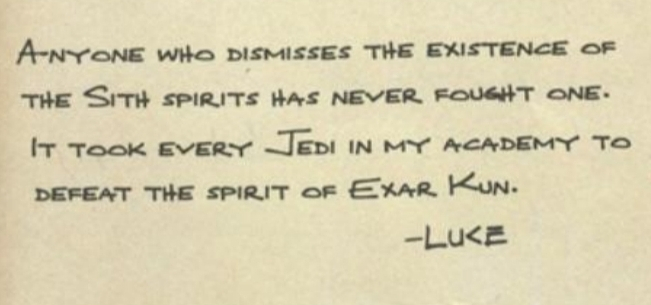
Children of the Jedi wrote:"Yes,” said Luke, remembering the power of the Force flowing into him as he’d battled Exar Kun for the final time.
And what reason are we given for the twelve students and two toddlers being able to do what the combined Jedi Order could not?
It seems like that distinction lies entirely with the Massassi Kun had, the factor you’ve been trying so hard to downplay as Ritual Kun’s primary source of strength.
According to the students who have absolutely no idea what Kun actually did in that ritual. And given the same trilogy has Exar Kun explain that the Massassi aren't necessary at all for him to re-open the doorways to power, sounds like you've got a problem:
Exar Kun, Jedi Academy II: Dark Apprentice wrote:"I want your anger, Gantoris. I want you to open the doorways of power. I am barred from the physical plane--but with enough other Sith followers, I could be at peace. I could even live again."
I’ve already covered how Kun’s performance against the combined Jedi Order is not quite so stellar.
Explain to me exactly why Kun’s supremacy quotes in other areas that both of your chains rely on so heavily should each be weighted more heavily than Sidious’s more clearly and more often stated direct supremacy quotes over Kun.
The difference is because when I use them, there isn't a mountain of direct evidence pointing in the other direction. It's not to say supremacy quotes are useless, it's that they definitely shouldn't apply when all available evidence in terms of bona fide feats dictates they don't work.
With Palpatine’s supremacy statements, we can tell exactly what each author – and their approved and published material – thinks about Palpatine vs Exar Kun. Palpatine is the GOAT. Exar Kun is not.
Daniel Wallace? Sure. He's like basically the only time where Exar Kun actually gets mentioned in the same product where a Palpatine supremacy quote exists. Whereas Kun's biggest supremacy quote literally has every single incarnation of Palpatine that existed by that point either on the opposite side of the same page as the quote in the same article, or later on in the issue.
So when it isn't just some random company printing hype quotes for the new Star Wars prequel film, and is actually deeply established EU, Palpatine doesn't look so good, does he? But again, Kun doesn't need any of that. He has direct feats depicting his superiority over characters that directly defeat Palpatine in combat.
The nature of multi-writer scaling chains like this are always more tenuous than direct comparisons, even when perfectly reasonable otherwise.
Then it's a good thing no such direct comparison actually exists for Palpatine over Exar Kun. Though the opposite is heavily evidenced.
CONCLUSION
Palpatine's entire defense relies on subjective supremacy quotes that themselves are based on chronological happenstance. But whenever actually given a chance to display his superiority in a direct battle, he falls flat every single time. He's humiliated or killed more than once, against people Exar Kun directly stomps in actual displays.
Exar Kun with the power he unlocks to fight the Jedi Order is demonstratably magnitudes above every display we've ever seen from Palpatine's strongest incarnation. Namely because it was literally written that way by the authors of the projects they both appear in.
This is an utterly hopeless battle for Palpatine, Exar Kun wins.

 Darth Durin's Baneling
Darth Durin's Baneling
 Re: SS - EXAR KUN (AncientPower) VS. DARTH SIDIOUS (Durin)
Re: SS - EXAR KUN (AncientPower) VS. DARTH SIDIOUS (Durin)
December 7th 2023, 10:46 pm
Sorry to hear it, no rush.
 AncientPowerSuspect Hero | Level Four
AncientPowerSuspect Hero | Level Four
 Re: SS - EXAR KUN (AncientPower) VS. DARTH SIDIOUS (Durin)
Re: SS - EXAR KUN (AncientPower) VS. DARTH SIDIOUS (Durin)
February 4th 2024, 8:51 pm
I am done. My last ever debate post is finished. Thanks for giving me a good last match. I'm sorry for how long this took. But it's now your ball.
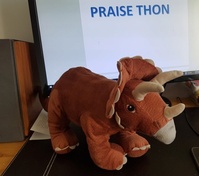 The Prodigal Knight
The Prodigal Knight
 Re: SS - EXAR KUN (AncientPower) VS. DARTH SIDIOUS (Durin)
Re: SS - EXAR KUN (AncientPower) VS. DARTH SIDIOUS (Durin)
February 6th 2024, 6:46 am
Great post
 AncientPowerSuspect Hero | Level Four
AncientPowerSuspect Hero | Level Four
 Re: SS - EXAR KUN (AncientPower) VS. DARTH SIDIOUS (Durin)
Re: SS - EXAR KUN (AncientPower) VS. DARTH SIDIOUS (Durin)
February 6th 2024, 7:44 am
The Prodigal Knight wrote:Great post
Thanks man
 Darth Durin's Baneling
Darth Durin's Baneling
 Re: SS - EXAR KUN (AncientPower) VS. DARTH SIDIOUS (Durin)
Re: SS - EXAR KUN (AncientPower) VS. DARTH SIDIOUS (Durin)
April 1st 2024, 2:01 am
Was pretty busy, didn't get much of a start on my response until this past week. Probably won't be able to respond in full in the next couple days, but I'll keep adding to what I have.
- Darth Sidious, Exar Kun and Valkorion runs the gauntlet
- SS - Champion of the Dark Side - Exar Kun (LadyKulvax) vs. Darth Sidious (Meatpants)
- SS - Asajj Ventress (Darth Durin's Baneling) vs Raskta Lsu (Primarch)
- Stomper Showdown R2 #2 - Return! Darth Malgus (Janix) vs An'ya Kuro (Darth Durin's Baneling)
- SS - Revan (chum) vs Yoda (Darth Durin's Baneling)
Permissions in this forum:
You cannot reply to topics in this forum|
|
|



